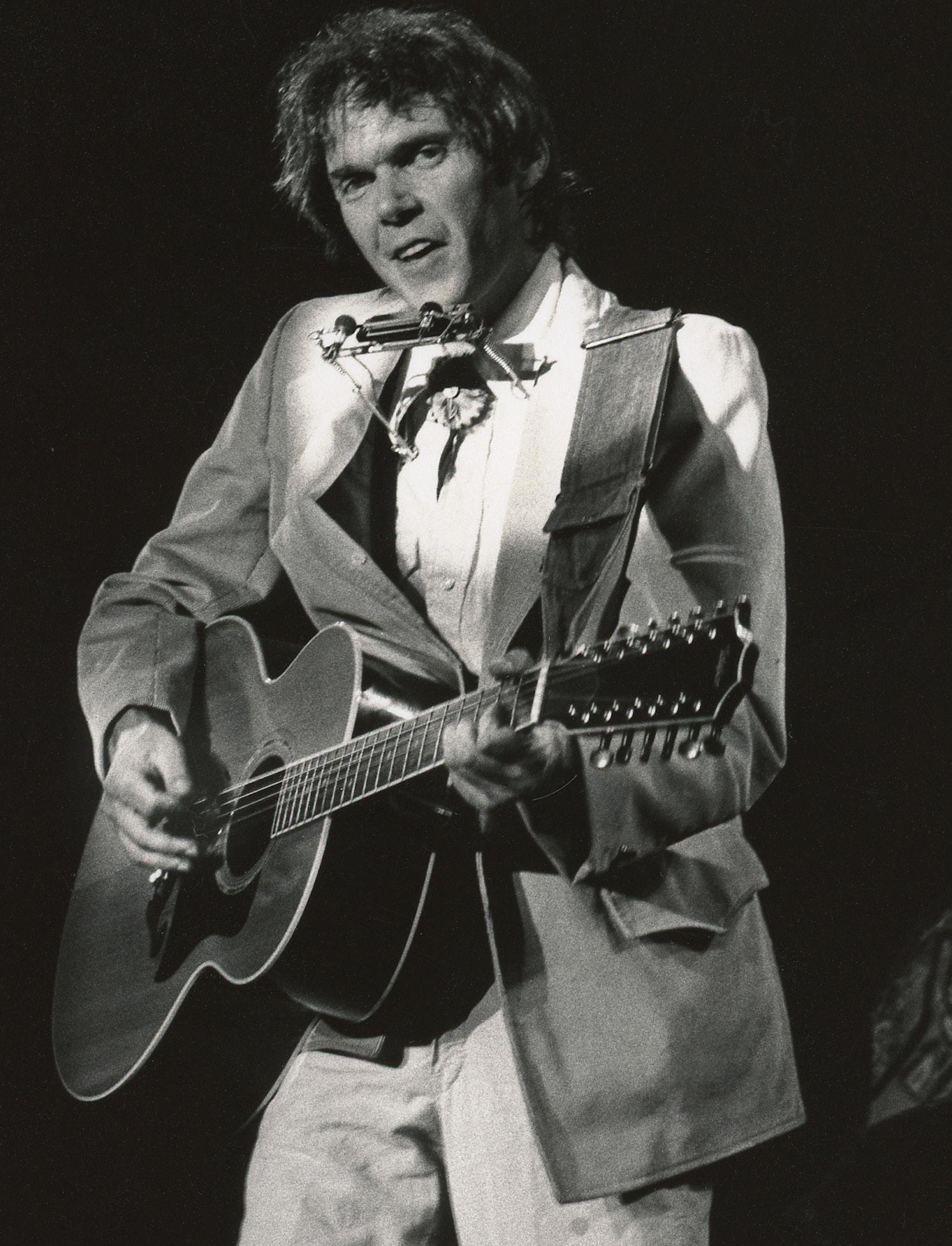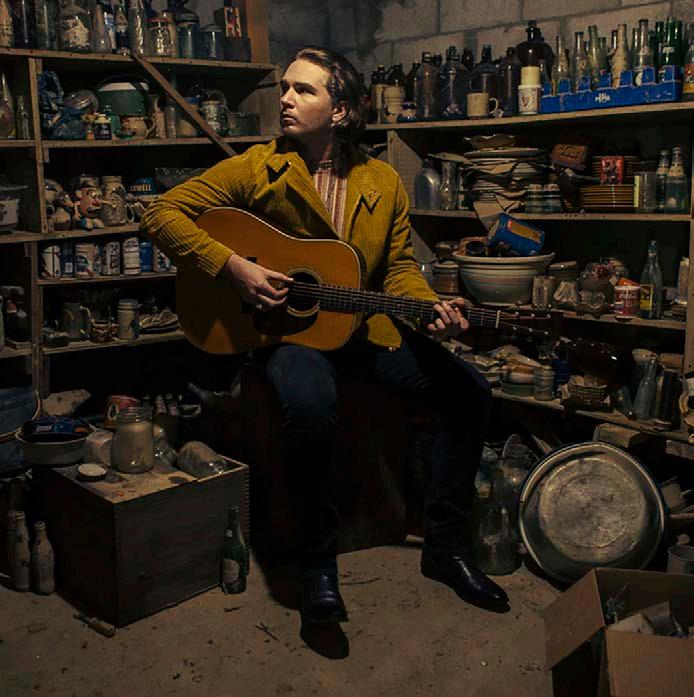


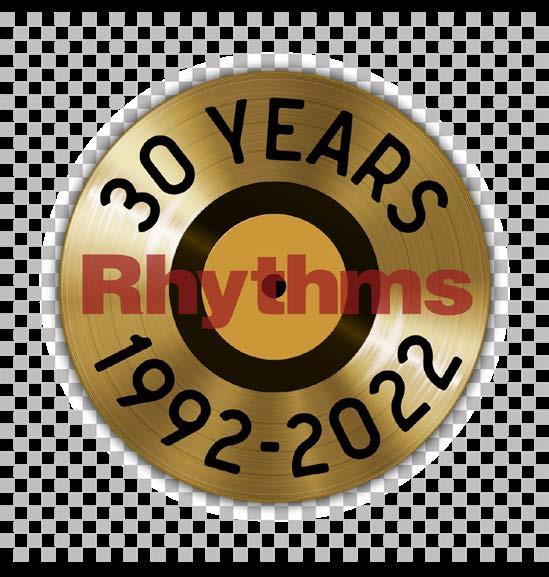
FREE SUBSCRIBER MUSIC DOWNLOAD CARD $15.00 inc GST JANUARY/FEBRUARY 2023 ISSUE: 315 Womadelaide & Port Fairy Béla Fleck & Abigail Washburn Vieux Farka Touré Kronos Quartet Mary Coughlan Proclaimers Soul Rebels TOURING Ian Noe Early James Redd Volkaert & Ray Beadle Dog Trumpet Samantha Fish PLUS 2022 Readers & Writers Polls HISTORY The Greatest Concert Ever: The Rolling Stones At Kooyong 1973! The Loner: Neil Young
“I’m letting myself out of the box I’ve been putting myself in for so long. There’s a lot of joy and triumph in that.”
2
3 IN ALPHABETICAL ORDER 19-TWENTY • allison russelL • THE ANGELS • ASH GRUNWALD Backsliders • BECK • the bros.landreth • Beth Hart thE BLACK SORROWS • BONNIE RAITT • BUDDY GUY the final tour THE CAT EMPIRE • CHAIN • CHRISTONE 'KINGFISH' INGRAM Counting crows • tThe doobie brothers 50th ANNIVERSARY TOUR ELVIS COSTELLO & THE IMPOSTERS • ERIC GALES Eugene hideway bridges • FEMI KUTI & THE POSITIVE FORCE GANG OF YOUTHS • GREENSKY BLUEGRASS • JACKSON BROWNE JASON ISBELL AND THE 400 UNIT • JOE BONAMASSA JOE CAMILLERI A STAR STUDDED TRIBUTE TO THE GREATS OF THE BLUES JON STEVENS • kaleo • KEB' MO' BAND KING GIZZARD & THE LIZARD WIZARD LACHY DOLEY & THE HORNS OF CONVICTION • LARKIN POE LP • LUCINDA WILLIAMS • MARCUS KING MAVIS STAPLES • MICHAEL FRANTI & SPEARHEAD nathaniel rateliff & THE night sweats • NIKKI HILL Paolo nutini • ROBERT GLASPER • ROCKWIZ LIVE st paul & the broken bones The Soul Rebels with GZA, Talib Kweli & BIG FREEDIA SOUTHERN AVENUE • SPINIFEX GUM feat. Marliya STEVE EARLE • TASH SULTANA trombone shorty & orleans avenue vintage trouble • XAVIER RUDD • Yirrmal EXCLUSIVE EXCLUSIVE EXCLUSIVE AND MORE TO COME! THU 6th - MON 10th APRIL, 2023 BYRON EVENTS FARM. BYRON BAY. NSW “Bluesfest was as ever, a musical treat.” The Guardian “Bluesfest, one of the world’s great rollingfestivals” stone
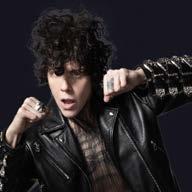



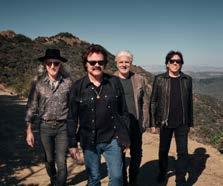
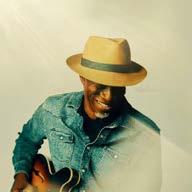

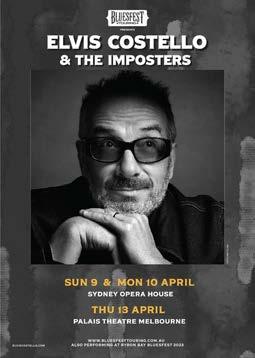

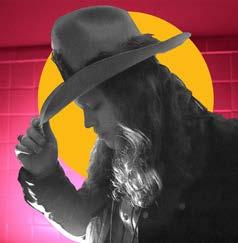


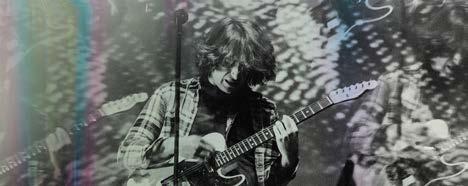
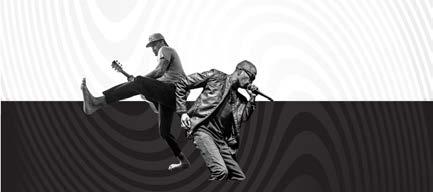
4 BLUESFESTTOURING.COM.AU LUCINDA WILLIAMS AND STEVE EARLE SYDNEY MON 3 APRIL ENMORE THEATRE ELVIS COSTELLO & THE IMPOSTERS SYDNEY SUN 9, MON 10 & TUE 11 APRIL OPERA HOUSE MELBOURNE THU 13 APRIL PALAIS THEATRE CHRISTONE KINGFISH INGRAM ADELAIDE MON 3 APRIL THE GOV SYDNEY WED 5 APRIL THE METRO MARCUS KING and VINTAGE TROUBLE BUDDY GUY SYDNEY MON 10 APRIL ENMORE THEATRE MELBOURNE WED 12 APRIL NORTHCOTE THEATRE SYDNEY WED 12 APRIL ENMORE THEATRE MELBOURNE MON 10 APRIL ENMORE THEATRE SYDNEY FRI 14 APRIL STATE THEATRE BONNIE RAITT AND MAVIS STAPLES MICHAEL FRANTI & TROMBONE SHORTY SYDNEY FRI 7 APRIL DARLING HARBOUR THEATRE, ICC SYDNEY FRI 7 APRIL ENMORE THEATRE THE GOV CAIRNS THU 13 APRIL TANKS ART MELBOURNE WED 5 APRIL PALAIS THEATRE SYDNEY SAT 1 APRIL ENMORE THEATRE MELBOURNE SUN 2 APRIL NORTHCOTE THEATRE SYDNEY THU 13 APRIL ENMORE THEATRE MELBOURNE MON 10 APRIL THE FORUM LP NATHANIEL RATELIFF & THE NIGHT SWEATS AND ST PAUL & THE BROKEN BONES BIG FREEDIA GZA AND TALIB KWELI with THE SOUL REBELS +ROBERT GLASPER BRISBANE WED 5 APRIL FORTITUDE MUSIC HALL SYDNEY THU 6 APRIL ENMORE THEATRE LARKIN POE SYDNEY SUN 9 APRIL THE METRO MELBOURNE MON 10 APRIL CROXTON BANDROOM MELBOURNE TUE 11 APRIL THE CORNER HOTEL DOOBIE BROTHERS SYDNEY TUE 4 APRIL WED 5 APRIL THU 6 APRIL STATE THEATRE KEB’MO’ PAOLO NUTINI SYDNEY MON 10 APRIL THE FACTORY THEATRE SYDNEY WED 12 APRIL THU 13 APRIL STATE THEATRE SOLD OUT! SOLD OUT! SOLD OUT! SOLD OUT! SOLD OUT! MICHAEL FRANTI ONLY! SOLD OUT! SOLD OUT!
The Word. Welcome to the New Year. By Brian Wise.
Rhythms Sampler #22 Enjoy 30 tracks of great Australian music. Only available to subscribers!
Readers’ Poll 2023 Your choice of the best of the year just gone.
Bluesfest Melbourne Neil Croker is the Director of the new Bluesfest Melbourne. By Brian Wise.
Rebel! (Soul) Rebel! New Orleans’ Soul Rebels will be at Bluesfest, north and south. By Steve Bell.
Nashville Skyline Anne McCue checks out Lost Futures.
All The Rage. Paulie Stewart has documented his remarkable life in a compelling new book. By Jeff Jenkins.
IN THE DRIVER’S SEAT!
Eilen Jewell has written her most personal album to date from the ruins of 2020. By Jo Roberts.
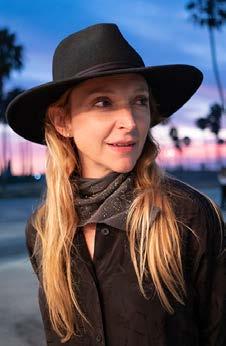
DUELLING BANJOS
Bela Fleck and Abigail Washburn have been called the ‘king and queen’ of the banjo and they demonstrate the sonic possibilities of the instrument. By Brian Wise.
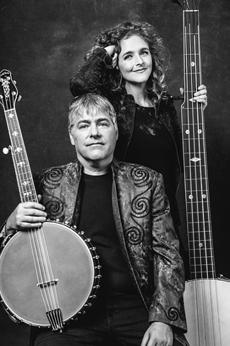
PROFILES & FEATURES
DESERT STORM
Malian guitarist and singer-songwriter Vieux Farka Touré establishes his own reputation. By Chris Lambie.

THIRD TIME LUCKY
Billy Bragg has had his tour cancelled twice but he will definitely be here in 2023 (fingers crossed). By Bernard Zuel.
TIME WAITS FOR NO ONE
David Harrington brings the Kronos Quartet back on their 50th anniversary tour. By Brian Wise.
A PROCLAMATION!
Bridget Macarthur talks to The Proclaimers’ Charlie Reid about the group’s latest album and forthcoming tour.
LIFE STORY
Irish singer Mary Coughlan’s latest album reflects her life but she also talks about an exciting new project. By Brian Wise.
THIS BUD’S FOR YOU
Brisbane-based truck-driver Bud Rokesky finally puts his songs on record! By Steve Bell.
EARLY DOORS
Dan Auerbach (of The Black Keys fame) has produced the presciently-titled Strange Time To Be Alive for singer-songwriter Early James. By Steve Bell.
NOE WAY!
Kentucky-bred singer-songwriter Ian Noe tours behind his acclaimed second album River Fools & Mountain Saints.
By Steve Bell.
SONGS FROM WALKING WITH SPIRITS
An Arnhem Land musical experiment comes of age.
By Seth Jordan.
BRINGING IT ALL BACK HOME
Ella Hooper goes back to where it all began. By Jeff Jenkins.
SOUTH OF THE BORDER
Henry Wagons goes country on his new album, South of Everywhere. By Bernard Zuel.
TEX MESSAGE
Tex Perkins delivers a new album with Matt Walker and The Fat Rubber Band. By Bernard Zuel.

TRUMPETING A RETURN
Reg Mombassa and Peter O'Doherty are back with a new Dog Trumpet album. By Bernard Zuel.
54 RAY AND REDD’S EXCELLENT ADVENTURE
Texas-based Titan of the Telecaster Redd Volkaert will be touring with Ray Beadle. By Samuel J.Fell.
56 WRITERS' POLL
The Rhythms scribes have delivered their verdicts on 2022.
MUSICIANS' POLL
We polled some of our favourite musicians on their choices for 2022.
(RONNIE) CHARLES IN CHARGE
The remarkable resurrection of the great lost record of the ’70s. By Jeff Jenkins. 66
THE ROLLING STONES AT KOOYONG 1973!
Ian McFarlane has put together a tribute to what many believe is the greatest concert they have ever witnessed.
THE LONER: NEIL YOUNG
An excerpt from Michael Goldberg’s book Addicted To Noise, a collection of his music writing.
5 UPFRONT
07
10
12
14
16
17
18
COVER
22
STORY
25
28
30
32
34
36
37
38
40
42
46
50
52
53
62
HISTORY 64
78
COLUMNS 81
A round up of 2022 and preview of the year
83 Musician Bassist Victor Wooten tours
By Chris Lambie 84 Classic Album: Stevie Ray Vaughan’s
By
85 33 1/3 Revelations: RIP Low’s
By
86 Underwater Is Where The Action Is. By Christopher Hollow 88 You Won’t Hear This On Radio: By Trevor
Leeden 89 Lost In The Shuffle: Dave Guard & The Whiskey Hill Singers. By Keith Glass REVIEWS 90 FEATURE ALBUM REVIEWS: Charles Jenkins, Samantha Fish, Chris Wilson, Simon Juliff, Peter Farnan, Jimmy Dowling, Monique Clare, Christopher Marshall, Cimafunk, Don Hillman, Josie Laver. 102 GENERAL ALBUMS 104 Blues: By Al Hensley 105 World Music & Folk: By Tony Hillier 106 Jazz 1: By Tony Hillier 107 Jazz 2: By Des Cowley 108 Vinyl: By Steve Bell 109 Books 1 Bob Dylan’s The Philosophy of Modern Song By Des Cowley. 111 Books Too! Kid Congo Powers, Albert Ayler and more. By Stuart Coupe. 113 Festival Guide Get out your dancing gear. 114 Hello & Goodbye By Sue Barrett. Volume No. 315 January/February 2023
Twang!
ahead. By Denise Hylands
with his brothers.
Texas Flood.
Billy Pinnell
Mimi Parker.
Martin Jones
J.

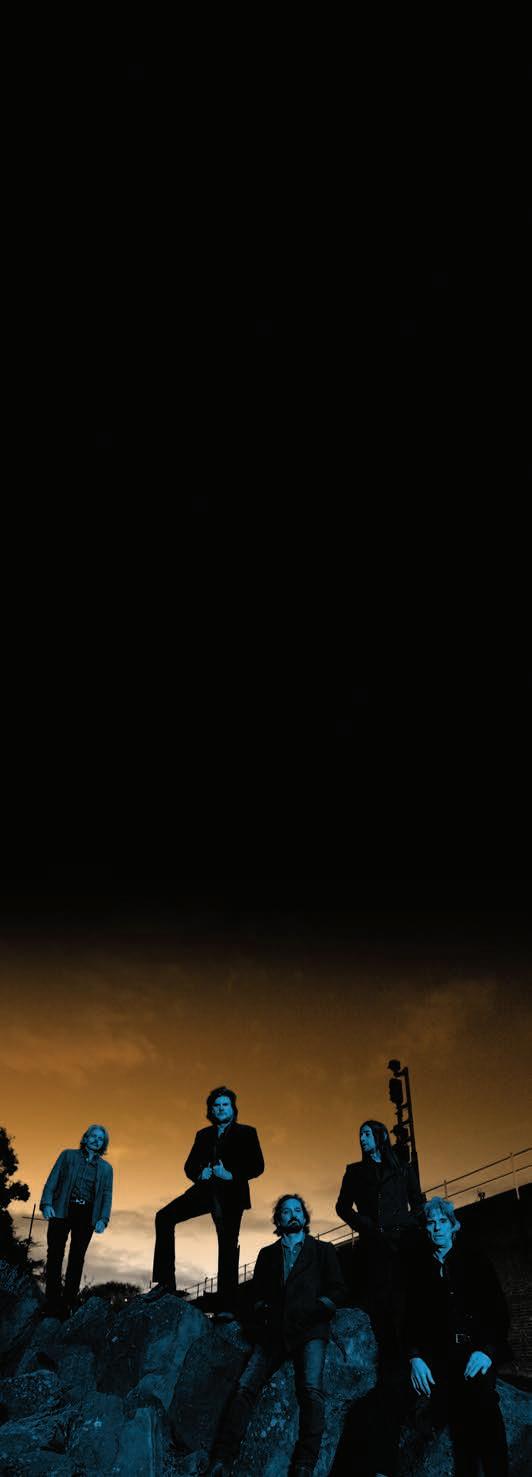
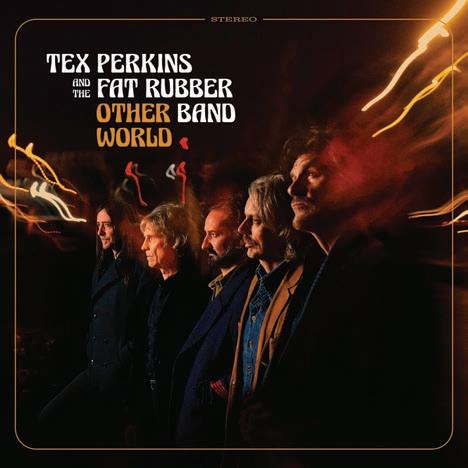
CREDITS Managing Editor: Brian Wise Senior Contributor: Martin Jones Senior Contributors: Michael Goldberg / Stuart Coupe Design & Layout: Sally Syle - Sally’s Studio Accounts: Alicia Wise Website/Online Management: Robert Wise Proofreading: Gerald McNamara CONTACTS Advertising: admin@rhythms.com.au Festival Coverage Contact: admin@rhythms.com.au Rates/Specs/Deadlines: bookings@rhythms.com.au Subscription Enquiries: subscriber@rhythms.com.au General Enquiries: admin@rhythms.com.au SOCIALS Facebook: facebook.com/rhythms.magazine Twitter: twitter.com/rhythmsmag Instagram: instagram.com/rhythmsmagazine PUBLISHER RHYTHMS MAGAZINE PTY LTD PO BOX 5060 HUGHESDALE VIC 3166 Printing: Spotpress Pty Ltd Distribution: Wrapaway Sue Barrett Steve Bell Des Cowley Stuart Coupe Meg Crawford Brett Leigh Dicks Chris Familton Samuel J. Fell Keith Glass Megan Gnad Michael Goldberg (San Francisco) Al Hensley Tony Hillier Christopher Hollow Denise Hylands Jeff Jenkins Martin Jones Chris Lambie Trevor J. Leeden Warwick McFadyen Ian McFarlane Anne McCue (Nashville) Billy Pinnell Jo Roberts Michael Smith Bernard Zuel CONTRIBUTORS 6
Welcome to the New Year. Now that the music scene has opened back up let’s hope that we can enjoy a festival season that gets us back to normal, or to the new normal (whatever that is). The past few years have been a difficult battle for musicians, venues and festivals. I think it’s been difficult for everybody. So, it is time to revel while we can in the music that we are going to enjoy in the next few months as so many of our favourite festivals kick back into gear.
I want to take this opportunity to thank all our subscribers for your support over the past few years. Without you this magazine would not be here. I also want to thank our loyal advertisers who have contributed to our survival.
If you are new to Rhythms – perhaps you have picked up a copy at a festival, in a music store or newsagent – then please consider subscribing. Rhythms is the only national ‘roots’ music publication in Australia and the only way you can guarantee a copy every issue is to subscribe and ensure you get it in the mail. With the rapid decline of newsagents throughout Australia it will be even more difficult to find your favourite magazine. So, please, if you have been considering a subscription do so now.
If you are wondering why it is important to support a magazine like Rhythms then a browse through the latest issue should be ample demonstration. Apart from all the features on festival and touring artists, the magazine has developed quite a substantial historical component thanks to Ian McFarlane. This month we recall the famous Rolling Stones tour of 1973 and the band’s Kooyong concert (still the greatest I’ve ever seen). Last month we paid lengthy tribute to artist Ian McCausland (who coincidentally designed the Stones ticket and poster for the 1973 tour). Earlier in the year Ian delved into Frank Zappa’s 1973 tour, the history of Goanna (coinciding with their recent tour) and legendary venue the TF Much Ballroom. This time last year we ran a feature on the history of Womadelaide.
In this issue you will also read Michael Goldberg’s interview with Neil Young from Addicted To Noise, a collection of Michaels’ music writing. Our book extracts have become a feature, as have Michael’s extensive musings on the work of Bob Dylan. In the last issue we also featured Michael’s epic interview with Greil Marcus about his latest Dylan book, Folk Music: A History of Bob Dylan in Seven Songs
Apart from the features run in Rhythms that you won’t find anywhere else, there is another great reason to become a subscriber. While we have bemoaned the state of the live music scene in the past few years due to the pandemic, it seems to me that there has never been so much music available. There must be literally hundreds of albums released each month. I know that my mailbox is bombarded with press releases on a daily basis. Isolation and technology have encouraged musicians to release their music online and sources such as Bandcamp have become vital in disseminating new (and sometimes old) music. Rhythms writers act as a filter, ensuring that you find out a lot of what is worth listening to; I know, that I enjoy discovering music through the reviews. A few years back, I received an excited email from an A&R person for a very wellknown US record company on our mailing list, letting me know that he only found out about a release from one of his favourite but obscure bands through Rhythms. He couldn’t believe he had to find out about it from an Australian magazine. (Nowadays it is even quicker with the digital issue!).
The importance of magazines like this – and community radio and the ABC when you think about it – in exposing under-represented music was also reinforced for me recently. I was watching a current affairs program on commercial TV drawn in by the promise that the hosts were going to talk to one of ‘the world’s greatest rock bands.’ I was intrigued. Who could it be? I like to think of myself as being vaguely au fait with what is going on and that I might have actually heard of ‘one of the world’s greatest’ bands. In fact, it turned out to be an act that neither I, nor any of my friends or acquaintances, had ever heard of (and I asked just about everyone I knew, including my children). Apparently, the claim to fame from what I could glean from the almost totally inarticulate male band members was that they had enjoyed a million visits to their YouTube channel.
I think that the mission of this magazine is confirmed when you look through the list of incredibly talented musicians in these pages. I hope you agree. In my case, I am glad to be able to write about the re-release of Landlocked by the great Chris Wilson, one of our finest musicians and a person who is still sorely missed on the local scene.
So, please consider subscribing and if you are already a subscriber then think about convincing one other person to subscribe.
Enjoy the music, the festivals and the gigs coming up.
 Brian Wise, Editor
Brian Wise, Editor
7
“Now let the music keep our spirits high.”
– Jackson Browne (‘Before The Deluge’)
Chris Wilson
(December 2, 1956 – January 16, 2019). See Album Reviews.

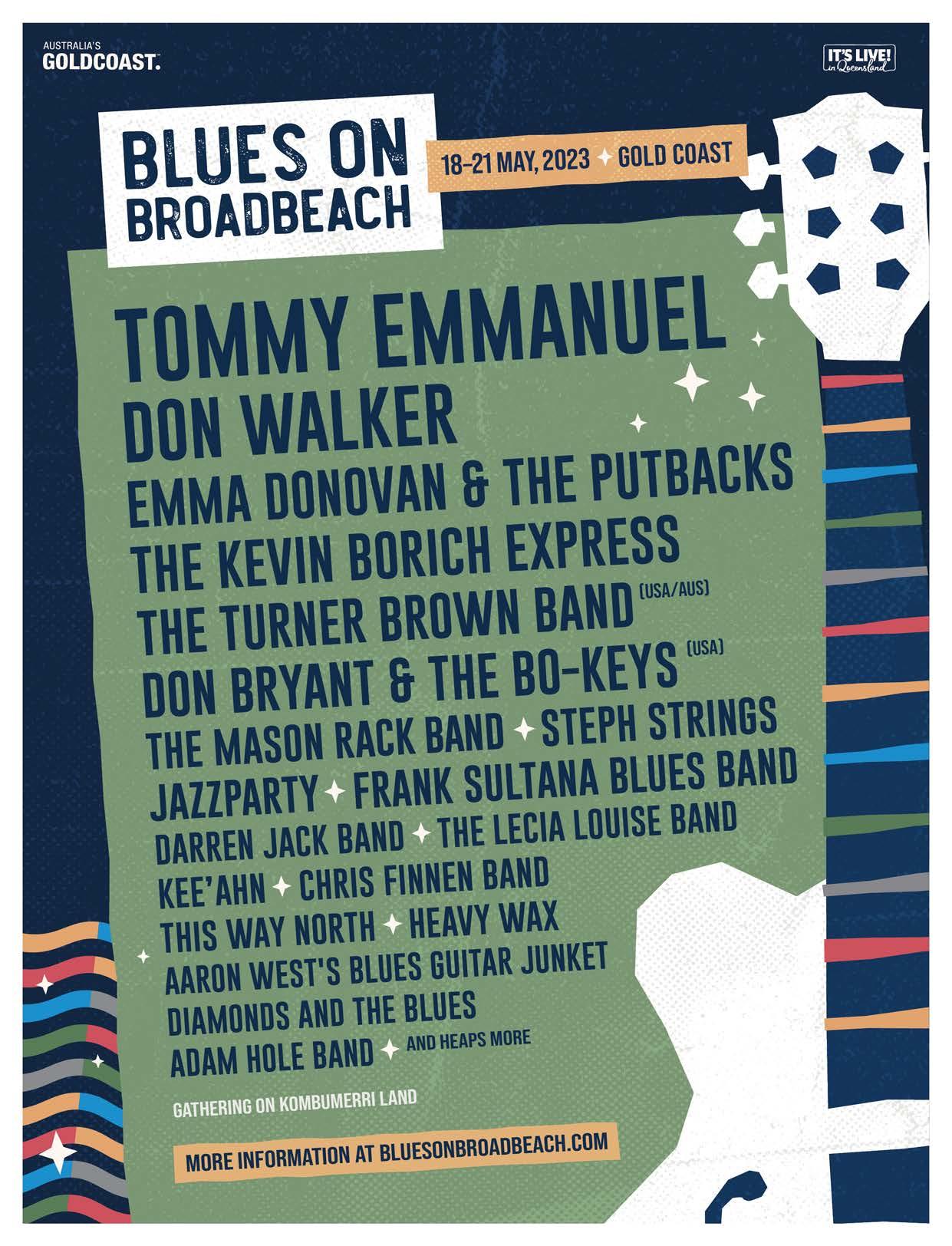
Welcome to the Rhythms Sampler No.22
which will get you into the music festival mood.

This year Rhythms celebrates its 31st anniversary, making it one of the longest running Australian music magazines in history. That is due to its loyal subscribers, some of whom have been with it from the beginning.

Subscribers are the lifeblood of the magazine and loyal advertisers (a small but perfectly formed group) have kept the magazine alive. Now you can help to do so too.
The only way to guarantee getting a copy of Rhythms every two months is to subscribe. With the constant shrinking of newsagents, it will be more difficult to get your hands on the magazine, so we’d love you to get on board and help us out.
Not only will you help preserve this unique magazine, but you will also receive our exclusive download card which will be your entry into a world of music, with many of the musicians featured in the pages of the magazine.
This issue’s download sampler contains:
THE BEST OF 2023
On Side A* we have some of the best tracks of 2022, personally chosen by the Editor as his favourite of the year and almost untouched by human hands. It’s

THE BEST OF WHAT IS TO COME!
On Side B* we have a selection of some of the best new music released in the past month or about to be released in the weeks to come. You’ll be dazzled by the talent.
This sampler is ONLY available to all print plus print & digital subscribers and is one of the benefits of being a supporter of Rhythms magazine. The other benefit is that you can help keep the magazine going into the future.
If you are not a member of the Rhythms family, then you need to join to get this download card sampler with each issue.
Please go to rhythms.com.au/subscribe and join us. Thank you to all the musicians and record companies that have donated songs. Thank you also to all the subscribers who have made this possible.
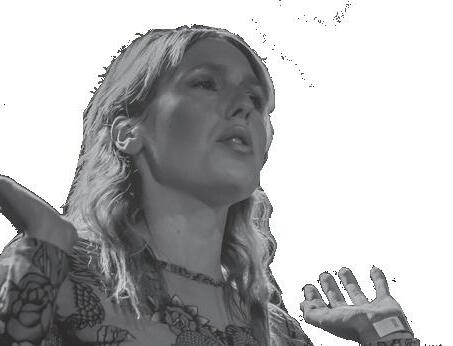
FULL DETAILS AND TRACK LISTING AVAILABLE AT: rhythms.com.au
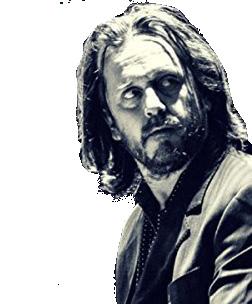
!
Yes! I would like to subscribe to Rhythms for: me a gift LET’S GET THIS ROCKIN’ WITH A:
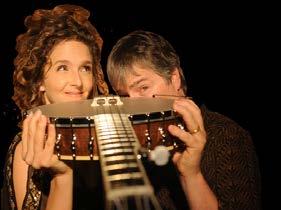
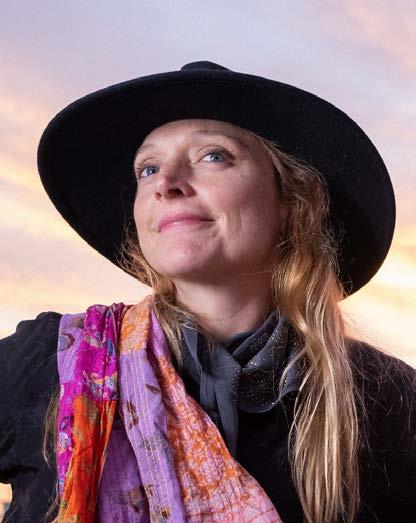

PRINT SUBSCRIPTION $65.00 Please fill in the form below with your details, or purchase online.
DIGITAL SUBSCRIPTION $40.00 - 1 year of the Rhythms Magazine Digital Subscription.


PRIGITAL SUBSCRIPTION Fill in the below form, or purchase online. PLUS 1 year of the Rhythms Magazine Digital Subscription.
Payment Details
My cheque/money order for $ is enclosed. or bill my mastercard visa Card no. / / / CVC / / / (3 digit number on the back of card)
Expiry Date
Cardholder’s name (please print)
Easy ordering options: Shop securely online: www.rhythms.com.au/subscribe Post this order to: Rhythms PO Box 5060, Hughesdale VIC 3166
MY DETAILS
Mr/Mrs/Ms/Miss Name Address Suburb/Town Postcode Email (Please supply email and phone number in case there is a problem)
GIFT RECIPIENT DETAILS
Mr/Mrs/Ms/Miss Name Address Suburb/Town Postcode Email
Please have card read “from “
THE FINER DETAILS: PLEASE MAKE A CHEQUE OR MONEY ORDER PAYABLE TO ‘RHYTHMS MAGAZINE’. PRICING INCLUDES SHIPPING WITHIN AUSTRALIA ONLY. FOR INTERNATIONAL ORDERS AND FULL TERMS AND CONDITIONS PLEASE SEE OUR WEBSITE OR CONTACT US FOR MORE INFO AT: SUBSCRIBER@RHYTHMS.COM.AU
PLEASE SUBSCRIBE HERE JANUARY/FEBRUARY 2023 RHYTHMS DOWNLOAD SAMPLER #22 Subscribe to Rhythms Print or Print & Digital today and we’ll send you our latest download sampler. New subscribers will also receive our exclusive 30th Anniversary CD Full Of Great Music .... AVAILABLE ONLY TO PRINT AND PRINT + DIGITAL SUBSCRIBERS GO TO: rhythms.com.au/subscribe FREE SUBSCRIBER MUSIC DOWNLOAD CARD $15.00 inc GST JANUARY/FEBRUARY 2023 ISSUE: 315 Womadelaide & Port Fairy Béla Fleck & Abigail Washburn Vieux Farka Touré Kronos Quartet Mary Coughlan Proclaimers Soul Rebels TOURING Ian Noe Early James Redd Volkaert & Ray Beadle Dog Trumpet Samantha Fish PLUS 2022 Readers & Writers Polls HISTORY The Greatest Concert Ever: The Rolling Stones At Kooyong 1973! The Loner: Neil Young “I’m letting myself out of the box I’ve been putting myself in for so long. There’s a lot of joy and triumph in that.” CELEBRATE 30 YEARS OF RHYTHMS, SAVE NEARLY 30% ON NEWSAGENT PRICE AND HELP KEEP AUSTRALIA’S ROOTS MUSIC BIBLE ALIVE!
FILL IN ALL THE DETAILS
PLEASE
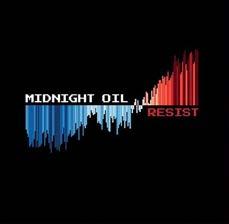
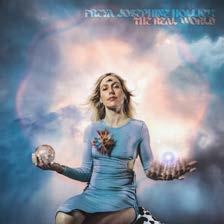



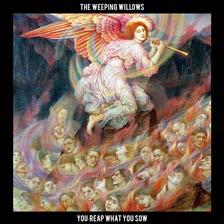
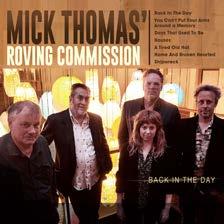
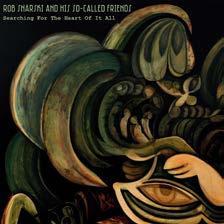



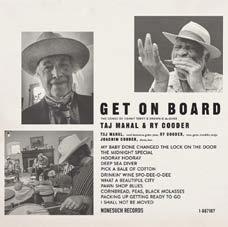
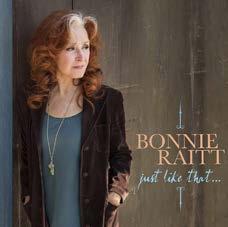

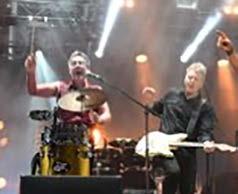
12 READERS POLL 2022 AUSTRALIAN ALBUMS OF THE YEAR Resist Midnight Oil 1. The Real World Freya Josephine Hollick 4. Now And Evermore Colin Hay 2. The Dreams of Jack Chrome Russell Morris 3. Gee Whiz, It’s Christmas! Vika & Linda 5. You Reap What You Sow Weeping Willows 8. Back In The Day Mick Thomas’ Roving Commission 6. Searching For The Heart of It All Rob Snarski & His So Called Friends 7. Sun Sessions Checkerboard Lounge 9. Hoodoo Gurus Chariot of The Gods 10. Dreamland Tanya-Lee Davies 10.= Get On Board Ry Cooder & Taj Mahal 1. Just Like That Bonnie Raitt 2. BEST FESTIVAL/EVENT Bluesfest Womadelaide / Port Fairy Folk Festival BEST tour Midnight Goanna, Anniversary

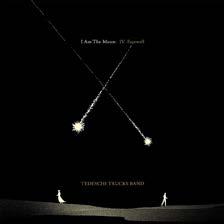
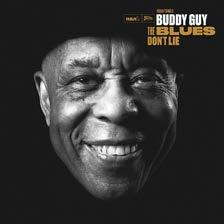
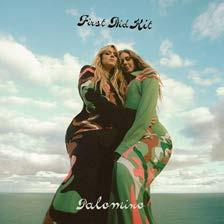
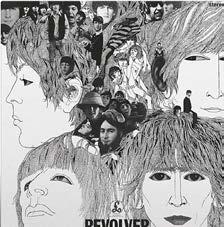
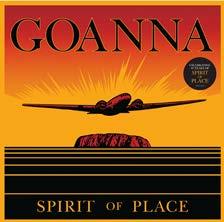

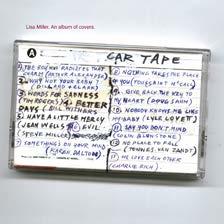



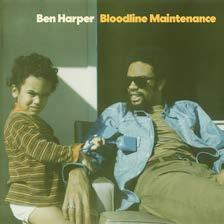



13 INTERNATIONAL ALBUMS OF THE YEAR Jerry Jeff Steve Earle 3. I Am The Moon I-IV Tedeschi Trucks Bandnight Oil 5. The Blues Don’t Lie Buddy Guy 7. Palomino First Aid Kit 9. Revolver The Beatles 1. Spirit of Place Goanna 1. Harvest 50th Anniversary Neil Young 2. Car Tape Lisa Miller 2. BOX SETS/RE-RELEASES - international BOX SETS/RE-RELEASES - australian Carry Me Home Mavis Staples & Levon Helm 4. Dropout Boogie The Black Keys 8. The Boy Named If Elvis Costello 6. Bloodline Maintenance Ben Harper 10. BEST MUSIC DOCUMENTARY Love In Bright Landscapes: The Story of David McComb of The Triffids Moonage Daydream Travelin’ Band: Creedence Clearwater Revival At Royal Albert Hall Oil, Resist Tour Spirit of Place 40th Anniversary Tour BEST MUSIC BOOK The Philosophy of Modern Song Bob Dylan Bill Frisell: Beautiful Dreamer Phillip Watson Wangaratta Festival of Jazz & Blues –30 Years, 1990-2020 Adrian Jackson & Andra Jackson
SIC U M NE SW COMES TO MELBOURNE
By Brian Wise
“It’s actually been a dream of mine for quite some time to do a festival in Melbourne, in the city,” says Neil Croker when we meet to talk about the arrival next Easter of Bluesfest in the city.
“One of my favorite festivals in the world is Montreux Jazz Festival,” continues Croker, who has had substantial experience running events and venues (he managed The Palais for a decade). “It’s on the edge of Lake Geneva and it’s got some permanent buildings around it. It’s all quite central. Every time I walked past Geoff’s Shed [The Convention Centre], I felt it was the same except it had a brown river instead of a blue lake to look at.” While the Yarra River might not seem quite as romantic as Lake Geneva and the event might at first seem to be an abbreviated version of the festival, when you add all the Bluesfest touring acts who will be in town around the same time Melburnians are going to get a substantial Bluesfest experience. Also, it will be all indoors, to allow for the city’s occasionally unpredictable weather.
“The facilities around it are great. There’s the plenary theater, which is a permanent theatre and then there’s spaces where we could build other stages. So, I’ve been looking for a couple of years for a way to do that. Finally, the penny dropped that Peter Noble’s got an amazing array of artists up at Bluesfest and a lot of them tour after Bluesfest or before Bluesfest, so let’s concentrate it all together and let’s put on a smaller version of Bluesfest in Melbourne. He jumped at the idea. He loved the idea of doing a city show. It’s really come together quite quickly. Now, we’ve got 30 artists already locked up and we’ve got three stages allocated and two days’ worth of blues and music locked in for the convention center over the Easter weekend.
“This is an indoor festival and given sort of the environment we live in these days, you’ve got to have air-conditioned comfort when you see your act but still have a festival feel. We’ll have a lot of activations in the foyers, and you’ll be able to move around and it’ll feel like a festival, but you’ve got to be very comfortable.”
Of course, one of the riskiest jobs in the world at the moment would have to be running a music festival, something that doesn’t daunt Croker, given his experience.

“It Is probably a bit silly,” laughs Croker, “but I’m getting old and silly at the same time. The aim is to make it work this year and create a brand. I know people will enjoy it and then we can grow it in the years to come and add some stages and a day, maybe. So, we’ll see how we go.”
“I started off working with Garry Van Egmond who was a great promoter,” explains Croker when I ask about his experience. “I joined him just at the time that he was touring Dire Straits for the Money for Nothing tour, which
was the biggest tour ever in Australia. I did tour management for a long time and promoting, did a bit of theater and some strange things. I ran the merchandising program at the Barcelona Olympic Games, looked after some Australian pavilions and world expos. So, big event stuff.
“Then, I was really quite tired of travelling and the opportunity to tender to lease the Palais Theatre came up and we won that tender back in about 2006. We built it up and we were doing about 130 shows a year when our 10year lease expired and it went to tender. When it went to tender one of those big multinational companies swooped in and outbid us and took over the theatre. But it’s been an opportunity. It’s allowed me to go back to my roots and I’ve spent the last five years promoting and producing theater, which is fantastic. This is just one of the most exciting projects I’ve ever done.”
Melbourne Bluesfest, which will run on Saturday April 8 and Sunday April 9 on three stages, will start in the early afternoon and run through until late in the evening. At the same time people will be able to buy separate tickets to the larger Plenary for shows by The Doobie Brothers (who Croker tour managed in the ‘90s) and also Paolo Nutini.
“So, we’ll have a nice feel, but everybody will still be in a quite intimate environment,” says Croker of the indoor festival site. “We’ll have food trucks indoors. We’ll have breakout areas with banana lounges. We’ve got actually some enclosed outdoor space with barbecue facility. I hope it will have a really comfortable village, music festival type feel around the stages.”

Of course, two long-time favourites - Steve Earle and Lucinda Williams - will also be at the festival.
“They’ll be performing separately but they’ll be following one another,” explains Croker. “So, Steve will be the first act and Lucinda will be the second, and they’ll be a late afternoon, early evening act on one of the stages.”
“I’m loving Southern Avenue as my sort of working day background music these days,” says Croker, talking about some of the festival acts. “I’m playing a lot of them. Of course, we’ve got some great local acts as well, and we’ve got a few more local acts we’ll be announcing just after Christmas to come into the bill as well. Robert Glasper’s sort of that jazz crossover sound and will be fantastic. Of course, it will be Buddy Guy’s last performance in Melbourne. He’s announced this as his last tour. Even though he is getting old, someone who saw him a couple of months ago said they couldn’t believe he did a 90-minute set that just blew them apart. So, he’s still in fantastic form.”
Melbourne Bluesfest runs on Saturday April 8 and Sunday April 9.
14
The legendary event makes a foray down south under the guidance of Neil Croker.
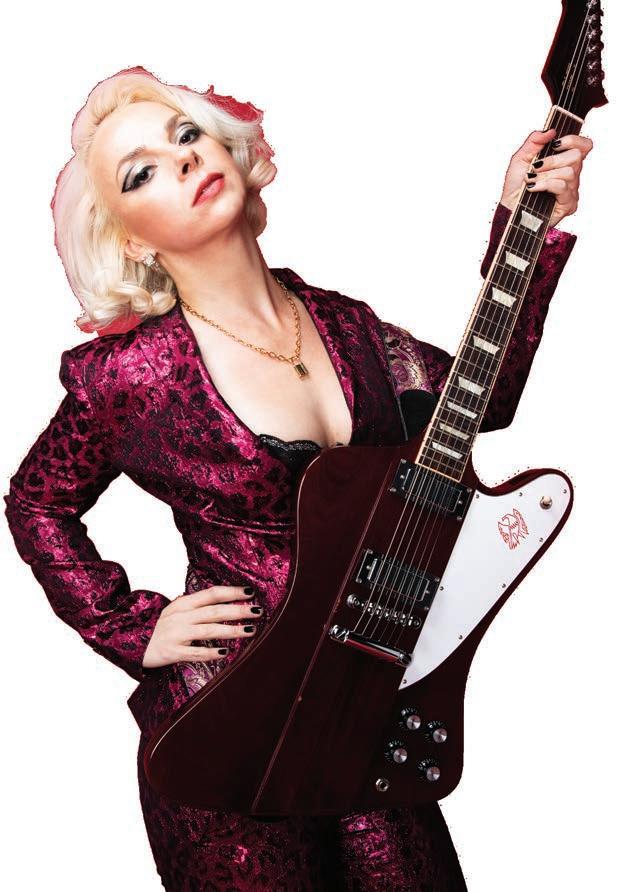

Bringing their music to Bluesfest nd other dates,
New Orleans brass collective The Soul Rebels are the ultimate party starters, fusing together an infectious blend of disparate sounds and styles such as jazz, soul, hip hop, funk, rock and pop andin a process akin to alchemy - ending up with a distinctive and exuberant blend which is entirely their own. By Steve Bell
The unique scope and versatility that this approach affords them has found the band sharing stages or collaborating in the studio with an incredibly diverse array of artists spanning the entire musical spectrum - from The Rolling Stones to the Drive-By Truckers, from Metallica to Katy Perry and everyone in-between - a long and exhaustive list of highprofile names who’ve all enjoyed the benefits of The Soul Rebels’ joyous accompaniment.
In recent times Australian fans have been privileged to experience the ensemble operating deftly in the hip hop realms. After lifting the roof off the tent alongside iconic NYC rapper Nas at the 2017 instalment of Byron Bay’s Bluesfest - and drawing a similarly rapturous response to their own headlining set the next day - this time around they’re returning to Australia accompanied by an epic bill of vocalists featuring the legendary GZA (of Wu-Tang Clan fame), veteran NYC MC Talib Kweli and New Orleans-bred bounce pioneer Big Freedia.
“We’ve been playing with those acts for quite some time now, so we’ve got the show pretty much dialled in. We just get up there and do it man, make it happen,” laughs trumpeter Julian Gosin. “We’re pretty much onstage the whole time - we do our thing, and then we bring out the guests.
“We pretty much figure it out the day of the show how many songs - and which songswe do with each artist, but we have a pretty extensive repertoire which allows us to withstand however much time we need with
REBEL! (SOUL) REBEL!
SIC U M NE SW
UPDATE
each artist, and to cater to what they want to bring to the table for that performance.
“Obviously Freedia is from New Orleans so that was kind of the most organic relationship, and we’ve been doing shows with Talib for quite some time now - it’s been almost 10 years with Talib and we’ve been playing with GZA for at least five years - so we’ve been building those relationships over time, it’s going to be a lot of fun.”
While on the surface it seems almost incongruous for an organic brass outfit to be laying down the backing for hip hop artists, Gosin explains that they’re really just flipping the usual genre tropes on their head.
“When it comes to replacing samples in a song with live instruments it’s actually really organic, because if you think about it the essence of the sample is actually live instruments,” he tells.
“So, it’s not reversing the process as much as taking it back to its most organic form, if you will. So, depending on the song it’s usually a natural transition for us because those samples are made up of actual horns, so it’s really just easy and fun.
“And the vocalists seem to enjoy playing with us because it’s a little bit different to what they’re used to, for sure, besides the usual stage band. It’s a little bit different when it comes to the instrumentation”.
And as far as The Soul Rebels are concerned, according to the trumpeter, it doesn’t really
matter at the end of the day what style of artist they’re performing with, as it doesn’t affect the ultimate ambition of their live experience.
“At every show we play - no matter who it’s with - the main goal for us is to connect with the crowd, to make music that’s universal and which can enable you to share your story with fans all over the world, and to bring great joy to people through music,” he enthuses. “We try to always bring an uplifting vibe to the party or the establishment, because you never know what people are going through and what kind of day they had, and if we can assist and make it a little bit better than our jobs are done.”
The Soul Rebels have actually been in existence for over 30 years with a slowly evolving lineup, and Gosin - who’s been in the band himself since 2010, having been a fan beforehandadmits they haven’t always been welcomed with open arms by New Orleans traditionalists, purists who don’t appreciate deviations away from their city’s rich history of brass and marching bands.
“That’s always a thing, especially with New Orleans,” he reflects. “They treasure their history and when you push the envelope and expand sometimes that’s not always received that well, because they expect you to be what they’re accustomed to having in their own little personal bubble.
“But sometimes as artists and creators you just have to follow your own goals and your instincts and do what feels best for you, and sometimes that means stretching the realm and going outside the box, no matter how people feel or what people say. At the end of the day, it’s always about the art - if you stay true to yourself the art will always prevail, regardless of the situation.”
The Soul Rebels will be at Bluesfest in Tyagarah and Melbourne and also doing dates with Big Freedia, Robert Glasper, Talib Kweli and GZA. Visit rhythms.com.au for details.

16
eight-piece
LOST FUTURES, GAINED PRESENCE
You may not have noticed that the contemporary female guitarists who are lauded online have one requirement - they must ‘shred.’ They often play heavy metal and wear black plastic or leather. Have you ever noticed that Joan Jett* is always included in that annual list of ‘best female guitarists’ even though she always has a male lead guitarist with her and the extent of her guitar playing is power chords? When you are asked who are the great female guitarists, can you only name Bonnie Raitt* and Joni Mitchell*?
Why must female artists wear skimpy clothes and writhe around the stage as if they are having sex with an invisible partner? When you are a female artist who doesn’t writhe you look ‘bored’ or are boring and yet you’ll see one of our male peers just standing at the front and playing and singing and he is described as ‘rivetting.’ The pushback against unique female musicians has been monumental since before any of us reading this were born.
You may not know how hard the music business has tried to discourage women from playing instruments, how women instrumentalists were kept on the fringes of music, how the female horn players in the 1930s had to form all-women big bands and be cast as novelty acts because they were not invited to play alongside their male peers. Women were meant to sing and look pretty, otherwise, back off.

Even now, you will see the business wrenching the instrument from a woman’s hands. Take for example, Norah Jones on the Grammys. No piano! Just singing (and thereby ineffectual.) And what about Brittany Howard with Alabama Shakes at the Americana Awards - no guitar! Whose ideas are these? What is the result? The women are reduced to being singers. Their only worth is how ‘good’ their voice is. Whereas the essence of why both of these women are unique is that they are instrumentalists.
The very emphasis on ‘the voice’ that has come into play the last 10 years is to me a sign of the
shallowness of our times. Unique voices are discouraged. To succeed you must sound like someone already famous. Everyone is singing these elaborate trills and yet somehow all singing the same homogenous notes.
The most recent cover of The Nashvillean Magazine features an Americana darling posing without trousers or skirt on and I am left to wonder if all the young kids taking up uke and guitar think that is what it takes for a female in the music business to succeed.
So, it’s nice to see a musician like Marisa Anderson garnering some attention and making a career out of just playing guitar. She has released six solo albums and multiple collaborations with artists such as Jim White (Dirty Three) and William Tyler. The album recorded with the latter is called Lost Futures

The two met at a Portland, Oregon show - “There was an obvious and immediate affinity musically and personally which led to the feeling that we should try and do something together…’ says Anderson. When Covid shut down their respective tours they found they had the time to launch the project, composing together remotely and then meeting to record at Flora Recording & Playback in Portland during that wild time of protests, riots and private police kidnappings in 2020.
William Tyler is well loved in Nashville due to his being a member of bands such as Silver Jews and Lambchop and for owning the now defunct venue, Stone Fox. He may well have the gift of eternal youth as he still looks 19 even though he was born in that magical year when music made the giant shift away from disco toward the new wave -1979. His parents are hit songwriters which gives a child a secure platform from which to launch a music career. What is delightful is that William Tyler has forged a creative path of his very own and remains a unique and creative guitarist.
The Blue Room has traditionally been Jack White’s private venue for showcasing friends and family of his Third Man Records label but just recently they have opened the room up for touring and local
BY ANNE MCCUE
artists which is a great boon for Nashville because the indie music venues are struggling to stay open and some, such as Exit/In, have lost that battle.
Tyler and Anderson played a duo show in Nashville to celebrate their collaborative album, Lost Futures. The music ranged from ambient to Latin, cosmic country to psychedelic bluegrass and much in between. I’m listening to the album as I write this and enjoying the sonic landscapes immensely. Standouts for me are At The Edge Of The World and Hurricane Light
It’s quite a lot to ask an audience to stand for over 2 hours on a concrete floor listening to instrumental guitar music but we did it! It was an inspiring show for me as a guitar player. When I see artists being themselves, not posing or pretending, just playing, that’s when I have hope for music. Little pockets of humans playing music, being listened to by handfuls of people who really dig it. Let’s hope it never goes away! No-one writhing around, no backing tracks, just two humans conversing with their instruments. No pyrotechnics and flashy playing. Far removed from those ‘90s guitar heroes in their white hitops and acid washed jeans who were technically perfect but musically deficient. This was a night for modest souls without the showbiz.
They played together and each took a solo turn in the middle of the show before returning to the duo format. The Blue Room is a small room, blurry at the edges and was comfortably full. We each had a little space around us. I felt lucky to be there.
I’ve been listening to the record all day and enjoying it more each time. I’m finding instrumental music more palatable in these anxious and volatile times. It leaves room for the imagination to create one’s own stories, feeding off the emotion of the performances.
Lost Futures is on Thrill Jockey Records. marisaandersonmusic.com/williamtyler.net
*No slight to these artists is intended. Rather, I am intending to slight the music business.
17
An editor at the Sunday Herald Sun would often walk past Paulie Stewart’s desk and snidely remark:
“You can’t write, can’t sing, can’t play a musical instrument. How do you survive?”
While working at the newspaper, Stewart was the leader of the in-house band, The Young Ruperts. In his three decades at the company, he had just one encounter with the proprietor. When Murdoch spotted Stewart in his usual colourful attire, he remarked to the security guard. “Please tell me I don’t employ that guy.”
“Yeah,” the guard replied, “that’s Paulie, he’s worked here for years.”
While working as a music journalist, Stewart joined a band to play a one-off gig to pay the parking fines of their mate Bill Walsh, the drummer in Cosmic Psychos. “This was an era when music groups were admired for raising funds for good causes,” Stewart recalls. “I’ll admit that paying off Billy’s parking fines was not exactly battling famine in Africa but, hey, it seemed like a good excuse for a fun night.”
The gig came to an abrupt halt when a guy who lived next door to the Port Melbourne pub stormed in and chopped up the mixing desk with an axe. “In a way, he was just delivering the first of many bad reviews we would receive over the years.”
And the band that formed for just one gig? Well, the Painters & Dockers will celebrate their 40th anniversary in 2023. “I am so proud of the fact that we are still going, and that we have always been a people’s band – anyone can get up and perform with us,” Stewart writes in All the Rage, his just-released autobiography.
It’s a riotous read. Stewart includes a warning at the start: “A large amount of this material was written under the influence of morphine and oxycodone in Ward 8 at the Austin Hospital … so don’t take it all as gospel.”
Filled with laugh-out-loud moments and several heartbreaking and dramatic scenes, it’s a tale of triumph and tragedy. Stewart’s life was shaped by the death of his brother Tony, a member of the Balibo Five, a group of Australian journalists killed while covering the Indonesian invasion of East Timor in 1975.
Stewart believes his absurd, anarchic antics were a reaction to his brother’s death. The first song he wrote was called ‘Pull Me Off (My Silly Pedestal)’, and the Dockers did a series of unforgettable gigs.
Stewart recalls a show supporting Nick Cave, where “he came backstage to get ready, only to sit on one of our stage props: a huge fresh fish. ‘Hey, what’s with the snapper?’ Cave asked.”
Another night, the Dockers supported The Pogues. Singer Shane MacGowan walked into their dressing room with blood pouring from his nose. When he ran through the planned set list, he was met by an awkward silence. “Ah, Shane, we are actually the support band. Your band is in the next room.”
“Well, you can fuck off then,” MacGowan said before exiting.
Remarkably, when Canadian rocker Bryan Adams started a record label at the end of the ’80s, he signed the Painters & Dockers. When they arrived in Canada for a tour, they were greeted by the record company who told them to “go ahead, we’re waiting for the band to arrive”. “They looked horrified when we told them we were in fact the band, not the road crew.”
The Dockers did 28 shows in 32 days in Canada, touring at the same time as The Rolling Stones. The Vancouver Sun review was headed: ‘Painters & Dockers Cheaper and More Fun than the Stones’.
To help promote their single ‘Safe Sex’, the tour was sponsored by King Kong Condoms and Stewart would throw condoms into the crowd. Waiting for them whenever they checked into a hotel would be a box of 500. “You guys like to party then,” noted one wide-eyed receptionist.
Ah, yes.
All the partying caught up with Paulie Stewart and he nearly died in 2007. He’s candid about why he needed a new liver. “I had contracted hep C by using shared needles ‘shooting up’ heroin. I didn’t do it for months, I didn’t do it 30, 20 or even 10 times. I did it three times. Why? Because my friend was doing it, and I was blind drunk. What an idiot I was.”
In hospital, the singer woke up to be greeted by a nun from Timor-Leste. She told Stewart she would pray for him. The next day he got his new liver.
“In the 1980s it was all sex, drugs and rock ’n’ roll, now I was hanging out with nuns,” smiles Stewart, who has dedicated his life to helping the people of TimorLeste.
Renowned Australian author Inga Clendinnen – who also had a liver transplant –encouraged Stewart to write his life story. The result is a remarkable read – and a defiant middle-finger to that newspaper editor.
Not only did Paulie Stewart survive, but he lived to tell the tale.
All the Rage is out now on Melbourne Books.
6 Things We Learn in All the Rage
Paulie is no fan of Gough Paulie Stewart believes the Whitlam Government knew the fate of the Balibo Five a week before his family was told. “Seven agonising days,” he writes. “It was an unnecessary pain inflicted for the sake of diplomatic relations. In the decades that followed my brother’s death, I wrote to the Prime Minister Gough Whitlam and pleaded with him to contact Mum and offer his sympathies. After all, he was in charge when it happened.” The call never came.
He also doesn’t like Diana Krall
When Stewart brought a young work experience student to his interview with the Canadian jazz singer, she erupted. “Who is this? Who said she could come in? I want her out now!” The teenager left the room in tears and Krall “won herself one scathing write-up”.
But he loved interviewing Keith Richards “Mate, you must have done millions of these interviews, but does Australia really stand out from other countries or is it all just one blur?” Stewart asked the Stones legend, who started singing, “There was a redback on the toilet seat when I was there last night. I didn’t see him in the dark but boy I felt his bite.” Stewart was so flustered, he forgot to turn his tape recorder on. “If only I had recorded it, added some backing music and released it as Keith Sings ‘Redback On the Toilet Seat’, I could have made a bloody fortune.”
He’s no good at career advice
Stewart was surprised when a band told him they were planning to quit rock ’n’ roll and form a kids group. “There’s no money or fame in children’s entertainment,” Stewart told The Cockroaches, who became The Wiggles. Painters & Dockers weren’t TISM, but Paulie did give them a leg up “One of the best compliments the Painters & Dockers received was the persistent rumour that we were actually TISM in disguise. I think this came about because one of the early reviews of the band said, ‘These guys are shithouse, just like the Painters & Dockers but in masks.’” A family connection led to Stewart being given a tape of the band. “I was intrigued by the label – ‘Defecate On My Face’ – and when I popped it into a cassette player, the song was a ripper. I passed the tape on to Michael Lynch [who became TISM’s manager].”
The legendary Lobby Loyde got the Dockers a record deal Guitar great Lobby Loyde became the Painters & Dockers producer and manager, getting them a record deal with Michael Gudinski’s Mushroom label. “At one point he drove me crazy by having a lengthy dispute with Gudinski over our record deal,” Stewart reveals. “Lobby refused to sign it unless Gudinski agreed that if life were found on other planets, Lobby would have the right to negotiate a separate deal with the aliens … Lobby: great guy, great musician, utterly useless businessman.”
18
SIC U M NE SW
Artist, activist, writer, raconteur … Paulie Stewart has always done things his own way. And now he’s documented his remarkable life in a compelling new book.
By Jeff Jenkins
Read Rage
5 Great Quotes
“I liked the anarchy we brought to many a suburban pub and I liked shit-stirring. The thought of being a normal, mainstream popstar appalled me. With a murdered brother forever lurking on my mind, I couldn’t tolerate normal and relaxed. If life was short, I wanted to make my mark and scream into the night.”
“Apparently, I had an unsavoury reputation … this wasn’t helped by one of my early media interviews about the Dockers, in which I was asked if I had any hobbies. ‘Taking amphetamines’ was not a wise answer.”
“I had lived like there was no tomorrow, but tomorrow came.”
“My most startling discovery was just how boring boozy conversations are when you are sober. After decades of thinking that my drunken banter was hilarious and amazingly astute, I suddenly realised that it was just repetitive blather.”
“And for all my sins, I have been lucky enough to love and be loved.”
Write On
Those who can’t do, write? But some journalists are also musically talented. Alongside Paulie Stewart, here’s a list of six local writers who also rock.
Sean Sennett – The long-time editor and publisher of Brisbane street press publication Time Off has also made records with Rob Hirst, Steve Kilbey and Kate Ceberano, and written songs with Ross Wilson and Stephen Cummings.
Christopher Hollow – The Rhythms columnist (“Underwater Is Where The Action Is”) is the bass player in Melbourne flower punks The Sand Pebbles, who have released seven albums.
Jo Roberts – The Rhythms writer and former editor of The Age’s EG is the guitarist in Melbourne band Holocene.
Keith Glass – The long-time Rhythms contributor fronted the ’60s band Cam-Pact. He released his debut solo album, Going Over Old Ground, in 1989 and has issued a number of records since.
Iain Shedden – The music writer for The Australian was also the drummer in The Saints. He died in 2017.
Greg Quill – After fronting ’70s band Country Radio, Quill moved to Canada, where he was the entertainment writer at the Toronto Star until his death in 2013.
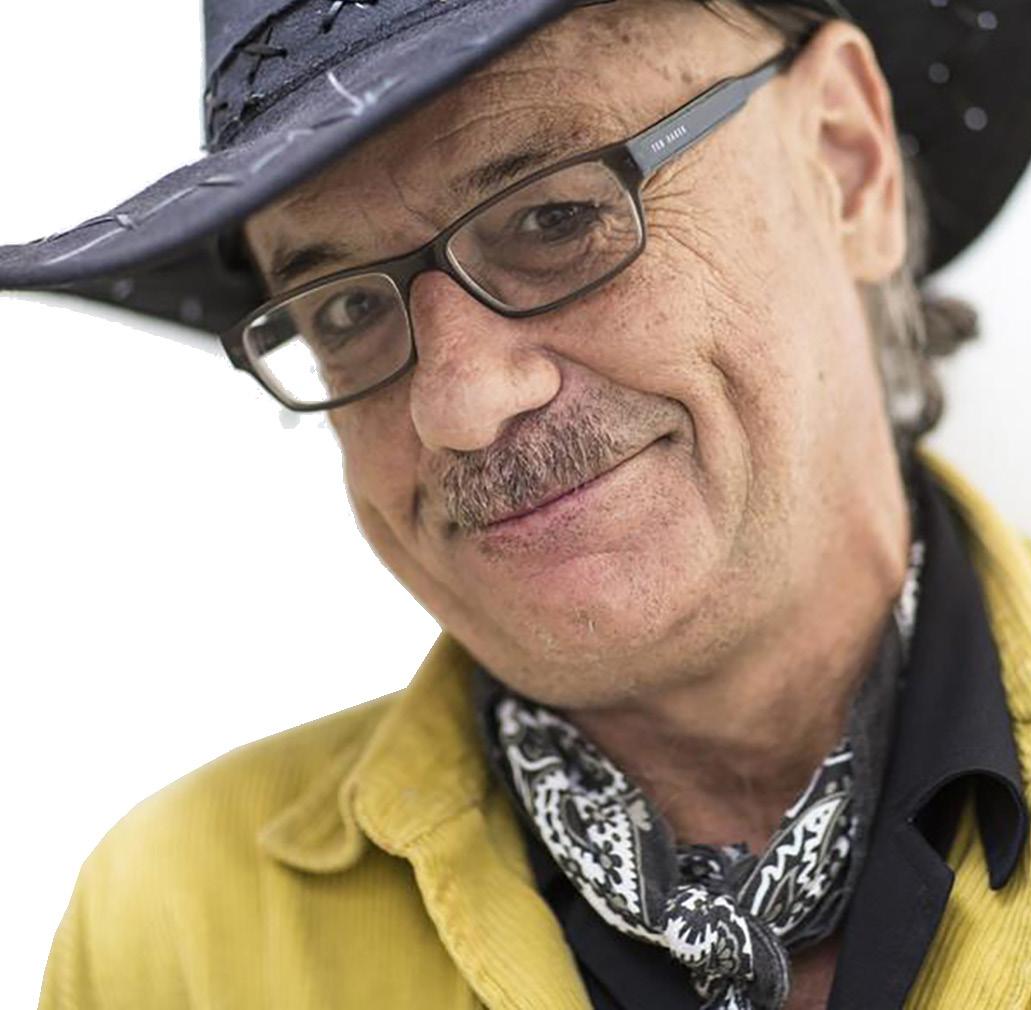 Paul Stewart.
Photo by Sarah Enticknap
Paul Stewart.
Photo by Sarah Enticknap
19
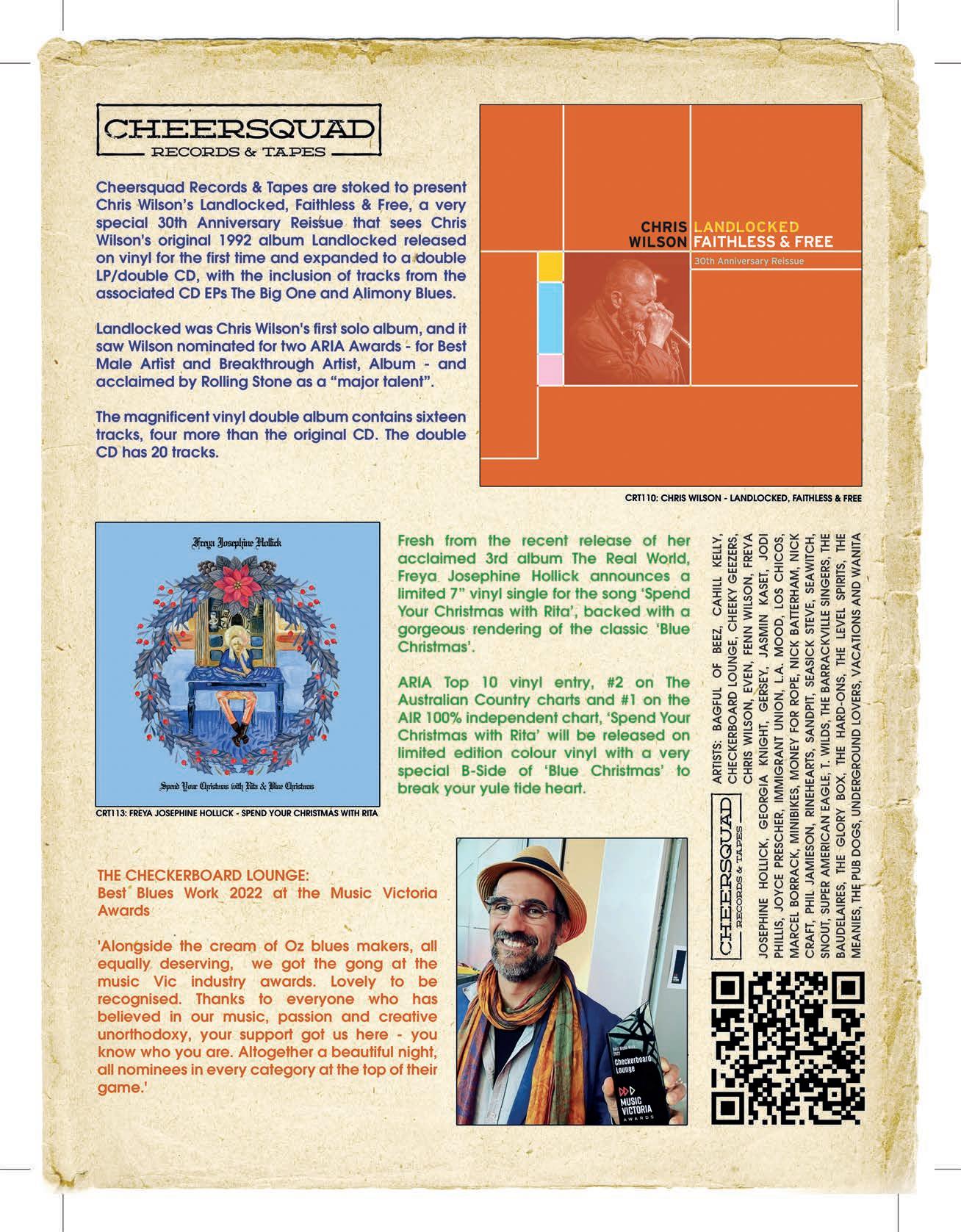
21 19-TWENTY • AJAK KWAI ANDREW GURRUWIWI BAND • ANNA SMYRK • BABY VELVET THE BADLOVES • BILLY BRAGG (ENG) BLUE MOON MARQUEE (CAN) BLUES ROULETTE • BUD ROKESKY • THE BURNING HELL (CAN) CLAYMORE COLIN LILLIE • DANI LARKIN (IRE) EARLY JAMES (USA) EASTBOUND BUZZ EILEN JEWELL (USA) ERIC BIBB (USA) FIONA BOYES • FOLK BITCH TRIO • GALLIE GEORGIA MOONEY • GEORGIA STATE LINE • GINA WILLIAMS & GUY GHOUSE GRACE PETRIE (ENG) GRIGORYAN BROTHERS • IAN NOE (USA) INN ECHO (CAN) JOHN SMITH (ENG) JON BODEN (ENG) JOSH PYKE • JUDY COLLINS (USA) KIM CHURCHILL • THE LANGAN BAND(SCO) LIZ STRINGER • MARY COUGHLAN (IRE) MINOR GOLD • NIAMH REGAN (IRE) NICK CHARLES • NORWOOD • REBECCA BARNARD & PETER FARNAN SALLY SELTMANN • SCOTT COOK (CAN) SKYSCRAPER STAN THE SOUTHERN OCEAN SEA BAND • STARTIJENN (FRA) STEVE POLTZ (USA) SWEET TALK • TIM EASTON (USA) VIEUX FARKA TOURÉ (MLI) THE WAIFS WHILE AND MATTHEWS (ENG) WILLIAM CRIGHTON 10 - 13 MARCH 2023 portfairyfolkfestival.com TICKETS AVAILABLE NOW MUSIC | ART | OCEAN More to be announced...

The havoc that the pandemic wreaked on many a musician’s career is well documented. Tours shelved, new albums of work lost in the dust of inertia, incomes ripped away – careers and ways of life upended overnight.
When it hit in early 2020 for Idaho-based singer songwriter Eilen Jewell, she was touring her eighth and then-brand new album, Gypsy. The same sad and cruel story unfolded; her income was gone, along with the relentless touring lifestyle she had immersed herself in for 16 years.
But for the country artist known as the Queen of the Minor Key, the cost became even greater – her marriage also broke down not long after.
“It was everything I knew,” she says. “My whole life fell apart.”
Jewell’s now ex-husband was – and remains –her bandmate, Jason Beek. “He was always in the band with me; my drummer and also my manager,” she says.
It’s not something Jewell has really spoken about, so the news comes as a sad shock when I ask about the life experiences that have informed her just-completed ninth album, after she has described the record as “very personal, with all that’s happened over the past few years”.
“I haven’t told anyone really,” says Jewell of her divorce. “It hasn’t been very public yet. And I just kind of feel like, well, enough time has gone by, it’s time for the world to know, and especially with the new album coming out.”
Get Behind the Wheel is the new album, though it’s not slated for release until May 2023. After we speak, Jewell very kindly shares a preview stream with me. Fans will
be treated to some glimpses from it when she tours Australia’s east coast in March to play a string of theatre and club shows, as well as the Port Fairy and Blue Mountains folk festivals.
The title track comes from a line in the cathartic opening song, Alive, as a nearprimal scream to self to regain control, as a stark new reality ‘comes alive’. For those who have compared Jewell at times to Lucinda Williams, it’s safe to say she out-Lucindas Lucinda in gravitas, grit and raw emotion in this remarkable opener.
“It’s a very open hearted, very big, lots of big feelings, big emotions … yeah, it’s a very personal album,” says Jewell. “Autobiography is kind of new to me. I used to kind of sing other people’s stories, but with all that’s happened over the past few years, I just really felt like what was important to me was to sing about what I was experiencing on different levels.”
Jewell’s well of experience ran deep, as she also suffered family losses during the same period – “not even COVID related but just one after another. It was just like, ‘I can’t believe I lost another person and another thing that was dear to me’.”
“And in all of that, it kind of showed me what really is important in life. And yeah, my heart broke for sure, but it also kind of broke open and I feel like I’m sort of more real as a person now as a result of all of that.”
To that end, says Jewell, Get Behind the Wheel “feels more real to me than previous albums”.
“I wonder if others will hear it this way, but to me, this album sounds really free,” she says. “There’s a lot of freedom in the way that I’ve written the songs and the way the band and I have performed them. I’ve been doing a
lot of exploring in my personal life. So yeah, I hear this [album] kind of like, I’m letting myself out of the box I’ve been putting myself in for so long. There’s a lot of joy and triumph in that.”
Jewell hasn’t been to Australia since 2018, so can’t wait to return with guitarist Jerry Miller, new bass player Matt Murphy and Beek, with whom she seems to have found a new ‘normal’ after almost two years of divorce. “We’re friends still, and we’re co-parents to a beautiful little girl.”
Their daughter Mavis (named after Mavis Staples) is now eight and is already showing her parents’ inclination towards music.
She’s writing songs – “I’ll hear her singing something and I’ll say, ‘what’s that song, that’s amazing?’ and she’s like, ‘Oh, it’s just something that I wrote’ “ – and inviting herself up onstage with her parents. And although she has been to Australia before, this time Mavis will remain in Idaho with Jewell’s mother due to school commitments. “School’s really important to her and she hates missing it,” says Jewell.
The death in October of country music titan Loretta Lynn also hit hard; Jewell’s love for Lynn was writ large on her 2010 album of Lynn covers, Butcher Holler – the name taken from Lynn’s Kentucky hometown.
In 2007, around the time of the release of her second album (Letters from Sinners & Strangers), Jewell had a “dream come true” when she got to not only support Lynn at a theatre in Massachusetts, but to meet her. Although Lynn had been unwell, when Beek told the star’s tour manager that he and Jewell also had a Loretta Lynn cover band called Butcher Holler, the delighted manager granted an exception to the ‘no meet-andgreet’ rule.
23
From the ruins of 2020, Eilen Jewell has written her most personal album to date – and you’ll hear some of it when she and her band return to Australia for the first time since 2018. By Jo Roberts
There’s a lot of freedom in the way that I’ve written the songs and the way the band and I have performed them. I’ve been doing a lot of exploring in my personal life.
“She was just so gracious and sweet and kind,” recalls Jewell of meeting Lynn. “And then, as we were getting our picture taken together, she said, ‘all right everyone, now say whiskey’. And we were just laughing so hard, because I guess we didn’t expect her to say whiskey. So now every time I get my picture taken with someone, I always say, ‘say whiskey’. It’s more fun than cheese.”
Jewell has plans for another album in 2023 “as a way of saying thank you” to Lynn – a re-release of Butcher Holler featuring additional material. Butcher Holler Revisited will have some live versions of songs already on the original, but also a version of Lynn’s fearless call for women’s liberation through contraception, The Pill
The song’s inclusion is timely, given the United States Federal Court’s recent reclamation of women’s reproductive rights;
in June 2022 the court sent shockwaves around the world when it overturned the 1973 ‘Roe vs Wade’ ruling that had entitled women to legal abortions in the US for almost half a century.
“We never recorded it before. I don’t know why I never thought to do that one,” says Jewell of The Pill. “She wrote all the songs on this album [1975’s Back to the Country], or cowrote, and I guess maybe I just wasn’t aware that she had actually written The Pill. So once I found that out, I was like, okay, well we have to add that.”
“It’s such a hot topic right now and I want to amplify that message, for sure.”
Jewell brilliantly addressed gender equality herself in the song 79 Cents (the Meow Song) on Gypsy, the 2019 album she will now finally get to showcase here.
A proud Democrat living in the deep ‘red’ state of Idaho – or “left-wing swine” as she calls herself in the song – brings her whip-smart, acerbic observation on gender inequality and the pay gap to the song in
deceptively cheerful ditty mode. “The heart of your home, works her fingers to the bone, for her 79 cents to your dollar”. Its alternate title is a swipe at the previous occupant of the Whitehouse and his leering ‘pussygrabbing’ boast.
Fingers crossed it will be in her live set when she finally returns to Australia. We’ve been a regular destination for Jewell and her band since the released of her third album 2009’s Sea of Tears, and her debut Australian tour on the back of it in 2010.
She has enjoyed wording up new member Matt Murphy – who has never been to Australia – about what to expect.
“We’ve been singing the praises of the people,” says Jewell. “We’ve been talking up [people in Australia], how they just love live music and they’re so sweet and friendly and they seem to have, compared to a lot of places in the US, a really high quality of life, and it shows. And the wine is really good and the food is lovely.
“And we try to steer the conversation away from spiders and snakes, because he’s very afraid of them. So he’ll say, ‘but yeah, but everything down there can kill you’. And we’ll say, ‘no, it’s great. We’ve been there many times. We haven’t died yet’.”
Spoken like a true survivor.
Eilen Jewell kicks off her Australian tour on Friday 3 March at the Archie’s Creek Hotel. Details at lovepolice.com.au. Her album Gypsy is available through Signature Sounds.
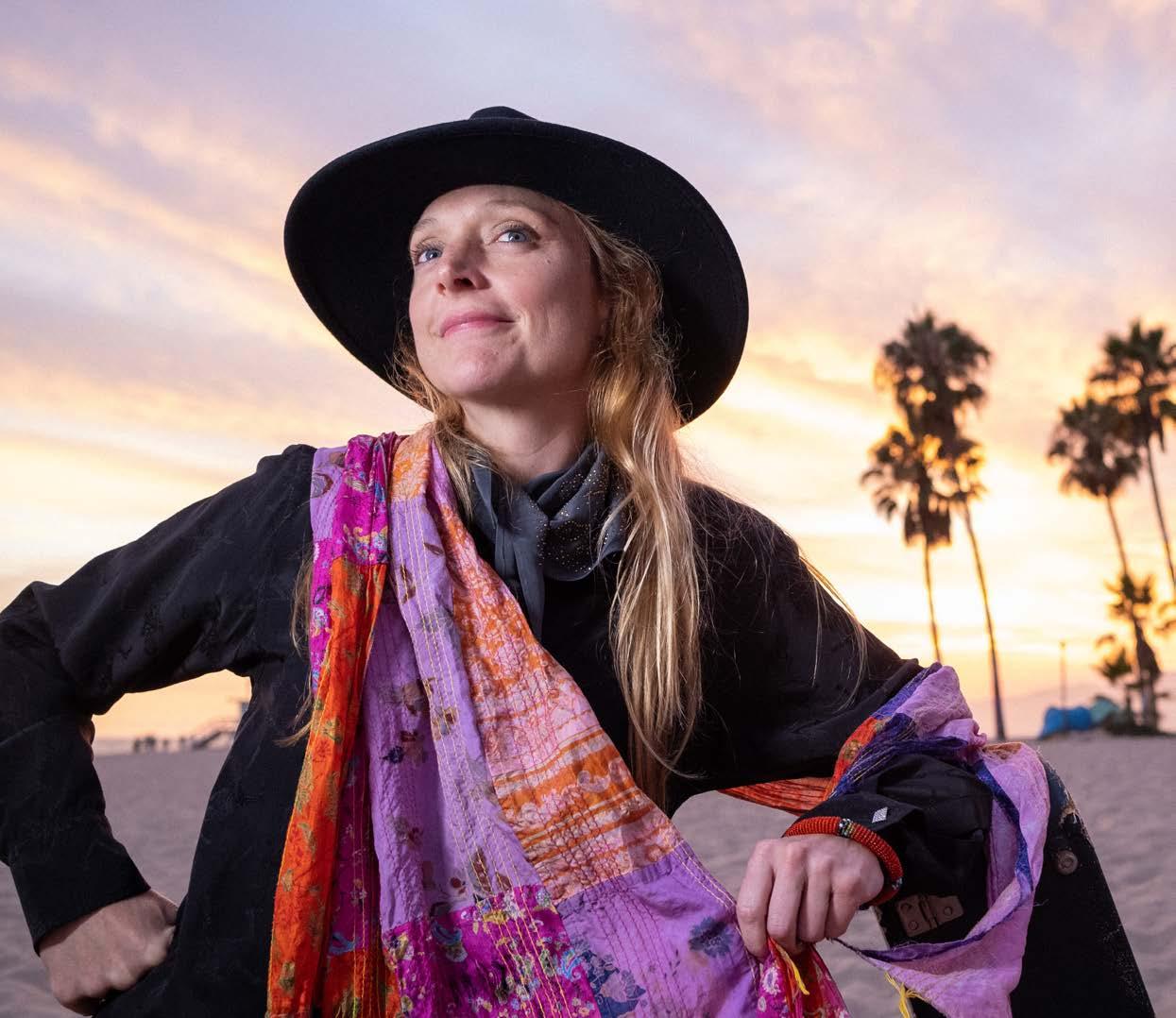
It’s a partnership made in music heaven. Béla Fleck, fifteen-time Grammy Award winner and Abigail Washburn, singersongwriter, clawhammer banjo player who combined it with a Far East influence. The analogy sounds like a cliché until you see them together, as I did at Americana a few years back. Not only could you experience the interplay between their two different styles of playing but you could sense the intense musical connection. One comparison that came to mind was when I once saw Dr John and Allen Toussaint sitting opposite each other at grand pianos and playing as if they were one person.

It is a rare connection and one that we will be able to see soon. Not only that, we will probably get the full gamut of educational and often amusing stories centred around the banjo; though in their humility they might neglect to mention the Grammys they have won together (1) and individually (Bela, 15, including this year’s Best Bluegrass Album gong for My Bluegrass Heart).
Fleck will probably explain how he plays banjo in a traditional style, like his hero Earl
By Brian Wise
Scruggs. Washburn might tell you about the clawhammer style that she saw Doc Watson use. Washburn might also sing in Mandarin, which she studied when she planned to live in China. They might also tell you how they first met at a square dance and began collaborating which led to an even deeper relationship.
They might play selections from their Grammy Award-winning self-titled debut album together from 2014 or from its followup Echo In The Valley from 2017. They could choose a selection from Fleck’s catalogue with his long-running, multi-award-winning group the Flecktones which he started back in 1988, preceding many of his eclectic collaborations and styles. Possibly they will delve back into Washburn’s early days with the all-women collective Uncle Earl in 1999 (with an album produced by John Paul Jones of Led Zeppelin) or the more recent Wu-Force; or, she might even tell you about being named the first US-China Fellow at Vanderbilt University.
Whatever the conversation, it is bound to be as delightful as it was for me catching up
with the couple on Zoom while they were in their home in Nashville prior to heading off on tour. Fleck is originally from New York and Washburn is from Illinois but they both love living in Nashville. The sounds of their two sons, aged nine and four drift away in the background as we talk. Like many close couples they often finish each other’s sentences.
When I ask when they first moved to Nashville, Washburn says, “I’ve been here almost 20 years, and Bela’s been here…..”
“I’ve been since here since 1981,” he says, “So quite a while. I’ve watched it change and it’s not all good from our perspective, but…..” “Some of it is,” chips in Washburn.
“I’m sure it’s a lot of fun to come to and be at a scene,” explains Fleck, “but as the town has gotten bigger and bigger, it’s not really prepared for it. Infrastructure isn’t really there and so we stay home more and more.”
“It’s true,” agrees Washburn. “It used to feel like a small town where you could get anywhere in 15 minutes, 15 to 20 minutes, and now…..”
“That’s all over,” says Fleck. >>>
25
Béla Fleck and Abigail Washburn are known as the ‘king and queen of the banjo’ and their forthcoming tour is sure to demonstrate the amazing sonic possibilities of the instrument.
>>> The good part, I suggest, is that there are still an incredible number of amazing musicians in Nashville.

“The town has gotten even richer and richer as far as the musicians,” agrees Fleck. “I’m always finding out about great musicians from all walks of music that have moved here. Jazz musicians, rock musicians, and, of course, great country musicians, singer/ songwriters, and great bluegrass players. A lot of them moved here from Brooklyn and a lot of people were up north, moved down here. So, that part is really good.”
“It’s gotten harder for young musicians to start here though, because it’s gotten expensive to live here,” adds Washburn. “Abby and I are coming over as a duo to Australia, and now we’re looking forward to that,” says Fleck when we move on to the forthcoming tour here. “In fact, we just did a number of shows. It was really fun to rediscover our duo.”
“But this year has been a very busy year for me,” he adds, mentioning that he is about to go out on tour for some dates with his own band before coming here. “Kind of reconnecting with the bluegrass community and just going back and finding a way to be myself in that world and really have had a wonderful time playing with all these musicians. The people in the band that I have are just some of my favorite musicians in the world of all music: Michael Cleveland and Sierra Hull, and Brian Sutton and Mark Schatz and Justin Moses. It’s just a great band. So, I think it’s very much a band that can stand up next to the Punch Brothers and hold their own, which is not easy to do. Those guys are the greatest out there these days, and so I’m excited to put the bands together and interact with them.
“So, after a busy year of touring with this band, this is going to be highlight. Then we’re going to kind of put it to bed for a while and I’ll be doing things like this with Abigail and some other projects that have been waiting.” What does he mean when he says that he had to reconnect with the bluegrass community?
“I guess I felt at a certain point by the end of the Eighties that maybe – and it’s not that I was bored - there was a lot of stuff that I could do outside of that world maybe that other people couldn’t do."
“There’s a lot of great bluegrass players and even a lot of great modern bluegrass players coming up. But I felt there were things, there were areas, that I could maybe make some headway. So, some of it was like interacting with jazz musicians and classical musicians and musicians from different cultures.
“I just really wanted to step out and - because I’m not from the South, I’m from New York City - I always felt a little bit outside of bluegrass. But I really did find the community there. But then I went off and I started the Flecktones, that really took off and it was
completely banjo outside of bluegrass, clearly in a situation where it could be played in rock venues and jazz venues and world music venues and not seen as a hillbilly Southern white instrument. Of course, I loved the hillbilly Southern white banjo playing. I wouldn’t play the banjo if it wasn’t for Earl Scruggs, but I’m from New York City, so it had to be honest for me as well.
“So anyway, periodically I would go back and reconnect with my clan of the best bluegrass musicians, my favourite bluegrass musicians, I should say – Tony Rice, Sam Bush, Jerry Douglas, Mark O’Connor, Stewart Duncan, Mark Schatz - and make a record like every 10 years or so. But then in between I was playing with Chick Corea, I was playing with a String Quartet, I was playing with orchestras, I was going to Africa, I was playing with the Flecktones a ton.
“So, in fact, the first thing that was kind of close to coming back to the bluegrass world was playing with Abigail, which was very much of a roots project where we have to have the banjos down front and centre. It was a real joy to go back and play a lot of those festivals and be part of that community with Abigail, which is part of what drew us together. But it was one big step away from that to actually go back to playing in a bluegrass band.”
Of course, Washburn has her own career, so how does the collaboration work?
“Well, in a way, it’s been a collaboration of convenience,” she responds, “although we always did want to make music together, but when we had our first child, Juno, that’s when we made our first record. I wouldn’t recommend having a baby and then making
26
your first record, which is what we did. I would make the record and then have the baby. That was challenging.”
“We could have planned better!’ she laughs. “The next time when we had Theodore, our second son, five years later, we did plan ahead, and we made our record before he was born. And then that was a lot smoother. But we decided we really wanted to hit the road together so we could be with our child and then our children together and it’s been so wonderful to be able to tour as a family. What an incredible privilege to get to do that. Now our son, Juno often will sit in on a song and sing with us during the show and is starting to play fiddle. And our dream of the family band, growing it from the ground up is happening.”
“There was also a history of some families in bluegrass,” says Fleck.
“I was always thinking about Norman Blake and his wife touring together, how he just decided, ‘I’m going to play with my wife.’ And he built a whole career for him and his wife to have a whole way of playing. He could have done a lot of different things and it was great. It was different. It was a whole new offering to the community. So, the other thing is that we didn’t know we were going to sound good together.”
“Yeah,” chips in Washburn. “I mean two banjo players that play two different styles, like building a whole repertoire of music around themselves, it’s not the most self-evident project. So, we both enjoy challenges. That’s one of the things I think that brings us together. We both enjoyed the challenge of how are we going to make this actually really musical and beautiful and fun and meaningful and how do we make a whole night of it? And then how do we make
going on 10 years of this music together and sharing it with the world. And now we have quite a backlog of songs and experiences together on the road.”
“We’ve built this musical web of the two banjos,” notes Fleck, “because for folks that don’t know, Abigail plays the old time style, which is an older style of banjo, more related to the African origins called claw hammer sometimes or flailing. I do the bluegrass style. We both do different things with these old styles, but they aren’t typically done simultaneously. So, we’ve come up with a lot of strategies for how to make these two banjos together, serve a song.
“Abby’s a great singer and fortunately we’ve got that going for us. So, we are figuring out how to surround her voice with the two banjos and create an interesting arrangement and take you somewhere with just the two. We bring instruments that are in different ranges. So, we have lower banjos and higher banjos and different tunings. We found a lot of strategies.”
“The cello banjo really opened up our duo as well and the baritone banjo,” says Washburn. "So, we’ll bring the baritone and cello banjo with us to Australia to share that with people. So, that just spreads out the dynamic pitch range a lot and creates a beautiful soundscape and neat spectrum.”
“Also, I just love backing up a great singer as if I was a pianist accompanying a vocalist,” says Fleck. “And so, I love supporting. On some songs, Abby can put down the banjo and just sing, whether it’s a blues-oriented screamer or whether it’s something very subtle or jazzy even. We both enjoy those kinds of things too. Also sometimes Abby sings and dances at the same time simultaneously, which is a show stopper. So, we got that going for us. Occasionally a kid comes out and they say, ‘You should never follow a kid.’ But when our kids come out, it always a lot of fun. People love it. So, that can happen occasionally too.”
Both of them were responsible for bringing renewed attention to the banjo over the past few decades and now that has expanded with musicians such as Rhiannon Giddens exploring the origins of the instrument.
“I think when I was playing in the Eighties, it was a little bit of a laughingstock,” says Fleck, “and if you put the banjo on something it dated it or it made it sound a little bit hokey. Nowadays, people put banjo on things to give it class. In Americana world, when you hear a band it’s like, ‘Well, what can I do to make this feel real rootsy and more meaningful? I’ll put a banjo on it.’ It’s a real change in perception from when I first came into it and ‘Dueling Banjos’ and Deliverance and everything that movie brought to mind and the very Southern white part of it in a negative way. There was a negative connotation to the banjo, and it was kind of a joke. I never liked that.
Bela Fleck & Abigail Washburn will be appearing at Womadelaide and doing other dates. Check the Rhythms Gig Guide at rhythms.com.au
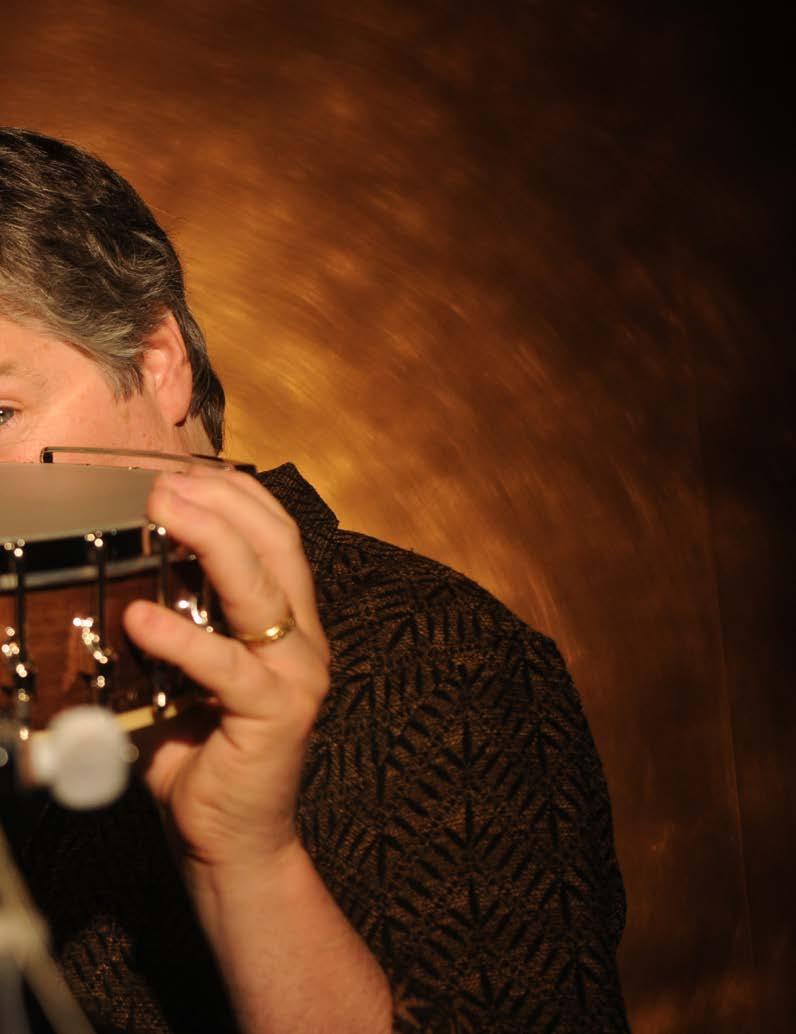
27
I never found the banjo funny. I found it to be very serious.”
“I think when I was playing in the ‘80s….. if you put the banjo on something it dated it or it made it sound a little bit hokey. Nowadays people put banjo on things to give it class.”
– Bela Fleck
“I mean, two banjo players that play two different styles, like building a whole repertoire of music around themselves, it’s not the most self-evident project.”
– Abigail Washburn
Malian guitarist and singer-songwriter
Vieux Farka Touré
legendary ‘father of African desert blues’, the late Ali Farka Touré. His new album ALI was made in collaboration with Texas-based trio Khruangbin. By
To follow in the footsteps of a famous parent can be challenging. Some will always be known as ‘son of…’ or ‘daughter of…’. The exceptional few go on to side-step comparisons. Like Nora Jones, Jeff Buckley, Liza Minnelli, Femi and Seun Kuti. Their iconic parents eventually became less of their own professional story. Malian guitarist and singer-songwriter Vieux Farka Touré has particularly large shoes to fill as the son of legendary ‘father of African desert blues’, the late Ali Farka Touré. Ali was a pioneer introducing West African music to the world stage. He wanted Vieux to be a soldier, in accordance with the family lineage expectation. But the calling towards a musical path was strong. Vieux was initially a drummer and calabash player at Mali’s Institut National des Arts, before taking up the guitar. Now a star in his own right, Vieux records and performs in his own acclaimed style – both spectacular and sublime.
Vieux has released two albums this year that honour the legacy of his father in different ways. ALI features covers of eight of his father’s songs. With a new interpretation to the tracks, the inspiration is undeniable but the sound is fresh. “Yeah, for sure,” he agrees. “I took the influence from my father but I have my own side, my own music. Because when you’re the son of somebody, you have to do your own stuff. To do something good, you have to bring something new. It’s what I’m trying to do.” ALI was made in collaboration with Texas-based trio Khruangbin, blending Vieux’s exquisite guitar and soulful voice with their dub-funk psychedelia. They recorded the album in June 2019, the songs selected by Ali’s 11 children. He enjoyed working with the trio. “It’s something we do very friendly, you know. We just go in the morning, sit down, speak first, say ‘OK’ and try to do something. It’s like if you’re with your friends. Very, very comfortable.”
Homebound in 2020, Vieux worked in his studio (‘Studio Ali Farka Touré ‘) to record his debut album for World Circuit Records/BMG (UK) who recorded and released most of Ali’s work. The album, Les Racines is his sixth solo release. It sees Vieux revisit the deep Songhai ‘desert blues’ roots that his father is known for. Malian musicians Amadou Bagayoko (Amadou & Mariam), Mamadou Sidiki Diabaté (kora) and Madou Traore (flute) feature on the album. It’s been said that every culture has its own ‘Blues’. Same-same but different. Vieux says,” Everybody has his own music to play. How he understands the music is very important. To compare the music and the artists is very difficult. People from Niafunké, play the music of Niafunké. There’s the blues of Kidal, the Ivory Coast... They have their own flavour. It’s like if you take peanut butter sauce. If you eat it in Australia or Mali or Senegal, it’s the same but with its own flavour.”
It’s at this point in our conversation that technology between continents lets us down. “The network is not good here,” Vieux sighs between disconnections. “It’s a big problem.” As can be daily life in Mali where political tensions continue to cause unrest, displacement and civilian lives lost. Les Racines track ‘Ngala Kaourene’ implores ‘We must make peace.’ Often targeted, many artists have been forced to leave their homes to settle in Europe or elsewhere. Vieux has remained in Bamako
with his large family. “It is what it is,” he says sadly. “It’s not that good but we don’t have a choice. We have to live like this. I’m staying in Mali with my family because I have to take care of everybody. We always hope it’s going to be better soon…” So, with various ‘app’ links failing, bass player Marshall Henry (go-between on the line) suggests I send further questions in print. Here they are:
Q: Les Racines has wonderful rhythms, percussion, clapping etc. Starting as a player of drums and calabash must have had an impact on your songwriting and guitar style?
A: Yes, my background as a percussionist gives me a strong rhythmic foundation to my guitar playing. It also helps me write the drumbeats and percussion parts for my songs. When I write a song, I usually come up with all the other parts in my head and then teach them to my band.
Q: What did you find most valuable in attending the Institut National des Arts in Bamako?

A: It was great to be exposed to top level musicians and I really enjoyed my time there. I had some professors that had studied in Cuba, so I actually learned a lot about Cuban music. There is a lot of connections between Malian and Cuban music. It’s something I’m interested in exploring more in my own music.
Q: You have worked in other collaborations before ‘Ali’. (Including Israeli singer-songwriter Idan Raichel and Malian kora master Toumani Diabaté.) Tell us about some of your most memorable times on stage with others?
A: My favourite way to work is spontaneously and just by letting the music happen. For this to work, you need to really immerse yourself
28
in
has definitely moved out of the shadow of his
Chris Lambie
“It’s great that Malian music is being recognised more and more. A lot of people only know about Mali because of our music.”
the music and be an active participant. Some of my favourite moments on stage are when I get to perform with friends that I haven’t seen in a while. I had a great time performing with reggae legend Clinton Fearon in Seattle a few years ago. Last time I toured in Australia the great guitarist Jeff Lang joined me on stage for a song.
Q: What guitars did you use on the latest recordings?
A: I have been playing Godin guitars since the beginning of my career. They are my favourite guitar.
I love Godin! On Les Racines I played my new Godin LGX-SA on most of the songs. I also played my father’s Seiwa Powersonic. It’s the guitar pictured on many of his album covers and is his most iconic guitar. It’s a very special guitar and I always feel a connection to my father when I play it. On my album Ali I played the guitar Godin gave me on my first North American tour. It’s also a Godin LGX-SA and it has been around the world many times with me.
Q: You speak many languages (Eight, I believe). Music being the international language, where have you been on tour that the reception to your music really surprised you?
A: That’s a good question. I played in Slovakia earlier this year. It was in a really old historic church
And, at first, I thought I should just play acoustic guitar and calabash. So, I started the set with more mellow acoustic songs and the audience was sitting listening. Then I decided to give the electric songs a try. By the end of the night everyone was dancing, and it was like a big party.
Q: How have you seen the rise in acceptance of ‘World Music’ among mainstream audiences. Your father was there at the outset and now the music of countries like Mali are recognised and feature at a range of festivals.
A: Yes, it’s great that Malian music is being recognised more and more. A lot of people only know about Mali because of our music. For a country with a smaller population, we have a lot of amazing musicians. There is still more work to do though to spread Malian music.

Q: The political troubles have threatened to silence the traditional culture of Mali. Tell us about your charity work to address this.
A: I’m very proud to have founded a charity called Amahrec Sahel. It has been supporting different schools in Mali and an orphanage in Bamako. I recently was able to give hundreds of notebooks to school children in Northern Mali. I also try to bring back quality instruments from abroad and give them to young musicians in Mali. It’s really rewarding work to be a part of! I’m also President of the Ali Farka Touré Foundation. It’s an organization dedicated to preserving my father’s legacy and supporting Malian music. We put on a festival every year in March. This year I’ll be livestreaming it, so stay tuned!
Q: Have you been watching the World Cup? You performed at the 2010 series. Who will win?
A: Yes, I have always been a fan of the World Cup, but I have felt a special connection to it after performing at the 2010 Opening Ceremony. I’m rooting for Senegal.
29
ieux Farka Touré.
Photo by Kiss Diouara.
Today’s the third time we’ve spoken ahead of what was meant to be a unique spin on the usual tour for the folksong-writing activist, or pop music socialist: three shows in each town, split between songs drawn from albums in the first part of his career on night one, albums from the second part of his career the second night, and an all things to all people mixed show on the third.
It’s a neat hook for someone who has been coming here since the 1980s – solo; with band; with buddy/sidekick Wiggy; but thankfully never with an orchestra! – and is on nickname terms with the current prime minister (“how is Albo doing, generally?” he asks. “And how’s he doing as a geezer?”), and audiences seemed keen to indulge in multi-night lock-ins with him.
But it’s been delayed twice already in 2020 and 2021 by you know what, and since that first tour announcement the second half of his career has grown an extra limb: 2021’s musically rich, emotionally packed The Million Things That Never Happened, not to mention another book, The Three Dimensions Of Freedom, to add to The Progressive Patriot: A Search For Belonging and Roots, Radicals And Rockers: How Skiffle Changed The World.
In the enforced lull, did he feel like he lost momentum? And I don’t mean sales wise, but rather personal intent and inspiration. “Yeah, I did. The first lockdown was like an adventure: what can we do, how can we engage with the way the world is, what’s going on - all the different ideas that people are expressing. That was really interesting. Then the second lockdown came, and when the second lockdown came I really did think, fuck, I’m not really sure how long this is going to last, I can’t just keep churning stuff out,” Bragg says.
“I wasn’t one of these people who got a great deal from doing online gigs, playing to your iPhone in your living room, not being able to get any response. It wasn’t really my idea of doing a gig, so that’s when I came up with the idea of focusing on doing a record.”
The triple night idea, the new album, you could say these was all so 2021. What’s left to spark the interest of long-time fans? “There’s shadow puppetry. I can always do a little bit of that for you, on the back wall,” he says, demonstrating from the seaside home he and his more immunocompromised wife, Juliet, holed up in during the worst of the plague times. “I can do animals, I do this for my granddaughters. And lots of grandpa’s campfire songs, which we greatly enjoy.”
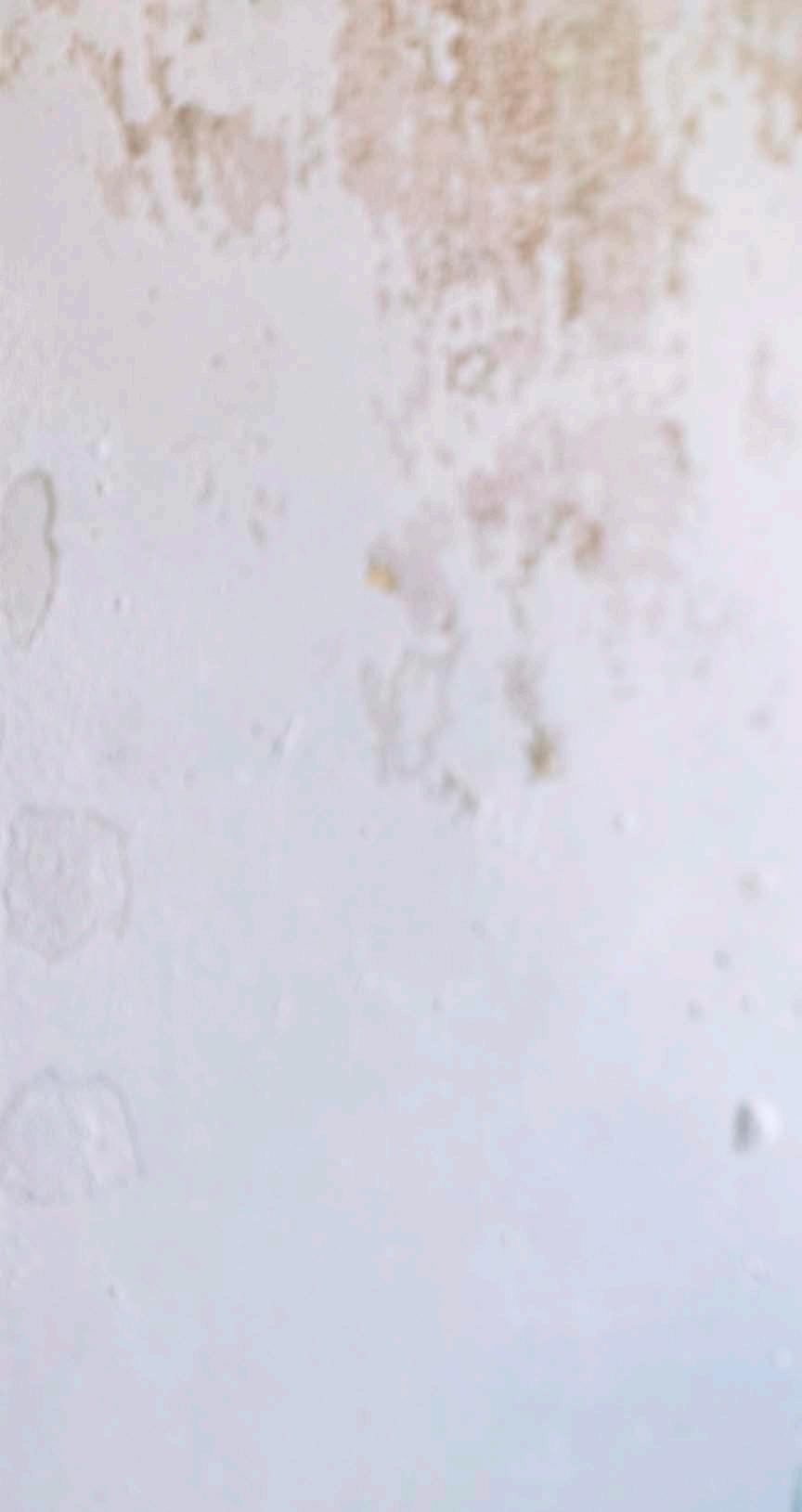
The shadow puppetry admittedly is novel, but Grandpa Bill might be the telling bit. After all, Bragg has now written several children’s songs, initially for the granddaughters but then the rest of us.
One was a singalong version of Bear Hunt (based on Michael Rosen’s 1989 book, We’re Going On A Bear Hunt), which was followed by the whole of Judith Kerr’s The Tiger Who Came To Tea.
“I really enjoyed doing them, it was a completely different headspace. And it was a good way of kicking off the songwriting, because I’m not writing songs all the time the way I used to. I do other things in between: I write books, I’m shitposting on social media and stuff like that, lots of other creative things to do.”
The only thing that put the brakes on his burgeoning king of the kids career – and he reminds me that one of his heroes, Woody Guthrie, was not averse to writing children’s songs either – was the fact his “grown-up” record was coming along swimmingly, if a little slower.
“The last probably 20 years, [songwriting] is something I’ve had to tune into when I’m making an album: to make it an intuitive thing, get into that headspace. What generally happens is going to the studio with half a dozen songs and write another half dozen while I’m there or finish another half dozen I’ve woodshedded. That’s basically my songwriting process.”
As for the shitposting? Well, it’s hardly shitposting, unless you’re a transphobe.
“I think the arc of history is long, but it bends towards inclusivity, doesn’t it?
So many of the movements that we see out there are about inclusiveness now.
I’m expressing my support for the trans and non-binary community, and I’m really amazed by the number of antitrans activists I run into there who are dissing inclusivity, who see inclusivity as a negative, as a problem, whereas in the World Cup they’re trying to wear armbands
to promote inclusivity and make everybody feel part of the whole thing.”
As well as a rabid anti-trans campaign worldwide and Space Karen taking over Twitter, there has been a bit on since Bragg first devised this triple night show. For a start, Britain’s had about seven or eight prime ministers which is, well, a bit excessive.
Yes, I’m well aware of the brazenness of an Australian who lived through Rudd/ Gillard/Rudd/Abbott/Turnbull/Morrison making such a comment. But really, how’s a dedicated musical socialist meant to keep up with topical diatribes about another soul-sucking Conservative PM when they park it and cark it before a writer can get his bearings?
“We’re flying through them, yep, flying. The whole thing is crazy,” Bragg chuckles in a socialist accent. “Trying to keep on top of that is really strange. Sometimes you just have to step back from it. The times when you could just write an incisive song, things need to move a bit slower to do that. It’s just not possible to keep up on that kind of change.”
Was Liz Truss in the long enough for him to write a song about her?
“She wasn’t in long enough for me to sneak her into Great Leap Forward, that’s where I usually put them. Anything topical I usually stick it in there, but before I’d even got my bearings on her, ffft, there she’s gone. There goes another one! So, no, sadly, she wasn’t.
“But she lives on now as a kind of zombie prime minster. She was at the Cenotaph on Remembrance Sunday with all the former Prime Ministers, and [I thought] my God, she is going to be there for the next 20 years, turning up to remind us what a terrible, terrible prime minister she was. At least Boris kind of bluffs it out, still thinks he’s Winston fucking Churchill but Liz Truss looks like a pot plant.”
What a cultural tragedy that the pot plant didn’t make it into Great Leap Forward.
“I’m glad because what she did was she kind of broke the idea of neoliberalism, her kind of cosplay Thatcherism is in the dumper now. They know now they can’t do that: not only did the public not want it but the market don’t want it. And as Thatcher famously said, you can’t buck the markets.
Billy Bragg quoting Margaret Thatcher … what a time to be alive.
Full dates and tickets from handsometours.com/tours/billy-bragg
30
Billy Bragg will be touring at last, unless we’ve jinxed him. Bernard Zuel has spoken to the Bard From Barking twice before in the past two years.

“In August of 1973, my wife and I were listening to the radio and all of a sudden came on this very amazing, bizarre, weird, fabulous music. When it was over, the announcer said it was ‘Black Angels’ by George Crumb.”
David Harrington, founding member and first violinist of the Kronos Quartet is on Zoom from his home in San Francisco and is recalling the genesis of the ensemble. Harrington was born in Portland, Oregon and studied music at the University of Washington in Seattle.
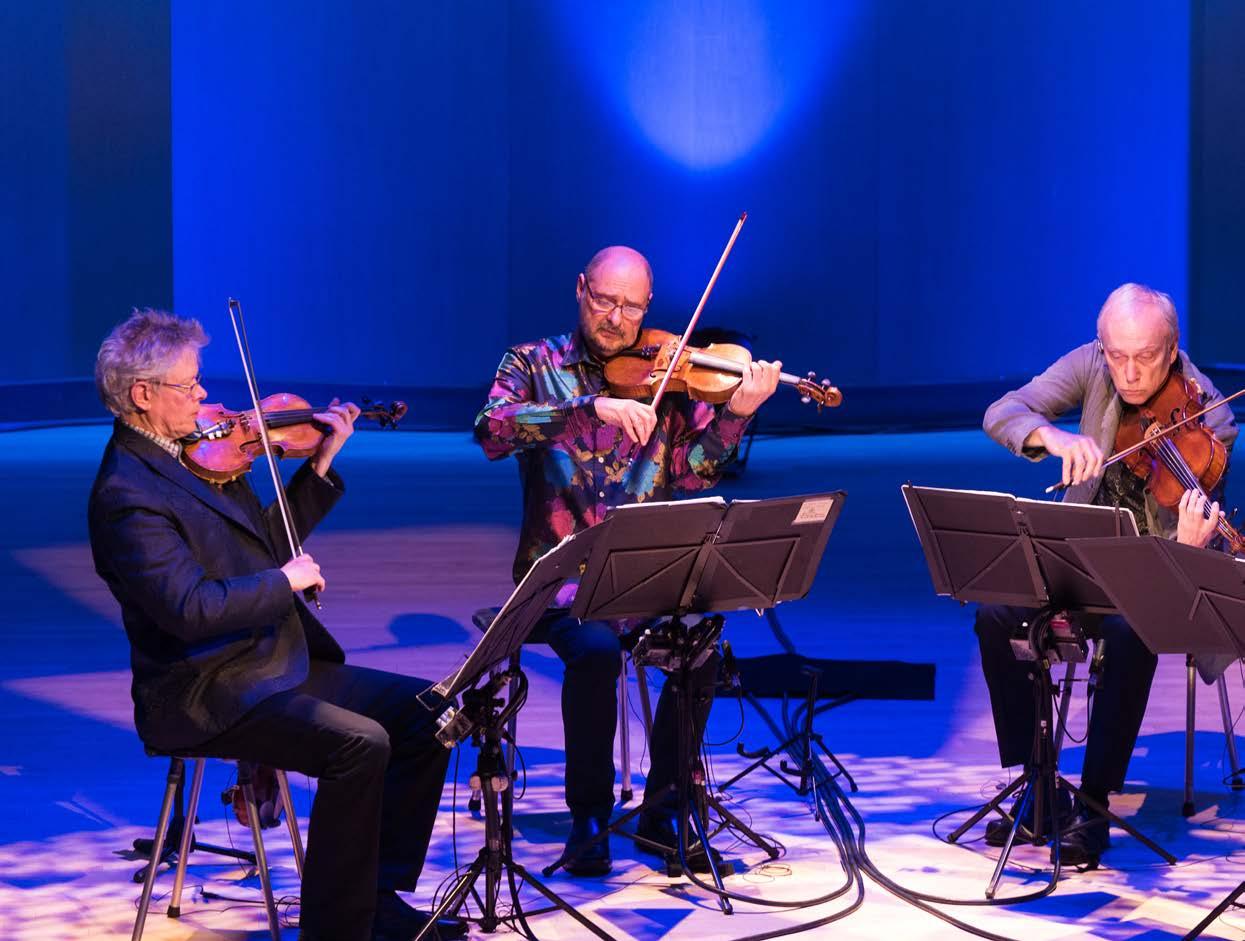
“I, for one, had never heard of George Crumb,” he continues. “I’d never heard any music like that. In one experience, he was able to bring in Jimi Hendrix’s experimental sounds, Schubert, Renaissance music, Bode Crystal Glasses, and it was an amplified quartet, which I’d never heard before, a string Quartet. Plus, it felt like a response to the American War in Vietnam.
“So, basically, I heard my song in August of 1973. A week later I got a score to the piece and realised I was going have to get a group together that rehearsed every day in order to play this music. So, on September 1st, 1973, we had our first rehearsal.”
While hearing that George Crumb piece inspired Harrington to form the quartet, it took them more than a decade to finally record ‘Black Angels’. “There was a lot of things that we needed to learn in order to record that piece properly,” laughs Harrington, “you know, about how to use the studio as a musical instrument. Just a lot, a lot of things. Also, I always wanted ‘Black Angels’ to be the first piece on the album that we would make and it took me about 13 years to figure out what should be the second piece! So, you know, I’m in this for life and waiting 13 years to find the second piece that would follow ‘Black Angels’, that’s not too long. Our work takes a long time. It took eight years to make Pieces of Africa and a lot of the things we’ve done start years before they eventually appear.”
‘Kronos’ is certainly an apt word to tag the quartet. Now celebrating its fiftieth anniversary, the ensemble – with a slowly shifting array of other members around Harrington – has recorded more than sixty studio albums covering an incredible variety of music – from Thelonious Monk, John Adams, Harry Partch, Terry Riley and Steve Reich to Laurie Anderson, Astor Piazzolla, Henryck Gorecki, Bartók, Shostakovich, Prokofiev, Copland and, of course, George Crumb (just to name a few. They have also collaborated with Tom Waits in recording and live performance and have performed with Paul McCartney, Allen Ginsberg, Rokia Traoré, David Bowie, Rhiannon Giddens, Caetano Veloso, amongst others. Kronos has also commissioned more than 1,000 works. It has also received more than 40 awards, When Harrington is asked to describe his music he says, “Some guy came up to us the other night and said, ‘Wow, I really like that classical music’. Okay, if that’s what it is for you, that’s fine with me. I don’t know what to call it and so I don’t call it anything.” “Kronos began in Seattle. That’s just, that’s where I’m from,” responds Harrington when I suggest that the Quartet would have been quite daring at the time of its inception. “So, the first several years, we were there, then we moved to upstate New York and for two years and then San Francisco in 1977.
“During the American war in Vietnam, Seattle was a centre of resistance. I’m certain that that energy fueled me. Also, don’t forget, Jimi Hendrix is from Seattle.”
The KRONOS Five Decades Tour in 2023 will be the eighth Australian tour for the acclaimed quartet and Kronos will perform a carefully curated selection of its work, spanning brand new works and signature pieces from composers around the world. The 50th anniversary tour marks the debut of Kronos Quartet’s recently appointed cellist Paul
TIME WAITS FOR NO-ONE
The remarkable Kronos Quartet is celebrating its 5oth anniversary as it embarks on its eighth Australian tour, culminating with WOMadelaide.
By Brian Wise
32
Wiancko, who joins violinist Harrington and longtime members John Sherba (violin) and Hank Dutt (viola).

Kronos’ most recent recording is Mỹ Lai (2022), an opera by Jonathan Berger and Harriet Scott Chessman. Kronos’ work has also featured prominently in many films, including the ‘live documentary’ A Thousand Thoughts, written and directed by Sam Green and Joe Bini, which premiered at the Sundance Film Festival in 2018.
Mỹ Lai was written specifically for the Quartet and is a challenging work dealing with one of the central issues of the Vietnam War. On March 16, 1968, the United States Army killed over 500 unarmed civilians in the hamlet of Mỹ Lai, Vietnam. Helicopter pilot Hugh Thompson, against orders, intervened to save Vietnamese lives and his story is the basis of the opera which also features Vietnamese multi-instrumentalist VânÁnh, Vanessa Võ, and vocalist Rinde Eckert.
“I remember when Jonathan Berger, the composer of the My Lai opera met with me and introduced me to the story of Hugh Thompson: how this young pilot and his crew basically challenged the entire American military. They could see from their vantage point that innocent people were being massacred. The American forces were indiscriminately killing innocent people and that’s something you could see being in a helicopter.
“One of the gunners from that helicopter came to the world premiere. It was the first opera he had ever been to in his life. I had a conversation with him after the performance and he said that he was about 19 years old and he could see the carnage, the injustice, the terror that was wrought. He said that if he would’ve been a soldier on the ground he might have had a totally different response. I just appreciated the modesty and the honesty of what he said.
“This experience of performing and recording and being involved in this My Lai [project] has been a really central experience for all of us in Kronos. For me, it brings back those first days of Kronos. It kind of creates this large circle and we’re onto other circles as well. The fact that, Vân-Ánh Võ, our collaborator, who is such a master of Vietnamese music and Vietnamese instruments, joined us is wonderful; and, I think, central to the whole idea of this opera.”
Harrington says that he is also excited about the new project the Quartet have been working on and that they had just come out of the studio a few days prior to our conversation.

“I was watching a TV show and the lawyer, speech writer, writer and friend of Martin Luther King Jr was describing how the ‘I Have a Dream’ speech came about,” he explains, “and it was so inspiring to me. I thought, ‘There has to be a piece of music that brings this story into the concert hall’. Well, it turns out Clarence Jones lives in Palo Alto. He’s going to be 92 in January. A few years ago, we, encouraged him to go into a recording studio and tell the story. Then he also read from Martin Luther King’s letter from the Birmingham gaol, and we came to find out that Clarence Jones, his lawyer, is the one that got the letter out of jail by putting it in his pocket and secretly getting it out, which was a very dangerous thing to do.”
“Anyway, I’ll tell you very quickly,” says Harrington before outlining the story that they have recorded of King writing his famous speech. “Martin Luther King starts the speech. The first several paragraphs are pretty much what Clarence wrote the night before. Then he moves into other topics. Mahalia Jackson was his close friend. When he was depressed, he’d call up Mahalia and she’d sing for him on the telephone. That was, that was the nature of their friendship and relationship. She had just sung, she was still on the stage and she’s not quite hearing what she needs to hear from her friend, Martin Luther King. She calls out to him, ‘Martin, tell him about your dream. Tell him about your dream Martin’. And that’s when he closed the book, and he looks out and the speech became the speech. And for me, as a musician, we train ourselves to use our ears and Mahalia Jackson was using her ears as a musician, as a friend. That changed our history. Anyway, that piece is going be on our next record. We just recorded it last week.”
So, after so many albums and such an exciting new project how are they going to select the repertoire for the forthcoming tour?
“Every concert is different, right?” says Harrington. “Every concert. I like it that way. There’s lots of music to play. We like to mix it up, experiment with our work. Let’s say, ‘Black Angels’ next to ‘Different Trains’ or next to any number of things that we might be playing.”
The Kronos Quartet are appearing at WOMadelaide and also in Albany, Perth and Hobart in March. My Lai is available through Nonesuch Records.
33
“Some guy came up to us the other night and said, ‘Wow, I really like that classical music’. Okay, if that’s what it is for you, that’s fine with me. I don’t know what to call it and so I don’t call it anything.”
Photo courtesy of the Musical Instrument Museum.
Kronos Quartet. L to R: Paul Wiancko (cello), David Harrington (violin), John Sherba (violin), Hank Dutt (viola).
Charlie Reid from The Proclaimers talks touring, Kanye West, the decline of Britain, and their most political album yet
 By Bridget Macarthur
By Bridget Macarthur
“I’m in Edinburgh so it’s pretty cold here. There’s snow forecast in the next two hours. A bit of a contrast to where you are I suspect.”
I look out the window. It’s 7⁰ and raining in Melbourne, as it has been almost every day for a week. Not such a contrast after all.
I’m speaking with Charlie Reid – one half of the beloved pop duo, The Proclaimers – and thinking about how similar Australia, in fact, is to Scotland. Putting aside the nearconstant rain we’re having across many parts of the country at the moment, we’re both constitutional monarchies forever toying with the idea of a republic; we both claim AC/DC as our own; we both have a city called Perth… And we both adore The Proclaimers.
“I would say it’s our most successful country,” Reid tells me. “It’s all good memories for us there. On our first trip over, I think we played the biggest halls we’d ever played up to that point. We also played the Rugby World Cup [at the closing party in Perth] the year that England won and defeated Australia in the final… It’s always a great country to tour… and we’re doing several different types of shows this time, from theatres to WOMADelaide.”
This February will see them back for umpteenth time (they’ve been here so often I literally couldn’t track down the exact number) since first touring the country in 1989 – the year ‘I’m Gonna Be (500 Miles)’ hit #1 in Australia for five weeks running.
Reid is particularly thrilled to be back on the road after a longer than usual layoff for the seemingly constantly touring band thanks to COVID-19. He’s just finished up a 35-date tour of the UK and Ireland with bandmate and twin brother Craig Reid, and their four-piece backing band, kicking off a 14-month world tour.
“We’re getting older. I mean, we turn 60 In March, so I’m really glad we got back to it this year. I wouldn’t want to go on any longer without doing a live show. The relief getting back to it this summer was very palpable among the team.”
Of course, some things have changed over the years when it comes to touring. “I don’t want to be in the back of a transit van anymore. We get hotel every night, now – that’s a new thing for us.”
But despite being a few years older, they’re far from getting sick of pulling out the classics on stage. In fact, they’re a band known for their lack of ego on stage, and willingness to embrace the tracks that made them world famous – ‘I’m Gonna Be (500 Miles’), ‘Sunshine on Leith’, ‘Letter from America’, and ‘I’m On My Way’ (aka ‘that song from Shrek’)
“They keep us on the road! Particularly ‘500 Mile’s. We’ve been very lucky, so it would be very foolish of us – and arrogant, I think – to dismiss that. You want to please people. You want to get out there and entertain. So, to play that song and get the crowd reaction makes us happy too.”
In addition to the hits, plus other favourites from their more than 30-year career, they’ll be giving several new songs off their latest album, Dentures Out, their Australian debut.
Reid calls the album, recorded at the legendary Rockfield Studios in Wales with producer Dave Eringa and released in September, “the most overtly political record we’ve done in 20 years, easily, maybe more.” And it’s true – their twelfth album goes in hard. While their (extensive) website bio might say that “their songs feature at weddings, funerals and everything in-between”, Dentures Out feels more like it belongs as the soundtrack to an end-of-days, nihilistic jig – the world’s funeral, perhaps.
But for any die-hard fans out there looking for a wedding song with a bit of an edge, Reid would have to recommend the title track –‘Dentures Out’ – one of two tracks on the album to feature the inimitable James Dean Bradfield of Manic Street Preachers on guitar). “And ‘Sundays by John Calvin’ for a funeral,” he adds. “A humorous look at my childhood, rather than my death.”
It also happens to be one of his favourite tracks to play live, along with ‘Feast Your Eyes’. “They’re both lockdown songs without mentioning lockdown, if you know what I mean. We just make somewhat oblique reference to it.”

Not a band to shy away from the fact of their own aging, the album’s title is, to some degree, self-mocking, as they both approach their seventh decade of life in lockstep. But it’s a lot more about the political and cultural decline of Britain, and the West more broadly.
“It’s strange that the record came out within a couple of days of the Queen dying, you know, and you just felt that an age has passed…
Not that I mourn it particularly, but it was interesting… Whatever one’s feelings towards the monarchy, the queen had a degree of respect, even among republicans like me, for her toughness and stoicism. I don’t think her son is going to have anything like that, despite having the longest apprenticeship in British history… I’d abolish [the monarchy] tomorrow to be honest… and I’ll be surprised if there aren’t several more Commonwealth nations moving towards becoming republics in the next five or 10 years.”
But such change requires voices of dissent, like Reid’s, and he worries that many bands are taking the opposite route to The Proclaimers, returning to what he calls a “pre-Beatles” England where there was a “strong element of manufacture”, compared with the originality of the 70s and 80s. “There’s still great, original talent now, obviously – like the Arctic Monkeys – but I don’t know where the politics went, and that’s a bit depressing... I think the talent show thing probably changed everything in that the Simon Cowell type people got a lot more power, and record companies had stuff thrown in their laps that they knew would sell, so they just went with that.
“But honestly, with all the stuff that’s going on, it seems very, very strange to me not to comment… I don’t think everybody should be political all the time, but it’s hard to fathom how you can live in the world as it is in the 21st century, and not be aware of the changes and the dangers that are there – be it to the planet, or in the case of war, or famine – and for that not to come out in your work somehow. Like, in the last few weeks, looking at Kanye West, spouting antisemitism and fascism on the basis of free speech. He’s gone off to Planet Zog, with his pal Donald Trump. I always find Americans bizarre to some degree, but Kanye West is really taking the biscuit. He’s something else, as the Americans would say… It’s a kind of strange world we’re living in, if you know what I mean… So much of it is depressing. But you can’t run away. You’ve got to face it… And that comes through in what we do.”
34
He pauses, adding: “Perhaps older bands, like us, are less concerned about selling records, because they know they’re not going to sell many, so they can just do and say what they think – if they still have an audience.”
While there is certainly a young community of musicians out there singing about climate change and social upheaval, especially on the post-punk scene, it’s true that many bands of a similar age to The Proclaimers (in Scotland in particular), no matter the genre, seem to have moved into a twilight of unbarred, streamof-consciousness-style social commentary.
Brand new works are being released that are consistently being called these multi-decadeold bands’ most political yet – from Del Amitri’s 2021 album Fatal Mistakes, to Arab Strap’s track ‘Fable of the Urban Fox’.
“I also think it’s in the water here [in Scotland]. It’s in the drinking water. It’s a cultural thing. And it’s stronger here than it is in England and
much much stronger than the United States of America… Maybe that’s what happens when you’re in bed with an elephant, as someone once said – it’s that proximity to a much larger power.”
And, according to Reid, it’s at the beating heart of what The Proclaimers is as a band – claiming their genre not as pop, folk, punk, new-wave, or any specific combination of those things, but “humorous social commentary”.
“On this album in particular, it just kind of poured out. Lyrically, most of it comes from Craig. But we both write the same way in that we just don’t think about it – that’s the point. You can be at least a verse and a chorus in before you know what the hell the song is about.”
Of course, such poignant socio-political sentiment can be a heavy burden to carry when you’re performing night after night, trying to do every song justice, to embody the meaning of every lyric. “We’ve given ourselves a few more years… but there will come a point that, if we feel that we’re not, giving the performance we want to give, we’ll quit doing live shows – because I think Craig and I both have high standards for ourselves in terms of being able to perform. I think as long as you’re fit enough, you should probably carry on. And as long as there’s an audience that wants to see you... But the minute you don’t feel that you’re projecting the songs properly, then I think it’s time.”
Lucky for us, he reckons The Proclaimers have got at least one more Aussie tour in them, on top of 2023.

“It is addictive – one because you’re expressing your own feelings, and two because people like to come and see you. So, you feel like you’re doing it for two reasons – yourself, and the audience... And it’s just one of those things where the thought of [2023] potentially being the last time we would come would be so upsetting. I hope there’s a couple more to go.” And with so much political turmoil of our own here, and Australia’s broader similarities to Scotland, maybe we can even expect a track or two popping up on an album down the line dedicated to their cousins down south.
“Maybe! If you’ve got any sense, you tend to try to keep your mind as open as possible. Travelling to places or new people that you meet; I think you’ve got to be open to it and soaking everything up as much as you can… It’s definitely an interesting time to look at the world, the geopolitics of the world, and how fast things are changing. Whether we like it or not, the West is in decline proportionately to the rest, so it’s gonna be an interesting few years
The Proclaimers will be at Womadelaide and tickets for other dates in Australia are also on sale now.

35
“It’s gonna be an interesting few years.”
Alittle over a year ago I spoke to Mary Coughlan about her forthcoming visit to the Port Fairy Folk Festival in 2022 only to find that we weren’t quite ready for international acts. Like so many other musicians, plans had to be put on hold but at least now we are able to talk with some certainty that Coughlan, one of Ireland’s most acclaimed contemporary voices, will be here in March for the festival and other dates.
In the intervening year, Coughlan has also been able to organise one of the most exciting recording projects of a career that has seen more than a dozen studio albums since 1985, including an homage to Billie Holiday and the most recent and largely autobiographical album Life Stories
“This has been probably the busiest year I have had for years and years,” says Coughlan of 2022, noting that an especially warm summer allowed her to perform concerts in her garden, broadcast online and also perform benefits for local women’s refuge and addiction services. [Coughlan was also presented with a Lifetime Achievement Award by the then Mayor of Galway].
“People were in need, dire straits for funds,” says Coughlan. “Then the war came, and we started doing some gigs to raise money for Ukraine. “Then when we opened up it just went insane. It just went completely insane. Now I’m coming back to Australia.”
A lot has been made of Coughlan’s battle with her demons; in fact, the publicity even mentions her ‘hitting rock bottom.’ But that was more than quarter of a century ago and I wonder if she ever gets tired of talking about it; after all, the most recent album and the stage play Woman Undone were surely revealing enough.
“I do,” says Coughlan emphatically. “In Ireland, I just don’t talk. I don’t even hardly do press anymore because all they ever want to talk about was my past, or my ex-husband’s relationship which just comes up all the time. And I just say no. And even if I don’t do the interviews, they write about them anyway. So, it’s just that people are insatiable for it. It’s so stupid. I wrote the play, wrote the music. We performed it everywhere and put it to bed, and then I moved on.”
“There’s such a lot of other stuff going on in my life and the world,” she continues. “I’m doing a really interesting project now. I’ve been working on it for almost two years. I presented it at the Galway International Arts Festival as a work in progress. It’s going to be incredible. That’s all I have to say. I’m 66. It’s going to be like, what do you call it, your [magnum] opus.”
Coughlan’s next project involves recording an album of songs written and produced by Jerry Leiber and Mike Stoller that Peggy Lee first released on her album Mirrors back in 1975. The album contains the classic ‘Is That All There Is?’, a hit for Lee and a Grammy Award winner back in 1969. A planned album of ‘neo cabaret art songs’ took another six years to reach fruition. Coughlan was given the album years ago by Scottish singersongwriter Dougie MacLean while she was touring New Zealand.
Yes, this is an album by the same legendary writing team that penned a slew of hits for Elvis such as ‘Hound Dog’, ‘Jailhouse Rock’, ‘Treat Me Nice’ and ‘King Creole’ (to name just a few) plus dozens of hit songs for other artists including ‘Stand By Me’, ‘Poison Ivy’ and ‘Love Potion No.9’.
“They wrote this very dark album about the rise of fascism in New York, in America in 1939, and they were all about the annihilation
of old people,” explains Coughlan. “They were writing with Truman Capote and Tennessee Williams. They were hoping to do a show of little vignettes of songs, stories.”
“They were really good friends of Astor Piazzolla, the tango player from Argentina, composer. So, they wrote the suite of eleven songs that were very, very dark: from sending people to trains in Nazi camps for annihilation, old people, the rise of fascism. They wrote a very, very dark song about the pretend face of how everything is beautiful in America, and apple pie, and honeysuckle, and porch swings. There was this really, really dark underbelly.”
While Coughlan might sing one or two songs from the project on her forthcoming tour, she is more likely to highlight material from 2020’s Life Stories with her band consisting of pianist Matt McMahon, bassist Brett Hirst and James Nash on guitar.
“It has,” agrees Coughlan when I mention that Life Stories has a variety of musical moods, which will translate really well to the live performance, including the beautiful ‘Family Life’ written by Paul Buchanan for the Blue Nile album Peace At Last in 1996.
“I suppose the sad songs are the ones that I’m responsible for. ‘Family Life’, Buchanan wrote that song years ago, and the night my mother was buried 15 years ago, I drove back from her funeral, because I’d been in Galway for about six weeks. My daughter was in the back of the car, and that song came on the radio. I just had to pull over the car and take a minute. So, she bought me the album for Christmas. Mammy was buried the first of November and Claire bought me the album. It’s such an amazing song.”
Mary Coughlan will be appearing at the Port Fairy Folk Festival.

36
THIS BUD'S FOR YOU
By Steve Bell

Yet since recently being given the opportunity to put these songs which had accumulated in his head down on tape in the studio, the 35-year-old singer-songwriter has been getting great traction with his authentic country music aesthetic and songs whose heartfelt lyrics drip with hardwon life experience.

In a short period of time he’s already earned comparisons to lauded country forebears like Johnny Cash and Townes Van Zandt, as well as treading the boards at festivals such as Gympie Muster, Dashville, Queenscliff and Groundwater. These songs were obviously coming to Rokesky for a reason, it just took him a while to realise it.
“I don’t know if I’d call it a passion, it’s more of a compulsion,” he reflects on his songwriting. “Many, many times I’d think, ‘This is just getting in the way, I need to be focussing on family life, home life - even extended family life and all that stuff - and here I am and I can’t get this bloody music out of my head!’
“I never really got to play any shows before COVID at all, I was really just a songwriter. It’s only been pretty-much post-COVID that I’ve been playing shows. I just loved the songwriting - it gets the emotions out of you and you get to deal with stuff.
“Like I said it’s a compulsion - you get this whole story just delivered into your brain in a split second out of nowhere, and it just sits in there making a ruckus until you do something about it. You’ve got to get it out. You’ve got to get it out and once you do you feel amazing from it, and then you show a couple of mates and if they love it then it’s the best feeling in the world, and then I’m done”.
Fortunately one of those who’d heard and liked this growing stash of songs was Alex Henriksson, a close friend since the pair had met during Rokesky’s childhood spent on
a 170-acre property just outside the small Queensland town of Imbil.
Once Henriksson started a new label Rainbow Valley Records with business partner Matt Corby he quickly signed up his talented mate, ushering into existence Rokesky’s excellent debut album Outsider “None of it was recorded - it was all just sitting in my head in a constant loop - so getting it out has been definitely a massive relief in a way, just clearing that headspace,” the singer admits. “As soon as we finished recording the album I think I wrote about six songs in a week, because there was a bit more space for these new ones to come through instead of me just hanging on to the old ones.
“I guess in terms of the country sound it’s just that my lifestyle lends itself to thatit’s most relatable to where my priorities are at this time in my life. They always have been - I always wanted to have a family when I was pretty young, I always wanted to be a young dad, which is a bit weird to some - but that was my priorities and how I wanted to live my life, and that’s what I ended up doing. That’s why I never really chased music when I was younger, because it wasn’t really a priority.
“And growing up in the small rural town country music was everywhere, for sure. The kids on the bus would make mixtapes and try to get the driver to play them, and while it might sometimes be Blink-182 or something random I was definitely exposed to a lot of country music that way, and the blokes in town just lived and breathed it. It wasn’t necessarily even the music but just the way they lived - it was sometimes like I was growing up around country songs without even hearing them.”
And while Outsider contains some beautiful paeans to family life, there’s also an undercurrent of living on life’s peripheries that traces back to his time spent growing up out bush.

“There’s a lot of things relating to the ‘outsider theme’ but they do go back to those times,“ Rokesky tells. “We lived about a sixminute drive from town - although there wasn’t always a car so it was a 45-minute walk - and the town itself only had about 300 people in it anyway, so I guess there was a close-knit thing going on in town and even though it wasn’t very big you were still really removed from that, even though we weren’t that far out geographically.
“Then there was the isolation of the property itself and all of that, and my parents weren’t really rural types - they’d moved out there from the city - so I definitely felt like an outsider in a lot of ways back then”.
37
Songs have always come thick and fast to Brisbane-based truck-driver Bud Rokesky, but for many years they remained untouched in his head as he focussed on his growing family and the many attendant responsibilities he faced as a husband and a father.
SIC U M NE SW
James’ music is a unique and at times ominous amalgam of different styles - an intriguing gumbo of blues, jazz, folk, soul and country - with the singer, despite his relatively young age, conjuring up noir imagery and spectres of the American South in a voice as weathered as time itself.

“My favourite musicians are all people who are constantly changing, like Miles Davis or Ween or The Beatles I guess are an easy example,” he reflects on his inimitable style. “Daniel Romano is a great example too - you think you have him figured out and then he throws you a curveball.
“You don’t always have to like every record - there are a lot of Ween records where I’m like, ‘I’m glad y’all did this boys, but I’m not sure y’all had to’ - but I love all kinds of music, and I can’t help but be influenced by it so it comes out in one way or another I reckon.
“But I don’t feel risky, it’s just a gut feeling towards what sounds good or what doesn’t. And I guess when you’re working with a band like the one at Easy Eye [Sound studios in Nashville] that Dan hired, they have such a broad paint palette that it doesn’t feel like taking a risk when you’re around those folks because they’re so confident. ‘So you want to take it there? Yeah, we can take it there if y’all want to’.”
James admits that it’s been surreal working with Auerbach on his first two albums given that in his youth he was a huge fan of The Black Keys.
“I was big into him in high school so it was a bit strange to meet him, so’s the fact that I can text him a photo of a steak I cooked - because he’s an avid cook,” he smiles. “We rarely talk shop or anything about guitars, it’s mostly just pictures of food we cooked. He’s like my own personal Instagram.
“He was someone whose songs I was learning when I first picked up guitar, and I remember the first time hearing words I wrote come out of his mouth - he said, ‘What if you do it like this?” and took his guitar and played something I’d come up with - I was like, ‘That’s fucked! That’s weird!’ It feels like it wasn’t supposed to happen, then you pinch yourself and try to wake up. It’s been a blast working with him.”
On every release that Auerbach oversees at Easy Eye Sound he prefers working with his same trusted Nashville session players, sometimes to the chagrin of the sidemen of the artists involved.

“I think that really creates contention sometimes because if a band works it ass off, to not be included on a record does hurt some feelings,” James tells. “I understand why Dan does it - it’s a very curated sound - but this time Dan let me use Adrian Marmolejo [upright bass] who I’ve played with for the past six or seven years, so it felt like I had a little bit of my band, and it was nice to have that.
“But when you build that rapport for over a decade - he always uses the same guys - so they can read each other’s minds. There’s very rarely more than three takes on a song just because they’re that good. We recorded almost 20 songs in three days, so I think it greatly helpsit might hurt a few folks’ feelings but it’s certainly an expedient way to put out records.”
It seems incredible given the assured sound of the Strange Time To Be Alive that it was all put down so quickly.
“It was almost traumatic when it was over - both times - because you just get so sad, and go, ‘Fuck, I should have put that song on there’ or ‘Why did I sing that that way?’,” James laughs. “I’ve heard about bands breaking up making records because it’s such a long-winded process and nobody can agree on what should or should not go on the record.
“It almost seems like a magic trick the way it’s worked with Dan, just because you’re in and you’re out - ‘Oh wow, that was 18 songs!’ I’m curious as to when I finally get the chance to take say a month to make a record, if it will sound better - it will probably just sound different.
“That’s just Dan’s way of doing it, and I think he got that idea from a lot of places but specifically FAME Studios at Muscle Shoals did thatthey did everything live and they did everything quick - and that music all turned out pretty good”.
will be touring with Ian Noe. Check the Rhythms Gig Guide for dates.
38
Early James
Alabama-bred singer-songwriter Early James dropped his debut album Singing For My Supper to great acclaim in early-2020 - just in time for touring plans around the record to be pretty much scuppered by the pandemic - so instead he teamed up again with that album’s producer Dan Auerbach (of The Black Keys fame) and started work on what would become the follow-up, the presciently-titled Strange Time To Be Alive. BySteveBell



ALBUMLAUNCH SATURDAYMARCH4 Workers(MatineeShow)Club,FitzroySpecialGuest: TrueSound
NOE WAY!
Kentucky-bred singersongwriter Ian Noe’s spectacular second album River Fools & Mountain Saints may have been conceived and recorded during the recent pandemic, but he didn’t need to tap into those tumultuous times to inform his most recent collection of authentic country-folk ruminations and Appalachian balladry.
 By Steve Bell
By Steve Bell
Back in early-2020 a series of devastating floods ravaged areas of south-eastern Kentucky - including Noe’s hometown of Beattyville - and it was this turn of events that first gave Noe the title of his new collection, and in time the evocative songs which comprised it.
Tales full of intricate rural character studies, dissecting the lives of folks already down on their luck but now pushed to the outer limits of endurance, with some finding strength in adversity but others buckling to the relentless pressure.
“I knew what the album was going to be, really all I needed was just the title,” the singer reflects. “Once you know where you’re going with the feeling of a record it’s not that hard to get your songs. You just have to be able to see what you want to say, and if you have the vision for it then it should be able to fall into place, if you’re not full of shit.
“Essentially, you’re just writing a movie is all you’re doing - if you’re writing to a title like that then all you’re doing is building one big movie and writing all these songs for all the scenes. And the scene that I had was my flooded eastern Kentucky town, and every nook and cranny that I could possibly fit into that vista. It wasn’t aimless by any stretch.”
This novel approach to his craft explains why most of the narratives on River Fools & Mountain Saints seem geographically rooted in the same place.
“Absolutely, I wrote it with that in mind,” Noe admits. “Already having the title River Fools
& Mountain Saints I figured that title was so strong that I’m not going to start singing songs about New York City or Los Angeles - no offence to those places - it’s just that a title like that really speaks a lot to me about what that would say, so I wrote the rest of those songs around that image.”
When it comes to individual songs it’s not the title that Noe finds imperative to the writing process, rather the track’s opening gambit.
“I don’t have a hard time writing a song, what I really try to do is get the first line - that first line of a song is so important,” he explains.
“And that might be the hardest thing that you write, because if you can get that first line and you already know where you’re going with the song then it’s pretty easy for me to get it done after that.
“But you already have to be going somewhere - the song has to already be there, if that makes sense. You already have to be going in a direction. More often than not the thing that I’ll get first is the second chorus or the second verse of a song - a lot of times the first line of a song is the last thing that I finish, but it will be the thing that ties it all together.
“That process of songwriting is my favourite thing to do. My favourite thing to do is sit down and try to figure out a song - or try to pull together a new song - and my second favourite thing to do is go into the studio to lay it down”.
Which on River Fools & Mountain Saints Noe did with complete aplomb, hitting the studio
“The people that I work with made the sessions easy, because when you’re in tune with each other you don’t have to go around in a lot of circles trying to figure out what you want,” he tells. “Usually by the third or fourth take if it’s not happening, we’d skip it and go to something else, but most of those songs were pretty easy to lay down.
“I figure if it’s a good song it shouldn’t be too hard to put down, you shouldn’t have to fight it too hard. And if it’s a good song you should be excited about singing it, and then it comes pretty easy.”
For his impending inaugural Australian shows Noe will be appearing on his lonesome, something that he says doesn’t perturb him in the slightest.
“I love playing solo, that’s how I came up,” he smiles. “I’d only really been playing with a band for a couple of years prior to the pandemic, but even when I’m touring at home with the full band, I’ll usually do a small acoustic set somewhere, like a third of the way through. But yeah, it’s in my blood - I love playing solo. I honestly can’t wait to get down there, it’s going to be incredible.”
Ian Noe is touring in March. River Fools & Mountain Saints is available now through Thirty Tigers.
40
with producer Andrijia Tokic (Alabama Shakes, Margo Price) and a team of established musicians and concocting a perfectly timeless roots sound for this batch of tunes.
SIC U M NE SW

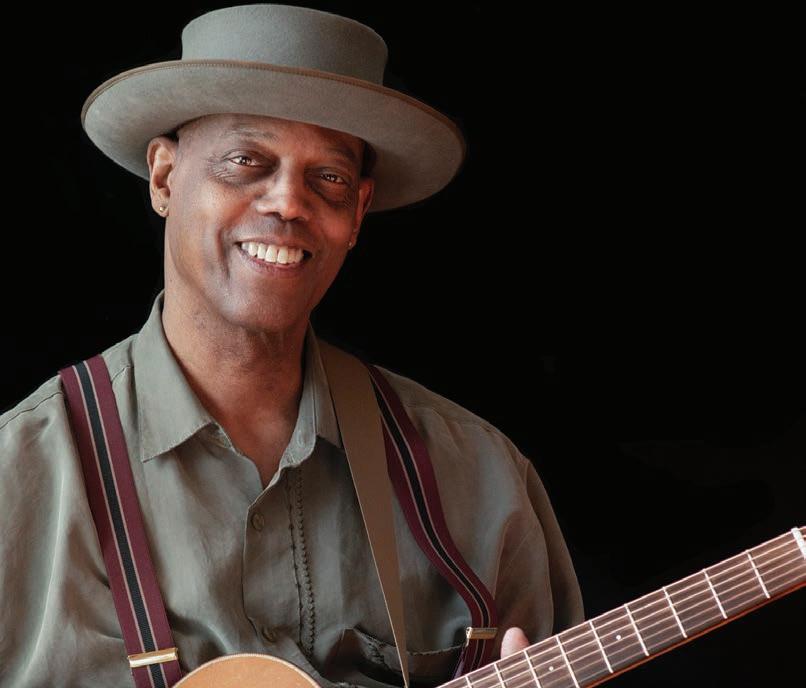

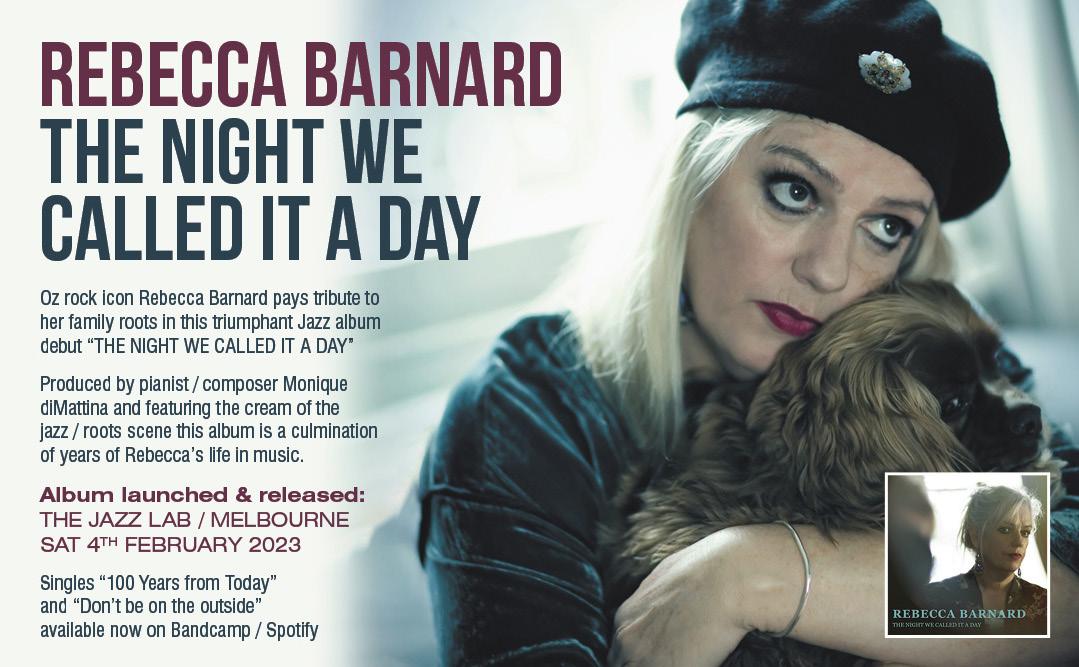
AUSTRALIA 2023 SOLO SHOWS // FEBRUARY FRI 3 NORTHERN REPUB LIC EUROA // SAT 4 STAR HOTEL YACKANDANDAH // SUN 5 CSU RIVERINA PLAYHOUSE WAGGA // THU 9 STREET THEATRE CANBERRA // FRI 10 MILTON THEATRE MILTON // SAT 11 HERITAGE HOTEL BULLI // SUN 12 LIZOTTES NEWCASTLE NSW // THU 16 BUNBURY ENTERTAINMENT CENTRE // FRI 17 ALBANY ENTERTAINMENT CENTRE // SAT 18 REGAL THEATRE PERTH // SUN 19 THE GOV ADELAIDE // TUE 21 MOOLOOLABA MUSIC // WED 22 BYRON BAY THEATRE // THU 23 C2 THEATRE TOWNSVILLE // FRI 24 TANK ARTS CAIRNS // SAT 25 OLD MUSEUM BRISBANE // BAND SHOWS // MARCH THU 2 FACTORY THEATRE SYDNEY // FRI 3 THORNBUR Y THEATRE // SAT 4 MEENIYAN HALL // SUN 5 CARAVAN - ARCHIES CREEK HOTEL // THU 9 MEMO MUSIC HALL ST KILDA // FRI 10 // SOLO // QUEENSCLIFF TOWN HALL // SAT 11 - SUN 12 PORT FAIRY FOLK FESTIVAL // THU 16 SWAN HILL PERFORMING ARTS CENTRE // FRI 17 CAPITAL THEATRE BENDIGO // SAT 18 - SUN 19 BLUE MOUNTAINS MUSIC FESTIVAL // PRESENTED BY ericbibb.com Ridin`
An Arnhem Land musical experiment comes of age
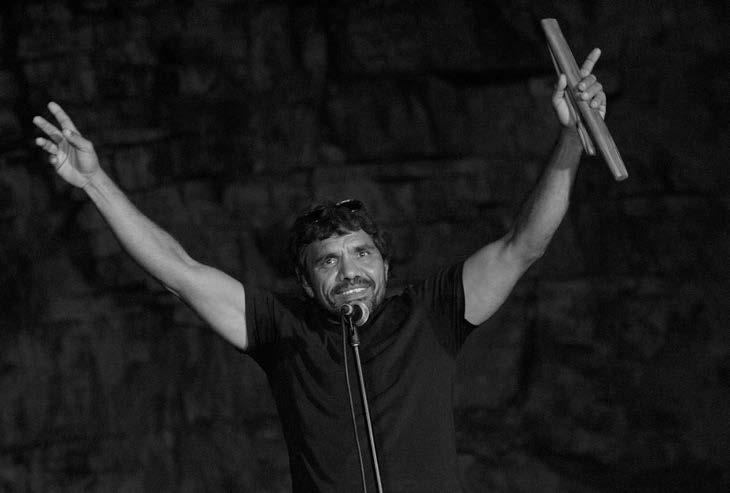 By Seth Jordan
By Seth Jordan
The recent re-release of an unusual 2007 album Songs From Walking With Spirits, showcases a unique project that brought together four traditional Aboriginal songmen with four other very talented Australian musicians, and it’s sparked renewed interest in this remarkable collaboration.

Originally titled Muyngarnbi – Songs From Walking With Spirits, but shortened for the new re-release, the original album was the brainchild of the late musician-actor Balang T.E. Lewis (aka Tom E. Lewis), who passed away in 2018 at age 59.
Best known to film buffs for his 1978 debut in ‘The Chant Of Jimmie Blacksmith’ - the Fred Schepisi-directed movie that was filmed when Lewis was just 18 – and which was nominated for the Palme d’Or award at the Cannes Film Festival, Lewis went on to appear in many other important films, including ‘We Of The Never Never’, ‘Crocodile Dreaming’, ‘The Proposition’, ‘Goldstone’, ‘The Skin Of Others’ and the documentary ‘Yellow Fella’.
A phenomenal actor as well as a gifted musician, he also starred in an acclaimed stage adaption of Shakespeare’s ‘King Lear’ (titled ‘The Shadow King’ and set in an Indigenous community), and recorded two excellent solo albums - 2005’s ‘Sunshine After Rain’ and 2013’s ‘Beneath The Sun’. Originally from Ngukurr (Roper River) in south Arnhem Land, Lewis also co-founded Djilpin Arts, a community-run gallery-museumaccommodation cultural complex in his adapted nearby home of Beswick (Wugularr). And in 2002 he initiated the First Nationsbased festival ‘Walking With Spirits’ at a stunning local site known as Malkgulumbu or Beswick Falls).
Having previously featured a number of local and regional Arnhem Land songmen at the festival, in 2007 Lewis’ trademark infectious enthusiasm made him want to record their traditional singing properly, albeit augmented by a few special guests invited to take part in the recording project. Four songmen – Roy Muyngarnbi Ashley, Micky Hall, Victor Hood and Jimmy Wesan, were joined by legendary Daddy Cool guitarist Ross Hannaford, bassist-producer Michael Hohnen (Skinnyfish Music, Gurrumul), and Lewis himself. Melbourne drummer Tony Floyd’s parts were subsequently added later to the recording.

“This album was completely Tom’s (Balang’s) own project,” confirms Hohnen, who with the deaths of Hannaford in 2016, Lewis in 2018, and the passing of all four of the old songmen, is now the only surviving member of that original recording session.
“He had come back to Beswick after being away for many years, and his passion for this was to bring the old men and the songs back into some sort of relevance,” continues Hohnen. “He and I had already worked together quite a bit, and that was
Balang T.E. Lewis at ‘Walking With Spirits’ festival 2006.
Please Note: Aboriginal and Torres Strait Islander readers are advised that this feature may contain images, voices and videos of deceased persons.
usually a matter of Tom just grabbing whoever he could at the time – so for me it was always a bit random and erratic. He would often choose people that I didn’t think were up to his standard, because I saw him as an incredibly worldly, very talented, and beautifully improvisationally creative person. But for this one he brought Ross Hannaford up to the Territory, because they had previously had a long relationship down in Melbourne, and he wanted him on this project. So that was huge for me to be able to work with both Ross and Tom together.” “But the main thing was his bringing together these old men, who are all gone now,” remembers Hohnen. “I was thrown into the deep end of Tom’s chaos when they asked me to produce it. He had an open jamming shed there outside of Katherine, so we brought in a Brits van and set it up like an outside broadcast van, so that the engineer Jeremy Conlon could look out through the window at us while we were playing in the shed. Julia Morris also had some students that she was training, and they filmed the recording process for a DVD.”
“The impetus for Balang was definitely to bring the songmen to the fore,” agrees Lewis’ wife Fleur Parry, who was central to organising the original recording, and who co-founded both Djilpin Arts and the Walking With Spirits festival with him.


“He had previously played didjeridu in contemporary and jazz formats for many years, and he had seen how big it had become all over the world as an international instrument,” she recalls. “But when he was back in community he used to say ‘No no, everybody’s got it wrong, it’s not about the didge, that’s just a drone, it’s about the song.’
So for Balang all the knowledge was in the songlines and in the songs that were sung, and it became an absolute passion for him to highlight these songmen.”
Lewis had long-established relationships with all of the old singers. “Old Victor he called father,” explains Parry. “Micky was a very close cousin, Roy was a very close elder brother, and Jimmy was a close uncle, so he had strong family relationships with them all. When he said to them ‘Let’s do a recording, but let’s do it without the didjeridu, and use
other instruments instead,’, “they all said ‘Yep’.”

“Through the festival they had already done a few different things, they’d sung with a Steiner quartet, they had sung together with traditional Indian singers from Chennai, all kinds of stuff, so they were quite happy experimenting with how you could get the song carried by something else other than didjeridu,” she says.
Almost my default, Roy Muyngarnbi Ashley’s contribution became a bit of a focal point in the recordings. “In some ways it was just a matter of who was available for certain tracks,” laughs Parry. “But of course Roy could sing in a number of languages, as he was culturally right-across it all and multilingual. >>>
Balang T.E. Lewis, with wife Fleur Parry and their son Alex, 2006.
Onstage performance from Walking With Spirits Festival 2006, including (on right) T.E.Lewis and Ross Hannaford.
Ross Hannaford at Wolseley Winery
>>> One very special song on the album ‘Cloud Over Micky’s Country’ he sings with Micky, since as brother and cousin they had a particular cultural relationship, and were able to sing that one together. There were kind of subtle rules as to who could sing what, and then there were a couple where different songmen were able to sing together.”
The resulting recordings were an eccentric and intriguing combination of the old songmen’s traditional vocals, Hannaford’s energised rock-blues-country guitar work, and Hohnen, Lewis and Floyd’s steady supporting roles.
“The singers absolutely loved it, remembers Parry. ”Victor - who was the oldest of those four songmen - used to go to Balang and say ‘Give me that white man’s didjeridu’. “By which he meant he didn’t care whether they were orchestral members or electric guitars, he really just loved the idea of experimenting with a different sort of drone, as long as the song held its integrity.”
‘They were definitely into it,” agrees Michael Hohnen. “They weren’t used to playing with Ross at all, but he was playful and it was beautiful, and because Ross was in his late 50s at the time and they were just a little older, there was a mutual respect and admiration towards him, and they were looking after him on their country.”
Given Hohnen’s long history of important production projects, including all of the albums he did with Gurrumul, and his two for Balang, it’s surprising to hear his retrospective assessment of Songs From Walking With Spirits “I’m probably most proud of this record beyond just about anything else,” he reflects.
“There are a couple of songs on here that are just killer pieces that would stand up anywhere in the world, and I keep coming back to it. It’s like a hidden secret.”
When the album was first released in 2007 it only had limited distribution, which is one motivation for Parry wanting to re-release it now. “At the time there was a lot going on, and we’d just finish one project and be onto the next one, and in hindsight we could have promoted it better then,” she explains. “So that’s one reason to give it some new re-release energy now, and make it more widely accessible via the digital stream, which wasn’t really available back then. And as you’ve seen, we’ve still even got a stack of the original CD/DVDs available at the Djilpin gallery too.”
“I’m aware that it isn’t necessarily an easy album to listen to, because of all of the really different styles and rhythms,” concludes Parry. “But it’s a very fond memory for me, and watching them all in the shed in
2007, having such an absolute ball doing it, laughing and singing, it was an extraordinary process.”
In retrospect, Songs from Walking With Spirits was one of the very first albums that combined traditional Arnhem Land songmen singing with Western instrumentation.


Like the similarly re-released 1997’s album Crow Fire Music by black-whitefella band Waak Waak Jungi, it created a template for more recent cross-cultural experiments, such as the Australian Art Orchestra’s impressive 2021 album Hand To Earth with songman Daniel Wilfred, and the fabulous new self-titled debut album Ngulmiya from Numbulwar singer Grant Ngulmiya Nundhirribala – both of which feature traditional songmen vocals, along with elements of Western classical, jazz and electronic music.
‘Songs From Walking With Spirits” is now available on most digital platforms.
The songmen and musicians onstage at ‘Walking With Spirits’ festival 2006.
Photo by Peter Eve.
From left - Unidentified didj player with traditional songmen Victor Hood, Roy Ashley & Balang T.E. Lewis, onstage at ‘Walking With Spirits’ festival 2006.
Photo by Peter Eve.
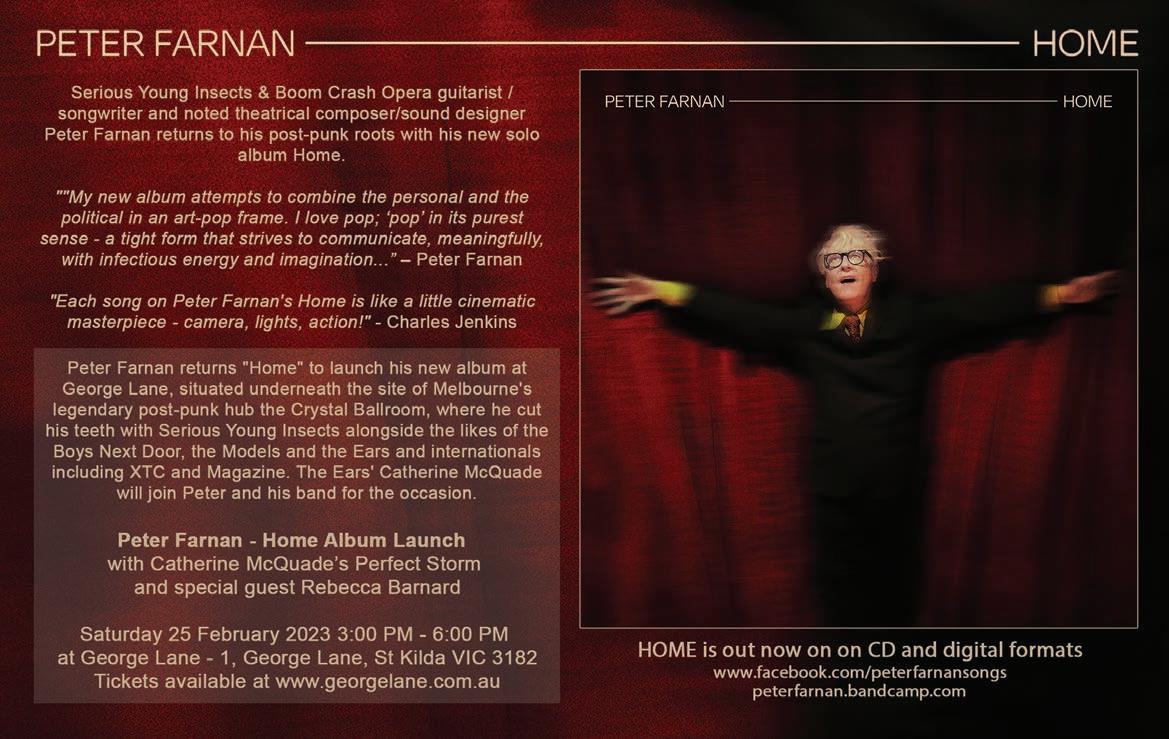

45
BRINGING IT ALL BACK HOME
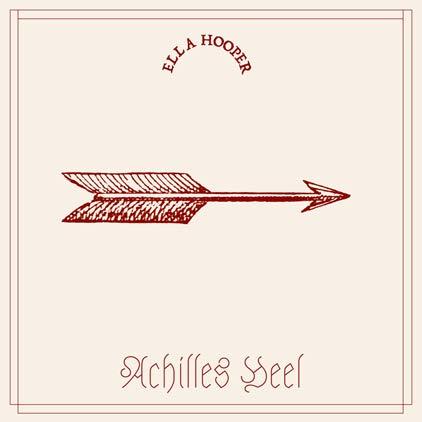 By Jeff Jenkins
By Jeff Jenkins

Ella Hooper goes back to where it all began to start an exciting new chapter in her career.
“How much do you know?” Ella Hooper says when I ask about her new solo album, Small Town Temple
“Oh God, I haven’t quite prepared,” she adds. “This is the first time I’ve spoken to someone about the record. It’s hard to get into. Do you have your tissues ready?”
Of course, most Australians know the Ella Hooper story so far. As a dreadlocked teenager, she topped the charts fronting Killing Heidi, the band she shared with her older brother, Jesse. Alternative pop hits such as ‘Weir’ and ‘Mascara’ are seared into the memories of anyone who was a music fan at the start of the 2000s.
Killing Heidi’s debut, Reflector, was one of the fastest-selling Australian albums ever. It entered the ARIA charts at number one, spent six weeks on top, went five times platinum and won four ARIA Awards, including Album of the Year.
Fame came fast – ‘Mascara’ hit number one on Hooper’s 17th birthday – and it took a toll.
“For a long time, I felt awkward about my success, that I had to apologise for it,” Hooper reveals. “Maybe I would have been more credible and respected if I’d come up the slower way? Being a bit of an overnight success with Killing Heidi really had its challenges. I wasn’t in it to be famous, I was in it to be a musician, but I got very famous, in a really strong, identifiable, Australia-wide kind of way.
“And once you go up, there’s only one way to go – and it’s down. Once you’ve been at number one, well, there isn’t another position … it’s going to go down.
“And I’ve lived that.”
“Everything I know, I’m going to have to unlearn,” she sings on the new album. “If I want to fly high, do I have to burn?”
Feeling a little lost, Hooper travelled to the US in 2017. “I finally got to have my Nashville experience, and I had the best time ever. I felt like I saw my future.”
Hooper connected with country artist Sara Douga, one of Jim Lauderdale’s key collaborators, who released her debut album in 2018, Boots, Bras, and Drawers
“Sara and I have a similar energy – we’re both motor-mouthed brunettes,” Hooper laughs.
They agreed to do some co-writing. “But I was on such a party trip and I cancelled most of my co-writes. I said, ‘I’ll get to it next time.’ But there wasn’t a next time.”
During the pandemic, Hooper went home to visit her mum. Then Covid struck and she was stuck. Douga provided a lifeline, organising some songwriting sessions via Zoom.
“It would be early morning in Violet Town, and late in the day in Nashville. Sara would put her kids to bed and then have a couple of hours with me. She really helped me shape the record and helped me believe that I could finish it.
“Sara really was my cheer squad, which I needed, because sometimes I felt so alone. She was an amazing friend and touchstone. And she’s a great writer and singer. Talk about true country; she’s the real deal, proudly traditional country.
“I bring the alt and she brings the country.” Douga helped Hooper finish the title track of the new album, and they also wrote ‘Old News’ together, a key track on the album, where Hooper confronts some demons – “I feel like I’m just old news, hung up on some teenage blues” – prepares for another ride (“I’m pasting all my war paint on”) and realises that the fire within has not been extinguished.
“I will not apologise,” she declares, defiantly, “for wanting the whole fucking ride and all the colour it brings.”
“I guess ‘Old News’ is a message to myself,” Hooper admits. “It’s okay to be ambitious and still have dreams.”
The first thing you notice when you drive into Violet Town is the distinctive sign welcoming visitors. It was created by renowned Aussie artist Michael Leunig, who calls Violet Town home. He says his signs are “cheery, unusual, colourful and show the spirit of the town, a town that dares to be different – a town that encourages creativity”.
Nestled next to the Honeysuckle Creek, the town – home to about 700 people –has a thriving artistic community.
At a recent gig, Hooper introduced one of the new songs, “Here’s another song about Violet Town … I’m going to be saying that a lot tonight.”
Killing Heidi put the town, in northeast Victoria, on the map.
“Where I grew up is actually part of many trivia nights in pubs all around the country,” Hooper smiles, remembering how she once discovered that her band was a “liddle fact”. Among the trivia printed on the lid of a bottle of Spring Valley juice (“Disco means ‘I learn’ in Latin”; “The first typewriter was called the ‘literary piano’”) was this fun fact: “Australian rock band Killing Heidi is from Violet Town”.
Hooper admits that she and Jesse “couldn’t wait to get out of Violet Town and get to Melbourne”, but Small Town Temple is unashamedly a love letter to their hometown.
“I thought the big city held all the opportunities and answers,” Hooper says,
“but it just wasn’t the case.”
Hooper often wonders if her childhood, on a farm in the Strathbogie Ranges, about 20 minutes out of town, was as idyllic as she remembers. “Jesse and I will often say to each other, ‘Was that real? Was it as beautiful and as magical as we remember it?’

“And I think it was.”
Jesse plays on The Basics and Stuff, which celebrates their upbringing. “Didn’t come from nothing,” Ella sings, “but I didn’t come from much.”
“It was very isolated and very beautiful,” she recalls. “We didn’t have much, but what we had was this special piece of land and a very humble house. We had loving parents, a piano, a violin, a couple of guitars, a mandolin, a banjo, recorders, and long afternoons and long evenings. We’d walk around in the bush and make up songs because we had nothing else to do.”
But the grass was always greener …
“You had bushies and townies. We always wanted to be townies – they were urban and cool. The big smoke of Violet Town!
“We were hippie kids from up on the hill. And they all thought we were a little weird.”
Small Town Temple is bookended by contributions from Hooper’s parents. Her mum, Helen, sings the intro, a poem Hooper wrote to set the scene. In a voice strikingly similar to her daughter, Helen sings of “a humble little mystery waiting there for you”. And Hooper’s dad, Jeremy, closes the record, providing the alto recorder outro on ‘Long Gully Road’.
Hooper dedicates the record to Violet Town and her parents, “for all they taught me with their lives and their love of music”.
And this is the part of the story where you need the tissues handy.
Just after hearing the finished album, Jeremy had a shock cancer diagnosis. He died suddenly, and two weeks later, Helen also died, after having battled breast cancer for 18 months.
“It’s been a very strange time, to say the least,” Hooper says.
“The album is not about that, but I am so grateful that something told me to include my parents. I didn’t know they were going to die when I put them on the record, and I’ve never had them on any of my records before. But they’re the reason I do music, the reason I am who I am, why I love Linda Ronstadt and Joni Mitchell.
47
“It’s all them, so it feels freakishly apt that they open and close the record.”

Her parents’ passing adds a poignancy to a collection of songs that was already deeply personal. The title of the record was inspired by her mum’s house, an old church, where everyone was welcome.
She considered calling it “Small Town Stupa”, after a Buddhist shrine, “but I was worried it would sound like stupor.” She laughs. “Which could also work. But Small Town Temple just felt right.”
The album was produced by Marcel Borrack and Tim Harvey. Harvey is the guitarist in Hooper’s band, but she didn’t know Borrack, who also plays with Dan Warner. “Marcel was a revelation. He’s such a soft, lovely, gentle, creative soul, and he’s become a really good friend.”
Together, they have crafted a record that also translates live. “It’s been a while, I think I’ve lost a few of my rock ’n’ roll moves, even though I’ve been doing this since I was 13 years old,” Hooper told the crowd when she returned to the Melbourne stage recently, at the Northcote Social Club.
A few nagging doubts remain, with Hooper singing, “Who am I to try to take another bite of the cherry?” But Small Town Temple is so strong, Hooper deserves to find a big new audience. It’s only January, but this will definitely be one of the albums of the year.
When I suggest that Hooper sounds like a modern-day Linda Ronstadt, her smile is wide. “Shut up,” she exclaims. “Linda Ronstadt, she’s my favourite.”
A rootsy reinvention it might be, but it feels like this is the record that Ella Hooper was always destined to make. The big pop production of the Killing Heidi days is long gone. The focus is now on the singer and the song.
It’s taken her a couple of decades, but Hooper is back to where it all began. The record company bio for the new album starts with a quote from T.S. Eliot: “And the end of all our exploring will be to arrive where we started and know the place for the first time.”
It seems apt.
Hooper smiles when asked what role Violet Town has played in her creative life. “When we started the band, what did I have to draw on?” she reflects. “I hadn’t had a boyfriend; all I had to write about was my town and my surroundings, friendship and community.”

Twenty-seven years after the beginning of Killing Heidi, Violet Town remains a major muse. Though Hooper now has a few other things to write about as well.
The dreadlocked teenager is all grown up. “This is not about death,” she emphasises when we conclude our chat. “If I was a religious person, I might think I was divinely guided to make this record. But I’m not.”
Whatever the record is, one thing is clear: Ella Hooper is where she wants to be. Or she’s almost there.
“I feel like this is a transitional record,” she says.
“Now, I’m not sure if anyone gives two hoots about a solo record from me but, you know what, I don’t even really care anymore. I’m just going to keep writing songs and try to make it more me and less reactive to whatever’s around.
“And I think this is the start of that journey.”
Small Town Temple is released January 20 on Reckless Records.
48



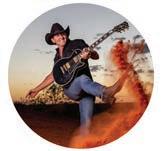
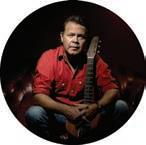


Henry Wagons pulls on his outlaw chaps and boots on his new album, South of Everywhere.
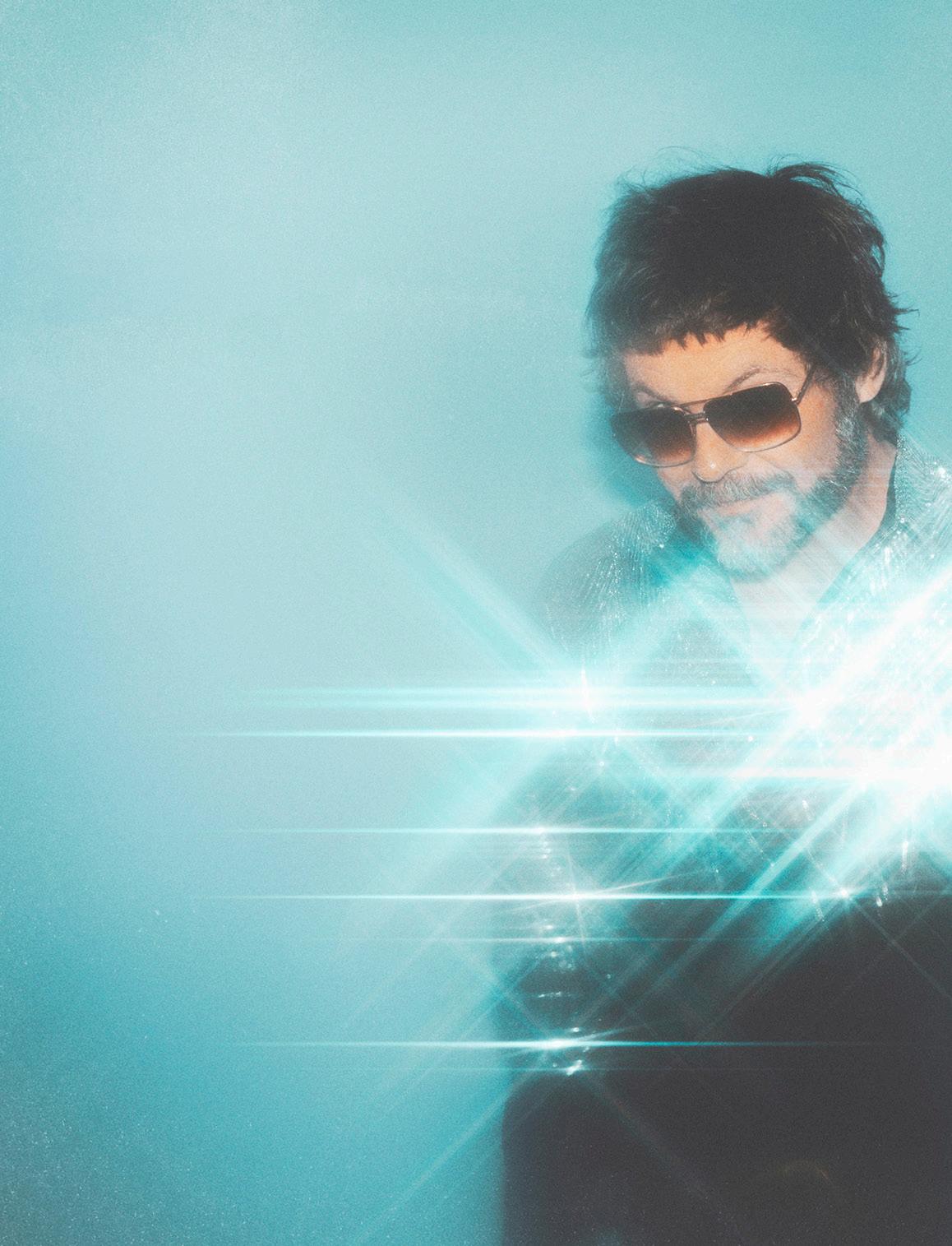 By Bernard Zuel
By Bernard Zuel
If there is a choice between truth and legend, print the legend. This cultural wisdom worked a treat for pulp novels in the 19th century, for westerns in the golden years of Hollywood – the original line after all coming from John Ford’s The Man Who Shot Liberty Valance – and outlaw country music in the 1970s.
Of those “outlaws”, Merle Haggard had done hard time (including being in the San Quentin jail when Johnny Cash did his first shows there) as had David Allan Coe, while Johnny Paycheck would go to prison in the late ‘80s. But Cash (an overnight stay in a county jail notwithstanding), Willie Nelson, military veteran Kris Kristofferson, Jessi Coulter and others could barely scratch up more than a speeding ticket.
Some of those singers had a past, some of those singers had of a dodgy future, but it didn’t really matter if they had the beard, the denim and leathers, and the attitude. Print the legend!
Just ask a youngish Henry Wagons, now a bearded/hatted/booted singer and songwriter, broadcaster and raconteur, with an album called South Of Everywhere imminent, but then a kid who knew deep down that he would never walk into a saloon and silence the pianist and gamblers, or send the women scurrying for safety. Hell, he couldn’t even make the people in front of him look up.
“I was playing in a lot of bands in the late ‘90s, of different sorts, as so many Melbourne ratbags did,” he says. “I was at uni, I was playing in a noise band that sounded like an out of tune TV, I was playing bass in an indie rock band called, Breaking The Law ….”
Which he never did, right?
“I might have stolen a mint Aero bar from a 7/11 at 3 o’clock in the morning in Fitzroy, but that might be as bad as it gets,” he confesses under this relentless cross-examination. “But I was noticing that in that sort of DIY scene, that shoegazing scene, everyone was kind of a shrinking violet. Everyone was kind of stand-and-deliver, they dressed the way they did at home on the couch. And I was 18 and 19 going back through my parents record collection, seeing people like Marty Robbins and Merle and Johnny Cash and Elvis and [pause] Rod Stewart, even the Blues Brothers, and thinking no one’s giving it, no one is delivering on stage in this obnoxious way: I want to try that, it looks really fun.”
Such an epiphany, that would spark a two-decade (so far) career, came with broader cultural input than Stewart in animal print leggings and Jake and Elwood’s porkpie hats.
“My now bass player, Mark ‘Tuckerbag’ Dawson, a dear friend who I played music with, gave me Johnny Cash’s American Recordings, the first one. At the time I was also reading Cormac McCarthy, the Border Trilogy. I also had just seen Dead Man, the Jim Jarmusch film,” says Wagons. “I was really attracted to that mythology, that trippy Western stuff that was a combination of Looney Tunes Foghorn Leghorn mythology from my childhood, these deep songs, the Blues Brothers. But wait, there’s more, possibly in keeping with the fact this budding cowpoke was a suburban Melbourne kid who had ridden a horse once, “but really badly”, and was more tooled up for some of that fancy book learnin’ them folks back east are always talking about. And I don’t mean Zane Grey.
“I was studying philosophy as well, I was a real philosophy wanker, and I really liked grappling with those concepts. So, I started writing some murder ballads, some death songs, and telling some tall tales,
and I feel like ever since then, when it comes to writing and engaging with the country music mythology, I’ve never been pushing shit uphill,” Wagons says. “I’ve never had to fake it or force it. It’s had a momentum that’s been out of my control such that I’m still doing it, and to my immense satisfaction it’s taken over my life. And I’m really thankful for it.”
We look at each other for a bit, that explanation having been a decent old ride but in truth I am fixating on the picture of Foghorn Leghorn riding with a death posse into the darklands of the Texas/Mexico border, possibly being chased by a dark-browed philosophy major and a love interest from Miss Prissy. Now that’s an image to play with, one worthy of an outlaw country song on its own.
But back to young Henry and his new obsession. It took a while for people to realise this was not a fad, this was now him.
“Some of my bandmates, especially early days of [his alt. country band] Wagons, were like ‘this country stuff is really fun, but when do we get to hear some real Henry songs?’. At the time I’d try and please them somehow, and I never quite could,” he says. “I feel like what I’ve done is me. I feel like for better or worse I’m telling stories, I’m playing a character, I’m having fun with dark concepts, and if you know me that is kind of exactly who I am.”
Don’t let Wagons near a gun in Reno. Just sayin’.
“Even though I’m not listening to a transistor radio in a prison cell in the American South in the 1960s, this is all I can do. This is actually the most authentic expression of me and I feel like when I’ve tried to do anything else it’s then I’m faking it,” he says. “I don’t know whether I am brainwashing the mythology or vice versa, but either way, this is where we’ve ended up.”
And where we’ve ended up is a new album that could be said to work the same territory, but retooling its characters, touching on locations and characters not just local but tangible in Henry Wagons’ life. Maybe even parts of him.
“Some of them are completely made up but they are very much embedded in stories of the road around Australia, and it’s a very honest record,” Wagons says, adding wryly. “I’m trying to be at peace with it and not trying to impress my bass player anymore.”

And who wants the truth all the time anyway? I tell him that after listening to the album I didn’t want to know, in fact actively worked against knowing, whether Dover, in Tasmania, is truly “south of everywhere” as claimed in ‘Felix Granger The Finger Pickin’ Boy’. I’d rather exist in a world where that song and that character are very real and there are no narcs pulling out an atlas to prove Wagons or me wrong.
“When I talk about ‘the South’ to Americans, it’s like, this ain’t the South; I’m from Australia, now we’re talking the South,” says Wagons with a grin. “Spoiler alert: Dover is very south. And it is a real place. Though it’s not the furthest south. “But it harks back to what we were talking about: Felix isn’t anybody, he is not a real person, but he is every guitarist, every lead guitarist I have ever met. When I approached Chris Cheney, who plays lead guitar in this song, he said ‘this song is me’, and I said that’s really nice Chris, thank you. But in my head I was going, I know.
“So [Felix Granger] is not true, but he is actually more true than anyone.”
Truth is legend is better than truth. Print that. South Of Everywhere is out February 3 on Cheatin’ Hearts Records.

“When it comes to writing and engaging with the country music mythology, I’ve never been pushing shit uphill.”
– Henry Wagons
ANOTHER WORLD
Tex Perkins and Matt Walker collaborate once again for the Fat Rubber Band’s second album.
By Bernard Zuel
Even reading this it’s possible, no matter your sex, that your shoulders may broaden, your voice deepen and a sudden desire will rise up to heartily slap your best friend on the back. It’s fair to say that a considerable degree of amiable testosterone fills the Surry Hills hotel room occupied by Tex Perkins and Matt Walker, two men with great hair, varying styles of facial fur and faces that say, ‘I’ve been a few places, seen a few things, done a few more’. There may be chest hair involved.
Perkins is in denim, Walker in a pearl-coloured Western shirt, and it’s Perkins name up front of their latest venture, the second album for the slow-groove blues/laidback roots rock Tex Perkins and The Fat Rubber Band. But for all intents and purposes, the pair is a singular unit, as songwriters, bandleaders and vibe-merchants.
They met in the mid-‘90s when Melbourne long-termer, Walker (a multifunction polis of a guitarist, capable of anything and described by Perkins as “a surprise package: you never know what he is up to really”) was a new solo artist and Perkins was in his peak Cruel Sea years. By then Perkins, who feels like he’s approaching 2m tall and is built like a stockman who will be having that second steak for breakfast, thanks love, was a literal and figurative giant on the Sydney independent scene.
He’d come down more than a decade earlier from Brisbane as a 17-year-old who’d had “this stunted existence growing up in Brisbane, where everything was kind of horrible really” – from Bjelke-Petersen’s brute force police and roving bogan thugs, to questionable school days – and found an inner-city community all in (long-legged) walking distance, “and people didn’t treat me like shit”.
What took them from a couple of musicians playing together to a collaboration where they would write and work, and sometimes even think, as one?
“I’ve tried to work with other people and I don’t know, the environment, settings, timing, it just hasn’t been conducive to a natural [arrangement],” says Perkins. “But Matt and I had already been spending quite a bit of time together through the Man In Black [the semi-stage show, telling the Johnny Cash story through tales and songs, with Perkins, naturally, playing Cash] and knew each other well.”
Walker says, “I reckon we both knew, even though we hadn’t really spoken about it, that we had a lot of crossover influences that informed both our music. We had been circling around, crossing paths every now and then, back to the 90s when I would support Cruel Sea”.
The timing, the Cash magic even, was right and inevitably, “I started getting song ideas and thinking, shit, it would be cool if Tex sang this one, it suits him more than me,” remembers Walker. Perkins was amenable. And the appeal of the not-quite-opposites is clear. “Matt’s just a really great player who can make really simple things sound really effective,” says Perkins. “He’s a seasoned player and you can sense the effortlessness in his playing, but also the economy: he is very direct when he needs to be. He can be anything that [the song] needs to be. That’s why our bread-and-butter gigs are duos.”
For Walker, “I reckon, stylistically, you’re not often in a situation where it feels completely right, and that’s what it’s like to me. I never think, ‘Oh I don’t want to play that song’, it’s always, ‘fuck yeah’.”
He says he sees in the music and artists that they might bring to each other’s attention a commonality in “the feeling within the music, the important parts. It’s got to have an earthiness, it’s gotta have a bit of toughness, then other songs are really beautiful.”
Other World, the new album, will be defined by the notes not played and the space not filled, even the presence not imposed. Tracks like ‘This Monin’ (sic), and ‘The Devil Ain’t Buyin’,’ are examples of songs that deliberately don’t push just when you think they might, just when you are sure they must. And that is by no means suggesting it’s a soft record; it’s a band showing restraint, the playing of Walker, drummer Roger Bergodaz, bass player Steve Hadley and percussionist Evan Richards sliding up almost slyly.
“I think that’s more the case with this record than the other [self-titled] record,” says Perkins. “There’s a lot more subtleties on this record; we’re not striking the hammer as hard, and it’s not as necessary to do so.”
Walker describes Other World as “sonically different to the first one” and can pinpoint even further. “Maybe the rhythm section has a different role in this then it had on the first. Maybe the first album was a bit more guitar based – a lot of songs were written on the 12-string and that was spearheading it – but with this we were often bring in new songs fresh into the studio and the guys in the band would just set up such a solid foundation.”
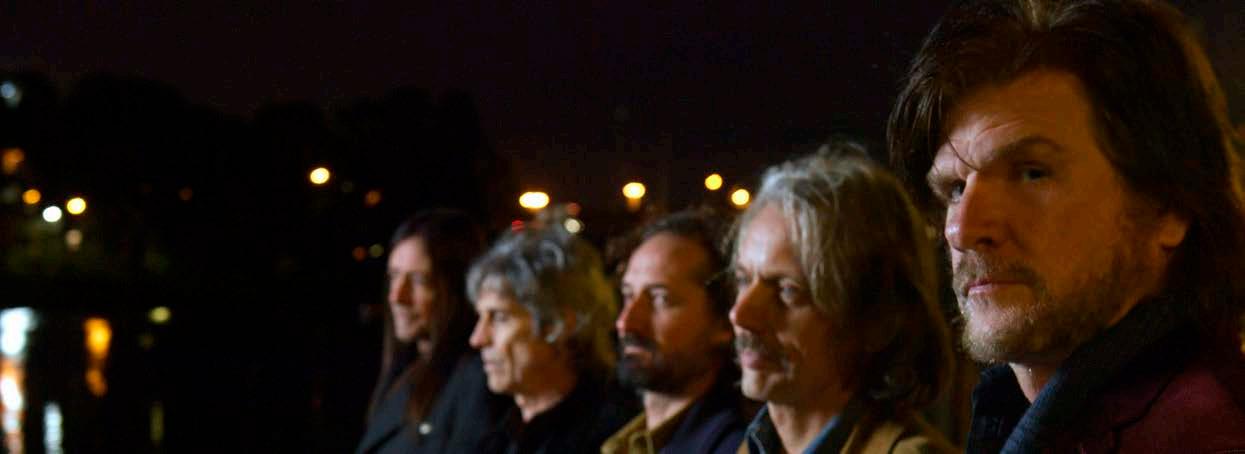
Perkins backs this impression, saying “we knew each other as a unit a lot better when we came to record their second record. We were putting the band together, literally, on the first record. Everyone now knows their roles and their strengths so songs could feel almost complete very quickly.”
This gentleness, this amiability, even extends to what may sound like straightforward advice, like that in one new song, ‘Nobody Owes You Nothin’,’ that offers some hard-earned – dare we say manly – wisdom.
“What I find with advice-based songs, philosophical songs, ethicsbased songs, they’re actually pointing back at myself. Me reminding myself of stuff,” says Perkins. “And I think a lot of it’s based on fear: I wouldn’t want this to happen. I almost write a song to prepare myself for this moral or ethical situation I might find myself in. A lot of times you write a song in the situation will literally appear a couple of years later, and you go, fuck this is what that song was about.
“So, you write a song that sounds like you are pointing outwards and it’s actually very much inwards.”
Do they listen to themselves, take their own advice?
“Eventually,” says Perkins, as Walker chuckles beside him, knowingly. “Eventually. After you’ve fucked up.”
Tex Perkins and The Fat Rubber Band’s Other World is out February 10.
52
TRUMPETING A RETURN
Reg Mombassa and Peter O'Doherty are back with a new Dog Trumpet album.
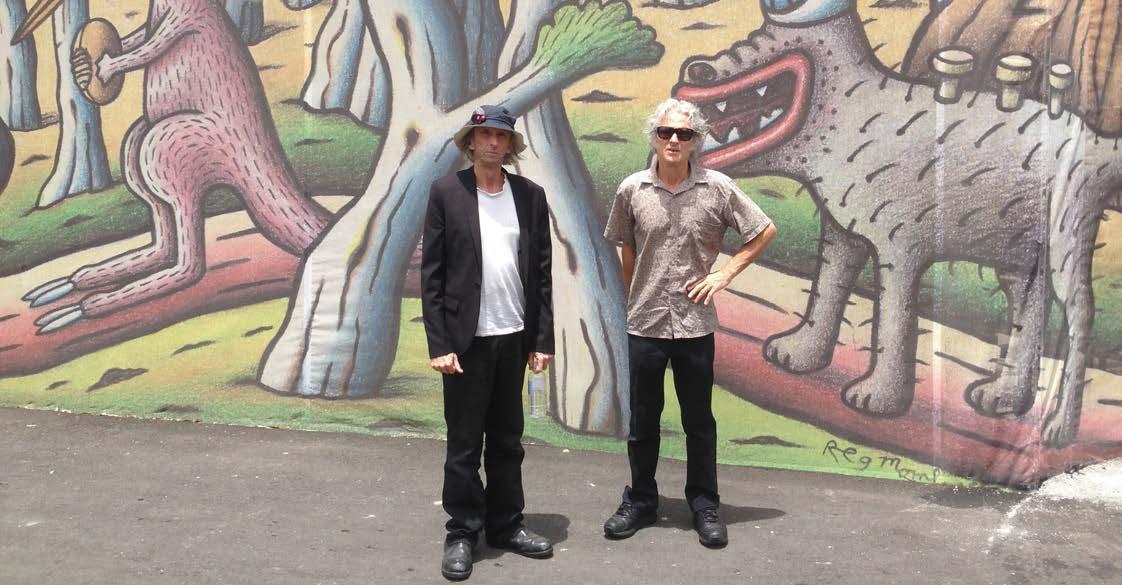 By Bernard Zuel
By Bernard Zuel
Itwas the worst of times, it was not so bad a time.
The last time Dog Trumpet released another slice of pop/folk/ country pleasure April 2020’s Great South Road, the world shut down. Perhaps surprisingly for the brothers, musicians who also are two of Australia’s most loved visual artists, who each in their own way tap into the ordinary and the very odd of the landscape, streetscape, fauna and psyche of Australia and New Zealand, the resulting two years of playing to screens, huddling in their homes, didn’t shut them off from stimuli.
“I get most of my stimulation from television,” says Reg Mombassa, with a wry grin. “So I don’t have to go outside.”
And though there’s a wistful song of his called ‘No More Travelling’ on their new record, Shadowland (“There’s no more travelling/No more festivals too … I don’t have a meaning/I don’t need a name”) Peter O’Doherty declares that, “for me, I enjoyed it” when the world shut down and “I didn’t feel like I had to be anywhere but home.”
Indeed, they got a lot of work done, writing a pack of songs, making art, and digging into the back catalogue of both Dog Trumpet and its predecessor, Mental As Anything. But then that is what Dog Trumpet do: paint, write, exhibit, perform. Not putting their album out in 2020, or holding on in 2022 to see if the music industry genuinely has turned around before releasing its successor, would have made no intrinsic sense, irrespective of any practical or commercial sense.
Not that the brothers are impervious to the 21st century of course.
‘Fucking Idiots’ (“Wake up humans/You fucking idiots”), sums up the way many of us have felt over the past few years watching our socalled leaders and betters royally foul their nests and fuck up the world. Has Mombassa been sitting at home quietly compiling a list of these fucking idiots? Or would that be like knitting an endless scarf?
“I did write it relatively recently,” he points out, before reminding us that it’s not his first political rodeo, though this is the first time he has “put that word” into a song. “I wrote a song called ‘Troop Movements In The Ukraine’ about 40 years ago, on a Mental’s album, and that was
an anti-war song, anti-nuclear war song. ‘Fucking Idiots’ is another anti-war song … I’ve always hated militarism and patriotism and nationalism, they are really poisonous concepts and they seem to be ramping up again.”
It’s not all shades of existential gloom though as the record also dives headlong into reminiscence. O’Doherty begins side two of the album with ‘The Ballad Of Clayton Looby’ (“The first job I ever had/Was pumping petrol afternoons and nights”) and in the song ‘Nina Simone’ (“It’s been a long time/Since Eunice Kathleen Waymon’s patience/Was put to the test”) he explains the role of the great singer, songwriter and pianist, whose real name was Eunice Kathleen Waymon, in a pivotal moment in the young O’Doherty’s life.
“It’s also the story, my personal story of going to London,” he says. “I had a friend from Sydney living there, she was on a working holiday for a year, so I rang her up when I was in London and we went out to the markets, and I bought her a Nina Simone record, the first record she released in 1958 [‘Little Girl Blue’]. It was such a great record and a time that I will never forget, because I’m still married to that girl.”
I reckon Eunice Kathleen Waymon, her patience tested by audiences and the industry, her early ambitions as a classical pianist thwarted, her tolerance of the music business and its inbuilt racism and sexism barely there to start with and long gone by the latter stages of her career, would have well understood some of the righteous anger behind ‘Fucking Idiots’.
“Righteous anger can also be completely wrong,” says Mombassa, happily self-critical, maybe even typically so. In truth, for 40-odd years, while skating across moments of righteous anger and maybe occasional bursts of bitterness, the brothers could be said to have maintained a pretty impressive equilibrium. In their art and in their music. Maybe because of their art and their music.
“That’s part of what art is, isn’t it?” says Mombassa. “It’s expressing your own anxieties and fears in your own joys and positive feelings to other people and reflecting what other people are feeling. And maybe the art and the music makes it better.”
O'Doherty says: “We come at it from different angles, though we have a lot of common ground, but making work is good therapy. Just doing it keeps me much more balanced, and if I’m not touring either art or music, I can very quickly fall into a big hole. And perhaps we don’t really ever understand ourselves: that’s why in a way you keep doing it, to try and find something else, to dig something out of yourself.”
Shadowland is out now.
Dog Trumpet will be on tour in February and March.
53
“I’ve always been the guy who never says no to a gig,” says Redd Volkaert, his deep and twangy voice resonating through my speakers on a muggy Tuesday morning. “Somebody calls at eight thirty and says, ‘We’re playing at this shithole starting at nine until three, pays forty bucks, do you want in?’ Oh yeah, yeah! Just for fear of never working again, and I’ve done that all my life.”
This he has – I venture to Volkaert that, since he was a teenager, he’d not have had more than a handful of nights off, to which he laughs, deep and twangy, adding, “Yeah, I think I’m over it now a little bit. So, when I moved here… I finished up in Texas [in 2019], New Year’s Eve was my last thing and I came out here and then covid hit in March, so I instantly had a year and a half off and I thought, well, if I thought of retiring, now’s the time to do it.”
These days, Volkaert runs cows and horses, donkeys and the like in South-West Virginia, but don’t go thinking he’s not playing music anymore. For it would seem, if one were to cast an eye back over his fifty-year career of slinging
six strings all about this big ol’ world, that he’d not be able to retire even if he wanted to.
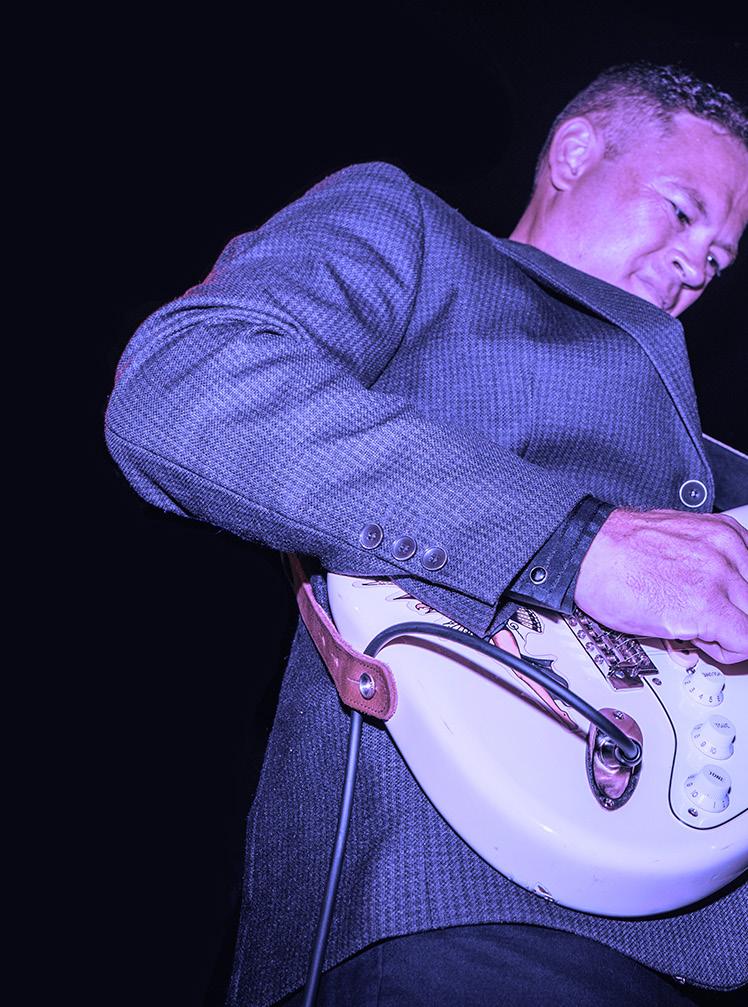

He cut his teeth playing all sorts of music in his native Canada as a teenager (although it was old time country that truly inspired him), moved to LA in the mid- ‘80s and put up his shingle as a gun for hire. He’s lived in Nashville and Austin and has, of course, played with the best of the honky tonk best – George Jones, George Strait, Rhonda Vincent, Dwight Yoakam, Brad Paisley; he was the picker of choice for Merle Haggard’s band from 1997 until Merle died in 2016. His own combo held down the Saturday afternoon residency at legendary Austin venue The Continental for twenty years. He’s the man, the Titan of the Telecaster. He couldn’t stop if he tried.
“About a year and a half ago it was like somebody flipped a switch and everything came back, and I started getting emails and calls for all kinds of great stuff,” he says. “Finland and Switzerland, Norway, different places to play for a couple of weeks then back home to nice, quiet farm life where I’m not

waiting by the phone for a call to play that night, so that’s the reason I [moved out here] I guess.”
The second of three children, Volkaert grew up outside of Vancouver in Canada’s British Columbia province, picking up his older brother’s guitar at the age of ten. He learnt to play by ear, jamming with neighbourhood kids and playing with his brother who’d taken up the drums. The big music of the time was, “Zeppelin and Deep Purple, Grand Funk, bands like that,” he remembers, “but my parents had a really good record collection. My dad liked a lot of blues people… and my mother had everything, Les Paul and Mary Ford, she had a Jimmy Bryant ten-inch EP that had ten songs on it, so I just wore that thing out… that was kinda my introduction. She also had Buck Owens and a couple Merle Haggard albums, Waylon Jennings’ first album, Jerry Reed’s first album… so that got me interested in dabbling a tiny bit in each style.”
Volkaert has an insatiable appetite for learning. It’s how he began in music, and it’s what’s
54
kept him at it, always looking to expand his musical knowledge, his sonic repertoire. “When I was thirteen, I ended up playing in a couple of weekend bands… they were country guys, played in the Legions and Elks clubs… kinda like your RSL clubs,” he says. “They were hard country, old school, playing Jim Reed and Buck Owens. So, I really got into that, because it was fun to play with those guys. And it was a real challenge to learn, and as they challenged me with stuff to learn, the more I liked it.”
“At that time, they had to come and get me for the gig then drive me home, because I didn’t drive yet,” he goes on with another laugh, “But when I got my license I started playing more and more, I started filling in… I was living outside of Vancouver, and so I would drive into the city and play with some blues bands, popular radio pop/rock bands, and I took those gigs for the exact same reason – I didn’t know any of the music and I wanted to learn it. So OK, I’ll jump in with both feet.
“And I was still playing with the weekend country bands, and then a couple of road
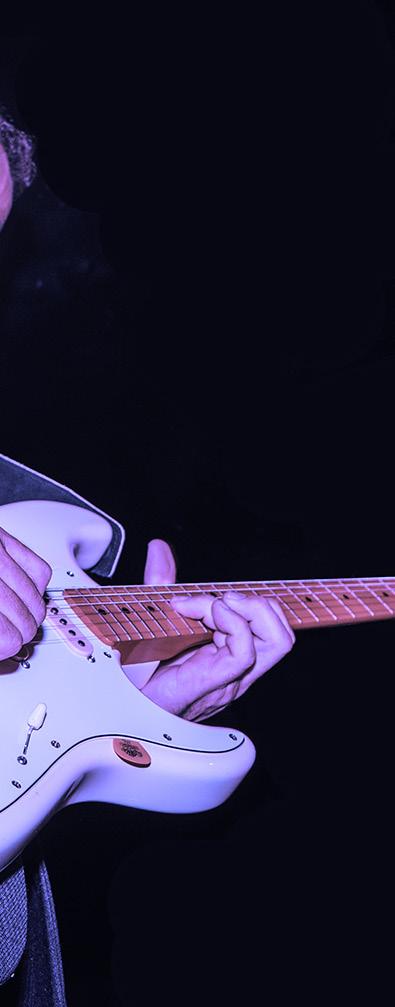
opportunities came up to go out on the road for a week or two with the country band, so I ended up doing that, loving it, thinking, ‘This is what I wanna do!’, so like a dumbass I quit school a year early and went on the road, and I’ve been on the road ever since.”
Where Volkaert will roadtrip next is to Australia, a country he understandably hasn’t been since 2018. “I came probably every year for about seven or eight years [before covid],” he recalls. On this particular trip he’s teaming up with local guitar hero Ray Beadle; dubbed the Guitar Gumbo tour, it takes in a slew of dates through Victoria and New South Wales, Volkaert and Beadle trading licks the whole way, culminating in a stop at Studio 301 in Sydney, where the pair will lay down a live record in front of a small audience.
“I’d just like to capture a bit of chemistry that can be made when two guitar players are genuinely having a great time,” is Beadle’s pithy modus operandi on this record. The pair have never met – the tour being organised by Karl Bergersen and manager Geoff Trio – but for Beadle it was an opportunity to be jumped at. “I’ve only dreamt of meeting Redd, let alone being able to play along-side him,” he says. “A friend of mine… introduced me to Redd’s guitar prowess long ago. I remember first hearing him and feeling excited and inspired, I hear a lot of personality in his playing. I was lucky enough to be approached [for this tour] so I jumped at the chance. “
For Volkaert, it’s another chance to hit that never-ending road, continuing his career into its sixth decade. “Oh yeah, this last year I’ve been busy as hell,” he smiles. “This summer gone I’ve been playing with a western swing band from Fort Worth called the Western Flyers, kind of a cowboy swing band; we did a tour out west for about a few weeks, then I flew home and drove to Maine and played a few weeks up there, then back home then I flew to Finland for a week… just always something, I’m off for a few weeks then home for a few weeks.
“Last week I was in Louisiana with Bill Kirchen, we do a duo a bit, so I work with him, and I work with a guy called Robbie Fulks, we do a duo, or a band and another fella named Dallas Wayne, he’s a singer. He lives about two hours from me, so we do some duo stuff there. So, I’ve still got my fingers in a bunch of different situations, which isn’t just all my trio or whatever.”
On the upcoming Australian run, Volkaert is blissfully ignorant on how it’ll all pan out, but it’s something he’s taking to with his usual gusto – keen to learn, to jump in with both feet. “No, I’ve not met [Ray] yet,” he laughs. “It’s gonna be a treat though, he’s awesome, I’m looking forward to it, it’ll be really fun to do it with him.” As Beadle says of Volkaert, “Redd is able to slot in with anyone in the world,” so there’s little doubt, as Redd Volkaert keeps on keeping on, that this’ll work out just fine –there’s no saying no to that.
Redd Volkaert and Ray Beadle are touring through February 2023. See the Gig Guide for details.

55
Titan of the Telecaster Redd Volkaert has barely stopped in a career spanning almost fifty years, and he’s bringing that energy back to Australia, where he’ll team up with our own Ray Beadle, writes Samuel J. Fell.
BEST MUSIC BOOK
Folk Music: A Bob Dylan Biography In Seven Songs, Greil Marcus The Philosophy of Modern Song, Bob Dylan
BEST
WRITERS, BEST OF
BRIAN WISE
TOP25 ALBUMS OF THEYEAR
Precious Energy, Barney McCall
Greetings From Lake St Clair, Sara Tindley Maybe,Then……, Dan Warner
The Real World, Freya Josephine Hollick Cruel Country, Wilco Resist, Midnight Oil Bloodline Maintenance, Ben Harper
The Blues Don’t Lie, Buddy Guy Searching ForThe Heart of It All, Rob Snarski & His So Called Friends
The Greatest Show On Hurt, Tommy McLain
Just LikeThat, Bonnie Raitt Get On Board, Ry Cooder & Taj Mahal
OnlyThe Strong Survive, Bruce Springsteen World Record, NeilYoung & Crazy Horse
The Man From Waco, Charley Crockett Come Morning, Bros Landreth The Boy Named If, Elvis Costello & The Attractions
Second Nature, Lucius It’s A Long Road, The Meltdown Peculiar, Missouri, Willi Carlisle
The Spur, Joan Shelley
Take it Like A Man, Amanda Shires I'd Rather Be Listening To,Sweet Talk Things Happen That Way, Dr John Anais Mitchell, Anais Mitchell
TRIBUTE ALBUM
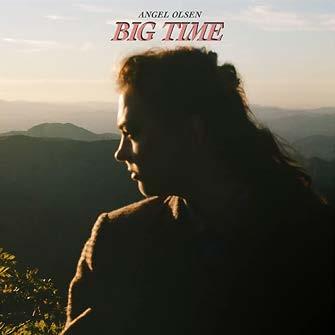
Here It Is: ATributeTo Leonard Cohen
Live Forever:The Songs of Billy Joe Shaver
BEST /BOX SET/RE-RELEASE
Revolver, The Beatles
Sail On Sailor, Beach Boys Spirit of Place 40th Anniversary, Goanna Landlocked, Chris Wilson
OTHER BOOKS
The Tilt, Chris Hammer Sea of Tranquility, Emily St John Mandel
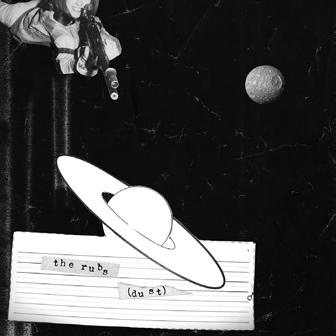
BEST MUSIC FILM
Harvest Time, Neil Young JazzFest: A New Orleans Story
BEST TV SERIES
Shetland/Three Pines/ Fisk
BEST FESTIVAL/GIGS
Goanna, Womadelaide
Milk Carton Kids/Brennan Leigh/Asleep At The Wheel/Jerry Douglas, Americana Festival, Nashville
Marty Stuart & His Fabulous Superlatives, Trans Pecos Festival, Marfa, Texas
HIGHLIGHT OF THE YEAR
Rhythms 3oth Anniversary Edition, May/June 2022
MARTIN JONES
BEST OTHER BOOK
The Passenger/Stella Maris - Cormac McCarthy
BEST MUSIC FILM
Moonage Daydream
BEST FEATURE FILM
Licorice Pizza
BEST FESTIVAL/GIGS
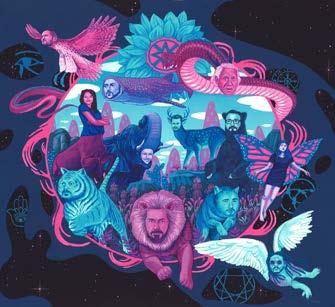
Midnight Oil, The Palais Theatre
HIGHLIGHT OF THEYEAR
Midnight Oil, The Palais Theatre
A set list heavy on the early albums and a run through 10… 1 from start to finish. Talk about going out with a bang!
MICHAEL GOLDBERG
TOP 10 ALBUMS OF THE YEAR
Big Time, Angel Olsen
Ali, Khruangbin and Vieux Farka Touré
We’ve Been Going About This All Wrong, Sharon Van Etten
I Love You Jennifer B, Jockstrap
Dragon Warm Mountain I Believe In You, Big Thief
Skinty Fia, Fontaines DC
My Boy, Marlon Williams
Cruel Country, Wilco
Endless Rooms, Rolling Blackouts Coastal Fever
Greetings From Lake St Clair, Sara Tindley
BEST COMPILATION
Words & Music, May 1965 - Lou Reed
BEST MUSIC
BOOK
The Philosophy of Modern Song - Bob Dylan
TOP 10 ALBUMS OF THE
Dust, The Rubs
Wetleg, Wetleg
YEAR
Saturday’s Sons—The Complete Recordings: 1964-1966, The Sons of Adam
Audio Drag for Ego Slobs, Gustaf
Growing Up, The Linda Lindas
1970 Demos, Flying Circus
A Legacy of Rentals, Craig Finn
Only the Strong Survive, Bruce Springsteen
The Legendary Typewriter Tapes: 6/25/64
Jorma’s House, Janis Joplin & Jorma Kaukomen, Dragon New Warm Mountain I Believe In You, Big Thief
BEST COMPILATIONS
Saturday’s Sons—The Complete Recordings: 19641966, The Sons of Adam
Turn Around: the Complete Recordings 19641970, The Beau Brummels
BEST MUSIC BOOKS
Folk Music: A Bob Dylan Biography in Seven Songs, Greil Marcus
Kill A Punk For Rock ‘n’ Roll, Marty Perez
Memphis Rent Party, Robert Gordon
Corporate Rock Sucks: The Rise & Fall of SST Records, Jim Ruland
Freak Out!: My Life With Frank Zappa, Pauline Butcher
56
BEST MUSIC FILM
Nick Cave, This Much I Know To Be True
BEST FESTIVAL/GIGS
(One or two of each)
Oumou Sangare at Freight & Salvage wed., Oct. 26, 2022
HIGHLIGHT OF THE YEAR
The publication of two books I wrote: Wicked Game: The True Story of Guitarist James Calvin Wilsey (HoZac Books) and Addicted To Noise: The Music Writings of Michael Goldberg (Backbeat Books)
ANNE MCCUE
TOP 10 ALBUMS OF THE YEAR (IN NO ORDER)
Storm Queen, Grace Cummings
Hysteria , Indigo Sparke
Precious Energy, Barney McCall
The Real World, Freya Josephine Hollick

Midnight Rocker, Horace Andy
The Man From Waco, Charley Crockett
Life On Earth, Hurray For The Riff Raff
Kingmaker, Tami Neilson
Mr Morale & The Big Steppers, Kendrick Lamar
Thee Scared Souls, Thee Sacred Souls
BEST COMPILATION/REISSUES
Sail On Sailor, ’72, Beach Boys
The Blue Note Tone Poet series Watertown, Frank Sinatra Habibbi Funk – anything I could find Awesome Tapes From Africa – anything I could find Stories, David Blue Car Tape, Lisa Miller
BEST MUSIC BOOKS
Sonic Boom: The Impossible Rise Of Warner Bros Records, Peter Ames Carlin
Holy Ghost: The Life And Death Of Free Jazz
Pioneer Albert Ayler, Richard Koloda
Dangerous Rhythms: Jazz & The Underworld, T.J. English
BEST MUSIC FILMS
TOP 2 ALBUMS OF THE YEAR
(that I heard, I’m still catching up):
Live At The 5 Spot, Jack Silverman, Cerulean, Nashville Ambient Music Ensemble, Spencer Cullum’s Coin Collection 2

BEST MUSIC FILM
Moonage Daydream (noisy, chaotic montages annoying but I was walking on air afterward, inspired)
HIGHLIGHT OF THE YEAR
Seeing Jack Silverman Quartet at The Dive, Nashville (it was the guitar tone I’ve been yearning for)
STUART COUPE
Fire Music Ennio Wanita!
BEST FESTIVAL/GIGS
Grace Cummings & Band at Dashville Skyline
Nick Cave/Warren Ellis – Palais Theatre, Melbourne FOOLS at Bluesfest
HIGHLIGHT OF THE YEAR
Finishing my Shake Some Action memoir which is published by Penguin Random House in August 2023 – and knowing that I’m getting to do an audio book version
WRITERS, BEST OF
DES COWLEY
TOP 10 ALBUMS OF THE YEAR
Oaatchapai, Sam Anning
Hyper-Dimensional Expansion Beam, The Comet is Coming
Suite for Max, Angela Davis
Bordeaux Concert, Keith Jarrett
Trios: Chapel (Live), Charles Lloyd
Shadow Phase, Peter Knight
In These Times, Makaya McCraven
Another Dance, Mike Nock Hamish Stuart Julian Wilson Jonathan Zwartz
Disruption! The Voice of Drums, Jeremy Rose & the Earshift Orchestra
Meditations, Julien Wilson Mutations

BEST COMPILATIONS
Collected Works, John Adams
Albert Ayler Revelation: The Complete ORTF 1970 Fondations Maeght Recordings
BEST MUSIC BOOKS
Bill Frisell, Beautiful Dreamer, Philip Watson Wangaratta Festival of Jazz & Blues: 30 Years, Adrian Jackson & Andra Jackson
BEST MUSIC FILMS
Ennio: The Maestro, directed by Giuseppe Tornatore Moonage Daydream, directed by Brett Morgen
BEST FESTIVAL/GIGS
Julien Wilson, first-ever solo saxophone performance, Wangaratta Festival of Jazz & Blues, 20/10/22
Mike Nock, performing his classic 1982 ECM album Ondas, Melbourne International Jazz Festival, 17/10/22
HIGHLIGHT OF THE YEAR
The five-hour Sanctuary Suite, held at Melbourne’s Elizabeth Murdoch Hall, 9/7/22, lived up to its promise of delivering ‘a sonic exploration of reflective, thoughtful, and meditative music’, featuring towering performances by Paul Grabowsky, Peter Knight, Luke Howard, Nat Bartsch, Nick Tsiavos and others.
57
>>>
SUE BARRETT
WRITERS, BEST OF
DENISE HYLANDS
TOP 10 ALBUMS OF THE YEAR
Koort, Gina Williams & Guy Ghouse

The Light at the End of the Line, Janis Ian Sweet Tooth, Mali Obomsawin
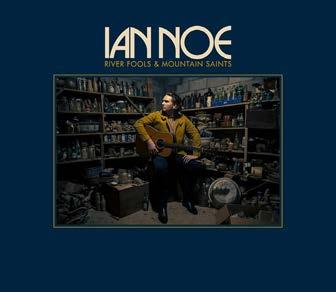
Dark Enough to See the Stars, Mary Gauthier
My People, Karnage N Darknis
The Source of Light, Eric Bogle
Songs from the River Wind, Eliza Gilkyson
Stones Mumma Kissed, Kym Pitman 1960, Martyn Joseph Endless Grace, Deirdre McCalla
BEST MUSIC BOOKS
This is What it Sounds Like, Susan Rogers & Ogi Ogas
The Angry Women’s Choir, Meg Bignell
BEST OTHER BOOKS
TOP 10 ALBUMS OF 2022
(IN NO PARTICULAR ORDER)
The Man From Waco, Charley Crockett
The Real World, Freya Josephine Hollick Ramblin’ Soul, Melissa Carper Big Time, Angel Olsen
River Fools & Mountain Saints, Ian Noe Kingmaker, Tami Neilson
On The Ranch, Emily Nenni Neon Blue, Joshua Hedley Self-Titled, Teddy & The Rough Riders Obsessed With The West, Brennen Leigh
BEST COMPILATION
Something Borrowed, Something New: A Tribute To John Anderson
Live Forever: A Tribute To Billy Joe Shaver
BEST FESTIVAL / GIGS
Out On The Weekend, October 2022
Sierra Ferrell Australian Tour 2022, Canberra Theatre, October 9
HIGHLIGHT OF THE YEAR
The return of international touring artists.
Dark Winter, Raina MacIntyre
Rambutan: Recipes from Sri Lanka, Cynthia Shanmugalingam
BEST MUSIC FILM Wash My Soul in the River’s Flow
BEST FEATURE FILM/BEST DOCUMENTARY
Full Time How to Tell a Secret
HIGHLIGHTS OF THE YEAR
Hugs (real and virtual). Courage, integrity, resilience, kindness, humour. The wonders of nature. Finding joy in little things. Creative people. Bec Goddard and the Hawthorn AFLW team.
STEVE BELL
TOP 10 ALBUMS OF THE YEAR
This Mess We’re In, All McKinley

Dragon New Warm Mountain I Believe In You, Big Thief
I Walked With You A Ways, Plains
River Saints And Mountain Fools, Ian Noe
Welcome To Club XIII, Drive-By Truckers Cruel Country, Wilco King Stingray, King Stingray
On The Ghostlines, With Hands Of Lightning, Halfway
Paint This Town, Old Crow Medicine Show El Mirador, Calexico
BEST COMPILATIONS
Terror Twilight: Farewell Horizontal, Pavement Collected Versus, TISM
BEST MUSIC BOOKS
Needles And Plastic: Flying Nun Records 1981-1988, Matthew Goody
Lovers Dreamers Fighters, Loene Carmen
BEST MUSIC FILMS
Moonage Daydream Travelling’ Band: Creedence Clearwater Revival At Royal Albert Hall
BEST
FESTIVAL/GIG
Bluesfest Big Thief @ Princess Theatre (Brisbane)
HIGHLIGHT:
It’s got to be the return of live music after the horrors of the pandemic, I don’t think we’ll ever take the inherent joys of the communal live music experience for granted ever again. The well-overdue return of TISM to the national discourse has been fun, and joining forces with Mick Thomas to release his music on my label is like a surreal dream come to life, it would be difficult to be more excited by a turn of events without it including St Kilda winning premierships.
CHRIS FAMILTON
TOP 10 ALBUMS OF THE YEAR
River Fools and Mountain Saints, Ian Noe
Cruel Country, Wilco
Welcome 2 Club XIII, Drive-By Truckers

58
>>>
Dragon New Warm Mountain I Believe In You, Big Thief
Toast, Neil Young with Crazy Horse Romeo & Juliet, Ryan Adams
The Sea Drift, The Delines
Strength Of A Queen, Andy Golledge
Welcome To Sin City, Sin City
The Man From Waco, Charley Crockett
BEST COMPILATIONS
Yankee Hotel Foxtrot, Wilco Revolver, The Beatles
At The Royal Albert Hall, Creedence Clearwater Revival
BEST MUSIC BOOK
Faith, Hope and Carnage, Nick Cave and Sean O’Hagan
BEST MUSIC FILM
Travelin’ Band: Creedence Clearwater Revival at the Royal Albert Hall
BEST FESTIVAL/GIGS
(One or two of each)
Bluebottle Kiss @ Crowbar Sydney Dashville Skyline
HIGHLIGHT OF THE YEAR
Seeing Bluebottle Kiss play live again.
CHRISTOPHER HOLLOW
BEST MUSIC BOOK
Let’s Do It: The Birth of Pop, Bob Stanley
BEST OTHER BOOK
Homo Irrealis: Essays, André Aciman
BEST MUSIC FILM
Weird: The Al Yankovic Story
BEST FEATURE FILMS/ DOCUMENTARY
Prey
Cocaine Bear
BEST FESTIVAL/GIGS
Dean Wareham and Ryder the Eagle, La Nau, Barcelona Out on the Weekend
HIGHLIGHT OF THE YEAR
The Sand Pebbles played one ripping show at a small festival in Bambra on the Surf Coast. The fellow, Gavin, built his own stage and put on a party for his friends on Easter Saturday. It was magic.
CHRIS LAMBIE
WOMADelaide TAMIKREST, The Night Cat, Fitzroy
HIGHLIGHT OF THE YEAR
Birdsville Races and surviving COVID
BRETT LEIGH DICKS
TOP 14 ALBUMS OF THE YEAR
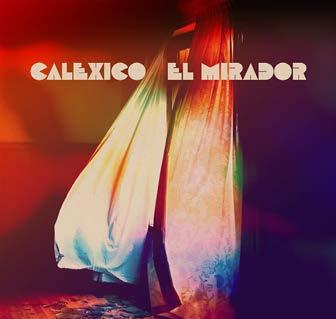
In Your Hands, Lewsberg
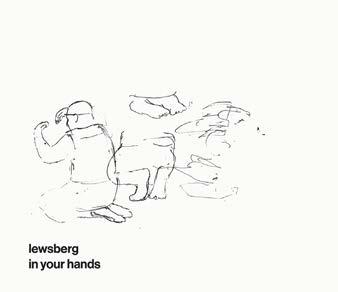
Mono Retriever, Dummy Reset, Panda Bear & Sonic Boom
Petunia, Tonstartssbandht
Pompeii, Cate Le Bon
Rotsler’s Rules, Black Cab
Michael Rault, Michael Rault
Everything Was Funny, Dave Graney & Clare Moore
Love | Song, Starry Eyed & Laughing
Wilds, The Soundcarriers
Past Life Regression, Papercuts
This is a Photograph, Kevin Morby
Spencer Gets It Lit, Jon Spencer & The HITmakers
Mirage, Molly Lewis
BEST COMPILATION
Choctaw Ridge: New Fables of The American South, Various Artists
TOP 10 ALBUMS OF THE YEAR
GOLD, Ashley Davies

Waiting To Fly, Lisa Richards
You Reap What You Sow, The Weeping Willows
Dreamland, Tanya-Lee Davies
Greetings From Newtown Geelong, Van Walker & The Ferriters
Snowcap Menace, High Ace
Same Boat, Hussy Hicks
King Stingray, King Stingray
My Boy, Marlon Williams
Resist, Midnight Oil
BEST COMPILATION
My Songs: 1989–2021, Archie Roach
BEST MUSIC BOOKS
All The Rage, Paulie Stewart No Bull, Vika & Linda Bull
BEST MUSIC FILM
Moonage Daydream
59
BEST FESTIVAL/GIGS
10 ALBUMS OF THE YEAR
Mirador, Calexico ThornBird, Thornbird
Sea Drift
The Delines
Rae
Kit
The Wailin’ Jennys
Work:
on Music
Gordon
Sinead Gleeson
Tár
We
Here WRITER,S BEST OF WRITERS, BEST OF >>>
TOP
El
The
,
Loose Future, Courtney Marie Andrews Breaking the Thermometer, Leyla McCalla Lighten Up, Erin
Crooked Tree, Molly Tuttle and Golden Highway Fables In A Foreign Land, John Doe Folk Trio Palomino, First Aid
I Walked With You A Ways, Plains BEST COMPILATION Fifteen,
BEST MUSIC BOOK This Woman’s
Essays
, Kim
and
BEST OTHER BOOK Modern Instances: The Craft of Photography, Stephen Shore BEST MUSIC FILM
BEST FEATURE FILM
Are Still
AL HENSLEY
WRITERS, BEST OF
BEST FESTIVAL/GIGS
ThornBird (Album Launch) - Albany Town Hall
Courtney Marie Andrews and Erin RaeFremantle Arts Centre
HIGHLIGHT OF THE YEAR
Traveling interstate again to the Head On Photo Festival
JEFF JENKINS
Mississippi Son, Charlie Musselwhite Blues For Breakfast, The Phantom Blues Band

Another Dance, Mike Nock; Hamish Stuart; Julien Wilson; Jonathan Zwartz
Ace Of Blues, Angela Strehli
Changing Times, Silent Partners
Face To Face, Jeremy Rose
Golden Girl, Trudy Lynn
The Sun Is Shining Down, John Mayall
The Blues Don’t Lie, Buddy Guy
Everybody Let’s Roll, The Texas Horns
BEST COMPILATIONS
You Shocked Me, Bob Corritore & Friends Bluesman For Life, Roy Gaines
BEST MUSIC BOOK
Living On A Thin Line, Dave Davies
BEST MUSIC FILM
TOP 10 ALBUMS
Resist, Midnight Oil

Canvas, Helen Shanahan
Maybe, Then…, Dan Warner & The Night
Parrots
ThornBird, ThornBird
The Eternal Paradigm, Matt Whytcross Searching For The Heart Of It All, Rob Snarski and His So-Called Friends
In A Mistly, Dave Graney/Clare Moore Resentments Central, Juan Alban Light It Up, Casey Barnes The Real World, Freya Josephine Hollick
BEST COMPILATIONS
Melbourne In 60 Seconds, Various Artists
Ultimate Hits/Masterpieces, Little River Band
BEST BOOKS
Lovers Dreamers Fighters, Lo Carmen All the Rage, Paulie Stewart
BEST FILMS
The Angels: Kickin’ Down The Door
Like A Rolling Stone: The Life and Times of Ben Fong-Torres
BEST GIGS
Midnight Oil, Palais Theatre, September Horsehead – Corner Hotel, December
HIGHLIGHTS
The federal election. The Victorian state election.
Miles Davis: Birth Of The Cool
BEST DOCUMENTARY
Keith Richards: Under The Influence
BEST FESTIVAL/GIGS
Crystal Waters Blues Night, Conondale, Qld. 26 November
HIGHLIGHT OF THE YEAR
Downsizing to a tree change after a 40-year sea change
TONY HILLIER
Gog Magog, The Trials Of Cato

Good Evening Black Buddha, Black Jesus
Experience
Above The Bit, Luke Watt & Nigel Wearne
Aun Creo En La Belleza, Nano Stern
History Has A Heartbeat, Joseph Tawadros
Forest Floor, Fergus McCreadie
Queen Of Sheba, Angelique Kidjo & Ibrahim Maalouf
Carnival Of The Ghosts, Kobo Town Sequana, Souad Massi
Thornbird, Thornbird
BEST COMPILATION
Feels Like Home: A Song for the Sonoran Borderlands - Linda Ronstadt’s Musical Odyssey
BEST BOX SET
The Fundamental Nature Of Being, Shaolin Afronauts
BEST MUSIC BOOK
Tell Me Why, Archie Roach
BEST NON-MUSIC BOOKS
Stolen Focus, Johann Hari
The Escape Artist, Jonathan Freedland The Incredible Life of Hubert Wilkins, Peter FitzSimons
BEST MUSIC DOCUMENTARY
The Beatles: Get Back documentary series
BEST GIGs
Goanna, Tanks Arts Centre, Cairns, June Ian Date & JC Stylles, Jazz Sanctuary, Cairns, October
HIGHLIGHT OF THE YEAR
WOMADelaide, March
TREVOR LEEDEN
TOP 10 ALBUMS OF THE YEAR
Thee Sacred Souls, Thee Sacred Souls
Lil G.L. Presents Jukebox Charley, Charley Crockett

The Boy Named If, Elvis Costello
Lifted, Trombone Shorty
60
>>>
Change The Show, Miles Kane
I Ran Down Every Dream, Tommy McLain
The Blues Don’t Lie, Buddy Guy The Sea Drift, The Delines Brooklyn To Brooklin, Scone Cash Players Brother Johnny, Edgar Winter
BEST REISSUE
Revolver, The Beatles Bert At The BBC, Bert Jansch
BEST BOOK
Shooting Midnight Cowboy, Glenn Frankel Unsettled, Steven E. Koonin
BEST MUSIC FILMS
The Beatles: Get Back, directed by Peter Jackson.
In The Court Of The Crimson King: King Crimson At 50.
BEST CONCERT/GIG
The Who, New Orleans Jazzfest, Saturday 30th April.
Dale Watson, The Broken Spoke, Austin, Texas Saturday 23rd April.
HIGHLIGHT OF THE YEAR
Getting back to seeing and hearing live music is life affirming. The best concerts are my highlights. There’s nothing quite like standing and watching The Who, Buddy Guy, Elvis Costello, and dozens more whilst delighting in the exquisite taste of Crawfish Monica and Mango Freeze. And for sheer entertainment, Dale Watson and the Lone Star Band in flight at the oldest dancehall in Texas was something to behold – somebody please bring him back Downunder.
IAN MCFARLANE
Always The Sea, Rosie Westbrook Snowcap Menace, High Ace
In A Mistly, Dave Graney / Clare Moore Rapscallion, The Murlocs (Plus - The Million Things That Never Happened by Billy Bragg)
BEST COMPILATIONS/REISSUE
Summer’s On The Ground - Pretty Faces - The Passing Scene (Box set), Leah Senior Alice & Blood Money, Tom Waits
The Rehearsal Tapes 1971-1973, Sun Legacy 1973-1981, Kevin Borich
BEST MUSIC BOOK
Sound As Ever 1990-1999, Jane Gazzo & Andrew P Street
BEST MUSIC FILMS
The Beatles: Get Back-The Rooftop Concert (Peter Jackson)
Fanny: The Right To Rock (Bobbi Jo Hart)

BEST FEATURE FILMS
Everything Everywhere All At Once (Dan Kwan & Daniel Scheinert) Elvis (Baz Luhrmann)
BEST FESTIVAL/GIGS
Out On The Weekend
Russell Morris
Grace Cummings
HIGHLIGHT OF THE YEAR Music, Music, Music
BILLY PINNELL
WRITERS, BEST OF
TOP 10 ALBUMS OF THE YEAR
Storm Queen, Grace Cummings
Neanderthal Jam, Datura 4
Chariot Of The Gods, Hoodoo Gurus Love Is Calling, Mick Medew and Ursula The Generator Of All Infinity, All India Radio We Mainline Dreamers, Garry Gray & Ed Clayton-Jones
TOP TEN ALBUMS
Learn To Live Again, Joshua Batten That’s What Happened 1982 - 1985:The Bootleg Series Vol.7, Miles Davis
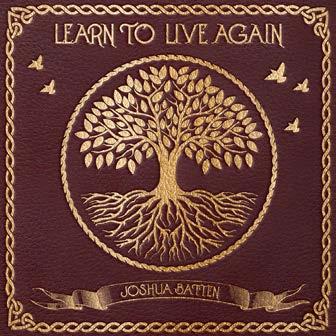
The Real World, Freya Josephine Hollick Bloodline And Maintenance, Ben Harper Out Of The Blue, Greg Lyon
Get On Board : The Songs Of Sonny Terry And Brownie McGhee, Taj Mahal & Ry Cooder Patient Number 9, Ozzy Osbourne
Only The Strong Survive, Bruce Springsteen Found Light, Laura Veirs Maybe,Then..., Dan Warner & The Night Parrots
BEST COMPILATIONS/REISSUES
Highlights & Remixes, Nina Simone Harvest, Neil Young Forever Changes, Love Revolver, The Beatles Car Tape, Lisa Miller
BEST MUSIC BOOKS
The Philosophy Of Modern Song, Bob Dylan The Art Of Jazz, Alyn Shipton Music, Robert Doisneau
BEST MUSIC FILM Moonage Daydream
BEST MUSIC DOCUMENTARIES
The Beatles: Get Back Rewind And Play, Thelonious Monk Ennio, Ennio Morricone
Creedence Clearwater Revival At The Royal Albert Hall
BEST GIGS
Marcelle, Dog’s Bar St .Kilda
The Badloves, Corner Hotel Richmond
HIGHLIGHT OF THE YEAR. Being among music lovers at live performances.
61
MUSICIANS' BEST OF
BEST FESTIVAL/GIGS
(One or two of each)
Crowded House - Rod Laver Nov 22
Sharon von Etten - December 8, Northcote Theatre
HIGHLIGHT OF THE YEAR
Playing Rave on Andy White live with Rod McVey my school friend, Hammond player, producer of all my early albums.
ROB SNARSKI
PLANS FOR 2023
My new project with Lindy Morrison (Go-Betweens), Graham Lee (Triffids) and Shane “the maestro” O’Mara has forced me to write a different type of song; I think we call it free pop. Dan Kelly has also hopped on board and we plan to record in 2023.
NICK BARKER
ANDY WHITE
THE WEEPING WILLOWS
TOP 5 ALBUMS
Warm Chris – Aldous Harding
Big Time – Angel Olsen
Plus albums that I revisited this year and played on repeat for various reasons:
Blue – Joni Mitchell
Charcoal Lane – Archie Roach
Real Gone – Tom Waits

SONG
‘All the Flowers’ – Angel Olsen
TOP 10 RECORDS OF THE YEAR
I Don’t Live Here Anymore - War on Drugs
We’ve Been Going About This All Wrong - Sharon von Etten ‘Been to the Mountain’ - Margo Price (I know it’s not an album!)
Revolver Sessions - The Beatles ‘Streamline Train’ - Van Morrison (he’s getting better!)
Big Time - Angel Olsen Dragon New Warm Mountain I Believe in You – Big Thief
The Line is Curve - Kae Tempest
Pre-pleasure - Julia Jacklin (‘coz Sebastian did the cover)
Harry’s House - Harry Styles
BEST COMPILATION REISSUES
Revolver - The Beatles ‘Love Sick’ Version 2 - Bob (as good as an album)
BEST MUSIC BOOK/S (One or two)
The Philosophy of Modern Song – Bob Dylan
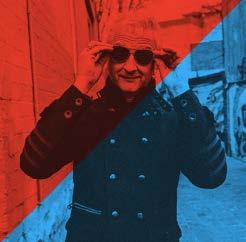
BEST MUSIC FILM/S (One or two)
Shetland - (music to my eyes DON’T TELL US WHAT HAPPENS!!!)
TOP 5 ALBUMS
(In alphabetical order)
The Liar – John Fullbright
Dark Enough to See the Stars –Mary Gauthier
Co-Starring Too – Ray Wylie Hubbard
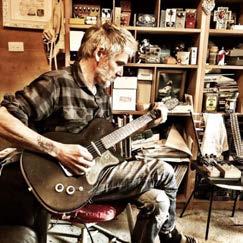
The Flowers That Bloom in Spring – Kieran Kane & Rayna Gellert
Good To Be – Keb’ Mo’
SONG
‘Paranoid Heart’ – John Fullbright
FILM
Elvis TV SHOW
Law & Order: Special Victims Unit
HIGHLIGHT
Performing shows with our heroes, Kevin Welch and Nick Charles in Australia. Showcasing at AMERICANAFEST in the USA.
PLANS FOR 2023
More UK and US touring and perhaps writing songs towards a new album.
A song of hope, thinly disguised within beauty and sadness. It’s a little reminiscent of Skeeter Davis’ ‘The End Of The World’ and has a really pretty melody.
BOOK
Nina Simone’s Gum –Warren Ellis
I’ll point out here that Warren met David McComb through playing in The Blackeyed Susans, a band we were all in together. Apart from that oversight, I really loved the book.
FILM
I kinda liked the first half of Elvis, then it lost me. The most moving moment for me was the final scene – the actual live footage from his last concert performance, singing ‘Unchained Melody’. Sad.
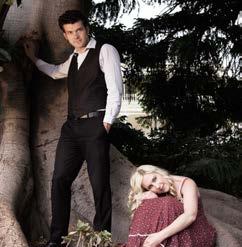
TV SHOW Fisk
HIGHLIGHT
Being able to travel and tour. From tumbleweeds blowing down empty terminals and sparrows setting up homes in forgotten pockets, plane travel returned to being a little frantic, the cause of a few anxious moments and seemingly more expensive than I remembered.
TOP ALBUMS
On the Ghostline, with Hands of Lightning – Halfway (best band in the country)
Shoot Me Your Ace – Reef (I have always liked Reef)
Cub – Wunderhorse (the single hooked me right in)
Exoskeleton – Nick Barker (I’ve had a sneak listen, it’s on point)
SONG
‘One Last F.U.’ – Lucero Back to form!
BOOK
FILM
Elvis. I was sceptical, but I learned some things, I really did.
TV SHOW
The Offer. Fascinating. Worth it for the Puzo/Coppola scenes alone.
RE-RELEASE
Toast – Neil Young
The Bloke is a nutty wonderful machine, right?
HIGHLIGHT
Playing at the Palais to 1300 people on my own (James Reyne support). Terrifying, but rewarding.
PLANS FOR 2023
New album and some band shows.
62
Journeymen by Mark Turley
GEORGIA FIELDS
RE-RELEASE
I didn’t buy any re-releases this year but was stoked to see Leah Senior’s label release a very special vinyl box set of her first three albums: Summer’s On The Ground, Pretty Faces and The Passing Scene. Leah is an exquisite artist and I love that her work is being presented in such a luxurious, deluxe format. Power to you, Leah!
HIGHLIGHT
TOP 5 ALBUMS
1. Phia - Phia
Lush, melodic, brimming with texture and lyrically vulnerable, Phia’s second album is nothing short of a masterpiece. Collaborating with ambient guitarist Joshua Teicher and 50-piece choir Melbourne Indie Voices, Phia blends understated, artful pop with breathtaking choral arrangements and the dreamy chime of her signature kalimba. There’s nothing else like it out there.
2. Amateurs – Laura Jean
3. Begin Again EP – Emily Lubitz
4. The Nightline – BATTS
5. Warm Chris – Aldous Harding
SONG
‘Mana Takatāpui’ – Jen Cloher
I heard this song for the first time listening to Triple R in the car. My kids in the back seat became instantly silent as the deep and beautiful magic of Jen’s voice settled over us. ‘Mana Takatāpui’ is infused with such generous wisdom and vulnerability. I can’t wait for Jen’s album this year.
BOOK
Wildflowers by Peggy Frew
FILM
Everything Everywhere All At Once
TV SHOW
Stranger Things, Season 4
Selfishly, I’m going to say: recording my third album, Hiraeth, with producer, drummer and multiinstrumentalist Josh Barber. Creating this album was challenging, fun, scary, hilarious, confusing and profoundly rewarding.
PLANS FOR 2023
Shows! Hiraeth was released in November 2022, so this year I’m looking forward to performing the record live and connecting with people at Real Life Gigs
ASHLEY NAYLOR
TV SHOW
The Sinner
RE-RELEASE
Jams From The Heart –Eddie Hazel
HIGHLIGHT
Playing at the Music Bowl with Hoodoo Gurus and The Dandy Warhols.
PLANS FOR
MUSICIANS' BEST OF
TOP 5 ALBUMS
A Print Out Of The Sun – L.A. Mood
Lost In The Woods – The Smallgoods
We Need To Be Free – Jodi Phillis Fire Doesn’t Grow On Trees –The Brian Jonestown Massacre
The Wait – Vika & Linda
SONG
‘Silver Stars’ – Jodi Phillis BOOK
Monkey Grip by Helen Garner
FILM
Moonage Daydream
2023
More guitar solos.

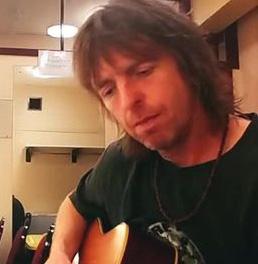
DAN WARNER
5: Everything Was Beautiful –Spiritualized ‘Crazy’ is one of my favourite songs of the year.
SONG
Old News – Ella Hooper
Courageous, honest, ambitious. A call to all us old musos to keep going (not that Ella is old!). Looking forward to the album.
BOOK
All the Rage – Paulie Stewart A huge human, a huge life, a huge heart.
TOP 5 ALBUMS
1: Seth Avett Sings Greg Brown
– Seth Avett
Hopefully, Seth Avett brings some new listeners to the songs of Greg Brown, the folk singer from Iowa. Greg has a keen eye and a keener turn of phrase, sorta like John Prine meets Buffett meets Mickey Newbury.
2: I’m Gonna Die With This Frown On My Face – Ruby Gill One of Melbourne’s top-quality young songwriters. “You make me weak at my knees, and I’ve got pretty strong knees.” Great line. Beautifully produced by Marcel Borrack and Tim Harvey.

3: Gold – Ashley Davies I was lucky enough to attend the premiere of Ash Davies’ and Danny McKenna’s short film, Gold – animations of Ash’s uncle Len Davies’ visions of Lasseter searching for that famous reef of gold. The soundtrack is an extraordinary tribute to an extraordinary man.
4: Watch My Moves – Kurt Vile When I heard Tim Thorpe play ‘Stuffed Leopard’ on Vital Bits on RRR, I knew I had to have this record. Like a lockdown Basement Tapes
FILM
It takes me a while to catch up on movies, so these two probably don’t qualify, but I enjoyed Todd Haynes’ Velvet Underground doco; and I’m a sucker for a musical – loved Spielberg’s West Side Story Vale Stephen Sondheim.
TV SHOW
Series 2 of Austrian/German crime drama Der Pass
Gedeon Winter is an intriguing character – brutally human. Series 2 even better than Series 1.
RE-RELEASE
I’m Gonna Sing: The Mother’s Best Gospel Radio Recordings –Hank Williams
I Saw the Light, indeed. Hope Hank found some relief, wherever he went.
HIGHLIGHT
Finally getting a new record out.
PLANS FOR 2023
The Night Parrots and I are launching Maybe, then at Memo in March. Then, hopefully, lots more gigs!
63
The remarkable resurrection of the great lost record of the ’70s.
By Jeff Jenkins
So I went around to his place. He had two strange women hanging out with him and the heating turned up to 35 degrees, because he was from California. I played him the tape and he got on the phone that night to CBS in New York: “I’ve found the next Beatles, give me some studio time.” Instead of doing three or four demos, he said, “We’re going to be here all night and you’re going to put down 10 tracks.”
He then took that tape and hawked it around London, getting interest from Elton’s new label [Rocket] and Warners. And Warners took out the cheque book and we got a deal. And that’s how I met Lou.
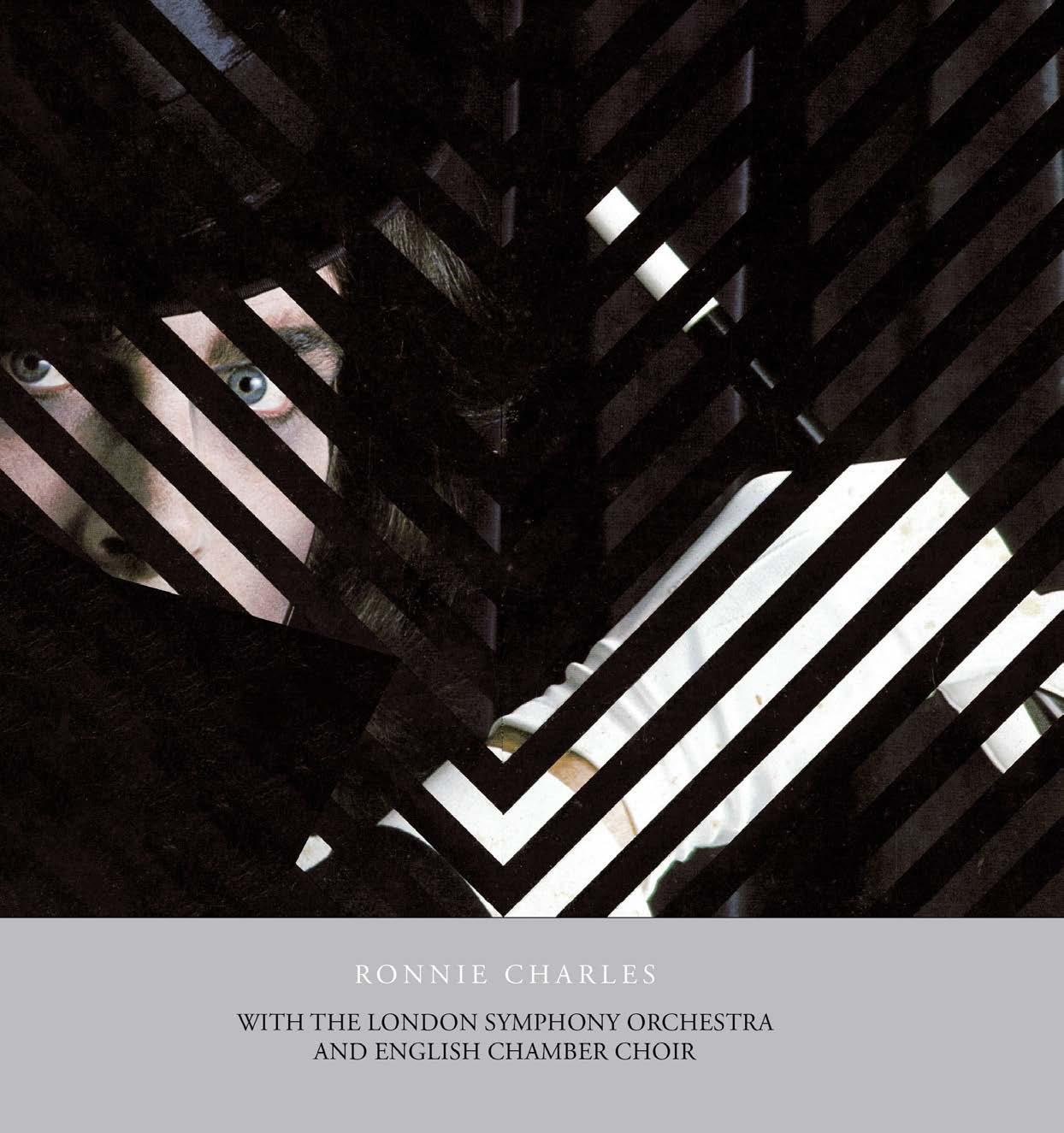
Lou Reizner was an American producer and recording executive who relocated to London in the ’60s. He produced Rod Stewart’s first two solo albums, as well as the orchestrated version of The Who’s Tommy.
What was Lou like?
Ronnie Charles
Rick Springfield says, “It’s the greatest album no one’s ever heard of.” At the time, it was the most expensive album ever produced in the UK. And then it sank without a trace. This is the strange tale of Prestidigitation, the debut solo album for Australia’s Ronnie Charles, produced by Lou Reizner and featuring the London Symphony Orchestra and the 80-voice English Chamber Choir.
Charles had been the lead singer of Melbourne band The Groop, who released one of the great ’60s singles, ‘Woman You’re Breaking Me’, and relocated to London after winning the Hoadley’s Battle of the Sounds.

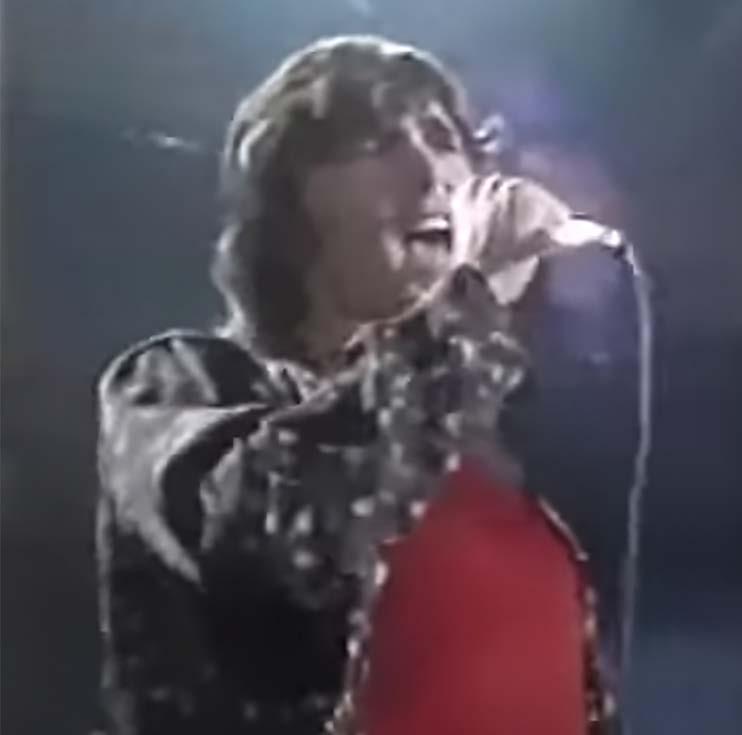
Charles realised that if he was serious about making it in the music business, the UK was where he needed to be.
This story really starts in London when Charles had a chance encounter with American impresario Kim Fowley, “the Duke of Dreams”, who also called himself
“the missing link between Chuck Berry and Orson Welles”, as well as “a piece of shit, moron, genius and rock and roll outlaw”. Fowley created The Runaways, co-wrote The Seekers’ ‘Emerald City’, and worked with Kiss, Helen Reddy and Alice Cooper.
How did you meet Kim Fowley?
It was fairytale stuff. I was standing at the bar after a gig at The Pheasantry and he came up and said, “I really like your singing, man … I hear you’re Australian. I’ve just been doing some PR for Daddy Cool in LA.” (Fowley greeted the band in a wheelchair at LA Airport. He rolled through the crowd, yelling, “I’ve got to speak to Daddy Cool!” He then leapt from the chair, screaming, “I can walk! Daddy Cool cured me!”)
I told him about my band, Atlas. Don Arden [legendary manager and father of Sharon Osbourne] had given us some demo time, but it was so hard getting a record deal in London in 1972. “Give me a tape,” Kim said.
He was the old-style producer. He’d sit in the chair and he had the right engineer and the right arranger. He and Shel Talmy were two young American producers who went to London post-Beatlemania because they wanted to be where the action was. Shel kept kicking goals [producing The Who, The Kinks and The Easybeats] and there was a healthy rivalry between the two. Lou was like a young Phil Spector, he loved the extravaganza, which is why I think he took on the Tommy thing.
64
With Atlas, I wanted to get an American producer, because most of the English producers were like Mickie Most, producing singles, whereas we were very much an album band.
After producing Atlas’s self-titled debut, Reizner got Charles a role in the 1973 London production of Tommy, replacing Richie Havens as “The Hawker”, as well as being the understudy to Roger Daltrey. What’s your main memory of Tommy?
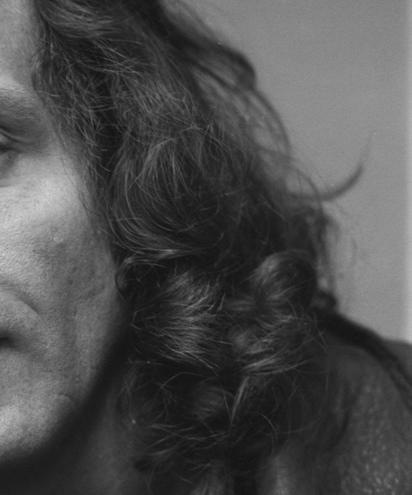
How crazy Keith Moon was! He was playing frisbee with plates in the dressing room. He and Viv Stanshall from the Bonzo Dog DooDah Band were completely insane. Merry Clayton was a fabulous singer. And I was in awe of Richie Havens. Rehearsing with him, doing the same song and getting a pat on the back from him was very encouraging.
doing ‘Layla’ with the London Symphony, and I think he wanted Eric to sing it. But when that didn’t happen, Lou still wanted to do it, so he got me.
Eric actually came to the studio and he said, “You’ve done a great job, I don’t think I could have done it again.” Because the song is quite high.
After releasing two singles in the UK – ‘Layla’ and a cover of Free’s ‘Wishing Well’ – Reizner got Charles a deal with 20th Century Records, the music arm of the movie studio 20th Century Fox. The label was run by an American, Russ Regan, who had been Sonny Bono’s original singing partner, in a band called the Checkmates.
Lou wanted to do something like a Bowie album, a concept album. But when ‘Layla’ got the attention it did, he changed tack, and 20th Century said, “We’ll put the money in, but we want to hear covers of hit songs.” So the whole thing got a little shuffled up.
The album was initially quite English-centric, but 20th Century wanted to put some current American stuff on there, so we did a version of ‘Drift Away’ (which you can find on YouTube) and a Barry Mann song, ‘Nobody But You’. I didn’t want them on there. As Kim Fowley said when he heard the album, “You know, it’s good, but it sounds like someone dropped the masters on the way and they put the elephant’s ears where the trunk should be and the trunk where the ears should be.” And I’ve always agreed with that.
booked for the session; they had no idea it was my record.
After the success of Tommy, Lou Reizner and Pete Townshend had an idea – an orchestrated version of Derek and the Dominos’ ‘Layla’ Eric Clapton was in a bad place at the time, with a heroin addiction. Pete did a show in London with Eric, to get him back on stage. I think Pete was the instigator of the idea of

The album also includes a cover of Thunderclap Newman’s ‘Something In The Air’, featuring the song’s original singer and writer, John “Speedy” Keen.
Lou came up with that – he wanted to have a big name on the record. And that was great. Speedy was a character. He and Pete Townshend were best mates; he was like a blond version of Pete. A big drinker. When he showed up at the session, I could distinctly smell rum on his breath. But it was great doing that song with him and I really like that version.
And Pete Townshend plays the guitar solo on ‘Love Reign O’er Me’. For some reason, he was never credited. But that’s his solo.
As well as Speedy Keen and Pete Townshend, the album features some great players, including Keith Tippett (King Crimson), Blue Mink’s Herbie Flowers, Ronnie Verrell (who provided the drumming for Animal on The Muppet Show), and a couple of Aussies, Kevin Peek (who later joined Sky) and Terry Britten (The Twilights).

The Groop and The Twilights had a healthy competitive rivalry – we used to duel it out at Opus on Sunday nights in the ’60s. I walked in when Terry and Kevin were doing ‘Something In The Air’. They were sitting on two high stools. I said, “G’day mate!” And they nearly fell off their stools. They had just been
A few months after Prestidigitation was released, Ronnie Charles went to the US to source material for a follow-up. Reizner was meant to join him, but unbeknownst to Charles, Reizner had stomach cancer and he died in 1977, aged 43.
You’ve now tweaked a couple of things, removing ‘Drift Away’ and ‘Nobody But You’, and adding a live track from Tommy (‘Eyesight To The Blind’).
That was recorded by Radio 2 and I thought it was good to include it because it was part of the whole story. The album is now closer to what we were originally aiming for. But I don’t regret anything. To quote Game of Thrones, you’re exactly where you’re supposed to be. At 74, I’m still here, so I must have done something right.
Did the album get an Australian release?
It did, about two years later. A dreadful pressing on cheap vinyl and cheap Aussie cardboard. And it was smack-bang in the middle of disco and punk. I wasn’t here, I knew nothing about it.
Then, a few years ago, the Coodabeen Champions called me out of the blue. “What’s this album you did in London? We wanna do an interview with you on the radio.” A couple of people suggested re-releasing it, and then [Zoot’s manager] Bruce Hutchins came along and suggested doing a vinyl release.
How do you feel about Prestidigitation 47 years after it was released?
I’m glad we’ve done it [reissued the record]. It was the biggest thing I ever did. I don’t have any expectations. But it’s good for some collectors and nice to see it recognised in some way.
To me, this album is like a Tubular Bells It’s part of the Lou Reizner story, one of the missing links in his story. It’s a Lou Reizner album as much as it’s mine.
Prestidigitation is out now on Vinyl Revival.
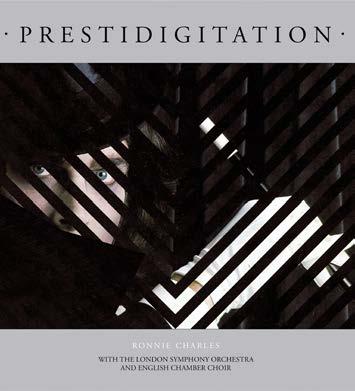
65
Lou Reizner
Ronnie Charles with Eric Clapton

CENTS
As the year 1973 dawned, legendary graphic designer, the late Ian ‘Macca’ McCausland had fulfilled his brief for a Rolling Stones Australian tour poster. And the Stones loved it! The iconic image of a jet airplane winging its way into the open lips and massive tongue of the famous Rolling Stones logo over a stylised relief map of Australia captured the sense of the tour’s importance with absolute perfection.
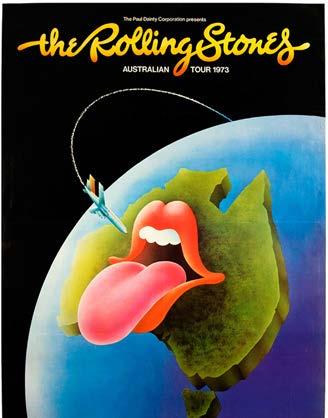

Promoter Paul Dainty, the Stones’ manager Peter Rudge and their concert production manager Chip Monck immediately asked Macca to do one for the New Zealand leg of the tour. As the Australian tour progressed, Keith Richards invited Macca to spend the afternoon with him in the inner sanctum at the Hyatt Kingsgate Hotel (Kings Cross). One can only imagine the conversation that afternoon although, as Macca has commented, Keith’s helpful piece of advice was “rub it on your gums...”.
By Ian McFarlane


Before we get into the details of the Australian tour, it’s worth noting that Macca’s poster design remains one of the most important and enduring visual elements of the whole story. Macca didn’t create the Stones’ tongue logo for the Australian tour poster (as has sometimes been suggested) but his great skill was incorporating it into the overall design. Trying to get hold of an original poster now is next to impossible, but when they do come on to the market expect to pay top dollar. The tour poster for the New Zealand leg depicted a curious kiwi bird poking its long beak at the tongue logo on the ground.
The Australian tour poster was originally folded and slipped inside the concert programme. There are stories of multiple copies of said poster having been

discarded after the Kooyong concert and filling up the gutters along Glenferrie Road. If you were lucky, you got hold of an unfolded poster. Radio stations such as 3XY in Melbourne and 6KY in Perth had been supplied with a limited number of unfolded posters, on which they overprinted their station logos on the bottom left-hand side. I’ve written before that these unfolded posters were handed over at a record shop when you bought a Stones album but have found that they were available free (plus car stickers) from Walsh’s Jeans Dungeon, on the corner of Swanston and Bourke streets in the Melbourne CBD. Just how many of these posters (folded or unfolded) still exist is impossible to determine. >>>
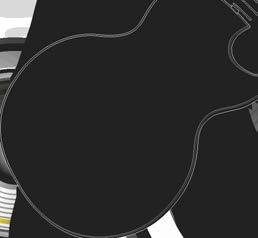
67
In celebration of the 50th Anniversary of The Rolling Stones’ February 1973 Australian Tour, it’s time to ‘Get Yer Ya-Ya’s Out!’, to get your ‘Rocks Off!’ and ‘Rip This Joint!’
67
Ian McCausland Tour Poster 1973. Courtesy of the McCausland Family
>>> As Macca explained in Under The Covers The Music Graphics of Ian McCausland, Graeme Webber & Steve Malpass by Ed. Nimmervoll (1998):
“Ron Blackmore, who was an old mate – he was Bobby and Laurie’s manager and the Rondells’ manager – was working for Paul Dainty. He made the initial contact with me, and I went to see Dainty. They asked me to come up with an idea for a poster for The Rolling Stones’ tour of Australia.

“I did a colour rough of the idea and met with The Rolling Stones’ manager, Peter Rudge, and Chip Monck (the announcer on the Woodstock stage). Chip was designing the staging for the Stones’ tour. Everybody loved my idea, so I went ahead with the final airbrush illustration. I was halfway through that when they asked me to do one for New Zealand too.
“I met the Stones at the reception at Montsalvat when they arrived in Melbourne at the start of the tour. After the concert at Kooyong, Keith Richards invited me to come to Sydney with them. They had the top three floors of the Hyatt Kingsgate Hotel in Kings Cross. There was one spot near the hotel in William Street where there must have been 200 of the tour posters in a line along this curved wall. That just blew me out. It really did. I spent the whole afternoon with Keith... which was very interesting... and listened to Mick Taylor jamming with various people. The level at which the Stones toured was amazing. Everything was laid on. It was all highly organised. Mick Jagger was also very friendly and charismatic.”
THE ROLLING STONES ON TOUR, FEBRUARY 1973
The Rolling Stones’ 26-member entourage flew into Sydney, Australia, on the 8th of February, 1973. There were 10 tonnes of equipment, handled by the road crew, and with the addition of an extra 16 people, mostly Bob Jones security guards, the tour was underway.
The main entourage included: Mick Jagger (vocals, harmonica), Keith Richards (guitar, vocals), Charlie Watts (drums), Bill Wyman (bass guitar), Mick Taylor (guitar),
Nicky Hopkins (piano), Bobby Keys (sax, percussion), Jim Price (trumpet, trombone), Ian Stewart (stage manager), Peter Rudge (band manager and tour commander), Leslie ‘Lunchtime’ Perrin (public relations manager), Leroy Leonard (Mick Jagger’s personal bodyguard), Chip Monck (stage / lighting designer and announcer), Patrick Stansfield (production manager), Anna Menzies (assistant) and Alan Dunn (assistant).
In conjunction with Rudge, promoter Paul Dainty had put together nine concerts across Australia (plus one in New Zealand). Local tour supports were Madder Lake and Chain (Melbourne), Headband (Sydney), Pulse (Adelaide) and Fatty Lumpkin (Perth) – plus I’Tambu in Auckland.
This was the third time the Stones had toured Australia. In January 1965 Roy Orbison, The Rolling Stones and Dionne Warwick played to appreciative crowds, with an astonishing nine concerts sold out for the Palais Theatre in Melbourne alone. It was also the era when authority figures still looked down upon the unruly, unkempt Stones with disdain. As the band’s manager, Andrew Loog Oldham, commented at the time, “We’ve been knocked by the Australian newspapers who keep trying to dig up scandal stories and run banner headlines about the Rolling Stones having all night parties. I wish we were!”
They followed that up with The Rolling Stones-The Searchers joint tour of February 1966. It’s not my purposes here to give a full Stones touring history, but it is worth noting that by the time 1973 rolled around they were hailed as the “greatest rock ’n’ roll band in the world”. The years 1969 to 1973 can rightly be considered the most glorious, the most explosive (and in some cases, the most tragic) era in the band’s history.
Original guitarist Brian Jones had died in mysterious circumstances on 3 July 1969. Two days later the Stones staged their free outdoor concert in London’s Hyde Park, in front of an estimated audience of somewhere between 250,000-300,000 fans. It had been planned as a launch for the band’s new guitarist, Mick Taylor, but Jones’ death cast a different light on proceedings. Jagger read out two stanzas from Percy Bysshe Shelley’s poem Adonaïs as a tribute to Jones, and then released several hundred white butterflies.
Sadly, the decade ended more tragically for the Stones, with the infamous Altamont Free Concert on 6 December, during which the Hells Angels stabbed to death young African American Meredith Hunter. The Maysles brothers captured the events in their tense documentary Gimme Shelter (1970).
On a much brighter note, the Stones had just come off an unparalleled run of five classic albums – Beggars Banquet (November 1968), Let It Bleed (November 1969), Get Yer Ya-Ya’s Out! (September 1970), Sticky Fingers (April
1971) and Exile On Main St (May 1972) – and had already completed their next, Goats Head Soup (released August 1973). Furthermore, they were playing at the top of their game, having recently completed their boisterous and notorious (for its rock ’n’ roll excess)
American Tour 1972 (aka Stones Touring Party S.T.P.) in support of Exile On Main St.
Two films had come off the back of that tour. The concert film Ladies and Gentlemen: The Rolling Stones by Rollin Binzer only saw a limited theatrical release in 1974. It got an Australian VHS release in the early 1980s and has since come out on DVD. It’s a brilliant depiction of the Stones in their prime, being a tightly shot concert film sans unnecessary commentary.
Secondly, Robert Frank’s Cocksucker Blues was a documentary shot in cinéma-vérité style. The Stones weren’t impressed, and they placed a court order which forbade the

68
film from being shown other than in very restricted circumstances; i.e. only to be shown once a year with the director present in person. The film has since surfaced online in various bootlegged versions of varying quality.
Following the US tour, and as they were recording the new album, events took a turn which could have derailed the planned Pacific tour. It’s worth rolling out here the relevant dates and events covering November 1972 to February 1973.
THE ROLLING STONES AUSTRALIAN TOUR
(aka PACIFIC TOUR) 1973 - A CHRONOLOGY

(sourced from The Rolling Stones Chronicles: The First Thirty Years, 1990)
1972
25th November - The Rolling Stones arrive in Kingston, Jamaica for four weeks’ recording sessions at the Dynamic Sound Studios.
30th - Mick Jagger, Keith Richards and Mick Taylor fly to Los Angeles to plan their forthcoming Pacific tour.
2nd December - Warrants are issued in Nice against Keith Richards and Anita Pallenberg for drug offences.
4th - The other Stones fly to Nice to clarify matters relating to the alleged drug violations, both at Keith’s house in
Villefranche-sur-Mer and aboard his yacht Mandrax. They return to Jamaica to continue work on the new album.
12th - The Stones may be forced to cancel their record-breaking Japanese tour (55,000 seats sold in five hours) due to the drug problems with the French police.
22nd - The Stones’ tour manager Peter Rudge returns to London after a 35,000 miles journey negotiating and finalising details for the Pacific tour with both governments and promoters.
23rd - An earthquake devastates Managua, Nicaragua, home of Bianca Jagger’s parents.
26th - Mick and Bianca leave London enroute for Nicaragua to search for her parents and relatives.
31st - In Managua Bianca is safely reunited with her parents
1973
4th January - One of the Stones is reported to have been refused entry to Australia. Neither name nor reason is given.
8th - Mick Jagger is banned from entering Japan because of his drug conviction six years earlier.
9th - Al Grassby, Minister for Immigration in the Whitlam Labor government, announces that there is no longer any ban on the entry of any member of The Rolling Stones.
10th - US magazine Billboard votes The Rolling Stones the Best Band of 1972. Mick Jagger announces his plan to give a benefit concert for Nicaraguan earthquake victims.
11th - It’s confirmed that the Stones’ Japanese tour has been cancelled.
14th - They are in Los Angeles rehearsing for their Pacific tour.
18th - They play the Nicaraguan benefit concert at The Forum, Inglewood California. They raise $516,810 and are presented with a commemorative plaque by the Nicaraguan Ambassador.
20th - They fly to Honolulu.
21st/22nd - They start their Pacific tour with three shows at the International Sports Centre, Honolulu.
23rd - They return to Los Angeles
5th February - They play two shows at the Football Stadium in Hong Kong
8th - They arrive in Sydney.
9th - They hold a press conference in Sydney.
10th - They fly to Auckland, New Zealand
11th - Concert at Western Springs Stadium, Auckland.
13th - First Australian concert at the Milton Park Tennis Courts, Brisbane.
14th - Second concert at Milton Park.
16th - Press conference at the artists’ colony Montsalvat, Eltham, Victoria.
17th - They play two concerts at the Kooyong Tennis Courts, Melbourne.
18th - Third Melbourne concert at Kooyong. 20th - Concert at Memorial Drive, Adelaide.
21st - Second concert at Memorial Drive.
24th - Concert at the Western Australia Cricket Ground (WACA), Perth.
26th/27th - They wind up their Australian tour with two concerts at the Royal Randwick Racecourse, Sydney.
28th - The Stones leave Australia, going their separate ways on holiday. Bill Wyman flies to the States, Charlie Watts to France. Keith Richards to Jamaica, Mick Taylor to Indonesia and Mick Jagger to the States via Jamaica.
Rock ’n’ roll tours of Australia had been a fixture on the musical landscape since the time of Lee Gordon’s Big Shows of the late 1950s. Once again, it’s not in my purposes here to give a history of that, but let’s consider this; since May 1971 Australian rock fans had been treated to the following: Deep Purple-Free-Manfred Mann Chapter Three (May 1971); The Kinks (May 1971); Pink Floyd (August 1971); Elton John (October 1971); Led Zeppelin (February 1972); John Mayall (March 1972); Chicago (June 1972); Jethro Tull (July 1972); Cat Stevens (August 1972); Joe Cocker (October 1972); Black Sabbath (January 1973); and Slade-Status QuoCaravan-Lindisfarne (January 1973).
Promoter Paul Dainty had toured Roy Orbison, Cat Stevens and The Kinks but with the success of the Stones tour it launched him and his company on to greater heights. Writer Stuart Coupe discussed this in his book The Promoters (Inside Stories From The Australian Rock Industry) (2003). He described the Stones tour as “the tour that really established Dainty’s name and gave him the stamp of credibility that he’s maintained for nearly thirty years”.
Dainty had initially got a call from Peter Rudge in his agency’s London office; Cat Stevens’ manager had told Rudge how well his Australian tour had gone. Rudge came to the office and after a night of talking and drinking said, “Right, you’ve got the tour”. Dainty had to go to the ANZ bank in London and get a loan in order to finance the tour. He secured the £100,000 he needed as a deposit for the tour. >>>
69
>>> Coupe wrote, “The 1973 Rolling Stones tour, still one of the most memorable visits by a band to this country, made Dainty a lot of money – and became his calling card forever. The tour was not without its incidents. I tell Dainty that Keith Richards doesn’t remember any of the concert at Randwick Racecourse in Sydney because someone spiked his and saxophonist Bobby Keys’ drink with LSD and the effects kicked in just as they headed towards the stage.” Dainty built a strong relationship with the Stones, going on to promote their Voodoo Lounge (April 1995) and Licks (February 2003) Australian tours.
(Keith Richards)
With such a high-profile tour in progress, it was inevitable that the band came under a lot of attention and scrutiny. A crew from the ABC-TV’s rock show Get To Know (GTK) followed the tour, day and night. Reporter Jeune Pritchard basically had unlimited access. As well as going to the press conferences and concerts, Pritchard established an excellent rapport with the musicians and interviewed Jagger and Richards face-to-face. The subsequent ABC-TV documentary, The Rolling Stones In Australia, narrated by Pritchard, gave an incredible insight into how a rock ’n’ roll tour should be run. The documentary is readily available to view on-line.
The interviews were filmed at the Montsalvat press conference, and the concert footage was from Kooyong. At the start, as Pritchard describes how the Stones are on their way to Kooyong for their first Melbourne concert a grinning Jagger says, “Hello Jeune, how are ya luv, awright? See ya after.” In fact, Jagger conducts himself with the utmost professionalism throughout.
Pritchard’s commentary aimed at various members is both pertinent and amusing. She says:
“Michael Philip Jagger, leader of The Rolling Stones for 10 years. He’s on his way to another Australian concert. He’s feeling the strain of performing in extreme heat in open air venues. But the tour is going well.
The Stones have been living up to their reputation as the Greatest Rock & Roll group. The only disappointments have been for the press, no hotel sieges, no mass hysteria and no major scandals. On the Australian tour the music was to be more important than the headlines.”
“Keith Richards, guitarist and songwriter, maybe the creative genius within the group, a ‘Deadly Nightshade’, who won’t live to 70.”

“Mick Taylor, guitarist, he’s into the music more than the performance. Jagger treats him gently for he seems rather fragile.”
“Charlie Watts, drummer, audiences seem to identify closely with him, he seems the most approachable but is easily bored. At press conferences he relates more to his glass of Blue Nunn.”
“Bill Wyman, bass man.”
“Peter Rudge, The Rolling Stones’ manager, the tour commander, the ringmaster, he has complete authority which usually goes unchallenged.”
“Leroy Leonard, Mick’s personal bodyguard, he’s always on stage and gathers the clothes and jewels that Mick discards.”
Pritchard asks Richards: “What are your feelings in a radical way or a sexual way? You’ve never really gotten into a lot of political stuff. The Stones usually have sexually based songs.”
He replies: “Yeah, well, I’ve always felt more sexual than political. I could never get that worked up about Edward Heath, you know. It’s just whatever reaches you first.”
Pritchard says that the Australian mainstream press tried very hard to find a sensational angle with the headlines. Two ounces of a grass-like substance was found in the charter plane carrying the Stones equipment to Brisbane, but there was no direct link with the band and the issue was dropped (seems that one of the road crew may have taken the rap). In Adelaide, fans were arrested when a crowd of 4,000 tried to storm one of the concerts, but there really was no big news to be manufactured.
The only hiccup occurred in Sydney when unscrupulous individuals forged 200 tickets, selling them for $5.50 (30¢ above the official price of $5.20). There were some last desperate headlines in the broadsheets –“Forgeries Check: Fraud Squad at Stones Concert” and “Scalpers trick Stones fans$4,000 goes in Forged Ticket Scandal” – but that was it.
And with no scandals regarding hysterical groupies clambering for the Stones’ attention, many were left scratching their heads. When Pritchard asked fans outside the Kooyong concert, the response was: “Nah, I wasn’t interested in going out to the airport for their arrival, I’m just interested in their music.”
“No one’s interested in that anymore. I think we’re growing out of that sort of thing. That was back in The Beatles days. People don’t do that anymore, they come to hear their music.”
“Nah, too much bother.”
“I think most people come for the music. That’s what I came for.”
At the press conferences, a couple of reporters attempted to ensnare the Stones. It highlights the rather parochial attitude still prevalent in Australia at the time. The musicians took it in their stride, being firm with their responses and with relatively good humour.
Sydney reporter: “With respect (sic), you look like the Wreck of the Hesperus with the kind of gear you’re wearing...”
Mick Jagger: “The Hesperus! Is that mythological?”
Reporter: “No, it’s not mythological. You look very different from what we expect people to look like. Is this the way you like to dress?”
Keith Richards: “That’s because you live down here and I live somewhere else.”
(Jagger lets out a huge guffaw and grins madly.)
Reporter: “That may be so but is there any reason? Why do you like to dress like you do?”
KR: “Probably the very same reason you like to dress the way you do.”
Keith Richards at Montsalvat
“I’VE ALWAYS FELT MORE SEXUAL THAN POLITICAL.”
70
Reporter: “Which is what?”
KR: “Don’t tell me your reason for dressing the way you do.”
Reporter: “That effeminate gear that you’ve got on? I’m not trying to be offensive, I’m just asking why you look like you do?”
KR: “Then don’t be offensive.”
Reporter: “I’m not intending to be offensive.”
KR: “Then you’re doing it very well.”
MJ: “That’s alright, we just dressed up like this for you today.”
There’s a discussion about letting bands into the country in order to tour.
MJ: “I think that’s to do with the previous government.”
KR: “Australia doesn’t have a very good reputation as far as bands are concerned, as far as hospitality. You’re known as the most inhospitable country.”
MJ: “Well, not the people, we’re just talking about officials.”
KR: “We’re not here to take over the country, or the world, or anything like that, man. We’re just rock ’n’ roll musicians.”
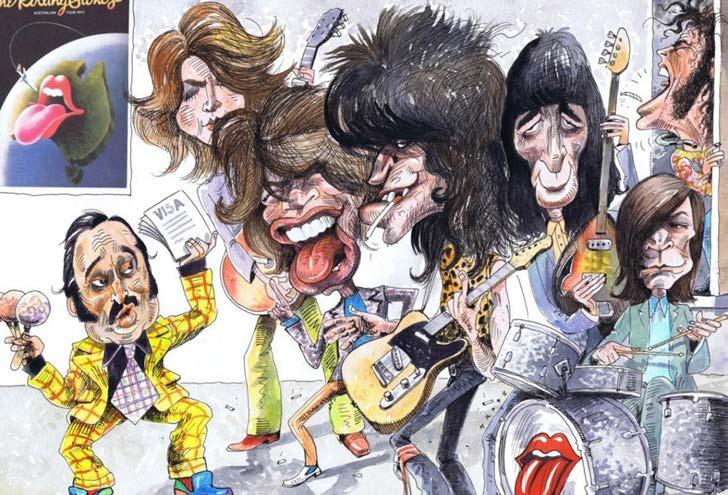
MJ: “I think the mafia would find it easier to get in here than we would.”
MJ: “Yeah well, ask him, phone him up and ask him.”
Reporter: “He defended you very strongly, he came out very much in your favour. What do you think of him?”
MJ: “Well, one thing he wanted to put across was that Australia was part of Southeast Asia, which was very admirable, I thought. After years of isolation. The only way I can see that happening is more Southeast Asians coming here. It’s very difficult to be part of SEA if you don’t understand that mentality. He was very nice.”
(Al Grassby had said, “The Rolling Stones are an excellent example to Australian Youth. I told them I was putting my faith in them and that they would do the right thing. I have no regrets that I let them in. Yes, I went out on a limb to give them visas. To give a man a bad name and hang him is immoral and unAustralian.”)

The reporter asks something else which is inaudible and at this point Jagger loses his cool, pointing his finger as he says, “Then if you start on that story, that’s why we can be rude to you because you’re starting on that. If you want to follow up with that TV journalism rubbish, then you’re pretty low. So, watch out boy!”
Music writer Jen Jewel Brown was at the Montsalvat press conference, in her role (known then as Jenny Brown) reporting for The Digger. It was her 21st birthday and she plucked up the courage to invite the Stones to her party that night in the leafy eastern suburb of North Balwyn. Unexpectedly, at 3am, Richards, Taylor and Keys arrived in a limo and stayed at the party for about an hour and a half. As Brown explained to Tony Wilson in The Best Music Writing Under The
Australian Sun (edited by Christian Ryan, 2014), “They blessed me with their royal presence.”
In Wilson’s chapter of the book, ‘Keith’s Melbourne Wife: In quest of a woman in a paragraph’, he draws our attention to said paragraph in Richards’ book Life (2010). Richards writes that he met a woman, “She had a baby. Sweet, shy, unassuming, she was on the scuppers; the old man had left her with the kid.” She could also get him pharmaceutical cocaine, and rather than waiting for her to arrive at the hotel, he explains that he simply moved in with her. “Living in the suburbs of Melbourne for a week with a mother and child was kind of weird. Within four or five days I was like a right Australian old man.” He says he took care of the baby while she went to work, even changed his diapers; “There’s somebody in a suburb in Melbourne who doesn’t even know I wiped his ass.”
How Richards fitted that week in, given the tightness of their Melbourne stay, is dubious. As Wilson writes, “Still, a bit of mystery makes this story folklore, and Keith is the master of folklore.” He was inspired to go on a quest to find the woman. With Jen’s help he does find her, Karen, who it turns out was at Jen’s 21st birthday party that night. To cut a long story short, Karen met Keith there, Keith asked if she could get cocaine (which she could), he invited her back to the hotel, she got the cocaine from her dealer (about “five thousand dollars worth”) and attended all three of the Kooyong shows. >>>
At Montsalvat, a Melbourne reporter was put in his place when he said: “There is a story going round that someone tried to smuggle some pot into the country, is that right?”
MJ: “Who did?”
KR: “What kind of pot?”
MJ: “I don’t understand the question.”
Reporter: “You don’t understand the question? It’s not true then?”
MJ: “I don’t understand the question.”
Reporter: “I thought the question was quite plain enough.”
MJ: “No, I’m very sorry sir, there was no one trying to smuggle pot into the country. Phone up anybody.”
Reporter: “Mr Grassby, our immigration minister...”
71
Al Grassby and The Rolling Stones by Chris Grosz
>>> So, Keith’s ‘week in the suburbs’ was more like a long weekend, then. He did, however, take a limo ride out to Karen’s house in South Caulfield. He’d brought along his guitar and also played with her son, Shannon, but as Karen told Wilson, “I didn’t leave Keith in charge of my son!” and “He changed his nappy once. It was just a wet one. Not poopy.” Shannon’s father was Barry ‘Big Goose’ Sullivan, legendary bass player with Chain who also supported the Stones. Keith’s last words to Karen were, “Lady, you’ve got soul.”
Go-Set reporter Ian ‘Molly’ Meldrum followed the tour and had much to write. The cover for the 3 March issue featured the headline AT LAST! THE GREATEST SHOW ON EARTH! and a close-up live shot of Jagger, with tongue poking out (taken by photographer Richard Crawley). In his usual hyperactive, non-sequitur strewn prose Meldrum let everyone know how much he enjoyed the concerts. He asked Jagger, “Have you been surprised by the audience reaction in this country?”. The singer replied, “Yeah, it’s been really nice. Actually, it was a total surprise to me. A lot of things have changed in this country over the last two or three years.”
After the conclusion of the last Sydney show, Meldrum wrote, “We have over the past three weeks witnessed the performances of the GREATEST ROCK AND ROLL BAND IN THE WORLD... and I openly admit that when the STONES swung into STREET FIGHTING MAN at the second and final SYDNEY RANDWICK CONCERT I really had to fight back the odd tear of two... it’s been a magnificent tour in every sense of the word.”
David N. Pepperell, writing in Go-Set, focused on Melbourne support band Madder Lake, “They impressed just about everybody at the Rolling Stones concerts. It was an enormously difficult task to open a show featuring the Greatest Rock Band in the world and they certainly gave their all, as usual, to the crowd. Their sound and presentation were first class and caused Peter Rudge, the Stones’ tour manager, to remark on what a fine band they were. The raving ‘12lb Toothbrush’ had the audience rocking and excited, and ‘Goodbye Lollipop’ had even the die-hards tapping their feet. Mick Fettes was a thoroughly pleasing lead singer, sometimes humorous, sometimes screaming and rasping, sometimes just rapt in the music and completely oblivious to anything else. Brenden overcame the problem of a leg injury magnificently and played with extreme taste – I especially liked his use of wah wah and feedback effects.”
YOU FOR BEING SO SWEET”
(Mick Jagger)
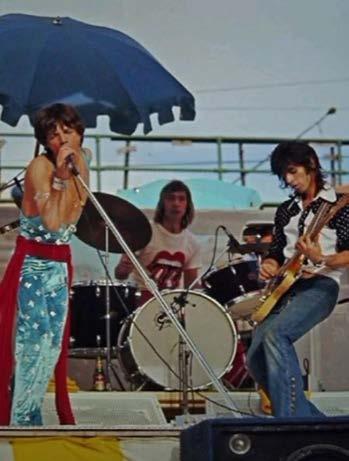
So, what about the actual concerts? Even before we mention the music, the first thing to note is that the Stones looked magnificent, Jagger and Richards in particular presenting as the height of gypsy chic, all draped scarves and shining jewellery. Mostly they played the regular 15-song set list, kicking off with a blistering version of ‘Brown Sugar’. It’s been noted elsewhere that they weren’t slick, they’ve never been that type of band but the musical communication between the members was sheer perfection throughout.
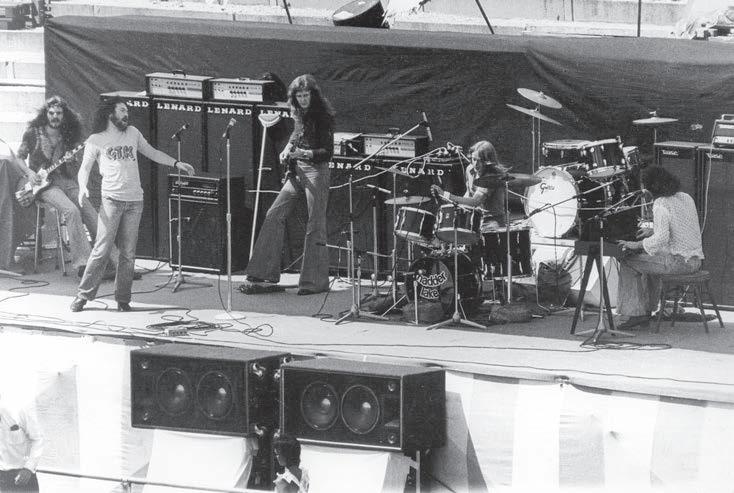
Melbourne set list:
‘Brown Sugar’
‘Bitch’
‘Rocks Off’
‘Gimme Shelter’
‘Happy’
‘Tumbling Dice’
‘Love In Vain’
‘Sweet Virginia’
‘You Can’t Always Get What You Want’
‘Honky Tonk Women’
‘All Down The Line’
‘Midnight Rambler’
‘Bye Bye Johnny’
‘Jumpin’ Jack Flash’
‘Street Fighting Man’
Adelaide got ‘Little Queenie’ in place of ‘Bye Bye Johnny’, as did Perth and Sydney which the Stones then followed with ‘Rip This Joint’ making for a 16-song set.
The Saturday Kooyong shows were notable for being on a sweltering hot Melbourne day, over 35° C. There was a huge canopy over the stage, to shield them from the sun’s relentless rays. Jagger pranced onto the stage with a parasol, which he soon discarded, while Watts got his own beach umbrella. Jagger’s bodyguard, Leroy Leonard, stayed on stage in the heat, clapping the whole time.
Jagger wore a fetching blue velvet jump suit with a long red scarf wrapped around his impossibly thin hips. He strutted, he pouted, he jumped, he waved, he waggled his finger, never remaining still, and all the while he was splendid. During ‘Midnight Rambler’, he ripped the belt out of his jump suit, dropped to his knees and while screaming “Did you hear about the midnight rambler!” hit the stage three times with said belt. The crowd went wild.
And going by the available footage Richards really did prowl around the stage like the
“THANK
1.
2.
3.
4.
5.
6.
7.
8.
9.
10.
11.
12.
13.
14.
15.
72
Madder Lake. Courtesy of Bruce Thomas.
swash-buckling rock ’n’ roll pirate he’s always been. Meanwhile Taylor, Wyman, Watts, Keys, Hopkins and Price clicked the whole machine into place.
As front man, Jagger’s demeanour was impeccable even if his stage patter was well drilled. Generally, he did band introductions before ‘Bye Bye Johnny’. At the afternoon Kooyong show he said, “Thank you! I’d like to just tell you you’ve really been a good crowd this afternoon, you’re really acting great in this heat. I’d like to tell you who’s playing with us this afternoon. On piano we’ve got Nicky Hopkins (applause). On trumpet and trombone Jim Price (applause) on saxophone, and surprisingly sober, Mr Bobby Keys (applause). On guitar Mick Taylor (applause), ain’t he sweet? What else we got? (All the while the musicians were tuning their guitars, with strings having loosened in the heat.) We got... we gotta tune up don’t we. On drums we got Charlie Watts (applause). All he needs is an elephant, someone to brush the flies off ’im. Sorry, no flies on Charlie. On bass we got Bill Wyman (applause). And we got Keith Richards an’ all! (Loud applause).”
As ‘Street Fighting Man’ ended Jagger signed off with, “Thank you very much, good afternoon, goodbye”, followed by Chip Monck saying in his inimitable, deep tones which we recall from the Woodstock movie, “Ladies and gentlemen, thank you very much on behalf of the Rolling Stones, they’re very hot, very tired. Thank you, good afternoon and good evening.”
With 9,000 fans inside, the first Adelaide show hit a tense moment when some of the 4,000 fans listening outside decided they wanted to be inside as well. They tore down barbed wire fences, threw beer cans and clashed with police. It was reported that four policemen were injured and that 21 people were arrested. The next day, Jagger said he knew nothing about the riot. “We were playing and everybody in the audience was beautiful,” he said.
There were also beer cans thrown at the Western Springs Raceway in Auckland, New Zealand, but seems that was due to ructions within the 30,000 strong crowd. Rolling Stone magazine reported that Jagger responded to the beer cans with kissed carnations. He faced the traditionally inhibited working-man audience, with a dramatic “I want to thank you all for being so sweet.”
Still in Auckland, days after The Rolling Stones had departed, the local Rotary Club held a charity auction of the linen the band had used at the Hotel Intercontinental. “Sixteen cotton sheets and 16 pillowcases,” the Daily Times reported on Page 1, “went under the auctioneer’s hammer outside the hotel. Bidding was furious, and the prices soon went past the range of average Rolling Stones fans.” One man paid $459 for 12 sheets, which he cut up into handkerchiefs for sale, to benefit Boys Town. The four
remaining sheets were the ones that had encased Mick Jagger; those went for $200 each.
I almost got through this piece without mentioning any of the multitude of bootlegs of the Australian shows that have turned up over the years. The audience recorded ones, as you might expect, generally have dodgy audio. The genuine stereo soundboard ones, however, are tremendous, with the Perth show (released as Rocks Off!) being one of the best – even though ‘Jumpin’ Jack Flash’ and ‘Street Fighting Man’ are missing.
At the start Jagger says “Aw-right! Oh good lord sounds like... ” and he’s immediately cut off as Keith crashes in with the razor sharp opening chords of ‘Brown Sugar’. During his usual band introductions Jagger says of Watts, “... never misses a beat.” It was Nicky Hopkins birthday, so Jagger sang (an out of tune) ‘Happy Birthday’ and affectionately says, “In’t he lovely”. To heighten the moment more, stagehands brought out an enormous orange birthday cake festooned with candles. One wonders, was there a cake fight after the show?
At the Perth show, after the support band had played, Monck walked on to the stage and announced, “Ladies and gentlemen, I would like to introduce you to an acrobat from Canada, Kaye Miller!” She wore a spangly costume and entertained the 15,000 strong crowd for a while and then the main event kicked off!
In a final display of opulence if not decadence, for their Sydney concerts the guys arrived at Randwick in an open carriage drawn by four white horses. As the last strains of ‘Street Fighting Man’ faded, and the crowd screamed out for more Jagger said, “Thank you, thank you very much indeed, and good night, sweet dreams.”
Monck signed off again, “Ladies and gentlemen, on behalf of The Rolling Stones, we bid you good night.”

BRENDEN MASON (Guitarist, Madder Lake)
Mason was hot on the spot, and he told me, “The thing I remember most about Madder Lake supporting The Rolling Stones at Kooyong, was that I was on crutches. I’d had a long-term knee issue, bone fragments in my knee, so I was finally convinced to have an operation. Straight after playing Sunbury ’73, I went into hospital for this knee operation. Leading up to the concert, I was supposed to have been released on the Thursday but the surgeon kept me in longer. And the expletives that came out of my mouth were beyond description because I missed out on the party with the Stones at Montsalvat on the Friday. It was for the press conference, and the other guys in Madder Lake got to go to this party.
“I made it to Kooyong for the concerts. It was a stinking hot day, one of those classic Melbourne February summer days. I was hobbling around on crutches, holding my two guitars which were tuned and I never let anyone touch my guitars once they’re tuned. It took all my concentration to stay upright. The Stones had a hospitality area and we were allowed in, so we met Nicky Hopkins, Bobby Keys, Mick Taylor, Charlie Watts and Bill Wyman. Mick Jagger was in another compound completely, and Keith Richards may have been on another planet for all I know. The other guys were fantastic to talk to. And we had access to all this food and alcohol that was laid on by the promoter. >>>
73
Brenden Mason – top right.
>>> “We went on stage and we immediately had a scary moment when our front line amps blew. Fortunately, Drak, our ever vigilant roadie, had brought along a second set of amps and set them up. That was a nerve-wracking moment, but we got through the set and we played really well. It was the most fabulous experience. Mickey Fettes was in his element, 100%, as the front man. We played our regular set, and one of the things I’ve heard from people over the years is that they loved Madder Lake that day. People were singing ‘na na nah nunna na nah’ on the tram after the concert. I thought ‘isn’t that nice!’.
“We stayed and got to watch the Stones play; they were great. I was never a Stones fan growing up, I thought they were too much like show ponies. But you make your judgements when you’re young then you see them in a setting like that and the screen is lifted. Mick Taylor was the standout musician in the band, such a quiet guy when we met him.
“We also have to thank Michael Gudinski for getting us the gig. He was in the process of launching Mushroom Records and he put his weight behind our profile, and also Chain’s profile. He was very determined and had a definite path for success in mind.”
BRIAN NANKERVIS (RocKwiz MC)

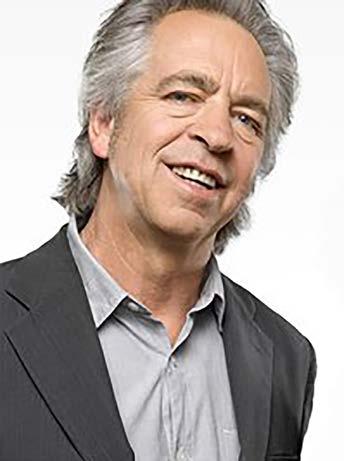
Nankervis wrote in his article ‘Temperature Rising’, “I treasure that initial, heady thrill of seeing the band walk onto the stage in the blistering afternoon heat and begin playing. I laughed out loud when they launched into the first song, ‘Brown Sugar’. Laughed with sheer exhilaration and relief. Laughed to hear Keith Richards play those perfect chords out front of Charlie’s rock-solid beat. Here they were, The Rolling Stones playing right in front of me. I can still see the rows of amps covered in white material, Keith swaggering elegantly in bell-bottom jeans, Bill standing like a statue, Mick Taylor playing his guitar effortlessly, Bobby Keys stepping forward to play sax solos just like he played them on the records and the black security guard who sat on the side of the stage, clapping along with every single song while trams rattled along Glenferrie Road.
“Surprisingly, I also recall a fleeting sense of disappointment watching Mick Jagger. I wanted him to look and move like he did in Gimme Shelter and yet three years later his hair seemed too short, the scarf and jump suit too glam and he appeared to be running rather than dancing. Be careful what you pray for.
“But it was the Stones at last and I could easily dismiss these minor gripes and let myself get carried away with the show. They were loud and raw and a little loose, but the crowd soon spilled from their seats and danced in the concrete aisles and we were united, experiencing that intangible magic we’d been yearning for.”
MAX CRAWDADDY (3RRR DJ)

course led me to purchasing Sticky Fingers and Exile On Main St and the rest they say, is history. And again, thanks to a good friend, we scored tickets to see them at Kooyong. It was a stifling hot day and they opened with ‘Brown Sugar’, then hit us with ‘Bitch’ followed by ‘Rocks Off’.
“Maybe it was the heat but the rest of the gig is a bit of a blistering-blur. I remember Mick’s blue satin jumpsuit and red scarf and the other Mick (Taylor) playing brilliantly, as did Charlie, Bill, Keith, along with Nicky Hopkins on keyboards and Bobby and Jim on the Horns. My other recollection, after the gig, was walking back exhausted to the railway station and noticing so many Tour posters in the gutter, because they weren’t stapled in, and they’d slipped out of the Tour souvenir programmes. I still have my programme and poster but thinking back now, I really wished I’d scooped a few up.”
Crawdaddy told me a little about his experience at The Stones’ Kooyong ’73 show, “I had just hit my teens and was a recent convert to The Rolling Stones, after spending my younger years totally devoted to the Fab Four. Thanks to a good friend who suggested I had a listen to Get Yer Ya-Ya’s Out!, which of
JAMES YOUNG
 Rolling Stones poster courtesy of the Max Crawdaddy Collection.
Rolling Stones poster courtesy of the Max Crawdaddy Collection.
74
(Owner/booker Cherry Bar, Hotel Westwood, Yah Yah’s)
Young is a massive Stones fans and said, “The 50th anniversary of the 1973 Australian tour just reminds us of what an incredible band The Rolling Stones are. I’ve been very lucky to have seen them dozens of times since then, and they’re the band that I love more than any other. They’re also the longest-lived band of all time.
“I was 6 years old when they toured in 1973. My parents had three tickets, one for my father, one for my mother and one for their friend. Dad got chicken pox, which was going around at the time, so he couldn’t go and they didn’t use the spare ticket. Maybe they sold it outside Kooyong. But they left the 6-year-old me at home! They could have taken me to my first rock concert, but it didn’t happen.
“Fortunately, I have several bootlegs from the tour and one of the Melbourne shows, which is called Temperature Rising, is a favourite. The Perth concert (Rocks Off!) sounds incredible too. They’d just come off that five album chapter of classic albums, their greatest period ever, so they were playing at the top of their game. And Mick Taylor is the greatest guitarist that they’ve ever had.
“Going back 10 years ago, in partnership with Brian Wise, we organised the 40th anniversary tribute shows at the Corner hotel. We had Tim Rogers on vocals, the dual guitar assault of Davey Lane and Ashley Naylor, Matt from Even on drums, Ross from Snout on bass, Jack Howard from the
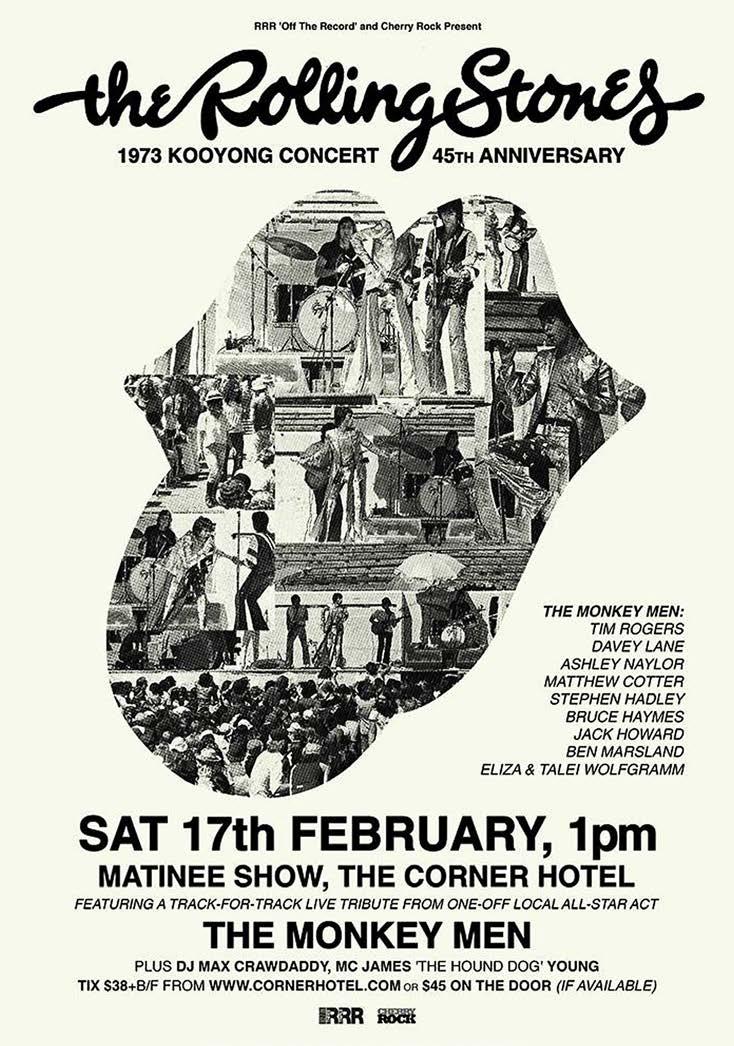
Hunters on trumpet, Ben on sax and Eliza and Talei Wolfgramm on backing vocals (which the Stones didn’t have then but which I thought was a great idea). We also did a 45th anniversary show. So, for the upcoming 50th anniversary, I’m hoping I can weave a bit of magic, get the same band together and put on a tribute show in a certain larger venue. It’d be a big show, provided we can get permission and make it happen.”
DENIZ TEK (Guitarist, Radio Birdman)

There’s also the story of Radio Birdman guitarist Deniz Tek selling a guitar to Keith Richards. Ann Arbor-born (MI, United States) Tek had arrived in Australia in February 1972 to commence his medical studies at NSW university. Tek had grown up listening to the MC5, The Stooges, The Rationals, Alice Cooper and all the other Detroit-based bands of the late ’60s-early ’70s. He was also a hardcore Stones fan. As he explained in Vivien Johnson’s book Radio Birdman (1990), he’d bought tickets for a concert in every city on the tour. He hitchhiked around the country to each gig.
Before the last Sydney concert, he decided to meet the Stones. Having spent all his hard-earned cash on his Stones tickets, he had to sell a guitar, a 1948 National Town and Country. He found a way to contact Newman Jones, Keith Richards’ guitar tech, at the Hyatt Kingston and made his pitch. “Yeah, Keith really likes those. Bring it down to the hotel after the show tonight. It’s the last show, we’re leaving the country tomorrow, so it has to be tonight.”
In the early hours of the morning, having got through two levels of security, Tek was finally on the top floor of the Hyatt, in the midst of a Stones party. Jones introduced him to Keith who started playing the guitar along to a soundboard recording of the Sydney show just completed. >>>
75
>>> Richards explained open G tuning, and other methods of his craft to Tek. It was a revelation for the young guitarist who had spent many hours trying to understand the secrets of how Richards played. “There were these things that I’d been trying to figure out for so many years, that were now told to me.”
With the sun coming up, Richards peeled off a stack of $20 bills that someone had given to him, handed the money to Tek and the deal was done. “Hope you get yourself a nice guitar and thanks for this one,” Richards said. Tek also ventured to ask for a tour T-shirt to show his friends but because Richards was fresh out of Australian tour t-shirts, he gave him one from the 1965 American tour, a genuine collector’s item. Tek said, “I bought a Gibson SG and used that for a while. Yeah, it was great, fulfilled a dream for me – I felt like a rich person for a day – this great experience, money in my pocket. The next peak I had that rivalled it was recording with Radio Birdman at Rockfield studios five years later.”
WHEN THEY WERE KINGS
The Rolling Stones – Kooyong 1973
By Brian Wise
“Nostalgia is a marvellous thing. Through its prism events can appear much better than they actually were and, given the filter of time, they can become increasingly so over the years.” That was what I wrote a decade ago reflecting on The Rolling Stones at Kooyong in 1973. Even allowing for the nostalgia factor, it is still the greatest concert I have ever attended. Not the most technically perfect. Not the most emotional. But the one that focused a whole range of factors through that prism to make it the greatest.
To make it an even more personally important, The Rolling Stones had been the first band that I ever saw in concert. That was in February 1966 at The Palais, St Kilda. (Actually, the opening acts Max Merritt & The Meteors or The Searchers might have been first, but let’s not spoil the story). I had only been allowed to go because a much older friend, Graeme, from the local cricket club got tickets to the Saturday matinee show (remember them) and we drove to St Kilda in his Fiat 500.
The day before the show I was totally surprised that my father, who would drive through the city on his way home from work and occasionally pick me up from school, actually stopped off to go to 3UZ where the Stones were visiting Stan Rofe. I still cannot understand why I was allowed to see the Stones but just two months later was forbidden from seeing Dylan. Perhaps it was simply that I didn’t have an older friend who could get tickets.
After that 1966 concert, my academic results crashed and became in direct inverse proportion to my interest in music. My future as a brain surgeon was doomed. In class, I sat next to my friend John who had been at school with me since prep and was even more obsessed with music than me. He combed his hair to resemble Brian Jones; he did look a little like him and affected the same pout. He also played guitar quite well.

I bought a pair of Cuban heeled boots and a corduroy jacket. I have a photo taken in front of our back shed where I am pretending to be Keith Richards. That friendship was a dangerous combination. In class we drew up lists of band names. I devised a weekly Top 20 chart.
The first No.1 was ‘Security’ by Thane Russal & Three, and it stayed there for 11 weeks. We would often get detention. John lived in
76
Brian Wise and five friends at the Saturday afternoon show. Can you pick them?
Ivanhoe and had a massive bungalow out the back of his house with a full-size pool table. He also had a real hi-fi system with huge speakers when most of us just had record players or radiograms. John had another school friend, also named John, whose father owned an import business and who travelled overseas often and would bring back the latest albums which we got to hear before anyone else. (I recently discovered that another friend shared the same experience at the same time just along the road with that same school friend - but that’s another story.) Music had inserted itself into our lives and was to become a life-long obsession for both of us.
By the time the Stones returned in 1973, I was at Monash and by then involved in helping to set up 3MU, the student landline radio station. John was at RMIT and lived in Carlton. Our other school friend Kirk joined and then John’s girlfriend Jenny (later to be his wife) would be part of a tight group. We would spend Friday and Saturday nights at the Clyde Hotel – when we weren’t at a concert. The great 3UZ DJ Stan Rofe, whom I had known since 1966, lived opposite and would entertain us. Stan would give me albums that he was never going to play on his radio show. After the pub or a concert, we’d sit up all night at John’s flat in Wilson Street listening to music and talking all night. These were the days of (too much) wine and roses, when you thought your friendships would never end (and in some cases they haven’t). Somehow, possibly via the people who ran the record stall at Monash Uni, we discovered how to import records from the USA. We imported eight copies of Exile On Main St in August 1972 to avoid having to wait weeks for its local release. On my way to bring them to the Clyde I stopped for petrol and someone saw them in the backseat of my car. Word spread immediately and I sold five copies on the spot to other customers for $10 each! That was the sole extent of our import business. We spent the entire weekend listening to it, convinced that it was the greatest album ever released. Music had become more than an obsession; it was our life.
A few months later we lined up overnight outside the MSD in Bourke Street, Melbourne, to buy tickets for the Kooyong shows. I think the ticket price was $5 and we could only afford one show. (I still have the Ian McCausland designed ticket with the set list written on the back). ‘Rain Hail or ShineWe Play’ it said. We celebrated with breakfast at the Pancake Parlour over the road.
By the time the Stones actually arrived Exile On Main St had been out about six months when the Stones toured. We’d already agreed that 1969’s Get Yer Ya-Ya’s Out! was the greatest live album of all time and it had arrived in the middle of a sequence of albums that is still, I think, unparalleled, bookended by Beggars Banquet, Let It Bleed then Sticky Fingers and Exile.
We arrived for the first Stones show on the
scorching afternoon of Saturday February 17, four of us piled into in my friend’s Triumph British racing green TR4. We parked on the fields across the road from Kooyong and entered the stadium to the insistent strains of Madder Lake playing ‘12lb Toothbrush’. I am sure they played it more than once. The other music we heard was Lou Reed’s Transformer album over the PA which had only been out for three months. ‘Walk On The Wild Side’ seemed adventurous.
There was a seemingly endless wait for the Stones to appear under the beating sun. Most people didn’t wear hats or caps. (We’re paying for it now). The excitement was palpable, more so than I had ever felt at a concert before. The 1969 US tour had gone into legend, and they had completed another one there in July 1972 which we would have read about in Rolling Stone or Go-Set. Since the band last toured here in 1966, they had transformed their sound and adapted it, via some huge chugging riffs, for stadium and arena shows. This was undoubtedly the world’s greatest rock ’n’ band, and we were about to see its best line-up ever. Seated in the first tier of the grandstand to the right of the stage we had a perfect view.
Finally, there was the roar of the audience as the Stones finally arrived and everyone stood to greet them as Keith struck the chords to ‘Brown Sugar’. It was like a massive sigh of relief that that were finally back. We followed Mick Jagger’s every move as he strutted across the stage while his bodyguard Leroy Leonard sat at the back surveying the audience in case someone attempted to invade the space. When Mick pounded his belt into the stage during ‘Midnight Rambler’ we emulated him.

Mick Taylor stood at the back to the right of Charlie Watts’ drum kit, looking almost studious as he played mellifluously. The bell-bottomed Keith pounded out the riffs. Bill Wyman stood still, as ever. (Three years later I saw them in London after Taylor had been replaced by Ronnie Wood and it was definitely not the same band).
The show was thrilling. Brilliant. Imagine the buzz from the best show you have ever seen then multiply it by ten. That is how it felt. Years ago, this was confirmed to me when someone sent me a film of the concert transferred to VHS with the Perth soundtrack dubbed in. (That’s a bootleg you must have!)
The Kooyong set list was mainly taken from the band’s two most recent albums at the time - Exile and Sticky Fingers: ‘Brown Sugar’ / ‘Bitch’ / ‘Rocks Off’ / ‘Gimme Shelter’ / ‘Happy’ / ‘Tumbling Dice’ / ‘Love In Vain’ / ‘Sweet Virginia’ / ‘You Can’t Always Get What You Want’ / ‘All Down The Line’ / ‘Midnight Rambler’ / Band introduction / ‘Bye Bye Johnny’ / ‘Jumping Jack Flash’ / ‘Street Fighting Man’. Of the 15-song set list, they still played at least seven during their 2022 shows.
Afterwards, on a high, we drove back to the Clyde Hotel in Carlton for a post-mortem drink or six. Stan Rofe suddenly appeared brandishing tickets for the evening show and asked if we would we like to go? We piled into the TR4 again and sped back out to Kooyong for the second greatest show I have ever seen!
Even allowing for the distortion of the sometimes-unreliable nostalgia lens, most people who saw The Rolling Stones at Kooyong in 1973 agree that it is the best rock ’n’ roll concert they have ever seen. That certainly has not changed
77
The first time I interviewed Neil Young, it was February 7, 1987, and I was on an airplane flying back to San Francisco from Santa Barbara the day after attending the first Crosby, Stills, Nash and Young reunion concert after David Crosby got released from jail and got his life in order. As I sat waiting for the plane to take off, Neil Young came walking down the aisle and took a seat a few rows in front of me. I waited until the plane took off, and approached him, introduced myself (I had seen him briefly backstage the night before), and asked if I could interview him for a story I was writing for Rolling Stone. He said yes. Eight years later he said yes again. This interview, which first appeared in 1995 in my online magazine, Addicted To Noise, appears in my new book, “Addicted To Noise: The Music Writings of Michael Goldberg,” a collection that includes interviews, features, profiles and essays, most of which were previously published in Rolling Stone, the San Francisco Chronicle, Cream, Downbeat, Esquire, New Musical Express and other publications, on such artists as Patti Smith, Bob Dylan, Ramones, The Clash, Lou Reed, Laurie Anderson, James Brown, John Lee Hooker, Ramblin’ Jack Elliott, Sleater-Kinney, Brian Wilson and many more. Neil Young means so much to me. Here is a brief excerpt from my second novel, “The Flowers Lied”; I think it conveys some of what I feel about Young.
I dig Neil the most, beginning in his Buffalo Springfield days. Back then he’s the coolest freakster bro in the band with his fringed Buffalo Bill leather jacket. So so serious bummered-out lanky tall plays a big fat Gretsch White Falcon sings us his lonesome. Sure Dylan made up the whole trip, smart young white guy lays the deep poetry over folk-rock, but while Dylan has the East Coast vibe and by the time he plays rock & roll he has that English dandy thing going, Neil’s the stoned West Coast free spirit. Neil lays his heart out in those downer chords, not afraid to sing a bad line ’cause he knows the feel is the whole trip, the sound of the words he sings, and the off-kilter rhythm that shows up around Harvest but been in the works at least since “Mr. Soul,” and the ragged-ass electric guitar. Sometimes it’s as if Neil hangs on one note for the whole damn solo. So often growing up I felt lonely as the loneliest Neil Young ballad. “Oh, Lonesome Me” or the other one that’s equally downered and out, “The Losing End (When You’re On),” where he’s all sad-sack singing how he’ll never be the same, and yeah it’s pathetic, but sometimes it’s how I feel. Neil’s lonesome sound, sound of my own soul.
WOODSIDE, CALIFORNIA—PINE TREES and redwoods are whipping by as Addicted To Noise business manager Steve McConnell and I tool down Skyline Boulevard in Woodside, a rural area of Northern California just south of San Francisco. “Song X,” a rousing rock & roll sea chantey off Neil Young’s brilliant collaboration with Pearl Jam, Mirror Ball, is blasting so loud we can hardly think. I am heading for a Woodside restaurant to interview Neil Young.
In the parking lot, I see Young’s 1960 Lincoln Continental parked in the shade of a grove of trees. His dog, Bear, is inside the car, waiting patiently. I enter the rustic restaurant that Young and his entourage have taken over for the day. The restaurant is dark and cool—a safe haven from the heat.
While waiting for Young, I hang with his manager of over 20 years, Elliot Roberts, Warner Bros./Reprise Records chief publicist, Bob Merlis, and MTV’s Kurt Loder, an old friend and writing collaborator who had flown in to do the MTV Neil Young interview. “Anything he seemed touchy about?” I ask Loder, who is brushing some kind of makeup powder off his double-breasted sport coat. He looked at me like I was crazy: “Of course not,” he said. “It’s Neil.”
I interview Young at the back of the restaurant, light streaming through the window onto him. He is wearing a baseball hat, which conceals his long graying hair.
At 49, Young is indeed the Grand Old Man of raw, primal (OK, I’ll say it), grunge rock. He has, simply, lived and experienced a lot. Sitting across the table from him, it is clear that this is someone “connected” to the creative well, one of the rare artists able to be open enough that the universe can, on occasion, speak through him. As the sun slowly sets through the trees, we talk.
Michael Goldberg: I’ve been listening to Mirror Ball. I really think it’s a powerful album, with a raw, visceral quality to it. I know you recorded it in a relatively short period of time. What made you decide to do an album with Pearl Jam backing you up?
Neil Young: I’d gotten to know them through playing a tour together in Europe a couple of years ago with Booker T. and the MGs [Young’s backing band for that tour]. Then Eddie inducted me into the Hall of Fame [January 1995], and that night I played a song, “Act of Love,” with Crazy Horse, which Pearl Jam recorded with a little DAT recorder, and they learned it. So two nights later I played it with them [at the Voters for Choice benefit in Washington, DC, on January 14]. And it sounded great. So we decided to go into the studio.
Goldberg: But it was that spontaneous?
Young: It happened eight days after the Choice show [Young and Pearl Jam entered Bad Animals studio in Seattle on January 26, 1995].
Goldberg: What was going through your mind once you sat down to write the material?
Young: The material became a product of the feeling of not having the time to sit back and analyze. Not enough time for that. So, it was just a matter of opening up and finding what was inside me to write. Once I did that, the songs came really fast, and they were all based on things that were happening right around us at that time. A lot of information from people’s lives that were in the room with us. Discussions and talks and things that were happening during the sessions showed up in songs.
Goldberg: What’s an example of that?
Young: “I’m the Ocean.” Something in there about baseball players and football players and playing cards came out of a discussion that I had with somebody there. But there’s all kinds of things in there, personal things. You can’t really tie it to a distinct person. It could be three things that happened to three different people all get put together into the same moment. It’s just a matter of stream of consciousness. It’s not linear, organized. It just keeps coming out in a rhythm. The thoughts keep coming out. Then when you’re done this is as much news to me as it is to you. All I’m doing is writing it down and putting it in a cadence. Once I get into a cadence, then why should I even stop and wonder what it is? You can do that for the rest of your life, but when it’s coming out, you don’t want to stop it.
Goldberg: Obviously it was a very creative period for you.
Young: It was a good period. I’ve made other albums that way, in the past. I’ve made albums that have taken me years to make. It was just a high energy period. I saw a limited window to do it, because the band was leaving to go [to perform in Europe], and I thought, “God, this feels good right now, if I can stay with this.” So I recorded for two days and we got four songs. I was supposed to wait until they came back from a tour, and then we were going to get together and do some more. And that’s the way we left it. But after a while, two days at home, I started thinking about other songs. I called up and found out there were two other days they were available, so I said, “I’ve got a few more songs.” Then we recorded until I didn’t have any more [songs left]. But there was one day left so I said, “I got some more songs, if we can get one more day, we’ll do a couple more songs.” Then somewhere in the next couple of days, I wrote the songs. >>>
78
78
Young at the Boarding House, San Francisco, 1978.
 by Michael Goldberg
by Michael Goldberg
THE LONER:
A CONVERSATION WITH NEIL YOUNG
By Michael Goldberg
Neil
Photo
>>> Goldberg: When I first heard “Song X,” it sounded like this incredible sort of rock & roll sea chantey [Young smiles as I tell him this]. I was imagining you and Pearl Jam, this gang of outlaw rockers, heading out to sea. Tell me your impression of that song.
Young: “Song X” was written around the same time as “Act of Love.” It’s really a story about choice. Both those songs are based around the choice issue: [Whether] to have a baby; the responsibility; why is it always the mother’s responsibility? It’s so easy for the guy to get out of it. Do people know what they’re doing when they’re in the act of love? Do they know what’s next? Do they know what the fruit of love is? Is anybody thinking about that? Then there’s the murder, however you want to look at it, the murder of the fetus, or the murder of the person that did the abortion. The murder aspect brings it into the God-is-on-my-side kind of righteousness of holy war. The whole thing’s related [to] the act of love and the willingness or non-willingness of someone, usually of the guy, to accept responsibility for what’s happened. Those first two songs are centered on that ’cause that’s what I was focused on, because of the benefit.
Goldberg: How did you learn to let yourself be open, to let what’s going on around you somehow get through you, into a song?
Young: I didn’t always know that it was happening. When I started living out here [in Woodside] I started to realize it. I stayed out of the mainstream for a long time and kind of hid down here in my house back in 1970. When I hid out here in the trees, all I wrote about were the trees and what was happening in the country. Then I realized, well, that must be because I’m here. And that’s all I write about here. So I should go to New York for a couple of days and come back. So I could see, well, wait a minute, this seems to be directly linked. If I’m going to write, I’m going to be writing about all these things [happening around me at the time]. I just need a jolt of this or that. I’m not looking for anything [in particular], just what you pick up along the way. You don’t have to get anything in particular, just be there. Besides being in a relationship, it’s also location. It has a lot to do with what you write down. Where you are. I use those things to keep going.
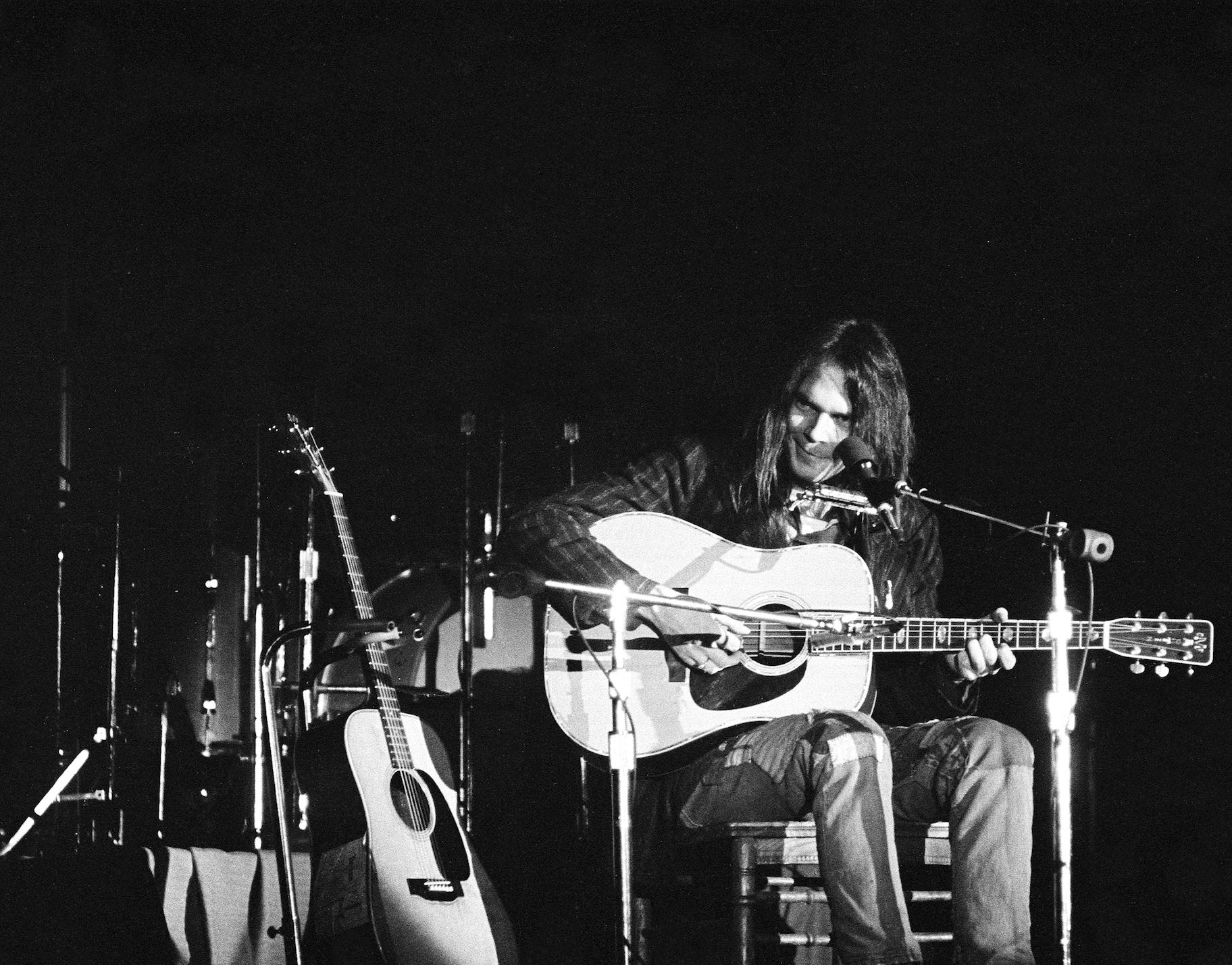
Goldberg: So you started to realize this 25 years ago?
Young: When I took away the variety and then noticed the music reflected that, I put the variety back in and noticed the music
reflected that. I concentrate on one thing—you can only see something so many times before you start to count on it in your plan for how you’re going to do things.
Goldberg: Did you start consciously taking note of being open?
Young: You can’t improve it by being self-aware of it. It’s better to not be aware of it. It’s not something you can use as you would a tool. But it’s something that you can know. I’m open all the time. There’s never a shortage of things to write about, if you pay attention to other people. If there’s nothing going on in your own head, that doesn’t mean anything. It’s like you, him, him, especially him. [He points to Addicted To Noise business manager, Steve McConnell, who is videotaping the interview, and then to Elliot Roberts, who has entered the room.] I’ll be singing about you, OK? You’re next.
Goldberg: I was told that in titling Mirror Ball, you were thinking of the mirror ball that hung from the ceiling at the Fillmore West in the early ’70s. Is that true?
Young: I was just thinking of a mirror ball. To me, all the pictures and scenes in the album, if you close your eyes and try to go with where the lyrics are taking you, they’re flying. There’s movement that keeps going from one place to another all the time. Just like a bunch of little square pieces of mirror all stuck together on a ball that’s rolling along. You can only look at one at a time, so you just get to see a little glimmer of this, a little glimmer of that. It’s like if they were all little television sets and you were looking in them, up into this ball of televisions rolling along, and they all had different things on them. [That’s] sort of what it is. We ought to go build that right away, build a mirror ball television. Four hundred and fifty TVs all on at once rolling down the road.
Michael Goldberg has been interviewing and photographing musicians since he was 17. He was a senior writer at Rolling Stone magazine for a decade. His writing has appeared in Esquire, New Musical Express, Creem, DownBeat, New York Rocker, Trouser Press, Musician, New West, Vibe, New Times, the San Francisco Chronicle, and other publications. He has had three novels published: “True Love Scars,” “The Flowers Lied,” and “Untitled.” In May 2022, “Wicked Game: The True Story of Guitarist James Calvin Wilsey” (HoZac Books) was published. “Addicted To Noise: The Music Writings of Michael Goldberg” (Backbeat Books), was published on November 1, 2022.
80
Neil Young, live, 1973.
Photo by Michael Goldberg
By Denise Hylands
Charley Crockett. Coming our way in March 2023.
Here’s to another year of great music. Live music seems to be back and happening and there’s so much to look forward to in this new year.
So much great music was released in 2022, and fortunately for us many of those artists are heading our way early this year.
Charley Crockett released two albums during the past year. Under his nickname Lil G.L., Lil G.L Presents: Jukebox Charley, in the vein of previous releases under this name, another album of covers some known and many obscure. A look into the music that has founded him and his sound. And, then The Man From Waco, there really isn’t anything Crockett can do wrong. The great news is that Crockett will be touring Australia in March 2023 with his band The Blue Drifters, playing Melbourne, Sydney & Brisbane as well as Tent Poles Festival at Mt Duneed. Get your tickets before you miss this awesome show.
Kentucky native Ian Noe released one of my favourite albums of last year Rivers Fools & Mountain Saints. He’s definitely one of the new generation of singer songwriter storytellers getting some deserved attention and that album will not disappoint. Noe will be touring in March with Early James. Hailing from Alabama, James is another young artists who is proving to be an outstanding talent, with his own old style singing, musicianship and songwriting. His first album was produced by Dan Auerbach who discovered this Alabama lad, produced his first album and signed him up to his label, Easy Eye Sounds. Last year he released the much praised Strange Time To Be Alive. Catch Noe and James playing at Port Fairy Folk Festival, Blue Mountains Blues Festival as well as their own shows.
Double bills don’t get much better than Lucinda Williams & Steve Earle. Heading out here for Bluesfest, catch the opportunity to see them playing their owns shows in Sydney & Melbourne too.
And to add to the list of tours to look forward to, Greensky Bluegrass, Jason Isbell & The 400 Unit, Angel Olsen, Tim Easton, Bonnie Raitt & Mavis Staples, and i’m sure there’ll be more to come. Buckle in for some great live shows.
The last to mention of tours, however but not least, Redd Volkaert is heading our way. Known for his guitar playing greatness and one
of the best Telecaster guitar slingers, particularly in the genres of Western swing and honky tonk. He’s played with Merle Haggard, Johnny Paycheck and George Jones to name a few. Often playing with his buddy Bill Kirchen, when they are referred to as the Titans of Telecaster”. Volkaert is touring Australia in early February, NSW, ACT and VIC. Make sure you catch this amazing guitar player touring with Ray Beadle Here’s a list of some of my favourite releases from 2022. If you’re looking for some good twang over summer, this is a good start. I highly recommend them all. In no particular order.
Lil G.L. Presents: Jukebox Charley & The Man From Waco - Charley Crockett

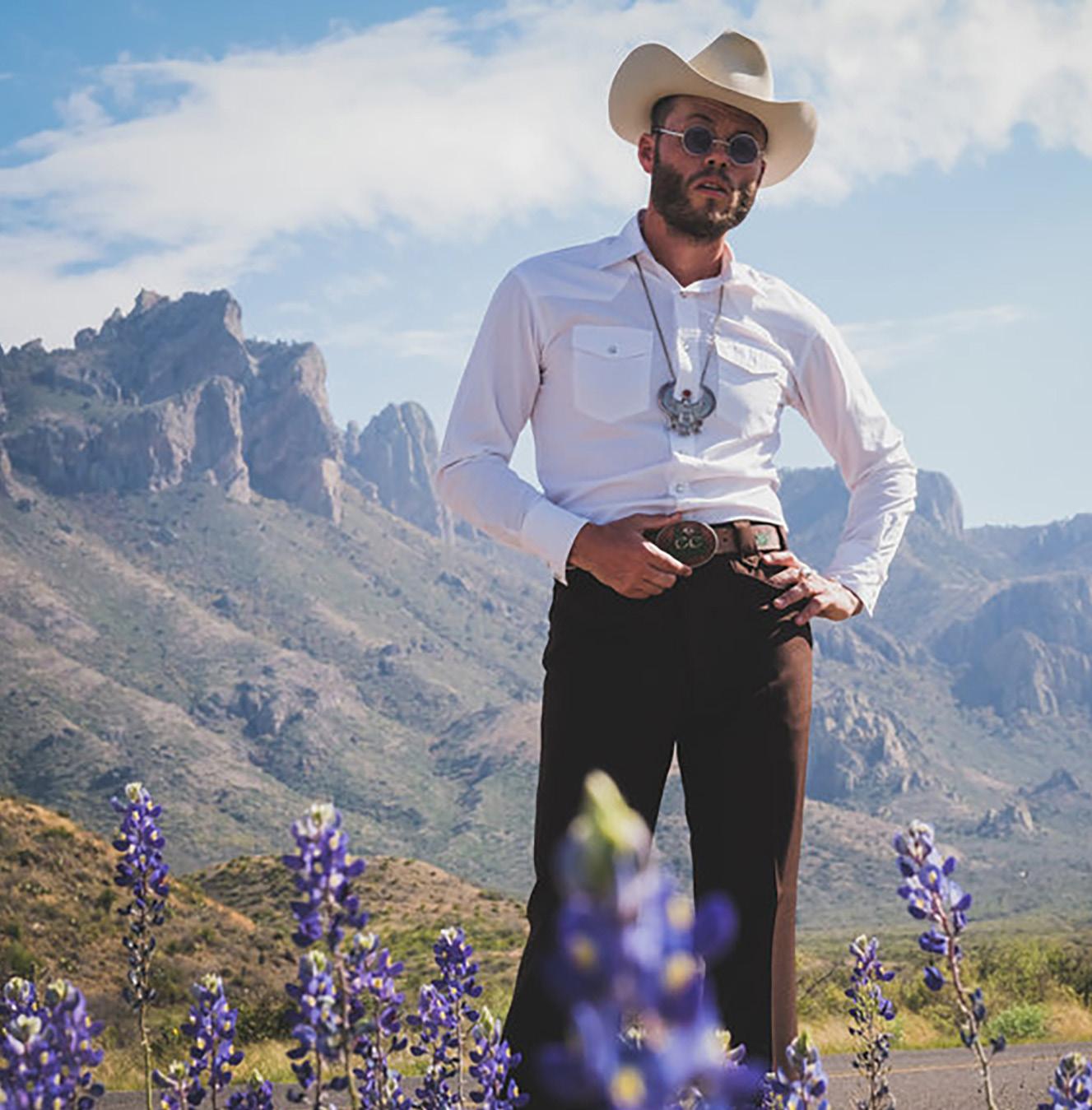
The Real World - Freya Josephine Hollick
Neon Blue - Joshua Hedley
River Fools & Mountain Saints - Ian Noe
On The Ranch - Emily NenniKingmaker - Tami NeilsonTeddy & The Rough Riders- Teddy & The Rough Riders
Doggabone - Texas String Assembly
Welcome To Sin City - Sin City
I’d Rather Be Listening To Sweet Talk - Sweet Talk
This Mess We’re In - Arlo McKinnley -


Obsessed With The WestBrennen Leigh w/ Asleep At The Wheel

81
Photo by Lyza Renee.
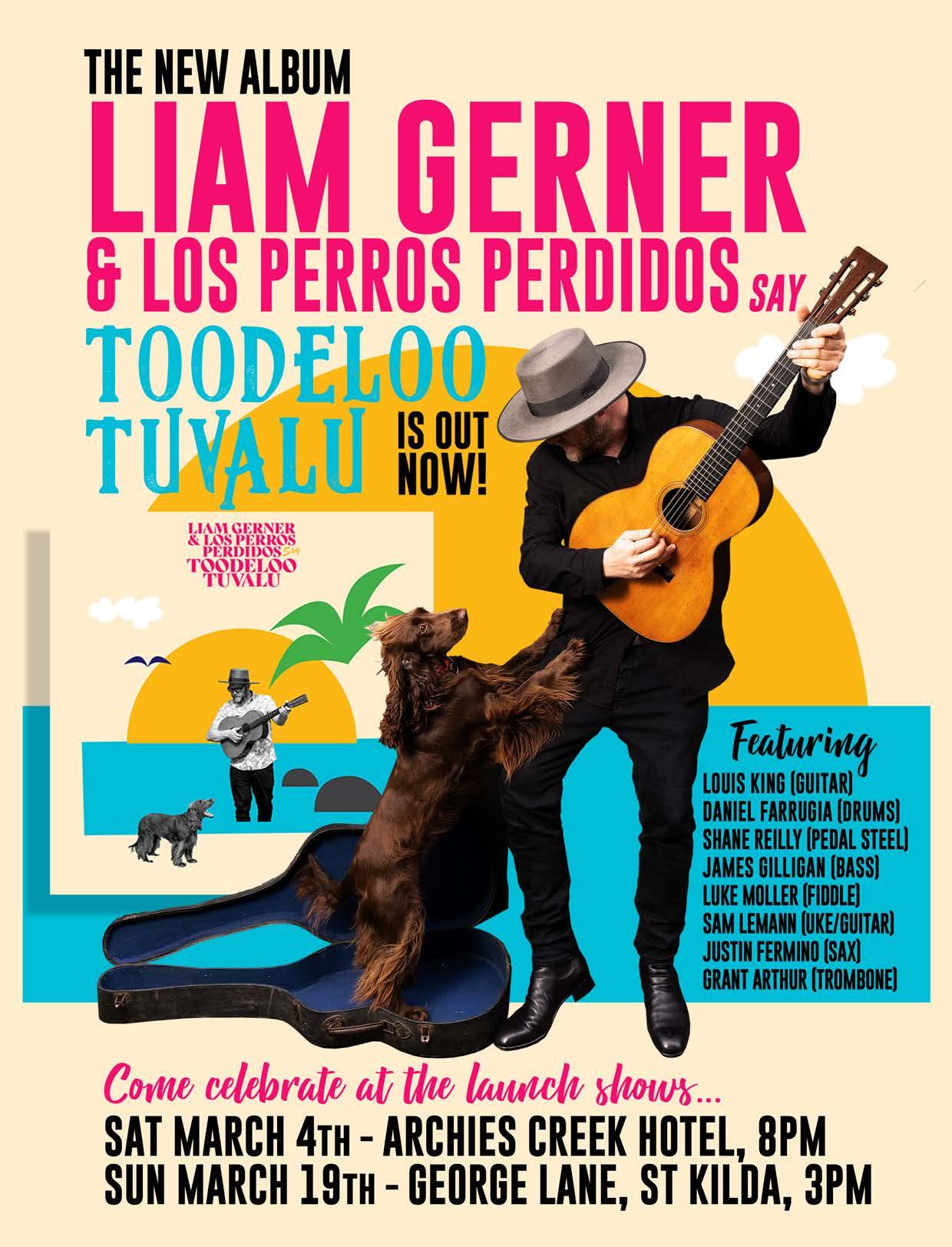 By Chris Lambie
By Chris Lambie
FAMILY BAND
Bassist,
Five-time Grammy Award winning bass-player and singer Victor Wooten has recorded and performed with the likes of Bootsy Collins, Branford Marsalis, Keb’ Mo’ and Chick Corea. He’s also a founding member of Béla Fleck and the Flecktones. His return to Australia will be Victor’s first with his band of (literal) brothers. You grew up in a musical family. As the youngest, were you the ‘show-off’ or ‘class clown’?
Growing up the youngest of five musical brothers was the best. My brothers were my heroes, like my super heroes. They treated me like an equal. Reggie would teach me routines and little tricks to drive the crowd wild. So if I was a show-off it was because my brothers taught me how. As a very young kid, I’d play with my bass behind my head, or lay it on the floor and play it like a piano, kick my legs and all these things. It was a great way to grow up. You were named in Rolling Stone’s Top 10 Bassists of All Time. Who were your bass heroes?
Reggie started playing the guitar and ukulele. Roy played drums, beating on cardboard boxes. Rudy had a plastic flute and then a plastic saxophone. Reggie taught Joseph to play keyboards then started teaching me to play the bass when I was about two years old. He’s only eight years older than me. I thought he was a grown man. By the time I was 5 or 6, we were the opening band for Curtis Mayfield on his Superfly tour. I was listening to great music at an early age. Earth Wind & Fire, Sly and the Family Stone, James Brown, The Beatles, The Rolling Stones. I was influenced by all those bass players. Then that jazz fusion - Return To Forever with Stanley Clarke, Weather Report with Jaco Pastorius and Alphonso Johnson, John McLaughlin. Early on, I got an Alembic bass [like] Stanley Clarke. A very, very high-end bass. I had many heroes. I didn’t know all their names - like Chuck Rainey or Duck Dunn - but I knew their basslines. I’ve been very lucky to tour and play with some. Bootsy Collins, Marcus Miller, Stanley Clarke, drummers like Dennis Chambers, Omar Hakim. Meeting them, they’re like gods to you, but they treat you like equals. It’s hard to claim that status. What I learn from them is, they too are human. It makes what they do seem attainable, but with my own voice. As children of military parents, you re-located often. Do you enjoy being on the road?
It was just natural to me. Touring with my brothers is easy because we know each other so well. For me, being on tour is like a free vacation
where I get paid for doing what I love to do. And I get to make people happy. Like anything it can get tiring but I call it a ‘good tired’. I hope to do it for a long time.
Bela Fleck and the Flecktones broke sonic boundaries. How was the repertoire developed?

When I met Bela in ‘87 or ‘88, he was putting a band together for a TV show. He’d just met Howard Levy who played harmonica in an interesting new way. Bela asked if I knew any drummers? I told him about Roy. Bela asked, ‘Who does he play like? Lenny White? Buddy Rich?’ I said, ‘He plays like Roy Wooten’. So Bela called him and didn’t even hear Roy play. He just loved what they talked about and hired him. He flew him to Nashville and it was just the three of us in Bela’s living room and boy, did we have a blast! Bela didn’t tell us the key or time signature or the chords. He just played, allowing us to react and respond with no pre-conceived ideas. And in many cases the music changed. It was the birth of the Flecktones sound. Adding Howard on harmonica and keys filled it out even more. Bela let us bring ourselves to the music. That takes a lot of clarity, courage and trust. If we messed it up too much, he could bring it back. I try to do that with my friends. That vision.
You wear many creative and nurturing hats. (Teacher, acrobat, family man, magician…!) How important is it to have ‘other lives’ outside music?
If you have no life, what is your music about? For young people, I say ‘Don’t spend all your time in a practice room’. Music is my career but I’m still inspired by other things life has to offer. A lot of my energy comes from the earth, birds that sing just because the sun came up. The wonderful people in my life. We lost our brother Rudy in 2010 but I can still feel him and hear his music in my head.
What can Australian audiences expect on stage?
I can guarantee people will see and hear things they’ve never come across before. Reggie on guitar is going to blow your minds. Roy on drums - you never know what he’s going to do. Joseph on keyboards is just amazing. He’s played with The Steve Miller Band since 1993. We’re all singers also. There’ll be dance steps, new music, acrobatic guitar stuff. We’re playing downunder so we may even play on our heads! Prepare yourselves. Buckle your seatbelts.
Victor Wooten & The Wooten Brothers will be touring in May/June.
83
singer and songwriter Victor Wooten returns to Australia with his brothers.
By Billy Pinnell
The 1983 release of David Bowie’s least two reasons.
STEVIE RAY VAUGHAN TEXAS FLOOD

After signing one of the most lucrative recording contracts in music history up to that time, Bowie repaid his new record label by achieving the biggest sales of his career first time out.
The other was the unexpected participation of the studio band’s lead guitarist, 29-year-old Stevie Ray Vaughan, an unknown musician from Austin, Texas who would, in the following 12 months inspire a blues-rock revival that has endured to this day.

The passion, power and drive that Bowie obviously saw in his playing had already earned the young musician legendary status among audiences who’d followed him from one bar to another in Austin over the preceding decade.
His deep devotion to the blues and his incredible talent would elevate Stevie’s name to the highest rung of the blues ladder to sit comfortably among his mentors and inspirations: B.B.King, Buddy Guy, Albert Collins, Freddie King, Hubert Sumlin, Albert King, Elmore James, Muddy Waters, Lonnie Mack, Jimi Hendrix.
What made Stevie so special was an ability to immerse himself in the music of these blues giants and countless other musicians from whom he would imbibe the best of what he heard then add his own distinctive touch. He also tapped into the spirituality of the blues, possessing a deep understanding of its emotional power, the indeterminable ‘feel’ that would reveal itself in his guitar playing.
Stevie Ray’s earliest influence was his older brother Jimmie (later to found The Fabulous Thunderbirds) who played in various blues and R&B bands around Dallas, Texas where the Vaughan family lived. An outstanding guitar player in his own right, Jimmie introduced his young sibling to a world of blues, R&B and jazz as they listened together to his record collection and the local radio stations.
After vain attempts to play drums, bass guitar and trombone, Stevie figured that if his big brother was playing guitar he’d give it a go as well. Performing in high school bands as Steve Vaughan, the 17-year-old guitarist dropped out in 1971 to become a full-time musician, following Jimmie to Austin, the musical Mecca of Texas where he would hone his talents on the club circuit.
Joining Paul Ray & The Cobras a popular Austin band, Stevie learned the art of performing in front of an audience playing guitar behind his back, with his teeth even laying it on the floor and tapping it with his feet.
Despite the gimmicks (T-Bone Walker and Johnny ‘Guitar’ Watson had employed the same tricks for years) it was obvious that Jimmie Vaughan’s little brother wasn’t just another flashy, run-of-the mill blues guitar player. The give-away was the ease in which he moved effortlessly from hard edged blues-rock to quiet jazz like passages, qualities that would prevail throughout the many recordings he was yet to make.
band, The Triple Threat Review renaming them Double Trouble in 1980. With drummer Chris Layton and bass guitarist Jackie Newhouse, the group debuted at a club in Austin.
This performance featuring two of Stevie’s songs that included an early arrangement of ‘Tin Pan Alley’ (destined to become one of his showstoppers) plus material from Freddie King, Otis Rush, Howlin’ Wolf, Muddy Waters and Guitar Slim, would be released on the 1992 album In The Beginning by Stevie Vaughan & Double Trouble, their stage name at that time did not include Stevie’s middle name. Early in 1981 Tommy Shannon who’d been in a band with Stevie ten years earlier and more recently had played bass in Johnny Winter’s band replaced Jackie Newhouse.
The series of events that followed proved to be life changing for Stevie. A tape of a performance at an Austin music festival somehow wound up in the hands of Mick Jagger who offered to fly Stevie and Double Trouble to New York to play at a private party for The Rolling Stones.
Word on the street was that a guitar player from Austin Texas unknown outside his home state had taken his first steps towards international recognition. Famed record producer Jerry Wexler heard the jungle drums and after seeing the band perform contacted Claude Nobs, long time director of the prestigious Montreux Jazz Festival urging him to include Stevie Ray Vaughan & Double Trouble in the line-up for the 1982 festival. The band became the first unsigned act to perform at Montreux. Despite a powerful performance they did not go over all that well with some of the crowd booing.Two members of the audience not booing were David Bowie who invited Stevie to play on his Let’s Dance album and Jackson Browne who offered the band free studio time at his Downtown Studios in Los Angeles. In that studio in less than 48 hours, the tracks for the band’s first official release, Texas Flood were recorded. The tapes were presented to legendary talent scout and recording executive John Hammond who signed the band to Epic Records.
Texas Flood consisted of road-tested songs like the title track, a slow blues originally recorded by Houston bluesman Larry Davis, Stevie’s rocking ‘Rude Mood’, a salute to Lightnin’ Hopkins, ‘Testify’ written by George Clinton and previously recorded by The Isley Brothers and Buddy Guy’s ‘Mary Had a Little Lamb’.
As great as these recordings are, Stevie had left the best ‘til last.
The album’s closing track ‘Lenny’, a five-minute instrumental written for his wife Leonora (Lenny) Bailey is exquisite, a soulful, melodic love song that doesn’t need words to convey its message.



Stevie would release only three subsequent studio albums prior to his death in a helicopter crash on August 27th, 1990, at the age of 35.

84
By Martin Jones
LOW RIP Mimi Parker
Exactly a year ago I was falling in love with Low’s 13th album, Hey What and extolling its virtues as my favourite album of 2021. As I write now, founding member Mimi Parker has just died of cancer, inspiring a wave of grieving across the world. Low was not the kind of band that attracted passing admirers. If you were in, you were all in. Very few of their contemporaries produced so much consistently great material. None of those peers were as relentlessly brave and progressive over three decades.

Which makes it very difficult to pick out a favourite Low record.
2005’s The Great Destroyer puts its hand up as a milestone and should be in everyone’s vinyl collection. It is probably the most successful balance of Low’s quietest and noisiest approaches sweeping from barely whispered harmonies to roaring guitars and thumping snares. And nearly every song has its pop earworm without diluting the sinister tension that makes so much of their music so affecting.
While the tools Low employed evolved from album to album, that gist was established at the opening song of album one and never wavered. With just a couple of guitars, a drumkit and two voices, Parker and her partner Alan Sparhawk transported us listeners to dark, strange, unforgettable places. Parker’s understated rhythms (she set out with just one snare, one tom and one cymbal using only brushes) and ethereal harmonies were fundamental to the band – its signature. Their debut album, I Could Live In Hope is still as chilling as when it was released and is now ultra-collectable. People charge over $100 just for a CD copy!
Things We Lost in the Fire (2001) was another landmark album for the band. From the opening line “When they found your body,
giant X’s on your eyes” the album is riveting, electric guitars and (slightly) heavier drums phased in, Parker and Sparhawk singing every word in harmony. ‘Sunflower’ is a song that, once heard, is never forgotten. Songs from this album, like ‘Dinosaur Act’, became set staples. The same year Low and The Dirty Three collaborated on the revered In The Fishtank 7.
Then there’s 2002’s Trust which began to see a broader (though still spartan) soundscape, the band using increasingly treated electric guitars and electronics. Songs like ‘(That’s How You Sing) Amazing Grace’ and ‘John Prine’ saw a reach from personal subject matter into popular culture.
The band finished on a high, Hey What an uncompromising culmination of all preceding Low. More austere and terrifying than anything before, fuzzed out broken down and glitchy electronics threatening
to completely disintegrate, challenging the listener with industrial noise making the relief of those sweet harmonies all the more coveted.
Parker was diagnosed with cancer in late 2020. How much of that informs Hey What? I guess only Sparkhawk knows that. But it is undeniably apocalyptic. The opening song is built on the chorus “Still, white horses take us home.”
Their first and last album as a duo, it is almost devoid of the guitar and drums instrumentation of their origins, scathing pixelated stabs and swarms of machine tortured sound stamping and soaring through the songs. It’s left to those married (literally) voices to provide the humanity in starker than ever contrast. It’s tumultuous, challenging, beautiful and, ultimately, unforgettable – a fitting eulogy for Mimi Parker.
85
WIZARD
CHANGES

KGLW
My favourite King Gizzard story of the year is not that they released five albums in 2022, count ’em, not that they ran cool record fairs alongside their shows or played nine hours over three nights at Red Rocks, Colorado, without repeating any songs in their repertoire. My fave King Gizz story was that they sponsored the Anglesea women’s football team, who took out a premiership with the band’s name emblazoned on their backs. Such a classy move by this local prog-psych sensation I’ve been a latecomer to what is commonly referred to as the ‘Gizzverse’. The output, the sheer mathematics of their career has been too overwhelming. 23 albums in ten years including five in both ’17 and ‘22. I’ve managed to dip my toe in with songs like ‘Mr. Beat’ from 2016s Nonagon Infinity or ‘Shanghai’ from 2021s Butterfly 3000. Is this the best album to launch a love affair? Why not. ‘Gondii’ is a good way to start, a crazy dropped beat time signature that devolves into a deep rhythmic channel while ‘Hate Dancin’ is both funny and moving in that very Australian way.
APRIL 26, 1969
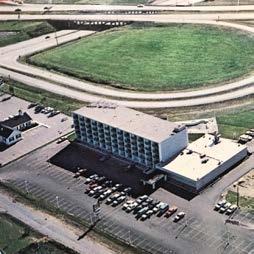
Legacy
By Christopher Hollow
This intense show catches the Experience deep in turmoil Hendrix knew it’d be one of bassist Noel Redding’s last appearances (having already asked old army buddy, Billy Cox, to replace him on tour). The way Redding plays, he knows he’s on the way out too. His sound has a growl and an abandon to it that wasn’t apparent during the band’s meteoric rise. A curmudgeon, Redding plays permanently pushy and pissed off. It’s wild and helps elevate the set, which, at the time, was panned by Pete Johnson in the LA Times Johnson wrote: “If Hendrix has anything serious to say, he is starting late and badly. If he has anything serious left to play, he hid it well.” But he was wrong. What we have here is not the all-tricks-all-atonce spritely combo of 1967s Monterey Pop, where Hendrix was begging the audience to love him. This is a tough, road ravaged, world weary, angry frustrated trio playing slow, hard, and intense. They don’t kick off with a hit to curry favour but rather a 15-minute cover of the instrumental ‘Tax Free’, originally by Swedish duo, Hansson & Karlsson. It serves as an incredible scene setter. Further highlights include two songs I never gravitated towards as a kid but hold Jimi’s very soul at their core. ‘I Don’t Live Today’, his ode to Indigenous Americans and his own Cherokee heritage (‘nothing but existing’) and my pick of his various cosmic origin stories, ‘Spanish Castle Magic’. If you don’t think they say anything, you’re not listening.

FLING II
FLING II
Is there a more intoxicating sound in the rock n’ roll canon than the German motorik beat, the key element at the heart of Kosmische Krautrock? It’s repetitious, it’s joyous, you can load anything on top of it, and it regenerates itself in the most brilliant way. Listening to this record, I know Fling II agree with me. Who are Fling II? Basically, it’s the creation, dare I say die schaffung, of drummer/producer Brad Gowland out of Ann Arbor, Michigan (once home to the Stooges, Bob Seger and Kenny G). This is the softer side of Kosmische. To give a Neu! analogy, this is all Rother, no Dinger. No screams or punk edge here, just lilting, floating, trance-like states all powered by that beat. ‘Misk’ proves the theory. Twelve minutes’ worth of arpeggio’d keyboards laden with phaser that are as potent ten minutes in as they are at two. ‘Glint’ hits the same groove and doesn’t let go. Wunderbar
ALESSANDRO ALESSANDRONI ALESSANDRO PROIBITO (MUSIC FROM RED LIGHT FILMS 1977-1980)

Four Flies
This is a real hot mess, Italianstyle. They say the average foreplay session is 30 minutes (but should be longer), they say the average sex romp is three to seven minutes and anything over 10 minutes is too much (and two minutes is too short). Well, the numbers here match. This comp is 28 minutes (too short) and most of the tracks are two minutes (could be longer). But, like said romps, it’s so much fun trying to get it right. You know Alessandro Alessandroni as the whistler from those iconic Ennio Morricone spaghetti western soundtracks. There’s no whistling here, unfortunately, more biting of lips in a sonic fashion. Collected from four different softcore Italian film scores, Alessandro Proibito is bedroom erotica recorded by a musical auteur on the cheap, in a bedroom. It’d be very believable if a modern hipster had recorded it and assigned this backstory. ‘Lulù 77’, with its lead 12-string, is just interesting enough to put you off your game, ‘Casanova Sintetico’ uses synth where Alessandro once would’ve whistled, while ‘Il Cavaliere Elettrico’ is in the western theatre of music, with its hints of the Bonanza theme, which, I must confess, is not sexy in any way, shape or form. Was it good for you?
86
KING GIZZARD & THE LIZARD
THE JIMI HENDRIX EXPERIENCE LOS ANGELES FORUM:
 ERIK VINCENT HUEY APPALACHIAN GOTHIC Propellor
ERIK VINCENT HUEY APPALACHIAN GOTHIC Propellor

MEXICO CITY CLOSER TO HOME Independent/Bandcamp
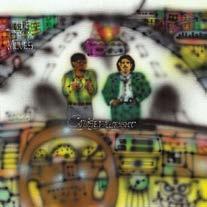
 By Trevor J. Leeden
By Trevor J. Leeden
THE JACK MOVES CRUISERWEIGHT
Everloving Records/Redeye/Planet
EMILY NENNI ON THE RANCH

Normaltown Records/Redeye/Planet
Whilst not a concept album as such, Huey has drawn upon his family’s four generations of West Virginian coal mining as inspiration for his solo debut. Mixing Classic Country with a hard-edged rock underbelly, there are strong sonic overtones of Copperhead Road-era Steve Earle, another native Virginian. Although several songs such as ‘The Devil Is Here In These Hills’ and ‘Death County’ explore darker themes such as the unfortunate legacy of coal mining and Virginia’s horrendous opioid crisis, Huey can still find room for optimism on songs like ‘Winona’ and the delightful Laura Cantrell duet ‘That’s What Jukeboxes Are For’.
THE INTERNATIONAL SUBMARINE BAND SAFE AT HOME

The Brisbane quintet’s fourth album manages to pull off a rare feat. Closer To Home distils elements of altcountry, blues and soul into a roughhewn country rock gem, ragged in its glory and yet evoking that uniquely Australian feeling of the wide-open spaces. Joe Cryle’s pedal steel brings a touch of melancholy to tough songs that resonate with tenderness, epitomised by ‘Better Off Alone’, ‘Country Dark’, and the barnstorming opener ‘Broken Heart’. Mexico City charters the parched terrain where The Dingoes once roamed, uncompromisingly evocative artisans of Oz rock; there’s no higher praise than that.
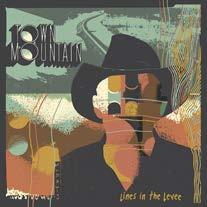
CROW CROW MUSIC
Opening track ‘Lionel Richie’ lays out the Newark duo’s stall, lush strings and a big Philly-soul production. Cruiserweight simmers and shimmers, its retro soul dynamics not coming from the Stax template but instead harking back to the orchestrated sweet soul of Curtis Mayfield, Quincy Jones, and dipping into the vocal gymnastics of early 80’s Michael Jackson. Vocalist/guitarist Zee Desmondes showcases a formidable falsetto on the forementioned ‘Lionel Richie’ and the sultry ‘Six Ways’, whilst drummer Teddy Powell’s vocals on ‘Somebody’s Watching You’ are sublime. Overall, a very funky, latenight R&B soul groove.
DAVE ALVIN ELEVEN ELEVEN Yep Roc/Redeye/Planet
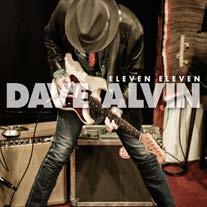
What better place than Nashville for a California girl recording her first album to draw upon good oldtimey Classic Country influences.
Channelling the vocal stylings of Loretta, Dolly and Tammy is a sound decision, and the nine original songs (and one somewhat unusual ABBA tune given a country setting!) tell familiar rhinestone encrusted tales of drinking beer, riding broncos, honky-tonks and pick-up trucks. The band is tight-knit, with special mention to Eddy Dunlap’s soaring pedal steel and dobro.
TOWN MOUNTAIN LINES IN THE LEVEE New West/Redeye/Planet
If there was ever any doubt that Gram Parsons had a “certain something” then this timely reissue of his first full-length album eradicates it. A precursor to his ground-breaking work with The Byrds, The Flying Burrito Brothers and as a soloist, Safe At Home is the sound of Parsons and company as unadorned, pure country troubadours yet to add the extra R&B and rockier ingredients that lay ahead. Yet, between the tasteful covers lie several songs that would remain amongst Parson’s finest, including ‘Luxury Liner’ and ‘Blue Eyes’. Included is a complete alternate version of the album taken from the original masters.
Over the course of three albums, it’s fair to conclude that Crow didn’t find their niche. Their debut album was a maelstrom of stabbing organ, surging Blood Sweat & Tears styled brass flourishes, and rough’n’ready garage rock which reached its zenith on the superb ‘Evil Woman’ (later covered by Black Sabbath and Ike & Tina Turner). Their second and third albums, Crow By Crow and Mosaic (both also reissued), added to their blues-rock bedrock by dabbling in funk and country as the Minneapolis quintet fruitlessly sought to build on their early success.
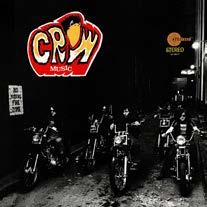
Eleven years after its release seems a perfectly good reason to issue a deluxe remastered edition of what stands as Alvin’s finest album (to date). Alvin has re-sequenced the tracks, including three extra songs, and if that seems unusual it in no way detracts from the package. This is Americana roots rock at its finest, Alvin’s rumbling baritone and searing guitar supported by a who’s who of sidemen including Greg Leisz, Reese Wynans, Bob Glaub, Don Heffington, Gene Taylor, and brother Phil. Incendiary songs like ‘Harlan County Line’, ‘What’s Up With Your Brother’, ’Dirty Nightgown’ and ‘Johnny Ace Is Dead’ now form the core of Alvin’s live shows; Eleven Eleven is simply brilliant.
Although steeped in the bluegrass tradition of their Asheville, North Carolina heritage, Town Mountain’s latest offering diverts into a more countrified honky-tonk sound with a distinctly rocky edge. Although the subject matter is often heavy (think climate crisis, alcoholism, dead-end lifestyle), the sheer ebullience of their rollicking brand of countrygrass leaves little time for despair. The impact of first-time producer Justin Francis (Joshua Hedley, Kacey Musgraves) is evident, the sextet’s sixth album sounding more polished than previous releases, and the three interchangeable lead vocalists is a luxury few contemporaries are able to emulate; it’s not the only similarity between Town Mountain and The Band.
88
Sundazed/Redeye/Planet
Sundazed/Redeye/Planet
BY KEITH GLASS
DAVE GUARD & THE WHISKEYHILL SINGERS
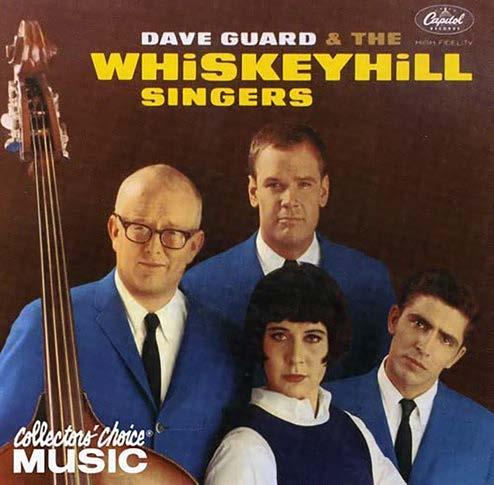
Capitol ST 1726 (Issued 1961)
In the 60’s/70’s/80’s major record labels worldwide maintained a massive album release schedule. Only a comparatively few artists scored a hit, others became ‘cult’ classics. Beyond that exists an underbelly of almost totally ignored work, (much never reissued) that time has been kind to. This is a page for the crate diggers.
Musically speaking, the mid 60’s scene on Australian TV was treated in a fairly lackluster fashion. A few groups and solo artists (mainly miming) on various variety shows, attempts to be more relevant with low budget teen-oriented fare – sometimes OK, often lame. 1965 - Out of the blue and with little or no fanfare came ‘Dave’s Place’ – set in a bar in some quasi tropical location and orchestrated by the ex leader of The Kingston Trio, now Australian resident Dave Guard. There was a house band; vaudeville star Queenie Paul played the comic role of resident bar-fly and a long list of artists - mainly local folkies/jazzers (such as Paul Marks, Kerrilee Male, Don Burrows Quintet, Doug Ashdown) but also imports Sonny Terry & Brownie McGhee, The New Lost City Ramblers, Nina & Frederik. However the standout However, the standout for me as this then impressionable young man was the four-episode stint of bohemian singer Judy Henske.
Her wild beatnik appearance and shouting blues vocals lit up the four (out of thirteen) shows she appeared in and whilst I knew Dave was the predominant figure In The Kingston Trio, I knew nothing of Henske. Turns out Dave & Judy went back a way. Cut to 1961 when Guard felt straight-jacketed by the constraints of ‘success’, the endless touring, making ever less remarkable sound-a-like records with The Trio and riding on the back of their hits. He wanted out (John Stewart was drafted in) and Guard formed the more broadly based Whiskeyhill
Singers firstly with old Hawaiian school friend Cyrus Faryar – who strongly recommended Henske. The fourth member was more local David ‘Buck’ Wheat.
In the album liner notes Guard stresses that all four contributed to the array of material, consisting of a wider variety than his previous group with the added benefit of all four singing lead vocals. Perhaps still aware of the folk world constraints, ‘traditional’ material is well to the fore with such songs as The Banks Of The Ohio, Ride On Railroad Bill and The Wild Rippling Water, Henske touches on the bluesy side with Nobody Knows You When Your Down And Out whilst the only true original is the Dave Wheat co-write We’re The World’s Last Authentic Playboys. Nods to Woody Guthrie/Peggy Seeger and Ewan MacColl remind us this still a folk album but with the premise of the listener walking into some beatnik dive and hearing a no holds barred swinging combo grabbing material from indiscriminate sources and letting it all hang out.
Naturally this bucking the system leap didn’t really go anywhere but that didn’t stop a now unconstrained Guard from trying it again in a foreign country four years later. He apparently had bought a house in Sydney and thankfully contributed this sadly overlooked/under viewed weekly television show to the culture. Check out the full list of contributors online – it is pretty impressive.
Judy Henske went on to make a number of solo albums, first for the Elektra label then others, always being described in the liner notes as wild, long legged, foot stomping etc – the notes to her second album High Flying Bird by the inimitable Shel Silverstein are hilarious, crime writer Andrew Vachss included her as a musical leitmotif in a series of his books. With her first husband Jerry Yester (ex member of The Modern Folk Quartet/Lovin’ Spoonful) she recorded an ambitious original folk/rock/psychedelic album Farewell Aldebaran for Frank Zappa’s ‘Straight’ label in 1969 – on original release near impossible to find.
Judy later married ace session keyboard player Craig Doerge and some interesting (albeit obscure) projects resulted. She died earlier this year at the age of 86. Dave Guard unfortunately left us at the age of 56 back in 1991, reportedly still working on ways to broaden the folk perspective he helped pioneer back in the 50’s. Along with Judy he shares the ‘underappreciated’ claim despite some sizable success. Hey ABC, check those vaults for a re-run of ‘Dave’s Place’.
89
By Jeff Jenkins (no relation)
CHARLES JENKINS
RADIO SKETCHES 2 – THE DEATH OF STARS
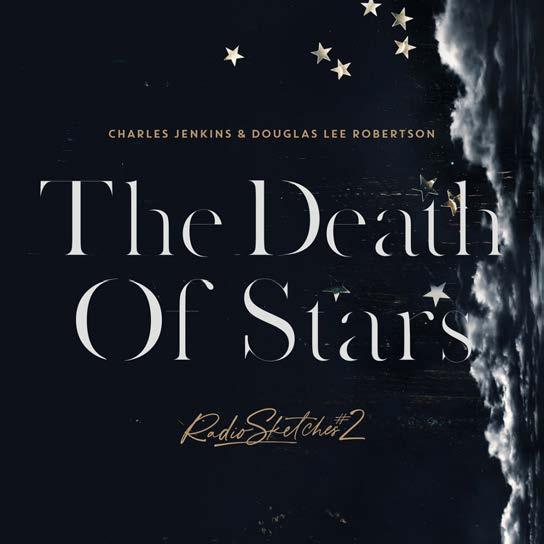 Independent/Bandcamp
Independent/Bandcamp
What’s the saddest song of all time? Split Enz’s ‘I Hope I Never’? Sinead O’Connor’s ‘Nothing Compares 2 U’? Eric Clapton’s ‘Tears In Heaven’?
Anyone who has listened to the Icecream Hands can attest that Charles Jenkins knows how to write a nifty pop tune. But the Melbourne songman is also adept at tugging on your heartstrings. For proof, just check out ‘Autumn Fall’ on his Blue Atlas album, which he often introduces as “the saddest song ever written”.
Jenkins’ new record – his 21st studio album – opens with a track called ‘The Many Moods of Love’. I listened to it on repeat for a whole afternoon. In the end, I wasn’t quite sure what the lyric was about. But I was moved by its sadness every single time. It’s a melancholic minor masterpiece.
For those not familiar with the concept behind the Radio Sketches records: Jenkins does a segment on Jonnie von Goes’ Sunday afternoon show, JVG Radio Method, on Melbourne’s Triple R – “a thematically blended hotchpotch”. The host provides the week’s theme; it’s the singer’s task to write – and record – a new song that will be premiered on that week’s show.
As a prolific and professional songwriter, Jenkins relishes the challenge. “And,” he explains, “JVG provides the two essentials for songwriting – the idea and the deadline.”
The second instalment in the Radio Sketches series sees Jenkins tackle a diverse array of topics, including moods, directions, radio, ponies, my head, my soul, chaos, and “things you were previously unaware of”.
This is a set of songs that’s all about the joy of creation and hearing something on the radio for the very first time. In less-capable hands, these tracks would brighten a Sunday afternoon and then disappear into the radio ether. In ‘The Death of Stars’, Jenkins sings, “I’ve never been the sharpest knife in the rack.” Don’t believe it for a second. Even when faced with a demanding deadline, he never fails to deliver a gem.
And a shout-out to Jenkins’ not-so silent partner, his Icecream Hands compadre Douglas Lee Robertson, who augments Jenkins’ acoustic recordings with drums, bass, guitar, keyboards, strings and backing vocals (check out his glorious gospel choir in ‘Found Me A Highway’). “He’s got the hard job,” Jenkins acknowledges. “The most exciting part of my week is when I get a text from Doug on Saturday that will say, ‘Sending song now.’ I could be in the middle of a major operation, but I’ll say, ‘Doctor, we have to stop.’ That’s the biggest kick I can possibly have, being able to hear what Doug has done to the song.”

If these guys were Swedish, they’d be churning out chart-topping hits and living in mansions. As it is, they’re churning out pop hits – and all we have to do is switch on the radio on a Sunday arvo.
A highlight is ‘Early Evening Shenanigans Again’, a nostalgic romp celebrating the hi-jinks of young men. “We set out to mess about,” Jenkins sings. “Who knows where the time goes?” Long may they run.
During directions week, Jenkins came up with ‘So Many Directions To Choose’, which succinctly documents the eternal songwriting dilemma: “Gonna go left, gonna go right … gonna get lost and get the blues – so many directions to choose.” Yep, a songwriter can be crippled by choice. But Jenkins always seems to make the right call, delivering songs that sound simple and instantly familiar while also surprising with a subtle twist or an unexpected turn.
“I know that the greatest songs will always have an element of surprise,” he notes. “When you think about your favourite songs, there is always some little bit in there that you weren’t expecting.”
From the mournful majesty of ‘The Many Moods of Love’ to the classic guitar pop of ‘Early Evening Shenanigans Again’, this album gently sweeps through the gamut of human emotions.
In the end, Radio Sketches 2 is an understated triumph. A sequel that’s just as good as the original. A happy – and sad – 21st
90
The Death of Stars is available now via Bandcamp.
SAMANTHA FISH FASTER
If you saw Samantha Fish at Bluesfest in 2019 you probably don’t need me to tell you what a dynamic performer she is; her shows were spectacular. The good news is that Samantha is on her way back, with the recent album Faster and an exciting collaboration on the way.
“I was pretty nervous,” recalls Fish who is at her home in New Orleans when we talk via Zoom. “I’d been looking at that lineup since I was a teenager and every year it would come out and I’d go, ‘God, if I could only get on Byron Bay, that would be quite a pat on like that, that would, that would let me know that I’m doing something that I’m supposed to be doing, doing something right. That’s a great festival. It’s awesome. Every, every year I look at it and it’s like knocked it out of the park again.”
Fish’s latest album Faster is produced by Martin Kierszembaum who has worked with Lady Gaga, Sting and Sheryl Crow, amongst others. That in itself should tell you the serious intent of the album. To add to that, Fish is backed by drummer Josh Freese (Guns N’ Roses, Nine Inch Nails, The Replacements), and bassist Diego Navaira (The Last Bandoleros). You would have to think that after eleven albums since 2009, Fish is ready to reach an even bigger audience with this huge slice of blues rock that could just have easily been titled Louder! Ironically, there is a song titled ‘Loud’, but the other side of Fish also makes an appearance on the four ballads that highlight Fish’s powerful voice.

Samantha Fish grew up in Kansas City, Missouri and started out playing the drums, but when she was 15, she switched to guitar, citing Bonnie Raitt and Stevie Ray Vaughan as influences and hearing the Stones album Sticky Fingers as a lightbulb moment. These days Fish lives in New Orleans which is where I first saw her years ago during Jazz Fest.
“I feel very fortunate that they invite me back to these things because it’s pretty massive,” says Fish when I mention that some friends had phoned me to tell me that I had to see Fish. This year she was on the
main stage, and she also features in the recent documentary JazzFest: A New Orleans Story. “It’s a really special, it’s a really special event.”
“I went to New Orleans, JazzFest before I moved here,” recalls Fish. “I was living in Kansas City the first time I came down. New Orleans to me has been a place that I’ve always wanted to put down roots in it really. Because when I look at like the great American cities, New Orleans is just full of romance, it’s poetic, it’s art. There’s a rich culture here. There’s history here and there’s a love of the arts. I find constant inspiration here. I think it’s just one of those places that keeps giving to artists in a way that’s emotional and inspirational.”
“It’s definitely a place that encourages living loud as you can and as loud as you want,” she continues. “We play pretty loud. People say I seem pretty extroverted. I don’t know. It’s weird going on stage and having that connection with the audience. In my life I’m probably more of like a shy person than would be let on by what I do on stagebut I guess it just depends on the day.”
Fish will be back for Bluesfest and other dates with her four-piece band that includes her bass player Ron Johnson, keyboard player Matt Wade from New Jersey, drummer Sarah Tillek.
“They’re pretty loud, when I suggest that they could be called the Louder Band. “I’m probably the, they would probably be rolling their eyes right now at me because they probably think I’m the loudest one up there.”
“I’d say even the album before that got obscured by Covid, Kill or Be Kind,” says Fish when I mention that Faster probably didn’t get the attention it deserved because of the effects of Covid. “It [Kill Or Be Kind] came out in September of 2019, and then by March of 2020 we were done supporting it. Normally you give an album two years. I guess so it got kind of truncated as well. But Faster? This is just the new world we live in. It’s gotten a lot better but we’re still dealing with complications with Covid, even in the manufacturing side of things, like just, just the physical process of making a record is so much more difficult now than it was three years ago. I’m realising it’s like we just have challenges.”
So, what can we expect on the Australian tour? Will Fish be highlighting the last couple of albums, or will she dig deep into her catalogue?
“Because I grew up in the age of the internet and a lot of people have found me through videos on the web, we, we do have a good deal of fans in Australia that have never really gotten to see our show,” she says. “So, my plan is of course we’re going to showcase material from Faster being that it’s the most recent release and Kill Or Be Kind because again it’s another really recent release. But I want to showcase material from all of my records, and I just want to put on a great show that. I want to take people on trip. My priority in Australia is going to be just putting on a good show. I think people will know and recognise something that’s exciting and danceable and gives them something they won’t forget about.”
As for Fish’s forthcoming album? It has been recorded with Texan guitarist Jesse Dayton (a visitor here in late 2022) and is produced by Jon Spencer. “It’s really special and incredible and I can’t wait for people to hear it,” says Fish. We can hardly wait either. In the meantime, you can catch Fish on tour in February.
February 16 - Princess Theatre, Brisbane / February 17 - Lizottes, Newcastle / February 19 - The Basement, Canberra / February 21Freo Social, Perth / February 24 - Memo Music Hall, Melbourne / February 25 - The Gov, Adelaide.
Faster by Samantha Fish is available now through Rounder Records.
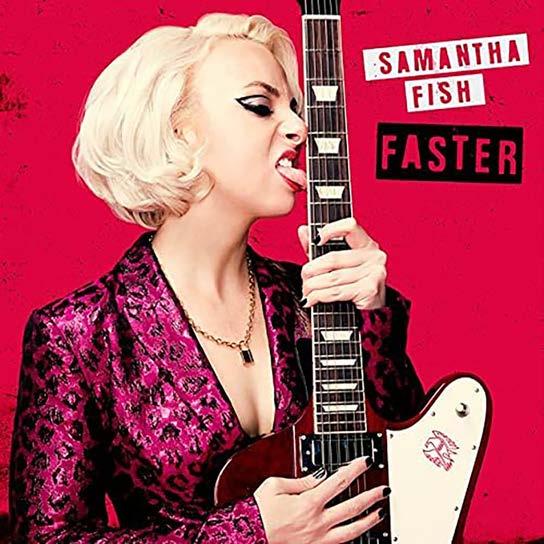
91
Brian
By
Wise
Rounder Records
CHRIS WILSON LANDLOCKED: FAITHLESS & FREE (30th ANNIVERSARY EDITION) Cheersquad Records & Tapes

By the time he left us in January 2019 Chris Wilson had become a dominant figure on the Victorian music scene and one of the most important musicians on the national panorama. While the recently re-released Live At The Continental and the bonus live track included here are ample evidence of Wilson’s dynamic live shows, Landlocked also attests to Wilson’s command in the studio.
Landlocked, originally released in 1992, was co-produced by Wilson, engineer Doug Roberts and guitarist Shane O’Mara, who was to later feature on the landmark Live At The Continental. Musicians included Chris Rogers on bass, drummer Peter Luscombe (these days with Paul Kelly’s band), Jen Anderson (Black Sorrows, Weddings Parties Anything) on violin, ‘Evil’ Graham Lee of the Triffids on pedal steel and Rebecca Barnard (Rebecca’s Empire etc) on backing vocals.
Listening now, Landlocked seems preternaturally mature for a debut album; yet, by the time of its recording Wilson already had vast experience in bands such as Harem Scarem and Crown of Thorns and had recorded with Paul Kelly and Hunters & Collectors. There has also been a recent reissue of Scatter’s Liver an album he made with the short-lived Pub Dogs. So, when he walked into the studio to record this album, that amazing voice was fully formed in its power and range.
One of the remarkable aspects of this album is how accurately Wilson’s voice is captured in all its glory. While you can hear Shane O’Mara’s adventurous excursions on the guitar, the instrumentation enhances the voice rather than obscures it. So, O’Mara is given free rein on a song such as ‘My Little Pony’ but his guitar acts as a counterpoint to Wilson’s voice.
Four years later Wilson was to achieve huge success with Diesel with the album Short Cool Ones, consisting mainly of blues covers; but, after the Long Weekend album in 1998 he was an independent artist. Perhaps this was because commercial radio changed and became less accommodating or because he wasn’t willing to compromise. But it remains commendable that Landlocked was released via a major label’s subsidiary (when major labels could take a few risks!). I suspect that in its new guise it will do even better than in its original incarnation.
While Wilson is most often associated with the blues the musical scope on Landlocked is much wider. The blues influences are obvious, but you can also hear country and rock ‘n’ roll in there as well on songs such as ‘Hard Land,’ ‘Big Mouth Baby’, ‘Tits and Feathers’ and, even on a song that sports the word blues in the title, ‘Alimony Blues.’ These are just some of the really great original songs here. You can add to that list: ‘Wolves,’ ‘Rose Tattoo’, ‘Wreckage’ and the title track which stand out as ‘classics’ in Wilson’s catalogue and extraordinary examples of his craft.
Landlocked - nominated in 1993 for two ARIA Awards (Best Male Artist and Breakthrough Artist, Album) has now been re-packaged as Landlocked: Faithless & Free, a special 30th Anniversary reissue that
see the album released on vinyl for the first time and expands the original 1992 album into a double LP/double CD with the inclusion of tracks from the EPs The Big One and Alimony Blues
The new vinyl double album contains sixteen tracks: the original CD release of twelve tracks, plus covers of The Saints’ ‘Ghost Ships’ and Albert King’s ‘Born Under a Bad Sign’ (one of the best covers of that song ever). There are also two live medleys. There is a fabulous version of Sly & The Family Stone’s ‘Thank You (Falettinme Be Mice Elf Agin)’ with Junior Walker’s ‘Shotgun’, a reminder also that Wilson used to perform an incredible rendition of ‘Nutbush City Limits’ (True!). Add to that Memphis Minnie and Kansas Joe McCoy’s ‘When The Levee Breaks’ with John Lee Hooker›s ‘Burning Hell’.
The double CD also adds four extra tracks: a live recording of ‘Wreckage’, which is quite different to the studio version plus studio recordings of George Gershwin’s ‘Summertime’, a haunting rendition of Bill Withers’ ‘Ain’t No Sunshine’ made even more so by Wilson’s harmonica playing, and the jazz standard ‘Bye Bye Blackbird’. This revisiting of Landlocked shows what a good re-release can be. The original album is supplemented by enough interesting material to make you want to search out other recordings by the artist. In this case, it is a motivation to go and hunt up some of Wilson’s other solo releases - The Long Weekend (1998), Spiderman (2000), King For Day (2002) and Flying Fish (2012) – as a comparison and to see what other great songs are lurking there.
Those who saw Chris Wilson perform at local clubs or at festivals around Australia were left with an unforgettable experience - if not for the power of his voice and his masterful presence and harmonica playing, then for the challenge he gave audiences to get up out of their seats and get involved. In fact, Wilson’s live shows were so impressive that their memory tends to overshadow the fact that he also had a substantial recording career that stands amongst the very best of our local talent.
Landlocked is an absolutely essential addition for fans of Chris Wilson – and one of the best re-releases of the year - but it should also add substantially to his legacy which is being kept alive by his family and Cheersquad Records
92
By Brian Wise
By Steve Bell
SIMON JULIFF STARS


Dog Meat Records
In the third instalment of Francis Ford Coppola’s revered The Godfather trilogy, newly reformed Mafia kingpin Michael Corleone famously quips, “Just when I thought I was out, they pull me back in”, a maxim that could easily apply of late to Melbourne singer-songwriter Simon Juliff.
With a stop-start career tracing right back to his short-lived early-‘90s outfit The Evil Dead, followed by a stint fronting rockers The Roys in the mid-‘00s, in recent times Juliff had pretty much relinquished his musical dreams to focus on career and family. He hadn’t given up music entirely as he was still writing songs, but he’d essentially given up on sharing them with the wider world.
Until one day he received a phone call apropos of nothing from veteran Oz rock music identity Dave Laing, who had a more than decent proposal for his old friend. One which involved not only reviving Laing’s long-dormant indie imprint Dog Meat Records - back in the day home to legendary underground guitar bands like the Powder Monkeys, Hoss, Bored! and Splatterheads - to release the album, but also roping in that scene’s most venerated alumni Joel Silbersher (God, Hoss, Tendrils) to produce the affair.
“I was still writing songs a little bit, but I was fairly busy with my family and just life commitments,” Juliff remembers, “but one day Dave Laing contacted me out of the blue pretty much and said, ‘Are you doing any music?’ And I said, ‘Nah, not really, but I’ve got heaps of songs’. Then he said, ‘Why don’t you ask Joel to produce a solo record and I’ll put it out?’, and I said, ‘Are you drunk?’ And he said, ‘Nah’. “Dave’s always been really supportive and kept up to date with whatever I was doing even if it wasn’t much - and he’d write really nice reviews and articles whenever I did put something out - he was like one of my very few fans, but a good one to have.”
And in particularly perfect timing, this opportunity came right at a stage when Juliff’s family commitments had started to ease and the songs had started to flow again.
“Once the call came and there was an album to make and Joel agreed to produce and helped put the band together and everything, I had to make sure that it wasn’t going to be me that fucked it up,” he laughs. “I finished all the songs really quickly - the ones that were half-finished - and made a bunch of demos and sent Joel 25 songs.
“It was a great feeling actually, having just drifted along missing making music but not really doing anything about it, to have someone make a proposal like that was both surreal and amazing.”
And from these humble beginnings the Simon Jolliff Band was born, the frontman joined by a cast of Oz rock stalwarts to construct their debut album Stars, a powerful collection of songs marrying the classic pop-rock sensibilities of forebears like Big Star and T-Rex with a dirtier, more roughshod aesthetic entirely befitting the Melbourne scene it stemmed from.
“I could have made quite a different record if someone else was choosing the songs, although Joel’s choices were unsurprisingly excellent in that he chose the ones I probably would have chosen anyway,” Juliff smiles. “It could have been an album of ballads and electronic noises if someone else did it.
“Even in assembling the band as he did - Jim Sfetsos from Hoss on guitar, Greg Bainbridge from Kim Salmon & the Surrealists on drums and Joel on bass - there was a lot of scope for the guitar solos and things. Jim wrote little ‘bits’ for each basic solo that I’d included on the demos, and it really suits where each song was going, almost as if it was meant to be.
“Once Joel was the producer I knew it was going to be a ‘guitar-y album’ - which is my kind of album anyway - and we just talked about how say on [1975 album] Tonight’s The Night Neil Young’s approach was to keep the mistakes and just focus on making it feel good.”
Importantly Juliff explains that while he was able to rely on Silbersher’s extensive experience in the studio, it was never at the expense of his own artistic vision.
“One thing that’s important that Joel does is just encourage me in the right direction,” the singer reflects. “There’s no disagreement, because I trust him and I trust his ear. He knows what I like.
“When I called him to ask him to do the project - I hadn’t spoken to him for a while - he answered the phone in the pub and said, ‘Oh yeah, I’d be delighted. I will make sure that you come away with something that you really like’, and I said, ‘Okay, that sounds like a good plan!’
“And he was true to his word. He’s got a really good ear and we let him be the ‘boss’ so to speak and have control across all areas of the recording and even into the mixing, but I didn’t feel in the least bit pushed around - more just ‘helped around’.”
“Stars” is out now on Dog Meat Records. Simon and band launch the album March 4, a Saturday matinee show, at the Workers Club in Fitzroy, with special guest True Sound.
93
PETER FARNAN
HOME Independent
Even for a craftsman as experienced and successful as Melbourne artist Peter Farnan, there’s still an intriguing aura of mystique surrounding the art of songwriting.

After more than 40 years honing his skills at assembling a songfrom the outset of the ‘80s with esteemed post-punks Serious Young Insects, through a lengthy stint pumping out hits for multi-platinum ‘80s/‘90s outfit Boom Crash Opera and then into his ensuing solo career - he’s still never quite certain where his muse is going to take him.

His sterling new solo album, Home, for instance, ended up a beguiling batch of charmingly off-kilter art-pop, but Farnan happily attests that he’d approached the record with a totally different stylistic ambition altogether.
“You start a project with a kind of idea, and this time I thought I was going to start by building beats,” he laughs. “I’d been reading the Beastie Boys book and listening to Rick Rubin’s podcast and I thought, ‘Right, I’m going to build beats, do what Talking Heads did and kind of find the song later on’. I started like that but very quickly that went out the window, and I ended up holding a guitar and writing songs on a guitar.
“It ended up being very traditionally-written, either on a guitar or on a piano, finding the chords, vocalising and finding an angle pretty quickly. I was working pretty quickly the whole time - that’s a great thing about getting older and being a little more confident, just getting the germ of an idea and running with it and then refining rather than second-guessing and questioning.
“It’s ultimately a balance between delivering a satisfying form to the listener, but also putting in surprises or the odd twist and turn. If you completely satisfy expectations it’s boring, and if you completely subvert expectations it becomes art music, something else that isn’t a song. That’s fine too, you can go either way.”
And after years of penning chart hits the singer-songwriter far prefers writing for art’s sake, with the aim being primarily to please himself.
“I found worrying about commercial considerations crippling back in the day, it was just awful,” he admits. “There was a later Boom Crash
Opera record where I threw all of that out the window and it was liberating, it opened everything up again and I felt like I was back at the Crystal Ballroom where there was no commercial imperative. Of course that record stiffed! But it was a real artistic turning point for me and for that band.
“I’m a lot better now because I’ve done so much composing for theatre where there’s a deadline and an opening night - I’ll often be required to come up with something at really short notice - and I’ve found writing really quickly and working to a brief really liberating. It’s actually easier to write that way than trying to write a megahit for some enormo corporate rock monster!
“Another challenge with this record has been trying to work out what I’m going to say and how I’m going to interface the broader worldwhich is really tilting on its axis at the moment - with the personal, and how do I make it moving without it starting to proselytise? How do I get those political and personal aspects working together?
“I look at those songs now and recognise that it’s very much what I think and feel about myself and the world at the moment. It’s all rolled into the title track ‘Home’, which is about domestically where I live but I’m also concerned about other people who don’t have a home, or who are trying to find a home or fleeing because they have to flee. Once again it’s trying to weave what I think about politics with just the life I’m leading and the fact that I’m older and that time is constantly rushing ahead”.
Throughout Home Farnan achieves that wonderful dichotomy of broaching serious issues lyrically but framing them in fun, sometimes even whimsical, song structures and arrangements.
“I just have this feeling that good songs and good art has to have woven into it this sense of humour and playfulness as well,” he smiles.
“There is heavy stuff on the record - that song ‘Holy Water Cross Myself’ doesn’t pull any punches, it’s not jokey - but I love humour and feel that there needs to be a sense of self-deprecation, that I’m aware of my own shortcomings.
“Like on the song ‘Asteroid’ I take the piss out of my own songs - “How many sins will you admit? Your feeble wit, your ‘80s hits?” - but I’m not trying to write novelty songs. The problem with novelty songs is that you hear them once and they’re hilarious, and then you don’t need to hear them again because it’s like knowing the punchline of a joke.
“One guy who does it really well, in my opinion, is Tom Waits. His funny songs I can listen to over and over again, like ‘I’ll Take New York’ from [1987 album] Franks Wild Years breaks me up every time, I think he’s a scream.”
By Steve Bell
“As much description as you can, in the least amount of words,” is a sentence scrawled in one of my notebooks. I found it the other day, finally, as I flicked through the handful sitting on my desk trying to find my initial notes for this story.
I didn’t utter these words, Jimmy Dowling did. The reason they’re in my notebook is because the interview was finished but we’d retired from the open and sun-dappled front beer garden where I’d been recording, to the slightly less salubrious smoking area out the back of the Bruns pub but Dowling had kept on talking and so I scrambled to capture the bits and pieces he let slip now we were, for all intents and purposes, off the record. Although not really. One gets the impression Dowling doesn’t think about the record.
“A very special album,” is also written on the same page, and this is a quote, via Dowling, from Don Walker. Dowling had sent Walker a copy of his latest record, The Water, and Don had said it was a very special album. “That’s about the bar right there,” Dowling said after he’d mentioned this, looking out into the carpark as he said it. Walker had played piano on a couple of tracks off Dowling’s last release, 2021’s Sociable Sounds. He’d not appeared on this one, but Dowling, for obvious reasons, values his opinion.
The Water came together quickly and easily. Like the movement of water, perhaps, although much like any movement of water, there’s always more to it than what’s merely in front of you. “The water always wins,” Dowling had said earlier as we looked over the Brunswick River from our vantage point at a shiny wooden table pressed against the pub’s leafy front façade. This was another quote from elsewhere, one mentioned to him by an old mate, back earlier this year when the floods came. It was supposed to be the title for this record, but Dowling shortened it at the last moment to The Water. “I didn’t want to be preaching to anyone,” he says as he sips at his light beer and watches the condensation oodle down the bottle green glass.
The Water is a collection of ten songs. Ten brief moments in time that capture far more than their brevity suggests; a lot of description in very few words. It was recorded in Melbourne over the course of a weekend at the studio of Roger Bergodaz, who not only afforded his space to Dowling, but played drums too. Also in attendance were Matt Walker (with whom Dowling has had a solid association), Steve Hadley, Garrett Costigan, Dean Drouillard and Reuben Legge. Says Legge of the album (relayed to me via a text from Dowling, who in turn had received it as a text from Legge):
By Samuel J.Fell
JIMMY DOWLING WATER WORLD Independent

“One of the remarkable things about Jimmy’s music is how beloved it is by musicians. All of us have known Jimmy for a while and were keen to be a part of the project, regardless of the outcomes, just to hear what he would create next… It would be hard to pick a defining moment because the entire session was filled with excited creative energy, as several songs were written by Jimmy in the booth as the band improvised some swirling musical textures.”
Dowling’s songs on The Water are like musings. On life and whatnot. Whatever enters his head. His delivery is Jimmy unique – it’s not sweet and fluid, but half spoken-word, half gravel-croon. It’s not pretty but it works and the lyrics are simple and full, a more laconic Tom Waits or a more sober Charles Bukowski. Or just Jimmy. Outside of his songs, Dowling doesn’t talk too much; he’s not bored or offended or arrogant or rude. I think he just isn’t that comfortable talking about himself. He’s made some changes in his life over the past few years and it seems he sees things as more important than himself now. Jimmy Dowling says more through his songs anyway.
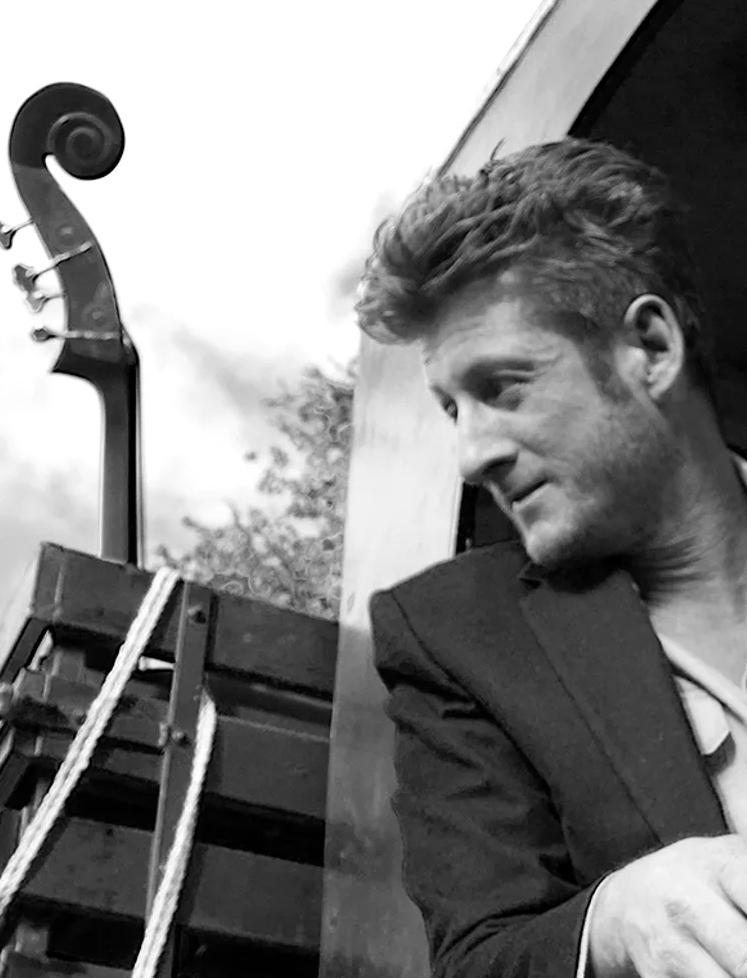
Later on, smoking over the carpark, I ask him, referring to the ‘bar ’ that is the songwriting of Don Walker, if he ever writes to the bar. Does he think about someone like Don Walker singing his praises? “No,” he says after a moment’s thought. “It’s just gotta sound good to me.”
“We tried to match his lyrical tapestry weaving with our musical choices,” Legge’s text message concludes, “and I think the end result was even better than I’d hoped.”
The Water is available in digital format only via www.jimmydowling.com through MGM.
With his latest release, The Water, Jimmy Dowling lets the songs do the talking.
By Chris Lambie
Independent W
hen folk duo The Maes looked to replace their long-time ‘third string’ to their bows, Monique Clare fitted the bill like few others. The Queenslander laughs, “Their ‘Australian young female singing folk cellist’ had just left. It was serendipitous because I was free at that point. I’d started my own solo project and released my EP, so I was able to go on tour with them.” Clare is happiest when she’s busy. “It suits me well to go on a bit of an adventure. I handle that better than sitting in front of a laptop organising things... On tour with The Maes, we played nine shows in nine days in Ireland. I flew to Melbourne a few hours after our last show in Dublin and got driven halfway to Warburton. We had to go back to the airport because I’d picked up the wrong luggage. Then, back to Warburton for a teaching gig at Stringmania. As I arrived, one tutor had just finished a performance and I tuned up my cello and [went on].”
Clare’s EP By The Stars was an intentionally stripped-back collection of cello and voice. In contrast, new album Sight is as “an explosion of everything onto this canvas I loved in music.” Between lush and layered tracks, sparse moments represent the side of Clare that recalls Joanna Newsome’s most serene moods. “No matter how big an audience or a stage, I love to feel very, very close to people, that intimacy. I wanted an element of that in the album.” Cello is an uncommon choice for young musicians. Perhaps flute would’ve been a less-cumbersome touring option. Clare laughs, “Thanks for identifying that. I sort of wish someone had warned me.
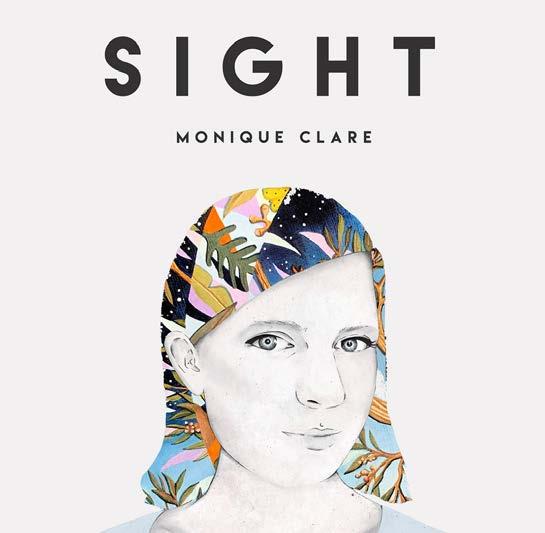
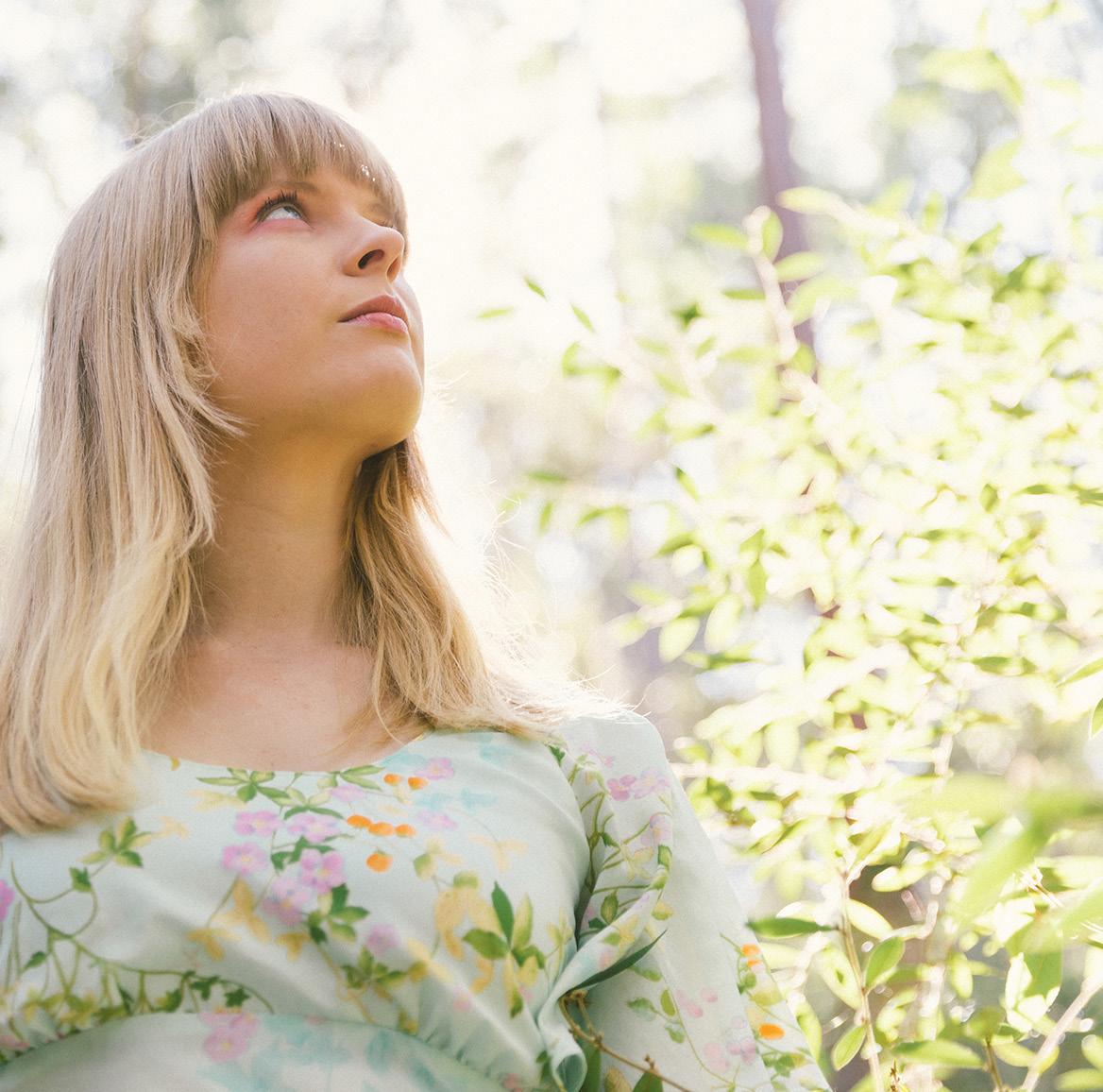
Would I have changed? I don’t think so because I love the cello.” Growing up, she first played the trumpet. But her grandfather prompted the change. “He was a violinist. I think he really wanted his granddaughters to keep that tradition going. He bought some baby violins and planted them in the living room. I’d pick one up and put it down like a cello - intuitively drawn to playing that way. When I was young, my dad always had ABC Classic FM on the radio. I was immediately pulled into the sound of the cello. My parents made me learn the piano first. It makes you hungrier for [what you want].” Along with singing in choirs from an early age, it was an organic start to life in music. Clare sings and plays trumpet, violins and cello on Sight Guests are drummer Locky Hawkins, Loni Fitzpatrick (harp) and Rob Davidson (double bass). Demonstrating that she can play cello fast, the track ‘It Works’ features Annabelle Swainston’s violin and Bec Meimaris drumming.
“I went through my classical degree at the Queensland Conservatorium on cello. I wanted to work on a more modern, contemporary folk repertoire. But there was no folk academy here. Teachers would say, ‘This is a classical degree’. But it led to special pathways, like playing in the Australian Youth Orchestra. It was a privilege to be considered among the Top 10 cellists in Australian under 25.”
Clare’s passion for richly textured composition extends beyond the classical. “I became aware of Björk s music and the kind of orchestrations she uses. Florence + The Machine and Adele have so much orchestral sound in their recordings.” Realising a need to selfproduce, she worked with sound engineer Luke Woollett. “He was very encouraging and facilitating. He allowed me to try my arrangements and be in charge, enabling ideas to flow.” The storytelling aspect of songwriting has grown to increasingly shape Clare’s songs. The title track speaks to the meandering path of mental health. Others poetically reflect on work/life balance, gratitude and connection to land, guilt and self-forgiveness, long-distance love and sharing belly laughs with friends. On ‘Young Girl’, she longs to reassure her struggling teenage self. Currently investigating a likely diagnosis of ADHD, Clare is starting to understand – and embrace – her drive for a myriad of experience to feed her creativity. From teaching cello in Afghanistan, accompanying Kate Miller-Heidke and Eminem on stage and mountainside sunrise concerts, she’s unafraid to take on the unexpected. She’ll soon travel again. “My partner is in America, so part of my life is there. I’m not trying to be someone jumping over, chasing an American dream.” But with her upcoming showcase at the Folk Alliance conference there, the possibilities are endless.
96
CLARE SIGHT
MONIQUE
CHARLES MARSHALL
TEARS OF THE MINOTAUR Laneway Music
They’ve probably always been with us. Shamen, witch doctors, magicians, storytellers. Those who somehow tap into the desire of humans to transmogrify, to transcend our basic, at times tawdry, human existence and look beyond, or within, to the possibilities. Alchemists, stargazers and scientists tried to make sense of the world through trial-and-error, dreaming big, and sometimes uncovering a version of the truth.
The rock and roll era brought new archetypes – the most thrilling and stirring of these resonated with their audience on an almost primal level, effectively losing control (or seeming to) in the service of their art. Think of Elvis, and the impact his persona had –and still has – on tens of thousands, losing control and skirting the brink of a delicious mania, threatening (or promising) to take the listener with them. Jim Morrison, James Brown, Nick Cave… there were many entry points to this ‘other’ world inside the music.
For the young Christopher Marshall, that ‘door’, that catalyst, that call-to-arms was the appearance of Iggy Pop on ABC-TV’s pop bible Countdown, goading the host Ian Meldrum, then writhing and flailing with the pronouncement “I’m bored”. He was dangerous, he was physical, he was hilarious, and totally unexpected in the 70s suburban Australian landscape, for many at that stage without the context of his provenance with The Stooges.
“It changed my life. Everyone at school the next day was saying ‘did you see that weirdo guy?’, and I was thinking, actually, that was really cool. It really opened it up for me.”
Christopher Marshall, along with his brother Charles, grew up in a typical Melbourne suburb and were inspired to start creating music by the contemporary bands they heard, later mixing in other more obscure influences.
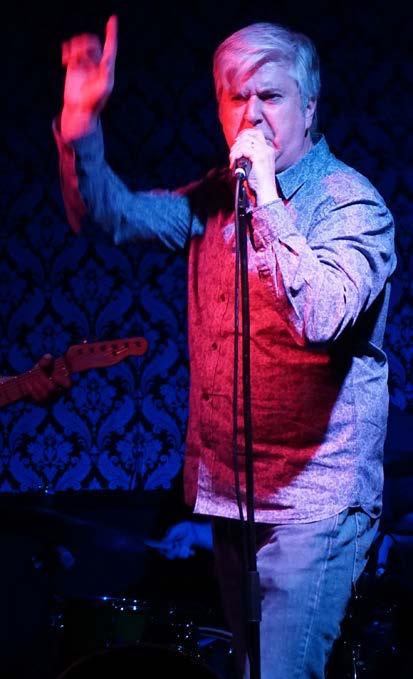
“I remember seeing The Angels, Models, and Midnight Oil at Festival Hall and being blown away by The Angels’ sense of theatricality and Doc Neeson’s take-no-prisoners attitude. Rose Tattoo, wow. One of the first songs we tried to play was ‘We Can’t Be Beaten’. And The Saints – the journey they went through from being a punk band to exploring what punk could be with Prehistoric Sounds. ‘96
By Kerrie Hickin
Tears’ by Question Mark and the Mysterians is still one of the toughest, coolest recordings of all time to my ears. It showed me what can be done, that there’s no usefulness in categorising things, labelling things – it’s just music and you can take it where you want to go.”
The Marshall brothers formed Harem Scarem in the 1980s, quickly falling in with the St Kilda post-punk live scene, and impressing with their gutsy, impassioned performances and impossible-to-pin-down sound. They followed the mini-album Dogman by what many would claim as their finest moment, Pilgrim’s Progress in 1986. The music retains a timeless quality – songs written a number of decades ago sound fresh and alive.
After Harem Scarem initially split, Marshall performed occasionally, and released a solo record titled Strange Waters, Small Mercies (featuring the sublime single ‘Kiss Me Ether’ which really showed off his vocal and emotional range).
“My project in music, if you want to call it that, is to reconnect to the feeling of the blues on a very deep and primal level of emotion rather than to the actual formula of the blues in a more specifically recognisable stylistic level. It’s not straight blues. I love blues but I’m not interested in being a ‘blues’ musician. I hate all those little niche-y genres where people earnestly try to sound like other things. Because the original guys did it better. You can’t be John Lee Hooker. We learned that very early on – no one sounds like him, but maybe you could tap into the emotion and make something of your own.”
Now, Christopher Marshall is back with a new band, The Christopher Marshall Predestination, along with guitarist Baz Turnbull, bassist Andy Papadopoulos and drummer Luke Collins. The fire and depth that characterised Marshall’s earlier performances is still in force, the physicality of the stage presence tinged with moments of humour, his gathering maturity a natural element of the complex evolving character. “I’m pressing reboot with this band. I’m interested in finding sonic light and shade, simplicity and clarity, bring it right down then turn it around and blow the speakers out, see what happens next. I’m playing with some of the best, including brilliant guitarist Baz Turnbull – he’s a bit of a man of mystery, and he has a beautiful clear but improvisational sound, a sound that I can sculpt. This band has the potential for classic simplicity and tonal shading that I really enjoy. Every live performance is so different and beautifully unpredictable, the weirdest and most interesting things can happen as a result of chance or mishap.”
Where does the ‘predestination’ come into it?
“It’s a name that conjures up quite a few of the things I’m interested in. Predestination is a weird theological position where God
preordained where you would go, even before you were conceived. Why should God make so many flawed people and then not give them the free will to change? This is me being wilfully irresponsible and following my own path. I’m very interested in things that don’t make linear sense. I really like intuitive knowledge, the esoteric, the occult, the weirder aspects of religion, mystery not clarity. What I like about the idea is the past and the present are in relation to each other – they all come together. So, in that sense I am predestined to return to the stage, even though I left it a long time ago… or it could have just been yesterday.”
The new songs take these concepts up a notch, melding mythology, history, surrealism, and psychology grafted onto a rock songwriting structure.
“I’m not interested in writing conventional love songs. My songs contain a lot of characters and vignettes. I have one about the severed head of John The Baptist, one about Theseus killing but loving the Minotaur and being a little bit conflicted about that. I’m interested in exploring. Great songs don’t really make sense, but they do at a very deep level. The setting of the music to the lyrics creates a fourth space for you the listener, like a landscape that you sonically inhabit. The singer is the voice that takes you on the journey through that landscape. It’s not a linear, rational journey A to B to C, it’s leading you through moods, and the strange conjunction of words and music to put you into another headspace.”
Tears Of The Minotaur is released through Laneway Music
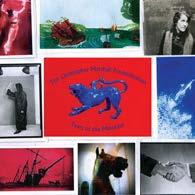 Christopher Marshall.
Christopher Marshall.
97
Photo by Dominic Marshall.
CIMAFUNK
EL ALIMENTO

Thirty Tigers/Terapia Productions
Charismatic prince of Afro-Cuban rhythms, Cimafunk generates a fiesta wherever he goes. An outdoor gig in Miami last October was no exception. Ticketholders were undeterred by hurricane warnings that day. Residents hunkered down at home. But fans of ‘Cima’ gathered to party on regardless. The evening culminated in a ‘stage invasion’ dance party, according to my sound engineer mate from the venue. (“So much energy!”) You really can’t stop the funk! Cimafunk (born Erik Iglesias Rodriguez) was raised in Pinar del Rio in western Cuba. From singing in church, he later experimented with reggaeton and Cuban-style trova. Initially training to become a doctor, he switched to focus on the healing power of music. Drawn to Havana’s funk scene, he joined various bands before going solo. His stage name honours the ‘cimarrones’, a term describing Africans who escaped enslavement in Cuba to form walled communities for protection. Undeniably a magnetic frontman, his story and his music are centred around community. With sizzling band La Tribu (‘the tribe’) it’s a collective celebration, from studio to stage. “It’s healthy. For me, great,” he says. “I grew up in a house with a lot of people around, so it’s being home. Sharing.” He ties fresh musical influences to the traditional. “At first, I felt a bit nervous being from Cuba, doing this music, singing in Spanish. People have in mind the Cuban music is [a certain style]. That’s a really crazy scene, when I think I arrived in the States doing funky music. But also, something I’m just going to enjoy. I feel like what I do is groovy, so I do the groove and enjoy the show. After playing two times, I realised everybody is the same – groovy too. Everybody was jamming everywhere, even if they don’t understand the lyrics. We go with the flow.”
Soul, Rumba, blues and funk unite effortlessly through Cima’s work. “Mostly, growing up we listened to Cuban music. We know what we do when it comes to Cuban groove. You feel it. Feel safe. Many members of La Tribu arrived direct from school to my band. Even our trombone player Lydia was working with me before she graduated. So, getting into the vibe of sharing with the band but also listening to new music and paying more attention to the resources.” His latest album El Alimento brings together the funkiest of grooves from across generations. Breakout hits of the 70s and 80s gave the world a taste of distinctive Caribbean and Afro-Latin rhythms. Hearing pioneers
of rocksteady, dancehall and reggaeton sounds, I certainly had no idea of the cultural roots behind them. “That’s what happens,” Cima says. “I didn’t know either. Then once I started to investigate, I got even more obsessed. These people were doing this, in this moment in history. Dealing with all the madness in the world at the time. Everybody was saying something. The music of that time is the music of today, just with different textures. We cook it in different ways. All the history of Marvin Gaye, Beny Moré… a huge universe of feeling, sensation and historical moments in the groove. Talking about love, politics, myself, society…everything.”
El Alimento boasts a guest list as impressive as it is diverse: Producer Jack Splash (Kendrick Lamar, Alicia Keys, John Legend); US hip hop stars Lupe Fiasco and CeeLo Green; Jamaican dancehall singer Stylo G; Afro-Colombian hip hop group ChocQuibTown; Cuban jazz legend Chucho Valdes; Rumba group Los Papines and AfroCuban rapper El Micha. Opening track ‘Funk Aspirin’ features Parliament Funkadelic icon George Clinton. “In Miami, Chucho and George shared the stage with us. A dream come true. Having them jamming with me, supporting, advising about the music… it was a really special moment of my life.” Musicianship is top class and tight but the mood is loose and inviting. “The band is the family. We enjoy every single moment of being in the music.”
“I’ve been on an amazing journey with Chucho, Lupe and all these guys. This album has been a real gift for me. If anyone told me two years ago, that I’d be working with Jack Splash, I wouldn’t believe it. He’s a really important producer. We have a lot in common. We started talking by phone before the recording. I shared with him Afro-Cuban music and he really got into it. We’ve heard these kinds of rhythms since always, the timba kind of mix Chucho is doing. You feel it, something familiar. Jack would send me a groove and I’d put in ideas for basslines, horns etc. He was super open to receive any creative ideas. I’d always produced my own music. I thought it would be hard, working with another producer being the head of production. But Jack is a special producer and musician but more than that, as a person. We got together and it was, ‘Yes Yes Yes!’ When you jam on stage and see the people in that moment when they get in that tribal state… That groove where you can elaborate rhythms, change the rhythms, based on the reaction in that high moment, it’s great.”
“I can’t spend too much time without playing. That’s why the album is called El Alimento– it means ‘the nutrition’. I’m always making some noise.” He laughs and scats freely. “It never lets you go. Once we get together, there’s no fear. You’re just ready to enjoy. It’s the best moment of the week. I’m real excited to come to Australia. I’m ready!” he laughs. “Get ready! Get ready!”

By Chris Lambie
98
Afootloose road trip to the coast sets up the perfect backdrop for a daydream. Anticipation, memories and imagination flow as you approach a world away from the day-to-day grind. Singersongwriter Don Hillman finds peace, joy and inspiration from landscape and the elements.
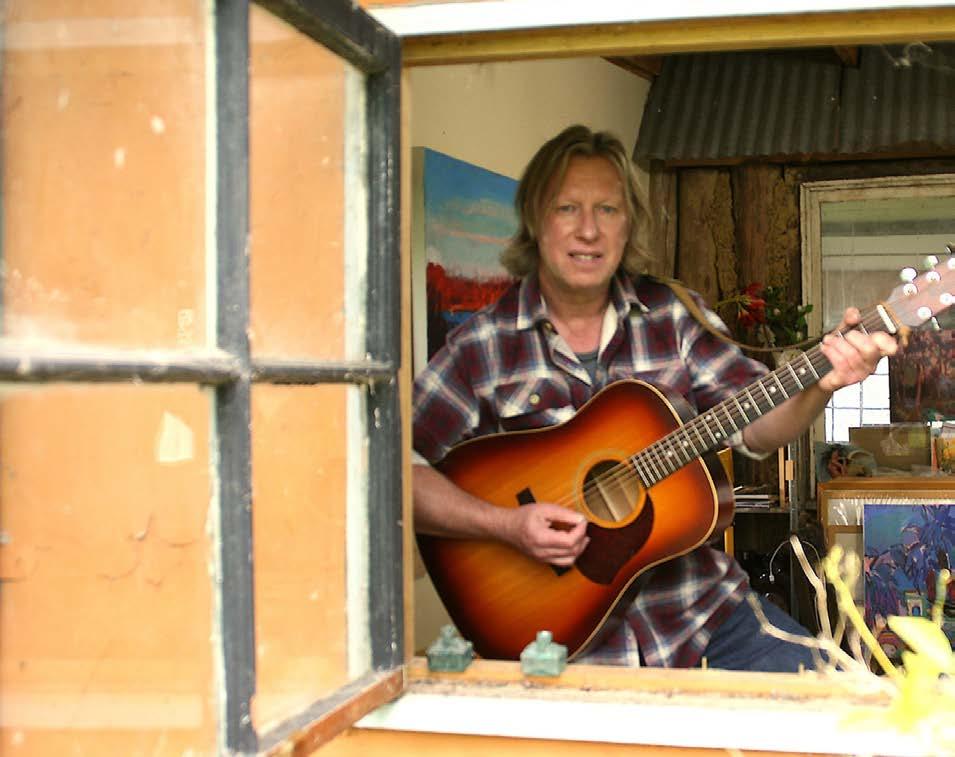
Surfing is a dominant passion in Hillman’s world. A resident of Victoria’s surf coast, he says, “It’s good for going over songs in your head.” His long-time band is called Secret Beach after a treasured location. “That’s what the song ‘Gypsy Station Wagon’ is about. We used to go to Southern NSW every summer to avoid the crowds at home. There’s a secret spot south of Narooma where the beach is deserted between Christmas and New Year.” The track ‘Rollin Waves Forever’ celebrates summer escapes, with plaintive pedal steel by Garrett Costigan evoking the longing to share carefree time with friends. Hillman describes the colours and sounds, the waves, wind and rain - all part of the inviting picture. Hillman is equally stirred by the outback. “I was doing a fair bit of landscape painting at one point and in 1995, I camped out in the Kimberly by myself for a couple of weeks. An amazing experience. When I left, it felt like leaving a friend. A sort of a taste of what First Australians feel, I guess. On country. It takes on its own personality. Where it’s more stark, you can’t be attached to any man-made structures. All you’ve got is the natural environment. In 2016, I went back to the spot I’d camped and couldn’t believe how emotional it was. You think there’s nothing there. But you stop and walk up a sand dune and see all these plants and animals and heaps going on.”

Early on, Hillman was a fan of John Denver. “He sang about the environment, and I really liked that,” he says. “I was into The Beatles and Creedence. Then, before I really knew who Bob Dylan was, I won 10 albums off a radio show. [Each album] was like different people almost. In a bit of an overreaction, I gave away heaps of my Beatles albums because I thought they were rubbish,” he laughs. “I’ve changed my mind
By
of course. But Dylan’s lyrics were so rich. I remember hearing ‘Hurricane’ coming on the radio when I was a teenager and used to change the station; this guy moaning away… But once you put in the lyric content, it’s a miracle!”
During lockdown, Hillman revisited songs he’d written in recent years. “About trips to Europe when I was much younger, hitch-hiking around Spain and across America. I’d written a song about busking and the challenge of that. The idealistic hopes and dreams young musicians have starting out. When I was busking, you didn’t have to have a licence. I remember just turning up and competing with the Bourke Street trams. No amplification, playing Dylan covers with harmonica and guitar. In America, I played at Gerde’s Folk City, where Bob played his first gig. In Melbourne I was a bit of a novelty, but to go there on open mic night, three-quarters of the acts were Dylan imitators. I thought, ‘I’d better come up with something more than that!’ But you can’t help but be influenced.” Classic folk influences can be heard in tracks on Daydreamin but with a distinct contemporary Australian flavour. Like Hillman’s heroes such as Richard Clapton and The Dingoes, upbeat rock notes, and sprinklings of alt-Country blues bring the goodtime rhythms home. Somewhere in the paddock between Stars and Paul Kelly, ‘Invincible’ is made for dancing. Hillman’s voice echo that relatable, authentic local timbre.
Following his 1998 debut release, Hillman has been joined by Secret Beach with Rossco Clarke (lead guitar), Keiran Dickson (bass, bvs) and Peter Mullins (drums, bvs). “I been playing live with them for 20 years now. They’re friends of mine and really fun to play with.” A different line-up was assembled for the new studio work. “For the last couple of albums, I’ve recorded with Marcel Yammouni” The bass player/guitarist co-produced and engineered Daydreamin. “John Salerno is on drums. He and Marcel played in Vanessa Amorosi’s band. Both are hot shot prodigious players and lovely people. Johnny’s played with Sting, in Jon Stevens and Richard Clapton’s regular bands and played drums with Robbie Williams at the AFL Grand Final.” Also on the album are Bruce Haymes (keyboards), Jeff Raglus (trumpet, flugelhorn) and Olivia Nathan (backing vocals). “Hopefully we’ll also have a new recording with Secret Beach out next year. It’s already half done.”
DON HILLMAN DAYDREAMIN’ Independent 99
Chris Lambie





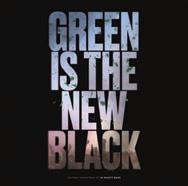


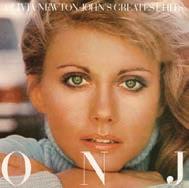
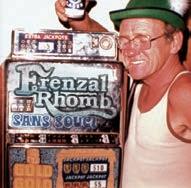



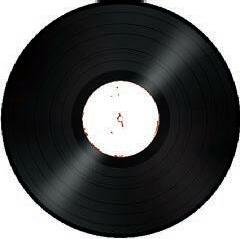
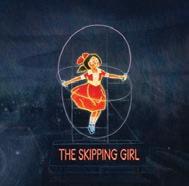



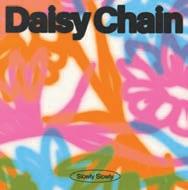
 By Michael Smith
By Michael Smith
JOSIE LAVER
Available on all platforms
Behind every great songwriter is a deep reverence for those who came before, and more often than not, that begins with the music that was available in the family home growing up. Josie Laver might be being touted as the new, fresh voice of Australian country music, but there’s a lot more going on on her debut album, Ride This Lullaby, than the obvious country references.
“I guess I have a really broad range of music that I like,” she explains, “and it doesn’t really matter where it comes from. One of my first gigs was in a jazz bar in Yass, so I’d learnt all these jazz songs and I don’t know if you’d call Norah Jones full jazz but she’s very much along that ilk but I’d sing her songs and I’d sing Eva Cassidy and Patty Griffin, Gillian Welch, Linda Ronstadt, Bonnie Raitt – I’d sing all those sort of covers – and then I’d go into things like David Grey. So, it never stops at one thing. Kasey Chambers – I cover her songs. Her song ‘Pony’, I sang that when I was ten or even younger. I had a full band behind me for the school concert,” she giggles at the recollection. “I was so little too.
“Then Mum and Dad brought us up on Paul Kelly was really big in the household and Creedence Clearwater was big. We got introduced to the Beatles probably in our early teens and then I discovered the Rolling Stones. Dad loves Sara Storer. Lucinda Williams was another big influence and people like kd lang.”
Josie grew up on a farm near Boorowa, up on the high plains of southern New South Wales – the family was lucky; their property was above the level of the floods that hit the area in November 2022 – and while she loved her music, it was horses and show-jumping that were her initial passions, prompting her to drop out of school to pursue showjumping professionally. Eventually, however, the music was always going to rise to the surface again and, as her press bio puts it, “burnt out from the long hours, hard work and injuries that come with the equestrian lifestyle, she moved back to her family farm, sold her horses and saddles to buy a guitar, and began working on what’s become her debut album.
Now, life on the farm might be great for the fresh air and healthy lifestyle, but it means there aren’t a lot of likeminded people around to bounce ideas off when you’re writing songs. In fact, as you read this, Josie is still looking around for musicians, a scarce commodity out her way, to put a band together to take the album on the road. So, the catalyst for recording Ride This Lullaby was a singer-songwriter and expat New Zealander named Matt Joe Gow, based these days in Melbourne, more than 600 kilometres southwest of Boorowa. Gow, by the way, won the 2018 Music Victoria Award for Best Country Album for his second album, Break, Rattle and Roll “It just sort of happened,” Josie admits. “We kind of met by correspondence and were planning to meet each other at a gig he had up in New South Wales and of course COVID happened and all that got called off, but we kept on talking. He liked my sound and where it could go and he asked me if I’d ever thought about releasing any music and pretty much offered his services.”
So began the process of collaboration that saw the pair sending sound files back and forth as Gow helped develop and arrange songs while he and his former band The Dead Leaves’ guitarist Andrew Pollock, who also engineered and mastered it, laid down backing tracks.
“He was the first person I ever shared any music with,” she explains, “and that was a bit scary for me because I originally thought I was baring my soul to the world! But then I decided no, words are words, and people write all the time and do it a lot more seriously than I do it. But he and Andy had similar music tastes as me, so I felt like I could trust them to understand the sort of sound that I wanted on the album. Matt more helped me structure them I suppose. I did all the heavy lifting with the writing on most of them – they all just came from my roots I guess. For instance, in ‘Honey Moon’ I originally wrote ‘we’re on our honeymoon’, but Matt changed it to ‘where are you Honey Moon’. ‘Dandelion White’, we wanted a Fleetwood Mac kind of vibe and it gives that off a little bit. Fleetwood were always a big influence for me too, that more poppy, dreamy sound.”
Gow also joins Josie in a couple of duets on the album, ‘Little Blonde Devil’ and ‘Love Me Still’, the latter a song principally written by Gow. “He had ‘Love Me Still’ quite upbeat, and when he sent it to me, I immediately got on the piano and slowed it down and sent the voice memo back to him and he liked the slower style. I think for him it was always going to be a duet. ‘Little Blonde Devil’ is two people talking to one another so he always thought that was a duet. I started writing that during lock-down because he and I hadn’t met so I based it on the scenario of not knowing someone and imagining what they would be like, but then you meet them and maybe they’re not what you expect. “I wrote ‘Seeing Red’ a few years ago. I’d broken up with a boyfriend and I was mad. Anyway, this just came out one night and I wrote the rest of the lyrics. ‘Tangled’ was the first single that we released and was one of the first songs I sent to Matt down in Melbourne. It was very much inspired by ‘In Spite of Ourselves’, the song John Prine wrote with Iris DeMent. I really love that song. It always reminded me of mum and dad sort of. When I started writing that ‘Tangled’ song it was meant to be for mum and dad but Matt took the line ‘come on baby don’t be lazy, let’s get tangled all night’ or something and turned it into the chorus and then it turned into a bit more of a, like, ‘dirty love song’,” she giggles, “which to me is what ‘Tangled’ is a little bit.”
The closest Josie gets to horses on Ride This Lullaby is ‘Mustang’, but that’s the car, not the four-legged beastie! But she’s already writing for her second album and assures me horses get a look-in on a couple of them, though maybe not showjumpers.

RIDE THIS LULLABY
101
ALBUMS: General
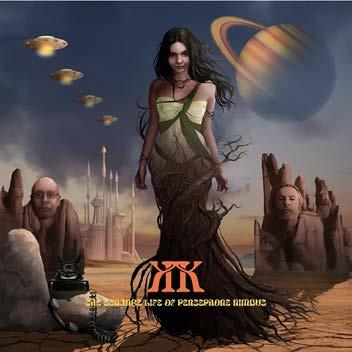
 DEXYS MIDNIGHT RUNNERS TOO-RYE-AY (AS IT SHOULD HAVE SOUNDED) Mercury Records
DEXYS MIDNIGHT RUNNERS TOO-RYE-AY (AS IT SHOULD HAVE SOUNDED) Mercury Records
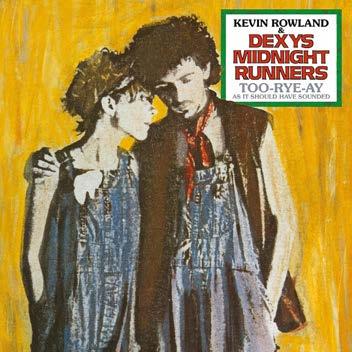
TREVOR J. LEEDEN KILBEY/KENNEDY THE STRANGE LIFE OF PERSEPHONE NIMBUS Foghorn Records/MGM
really matter. It’s the mood, the atmosphere, the evocative nature of the sounds that really carry the listener forward, that and Kilbey’s voice, aided here and there by guest vocalist Leona Gray, on ‘Goldmund & Narcissus’. There’s even a non-narrative-connected ‘Bonus Track”. Just drift away with this Strange Life, mostly harmless.
MICHAEL SMITH
JOE MEEK TEA CHEST TAPES: THE TELSTAR STORY Cherry Red

Who ever knew that a bona fide 80’s masterpiece was not the finished product its principal creator envisioned. Dexys first incarnation was a big brass-driven band uniformly clad in dockworkers attire that prefaced their horn driven hard edged soul. Riven by financial and personal issues, and after a massive first hit (“Geno”), they imploded, and Kevin Rowland embarked on his vision of a unique Irish soul sound that still featured horns but also injected strings and other traditional folk instruments; a change of attire to rag-tag gypsy chic completed the transformation, and the Celtic Soul Brothers were ready to storm the barricades. All bar their record company agreed on two things – they had played brilliantly in the studio, and the final mix didn’t capture the passion and power of their studio recordings. That the album and its subsequent singles became a global phenomenon is testament to the music (and our ears). Forty years on and, having been given license to do so, Rowland and co have entirely remixed the album (and although tempted, refrained from re-recording any parts) to “as it should have sounded”, and it is breathtaking. In particular, the clarity of the vocals and dynamic enhancement of the instrumentation is patently noticeable, whether it be the radio staple ‘Come On Eileen’, ‘Liars A To E’, or Van Morrison’s splendid ‘Jackie Wilson Said’. The package is rounded out by two genuine bonus discs; the first contains A and B sides of singles released during the period (including nonalbum tracks). The third disc is another jewel, a previously unreleased October ’82 show from the Shaftsbury Theatre that makes one regret not being in the boisterous audience. Too-RyeAy was brilliant then, it’s lifted several notches higher now.
Where on their previous collaborations, Churchman Steve Kilbey has improvised his lyrics in response to the music All India Radio’s Martin Kennedy creates alone in his home studio in Hobart, Tasmania, with The Strange Life of Persephone Nimbus, his stream-of-consciousness has been defined by a nebulous narrative, a “retelling” of the myth of Persephone, the classical Greek goddess of the dead, “Queen of the Underworld”, within a framework loosely informed by the science-fiction of Aldous Huxley, Isaac Asimov or Robert Heinlein, though ‘Goldmund & Narcissus’ takes its title from a novel by surrealist Hermann Hesse. Yes folks, this is that most dreaded and reviled creations of Britain’s progressive musicians of yore, a “concept album”, more in the vein of Pink Floyd than Yes, Genesis or Jethro Tull (despite Carina Brewer’s opening flute work on the 8 minutes 51 seconds ‘Galaxy’, or subtly passing embroidery in ‘Jesus Warehouse & Judas Smith’), so don’t be too fearful. There are even moments where sound and spirit of classic Church shines through, as on ‘A New Planet’ – Kilbey even plays bass on ‘Galaxy’ –while ‘Persephone’ is a pretty straightforward chugging piece of rock. So, the stage is set in this for the ostensible protagonist of the record, Persephone Nimbus, “just an ordinary girl” to be similarly “kidnapped by the Plutocracy” to live six months below ground and six months above, in “the Overworld”. As is the way with concept albums, spoken connective passages are interpolated between the songs, some propelling nebulous narrative along – ‘Walk On Down The Hall’ – some mere banalities – ‘The Room’, ‘Radio SuperNova’ and ‘Please Alight’. Are they really necessary? Probably not, since the “concept” doesn’t
The iconic English producer and sound engineer Joe Meek walked that fine line between genius and insanity; for the purposes of musical posterity, he teeters on the ‘genius’ side of the equation. Meek was a pioneer in the development of studio recording techniques such as recording instruments separately, overdubbing, reverberation and sampling, all in his quest for a unique sonic signature, space age and experimental pop music. The legendary Tea Chest Tapes, a fabled trove of nearly 2,000 Meek tapes, are being painstakingly restored, and The Telstar Story is, appropriately the first spaceship off the launching pad. Sixty years after its release, this is a deep dive into the creation of Meek’s signature tune, an instrumental masterpiece that held top spot on the UK charts for five weeks and becoming the first record by a British rock group to top the US charts. It runs like this: Meek’s original vocal demo consists of him spontaneously humming and la-lahing the embryonic tune; Dave Adams (one of Meek’s hand-picked keyboard specialists) Clavioline demo of Meek’s vocal doodling; former Tornado and impromptu Led Zeppelin pianist Norman Hale cajoled into play a magnificent piano rendition (a true rarity, not previously known to have existed); devoid of special effects, The Tornados original speed clean master recording is not what became the final single, and had not previously been heard by the band members
102
ALBUMS: General



themselves; the Telstar sound effects tape is reproduced in isolation; a version recorded by hitherto unknown and unheard studio band The Rhythmics; Glenda Collins’ ‘Magic Star’ is an astonishing, previously unheard vocal version that unfortunately sank without trace; the final track is a shortened alternate take of the instrumental. The restoration of the tapes and the subsequent sound is phenomenal. ‘Telstar’ stands as one of the truly great instrumentals, and the Tea Chest Tapes is destined to be the box that keeps on giving.
TREVOR J. LEEDEN
JOYCE PRESCHER OUT OF MY MIND Cheersquad Records & Tapes
It’s five years since Dutch-born Melbournebased singer-songwriter Joyce Prescher released her debut album, Home, back in 2017, but her second album, Out Of My Mind, sees her returning to a melodic landscape steeped in European sensibilities that creates of a sense of drama subtly yet distinctly different to the English or American folk approach. Melodically for instance, ‘Closed Doors’ owes more to

Jacques Brel than Joni Mitchell. It’s a melodic sensibility that Marianne Faithful tuned into when she resurrected her career with Broken English, and it’s quite intriguing, and moving, in its effects. It’s there on this album’s opening song, ‘Am I Lost’, just Prescher’s plaintive voice and acoustic guitar, bare and vulnerable, and the haunting ‘Between Your Love and Mine’, particularly resonant for this long-time train commuter. In contrast ‘Paper and Pen’ has a nifty mid-tempo mid-‘60s pop (Euro-pop?) swing groove via ‘Stand By Me’ to it, while you’d never guess that the delicate tracery of limpid acoustic guitar notes opening ‘Dark Places’ predicates childhood memories of paralysing nightmares. Her musical conspirators are also remarkably in tune to that sensibility with their low-key interjections, spacious and spare in their underlining flourishes, from Craig Newman’s double bass counterpointed by Lily Thornton’s cello, Jed Pickett’s lap steel adding that extra layer of shimmering ominousness to ‘Closed Doors’. Lyrically, the landscape across which Out Of My Mind traverses ponders the familiar ones – love, heartbreak, loss and healing – but a real freshness that makes this album one to savour in the quiet hours, to
cherish when your own loved one is far from you. As she writes of her song ‘His Love’, “When there’s much to say but no words to say it” – and that’s a beautiful way to put this whole love, loss and this whole crazy emotional life thing. Khristian Mizzi joins Prescher in her paean to the peace of the countryside as she ponders the ‘City Lights’.
MICHAEL SMITH

ALBUMS: Blues
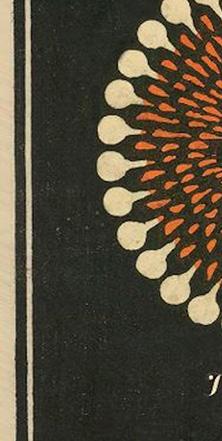
 BY AL HENSLEY
ANGELA STREHLI ACE OF BLUES Antone’s/New West Records
BY AL HENSLEY
ANGELA STREHLI ACE OF BLUES Antone’s/New West Records
 JOHN NEMETH MAY BE THE LAST TIME Nola Blue Records
JOHN NEMETH MAY BE THE LAST TIME Nola Blue Records

Co-founder of iconic Austin, Texas blues club Antone’s, singer-songwriter Angela Strehli revives her recording career after a 17-year hiatus with this new release on which New West Records proudly announces the renaissance of Antone’s Records. The Lubbock, Texas native who is now based in California made her recording debut in 1987 on the Antone’s label after many years performing at the club alongside blues legends like Muddy Waters, Jimmy Reed, Otis Rush, Albert King and countless others. A blues historian and impresario who enjoys a deep admiration by her peers, Strehli first bonded with the blues in her early years listening to it on the radio. On Ace Of Blues she pays respect to artists with whom she forged close friendships and drew inspiration from throughout her career. From horn-smeared R&B like Bobby Bland’s ‘Two Steps From The Blues’, O.V. Wright’s ‘Ace Of Spades’ and Little Milton’s ‘More And More’ to the bristling Chicago blues of Chuck Berry, Elmore James, Howlin’ Wolf, Willie Dixon and Otis Rush, Strehli’s lived-in contralto is right in-the-pocket. Her only original here is ‘SRV’, a heartfelt tribute to her soul mate, late guitar idol Stevie Ray Vaughan.
Boise, Idaho may not be famous for its blues lineage, but it’s the birthplace of one of the hottest harmonica playing soul blues singers on the scene today. Within a couple of years of relocating to northern California in 2004 at the age of 29 John Nemeth was signed by Blind Pig Records. A series of three releases for the label established his blues credentials nationally, and in 2013 Nemeth moved to Memphis, Tennessee. Responding to news in 2022 that Nemeth was to undergo specialised jaw surgery for a possible life-threatening, careerending illness, guitarist/bassist Kid Andersen called in Elvin Bishop’s Big Fun Trio to record a jam with Nemeth at his West Coast Greaseland studios. Be The Last Time free-wheeling essence of those sessions, leading with the title tune, an old Staples Singers traditional. Nemeth and his musical brotherhood revive a couple of originals from his 2014 CD Memphis Grease nuggets coming from Bishop’s foot-stomping back catalogue. Nemeth channels Junior Wells on Mel London’s ‘Come On In This House’, while gems by J.B. Lenoir, Wilson Pickett, Hank Ballard and Slim Harpo also hit the mark.
104
ALBUMS: World Music Folk


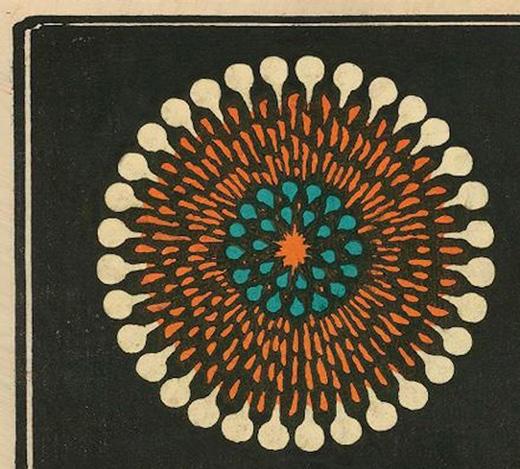 BY TONY HILLIER
BY TONY HILLIER
THE TRIALS OF CATO GOG MAGOG Independent
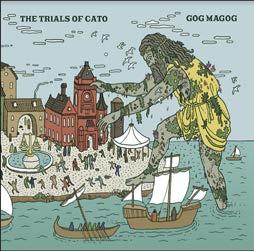
TREVOR BEALES FIRESIDE STORIES Basin Rock/Planet
THE UNTHANKS SORROWS AWAY Cadiz/Planet
 WESLI TRADISYON Cumbancha
WESLI TRADISYON Cumbancha
The Trials of Cato is an exciting Welsh/English trio whose strange name and, indeed, very existence stem from a teaching assignment in Beirut. Their 2018 debut release, Hide and Hair, netted a BBC best folk album award and the follow-up, which introduces a charismatic new female band member, seems certain to secure further honours. Dynamic and original, The Trials of Cato pay homage to the folk tradition whilst twisting ancient tales into febrile 21st century shape. One of the album’s highlights (and an eye and ear-catching YouTube video), ‘Bedlam Boys’ is a surreal modern take of a disturbing 17th century tale of murder and madness featuring some outstanding ensemble work and arranging, vocally and instrumentally. Elsewhere, Cato harks back to AD 60 for a eulogy of the warrior queen Boudicca that’s delivered with some passion by the new girl. Another of Polly Bolton’s songs, the bluesy ‘I Thought You Were My Friend’, is contrastingly very much of the now. An album conceived in Wales during the corona virus pandemic, recorded in a New York State studio and now out there for global approbation comes complete with plague songs and several brushes with Beelzebub, startlingly so in the spectral 16th century story ‘When Black Shuck Roams’. Interspersed with the delving into British history are a couple of pithy instrumentals that radiate jazzy Celtic exuberance and emphasise Cato’s excellence as stringed instrumentalists and composers. While there are elements that link them with some of the UK’s finest folk-rock bands such as Pentangle, Fairport Convention, Steeleye Span, Bellowhead and Stick in The Wheel, The Trials of Cato has admirably cultivated its own unique style.
This is an extraordinary album for many reasons. In a nutshell, it’s a previously unreleased recording made by a comparatively unknown young English folkie fresh out of school in the family attic in the picturesque West Yorkshire township of Hebden Bridge some half-a-century ago. It only takes one listen to Fireside Stories to appreciate that Trevor Beales, who died suddenly and unexpectedly aged 33 in 1987, was an exceptional musician, whose poetic songs, singing and glorious guitar playing can be compared to that of Hebden Bridge’s current resident troubadour Steve Tilston. Beales’ intelligent, well-arranged songs have a timeless quality, even if they, paradoxically, provide a snapshot of the early 1970s. Only one of the 13 tracks in this long overdue release is over 4-minutes and half-a-dozen are less than 2-minutes, which speaks volumes for the succinctness of his writing. Counterbalancing songs such as ‘Metropolis’ (about a busker’s lot) and ‘Then I’ll Take You Home’ (about false prophets) that reflect some cynicism are uplifting pieces such as ‘Sunlight On The Table’ and ‘Fireside Story’. The brilliance of Beales’ guitar fingerpicking at such a young age is illustrated by the quality of his instrumentals ‘Dance of The Mermaids’ and Dave Evans’ ‘Braziliana’. There’s a hint of Nick Drake in ‘The Prisoner’ and the aforementioned Steve Tilston in ‘City Lights’. ‘Marion Belle’ draws impressively on traditional folk. Trevor Beales’ songs expressed a worldliness and maturity that belied his youth while showcasing an inherent storyteller’s ear for narrative.

Since their early days with The Winterset, self-confessed “miserable buggers” Rachel and Becky Unthank have held English folk buffs and reviewers spellbound with their melancholic ballads and broad Northumbrian brogue. In more recent years they have embroidered their funereally paced songs and pristine but plaintive singing with strings and brass backing. UK critics have predictably been raving about Sorrows Away, their first new work for a while, which was recorded entirely at their home studio. Compared to some of The Unthanks’ past releases, it’s positively upbeat, although still somewhat bleak, despite a full band set-up. Four tracks occupy between 7 and 9 minutes each. By contrast, one of the standout cuts, ‘Waters of Tyne’, clocks in at a mere 3-minutes. Some of the songs are centuries old. The opening ‘Great Silkie Of Sule Skerry’ is a slow-burning reading of a traditional Orkney song concerning a supernatural tragedy. The closing title track certainly has its moments, though it too would have benefitted from editing. The pick of the long players, ’The Sandgate Dandling Song’, tackles domestic abuse!
Plagued by pestilence, poverty and political upheaval, not to mention devastating hurricanes and earthquakes, Haiti cannot compete musically with its Caribbean Island neighbours Cuba and Jamaica. That’s not to say, however, that the country doesn’t punch well above its weight, as bands such as Lakou Mizik and Boukman Eksperyans have shown in recent years. Reflecting the African, French and American influences that coagulate in Haitian music, Tradisyon — the first of a two-part project by Haitian-Canadian songwriter, guitarist and producer Wesley Louissaint — retells the story of Haiti’s past and imagines its future in an intriguing set that explores traditional chants from the voodoo religion, explosive carnival so-called rara rhythms and lilting, folksy ‘twoubadou’ songs.
105
ALBUMS: Jazz 1
BY TONY HILLIER
 MATT CARMICHAEL MARRAM Edition
MATT CARMICHAEL MARRAM Edition
question reflect the artist’s flair as an improviser and his ultra soulful and deeply melodic style. The influence of classical music on the Swede’s virtuosic playing and composing are perfectly exemplified by the session’s shortest tracks ‘Delta’ and ‘Theta’, which are both under three minutes in duration.
ALLY DRUM JUNK Spare Parts
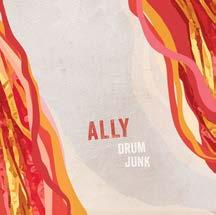
Dormant for decades, the Scottish jazz scene has ignited like a volcano in the past couple of years via the emergence of virtuosic young conservatoire educated players who take inspiration from Celtic folk heritage and Caledonian landscapes. Fast rising saxophone star Matt Carmichael follows the footprints of the widely lauded pianist Fergus McCreadie and BBC award-winning fiddler Charlie Stewart, his co-leads on this sophomore recording. In the titular air, Carmichael’s beautiful tone takes the breath away. In the up-tempo ‘Dune’ he lets loose with aplomb, aided and abetted by his brilliant buddies. Another humdinger, ‘Horizon’ showcases McCreadie’s scintillating keyboard chops. Carmichael’s compositions and arrangements emit an impressive range of emotion and energy.
ESBJÖRN SVENSSON HOME.S ACT/Planet

This is one of a couple of dynamic albums masterminded by Sydney bandleader and saxophonist Gai Bryant and her right-hand man, trombonist extraordinaire James Greening, late last year. In some ways a companion work to Caribé’s Distant Waters, ALLY’s Drum Junk balances hot Afro-Peruvian festejo dance rhythm and Brazilian experimentalism with the coolness of Latinised Thelonious Monk compositions, notably ‘Goodbye Pork Pie Hat’, and the sway of a North-eastern Brazilian maracatu. The title track emits raw organic energy generated by the lead horns, in conjunction with piano pushes, bass ostinato and a compelling percussion base. The more meditative ‘Jelly Bean’ features solos from the band’s pianist Daniel Pliner and bassist Max Alduca. Elsewhere, quirky harmonies, improvisation and seamless arrangements pervade.
BUTCHER BROWN TRIPLE TREY Concord Jazz
An unexpected bonus for Esbjörn Svensson’s many fans, HOME.S comprises improvised solo recordings made by the late superstar Swedish pianist just weeks before his tragic death in mid-2008 and discovered by his widow on a computer hard drive nearly ten years after. Adding value to this belated release is the fact that Svensson had focused almost entirely on his work with the trio e.s.t for the decade prior to his passing. The nine solo pieces in
Butcher Brown these diverse elements fit together surprisingly snugly. Ironically, Triple Trey was originally written and produced by the band’s resident MC and multi-instrumentalist Marcus “Tennishu” Tenney as a hip-hop album. It evolved into the Virginian collective’s own eclectic tribute to a more mainstream form of jazz with the addition of the bizarrelynamed R4ND4ZZO BIGB4ND, a side project of the group’s bassist and arranger Andrew Randazzo. Some tracks don’t gel or contain too many expletives for wide consumption, but the more soulful and funky numbers — such as ‘Crusian’, ‘Lawd Why’ and ‘Unbelievable’ — are irresistibly catchy, striking a balance between the seemingly disparate elements.
JUDITH OWEN COME ON & GET IT Twanky Records
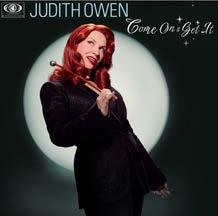
THE HOT CLUB OF SAN FRANCISCO DON’T PANIC Panda Digital

On paper, rap and big band jazz might seem somewhat strange bedfellows, but in the hands of


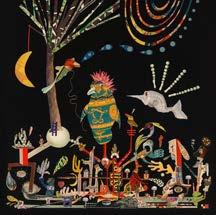
The innuendo posed by the title perfectly represents an album that celebrates the songs of the so-called “unsung badass” ladies of jazz and blues. Bodacious as much as it is audacious, Come On & Get It proves an ideal vehicle for the powerhouse Welsh singer and pianist Judith Owen as she fulfils her childhood fascination via some of the salacious songs she first heard in her father’s 1940s/50s record collection. Backed by a crew of the finest jazz players from her current base of New Orleans, including Jason Marsalis, Donald Harrison Jr, Nicholas Payton and veteran Duke Ellington and Count Basie sideman Charlie Gabriel, Owen successfully emulates the sexual swagger and saucy aplomb radiated by the likes of Blossom Dearie, Julia Lee and Nellie Lutcher and others of their ilk in such suggestive numbers as ‘Snatch and Grab’, ‘Big Long Slidin’ Thing’, ‘Nice Girls Don’t Stay For Breakfast’ and, of course, the title track itself.
While they might have been the first American group to perform at the famous Festival Django Reinhardt in France, The Hot Club of San Francisco are no jazz manouche purists. For the past three decades the Californian combo has peddled its own style of gypsy swing. The opening title track of their latest album — propelled impressively by la pompe, the rhythmic driving force of the genre, and featuring riveting exchanges between founder member and former Dan Hicks guitarist Paul Mehling and his violinist Evan Price — is as close as ‘The Hot Club’ comes to capturing the compelling 1930s/40s’ groove of Reinhardt and Stephane Grappelli. Other tracks echo ersatz sambas, waltz, 52nd street swing and other disparate influences.
As an acoustic bass guitarist bandleader, South African-born, New York-schooled and now Jerusalem-based Yosef Gutman is arguably unique in jazz. Throughout Gutman’s first trio recording, the beautiful bell-like tone of his unusual lead instrument engages in an absorbing dialogue with Omri More’s and Ofri Nehemy’s similarly sensitive piano and drum playing on lyrical instrumentals such as ‘Wedding Song’, ‘Jericho’s Siege’ and ‘Poltova’, frequently as the lead melodic voice.
106
YOSEF GUTMAN
UPSIDE DOWN MOUNTAIN Independent
ALBUMS: Jazz 2
BY DES COWLEY
EQUALLY TRUE
Earshift Music, EAR059, CD & digital release
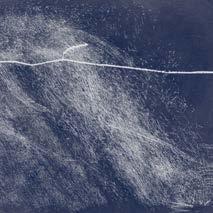
DRUMS
Earshift Music, EAR067, Vinyl, CD, & digital release
 HARRY MITCHELL ARCHETYPES
HARRY MITCHELL ARCHETYPES
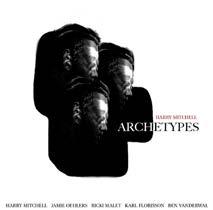 Independent, CD & digital release
Independent, CD & digital release

KNIGHT SHADOW PHASE
Sydney-based saxophonist Rafael Karlen relishes working in a range of contexts, from large ensembles, through to string quartets, and stripped-down trios. His new album – featuring pianist Matt McMahon, bassist Brett Hirst, drummer Simon Barker and singer Kristin Berardi – builds on the music heard on his previous outing with the Berardi/Foran/ Karlen trio, a music foregrounded in delicate voicings, sheer as gossamer. Opener ‘Again, as Always’ sets the scene, with McMahon’s spare piano notes coalescing into a richly emotive refrain, coaxing Berardi’s vocals, which glide ghost-like above the music. Karlen’s sax lends solid support, his mournful tone contributing a series of meditative flourishes, elevating mood over fireworks. Karlen’s compositions are, to a tee, reflective, slow-moving, and spacious, each instrument starkly present. His pieces develop organically, the product of deep listening and closely-knit communication. On occasion, we can discern an echo of Joni Mitchell in her Jaco-phase, or the free-floating spirit of trumpeter Kenny’s Wheeler’s Azimuth trio. Which is to say, this music weaves a spell, pensive and introspective, its unhurried tempos gentle as a daydream. Key to this music is McMahon’s piano, which conveys a forward momentum, minimal and fine-spun, a pulse that allows Karlen’s sax and Berardi’s vocals to roam free. The album’s centrepiece, the four-part suite ‘Arrival and Prospects’, originally commissioned for the Brisbane International Jazz Festival, is the sole piece to feature lyrics, a wistful song whose melody is tinged with nostalgia and hope. Throughout its generous sixty-plus minute runtime, Equally True unabashedly forgoes the flashy, steadfastly opening its heart to beauty.
This album may be Sydney saxophonist Jeremy Rose’s most ambitious to date. Scored for drummers Simon Barker and Chloe Kim, and an improvising sextet, it is a wild percussive ride from beginning to end. Rose’s project draws inspiration from the traditional use of drums, not just as an instrument for communication and ritual, but also as a voice of protest. Given the world we live in – the past few years alone have brought war, ecological disaster, a global pandemic, civil unrest, and Black Lives Matter – Rose’s intent is clear: to insert his musical voice into a growing chorus demanding action. In this resolve, he is mining similar terrain to Max Roach’s masterpiece We Insist! Freedom Now Suite Throughout, drums are front and centre, with Rose’s saxophone and Tom Avgenicos’s trumpet, wailing in unison, furnishing a support role for music’s propulsive energy. Rose’s bass clarinet inserts periodic brooding passages, serving as pauses for breath and reflection, while Novak Manojlovic’s Rhodes and Ben Carey’s synthesizer inject a flurry of sonic feed into the mix. Barker, of course, is one Australia’s finest drummers, his practice drawing inspiration from the traditions of Korean drumming. Kim, a young Korean-born drummer, studied under Barker, and together they demonstrate a synergy and telepathic interplay that defies reason. Meshing in tightly, they engage in extended passages of rhythmic conversation, a percussive call and response, brimming with respect and reciprocity. The eleven pieces heard on Disruption!, variably credited to Rose, Barker and Kim, give credence to the power of music to enact change.
Perth-based pianist Harry Mitchell once had the good fortune, as a nineteen-year-old, to play with Charlie Watts, when the Stones’ drummer dropped by Perth’s Ellington Jazz Club. Now in his twenties, Mitchell has been flaunting a punishing schedule, with some thirteen albums to his name since his self-titled debut in 2017. For this, his latest outing, he has teamed up with a stellar cast of Perth buddies: saxophonist Jamie Oehlers, trumpeter Ricki Malet, bassist Karl Florisson, and drummer Ben Vanderwal. With a strong ear for groove, Mitchell’s compositions conjure the hard bop sound of classic Blue Note recordings, as epitomized by the label’s more adventurous artists like Horace Silver, Andrew Hill, Wayne Shorter. Opener ‘Shaman’, with its punchy riff, breezy piano, and free-wheeling horns, highlights the album’s strengths: rich in shifting tempos, malleable grooves and moods, with a clear shine, and flouncing beat. ‘Anima’, by contrast, exhibits a gentle, dirge-like quality, muted and affecting. The eight-minute ‘Ruler’ is a standout, its haunting theme, full of longing, teasing from Oehlers one of his finest solos, dripping with lyrical warmth. Throughout, the playing of Oehlers and Malet is exemplary, but critical to Archetypes is the locked-in synergy of the rhythm section – piano, bass, drums – which appears to spin on a dime, enabling this music to constantly shift stride, embracing new directions. While Mitchell is not intent on breaking down fences, his album puts a modern twist on the classic hard bop and post-bop sound, catapulting it into the here and now.
Room
40, RM4153,
Vinyl & digital release
While this album features contributions from others – Tony Buck on percussion, Fia Fell on synthesizer, Rachael Kim on violin – it is best considered a solo project by acclaimed trumpeter Peter Knight, his first in a decade. During his tenyear stint as Artistic Director of the Australian Art Orchestra, a role he recently relinquished, Knight led the ensemble on a ten-year sonic adventure, exploring improvisation, minimalism, electronic and ambient music. Shadow Phase, a prolongation of that sonic journey, began life during Melbourne’s lockdowns, inspired by Knight’s regular walks with the late poet Ania Walwicz. Drawing sustenance from Walwicz’s practice of automatic writing, Knight began recording music daily, on a variety of instruments – trumpet, Revox reelto-reel, laptop, synths, harmonium –gradually stitching together the music heard on the album. Its five tracks, evocatively titled, are best listened to as a continuous suite, fashioned out of rudimentary building blocks: sound and silence, the slow in-and-out of breathing, the rhythms of the body, lines and loops, the gradual opening out of possibilities during a time of restriction. The ten-minute opener ‘The Softened Shore’, with its nearimperceptible forward momentum, sets the mood, trumpet and synths awash over a gentle pulse, rarely rising above a murmur. ‘Cloud Phase’ introduces an electronic backdrop, over which synths are gracefully overlaid, generating a shimmering radiance, swelling with grandeur and hope. At the end of the first side, Walwicz’s voice can be heard, reminding us that this album was born from a time of loss and darkness, its trajectory seeking – and finding –light.
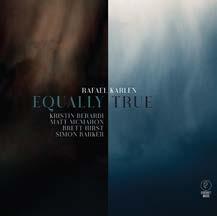
107
RAFAEL KARLEN
JEREMY ROSE & THE EARSHIFT ORCHESTRA DISRUPTION! THE VOICE OF
PETER
ALBUMS: Vinyl
BY STEVE BELL

PLAINS
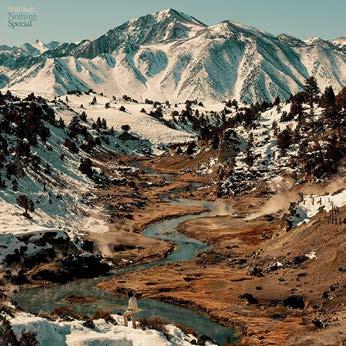
I WALKED WITH YOU A WAYS ANTI-
WILL SHEFF NOTHING SPECIAL ATO Records
KING STINGRAY KING STINGRAY Cooking Vinyl Australia
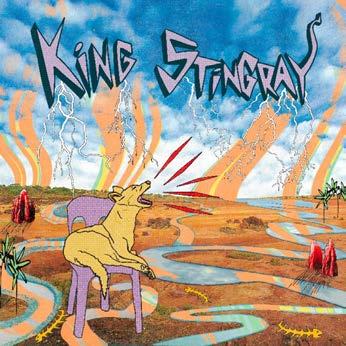
On her fifth album Saint Cloud Alabaman indie-folk mainstay Katie Crutchfield - who releases her solo music under the moniker Waxahatchee - turned her gaze towards the country realms, the authentic-sounding results proving one of the musical highlights of 2020 as she channeled forebears such as Lucinda Williams, Gillian Welch and Jason Molina. Now just two years later she’s joined forces with young Texan singer-songwriter Jess Williamson and dived even deeper into the country oeuvre with their new project Plains - adding new touchstones like Willie Nelson, Merle Haggard and Emmylou Harris into the sonic mixresulting in the brilliant debut album I Walked With You A Ways. Stunning lead single ‘Problem With It’ set the template for the project, a duet where Crutchfield takes the lead but the pair’s contrasting-but-complementary voices mesh into a velvet unison for the chorus, buoyed by a strong band who show great restraint as they add soft-brushed drums, gentle keys and robust guitars. With a shared lyrical focus on love gone stray in various dusty terrains both artists contribute some gorgeous songs to the project - Williamson offering’s including the harmony-laden opener ‘Summer Sun’, stunning lament ‘Abilene’ and uplifting title track which closes proceedings, while Crutchfield also contributed the powerful ‘Hurricane’ and the perfectly dogged ‘Easy’ - and they throw in a cover of Hoyt Van Teller’s ‘Bellafatima’ for good measure. I was recently lucky enough to see Plains play their second ever gig whilst in Portland, Oregon and together these two artists have forged a wonderful union that far exceeds the sum of its considerable parts, here’s hoping that we’re treated to more of the partnership in the future because it’s one of genuine substance.
Texan folk-rock mainstays Okkervil River crafted compelling music for over 20 years and released nine studio albums - over time proving to comprise erudite singer-songwriter Will Sheff and whoever he was playing with at the time - so Sheff’s new debut solo album Nothing Special marks a fork in his musical journey, a chance to abandon old baggage and start afresh with a clean slate. He gathered together a cast of willing and able accomplices (including Zac Rowe from Death Cab For Cutie and Eric D Johnston of the Fruit Bats) and by all accounts pulled the album together quickly, favouring the excitement of initial creation over slaving away in the quest for perfection. Lyrically much of the album is coloured by the tragic 2020 passing of former Okkervil River drummer Travis Nelson, prompting variations on the existential theme of moving on from loss and regret - in other words, how long should you remain rooted analysing past trauma before it comes counter-productive in the bigger picture? Sheff is no stranger to mining beauty from loss and heartbreak but songs like the title track and the quietly mournful ‘In The Thick Of It’ seem more grounded in actual pain than past fare, while the doleful ‘Marathon Girl’ uses the passing of a friend’s beloved dog to give a different perspective to the theme. Elsewhere ‘Holy Man’ seeks a balance between selflessness and selfishness and quietly-affecting closer ‘Evidence’ continues the motif of letting go and striking a balance between the present and the spectres of the past and future. Emotional vulnerability has long been Sheff’s forte and he’s outdone himself on Nothing Special, a sad-but-compelling opening gambit to his solo voyage.
The pedigree of young NT indie rockers is immaculate: vocalist Yirrŋa Yunupiŋu and guitarist Roy Kellaway are lifelong friends having grown up together with relatives in the ranks of Indigenous rock pioneers Yothu Yindi, while guitarist Dimathaya Burarrwanga is the grandson of former Warumpi Band frontman George Rrurrambu Burarrwanga With that in mind it’s no surprise that King Stingray’s unique blend of indie and surf rock with traditional Indigenous styles - and lyrics sung in both English and the Yolŋu Matha language - works so organically and completely avoids any notion of contrivance, the music’s inherent joie de vivre making it completely engaging both on record and in the live realm. The band’s early calling cards like ‘Hey Wanhaka’, ‘Get Me Out’ and ‘Milkumana’ are all included on their self-titled debut - which has finally enjoyed a vinyl release some months after hitting streaming platforms - but there’s so much depth on display throughout the record, with uniformly catchy tracks ‘Camp Dog’, ‘Let’s Go’ and ‘Lupa’ all getting plenty of traction on the radio when their turns arrived. Indeed King Stingray’s self-described “Yolŋu surfrock” sound - while completely unique - is so perfectly-formed and hook-laden that it feels like an aesthetic that’s been around forever (perhaps due to having foundations in a musical form that stretches back tens of thousands of years). These young guys literally have the world at their feet and you get the feeling that they’ll be introducing their homegrown culture and language to people far beyond our country’s borders in the not-too-distant future, a brilliant new addition to Australia’s musical armoury.

108
By Des Cowley
THE PHILOSOPHY OF MODERN SONG
By Bob Dylan (Simon & Schuster, h/b)
When it comes to Bob Dylan, the rule of thumb is to expect the unexpected. Back in 2004, he delivered Chronicles, a brilliant and offbeat memoir that managed to conceal as much as it revealed. The book’s cover, emblazoned with the subtitle ‘Volume 1’, whetted the appetite of a gazillion music fans. In the intervening eighteen years, our collective hopes for further volumes have deflated like a leaky balloon, now resembling little more than sad pieces of rubber and latex, entirely devoid of gas. So, what then, are we to make of Bob’s new book, landing without fanfare, that purports to lay bare the genetic code of modern song. Like I said, expect the unexpected. First things first: what we are presented with in this book are 66 brief texts – generally between two and five pages – representing Bob’s riffs on songs that have presumably been important to him, or that uncover aspects of modern song he considers essential or foundational. As you might anticipate, his selection is entirely idiosyncratic. Who amongst us would have chosen to spotlight the Eagles ‘Witchy Woman’, while bypassing the entire recorded output of the Beatles? But there is no point bemoaning what’s missing, it’s a defeatist cause, far better to take Bob on his own terms, and be mindful of what’s before us.
One way to approach this book is to think of it as a compilation, its chosen tracks, taken in sequence, forming a weird and composite, albeit fragmented, portrait of its compiler or maker. The book’s opening track sets the scene, Bobby Bare’s 1963 RCA single ‘Detroit City’, written by Danny Dill and Mel Tillis. The song’s unhappy refrain of ‘I wanna go home’, sung with longing and regret, inspires in Dylan a brief meditation on the prodigal son story: “From the postcards and junk mail that you dashed off, everybody assumes you’re a bigwig, that things are cool and beautiful but they’re not, and the disgrace of failure is overwhelming. Your life is unravelling. You came to the big city and you found out things about yourself you didn’t want to know, you’ve been on the dark side too long”.
Many of the deliberations in the book read like prose poems, full of kaleidoscopic, dark imagery. They could equally be characterized as shards or discarded offcuts of lyrics that might, when placed end to end, coalesce into another epic ballad like ‘Murder Most Foul’. Throughout, Dylan is putting on masks, trying on voices, treading in the footsteps of these songs.
There is nothing overly modern about Dylan’s selection, much of it represents the generation of artists he grew up listening to, singers whose work informed his idea of song: Ray Charles, Johnnie Ray, Johnny Cash, Perry Como, Bing Crosby, Jimmy Webb, Frank Sinatra, Marty Robbins, Bobby Darin, Elvis Presley, Ricky Nelson, Little Richard, Webb Pierce. What’s fresh, however, is the novel way he approaches these songs, coming from behind or left field, rather than head-on. Here’s Dylan on Little Richard’s ‘Tutti Frutti’: “Little Richard was anything but little. He’s saying that something is happening. The world’s gonna fall apart. He’s a preacher. ‘Tutti Frutti’ is sounding the alarm”. And on Ricky Nelson’s ‘Poor Little Fool’: “Now you’re obsolete and out of date, and you’re walking in the night down by the river, but the water’s dead. You’re moving one leg at a time. Another girl has got a hand on your shoulder, you’re not always at your best”.
Of the few classic-era rock songs featured, The Who’s decidedly unDylanesque ‘My Generation’ looms large, described as ‘a song that does no favours for anyone…Straight talk, eyeball to eyeball’. Ditto, the Grateful Dead’s ‘Truckin’, described as: “Arrows of neon, flashing marquees, Dallas and a soft machine, Sweet Jane, vitamin C, Bourbon Street, bowling pins, hotel windows, and the classic line, ‘What a long, strange trip it’s been’”. Elvis Costello’s ‘Pump it Up’, one of the more
recent contenders, elicits: “It’s the song you sing when you’ve reached boiling point. Tense and uneasy, comes with a discount – with a lot of give-a-way stuff. And you’re going to extend that stuff till it ruptures into a million pieces”.
Women artists are arguably short-changed in Dylan’s canon, limited to Rosemary Clooney, Judy Garland, Nina Simone, and Cher. But part of the fun of this book is seeing who’s in and who’s out. Carl Perkins’s ‘Blue Suede Shoes’ feels like a no-brainer, likewise Little Walter’s ‘Key to the Highway’. But neither Jackson’s Browne’s ‘The Pretender’, nor The Allman’s ‘Midnight Rider’ would have struck me as obvious choices, nor for that matter The Fugs’ ‘CIA Man’.
Pundits have pointed out there are obvious models for this book, starting with Dylan’s free-wheeling, poetic liner notes for World Gone Wrong. Then there was his mellifluous street-patter heard across the airwaves during his hundred or so episodes of Theme Time Radio Hour. This book, however, affords him a broader canvas than brief liner notes, while at the same time enforcing a greater concision and clarity of thought than a talk show.
While there is a plethora of song to be found in these pages, Dylan steers clear of the ‘philosophy’ bit. There is no introduction explaining the why-for or the rationale behind the book, and certainly no concluding chapter laying down a summation of his final thoughts on the mystery of song. It would have been foolhardy to expect otherwise. The book comes beautifully designed and packaged, with period photographs conjuring the enigmatic spirit of Dylan’s prose. The Philosophy of Modern Song doesn’t fill the hole in my shelves awaiting the second volume of Chronicles, but until that day arrives, it will do just fine.

109

Rhythms Books Too
Books. Books. Books. No, there are not too many of them. What is lacking is the extra hours required to get through them all. Twenty-four hours is just not enough, and I hereby propose that the avid reader is from now on granted thirty-six hours in every day as special dispensation for their love of words on the printed page.
Since we last chatted, I’ve done pretty well on the book devouring front – and of course not nearly as well as I’d like. That’s simply my (and your) blooming lot as the wonderful Peter Cundall would say. Let’s have a look at a few recent tomes vying for your and my time.
Kid Congo Powers can lay claim to many things including being a member of The Gun Club, The Cramps and Nick Cave & The Bad Seeds. Not bad for a guy who hadn’t even picked up a guitar until well over 100 pages into his wonderful, pacy, entertaining memoir Some New Kind of Kick
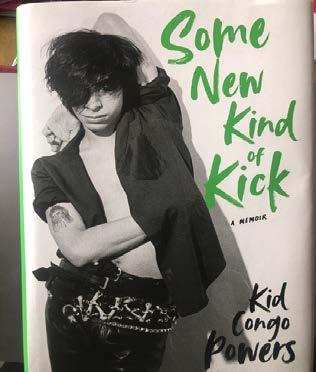
In fact, such was the build-up to Kid as guitar player that I was beginning to wonder if he’d just neglected to write about that aspect of his life but no, until he met Jeffrey Lee Pierce he was a music fan intent on being a journalist and writing about the music he loved. Then the West Coast President of The Ramones fan club (Kid) met the West Coast President of the Blondie fan club (Jeffrey) and things changed.
So, this memoir – which ends in 1997 when Kid finally quits hard drinking and harder drugs for good. This is the culmination of an extremely well-drawn telling of life as a young, queer Chicano kid from the suburbs of East LA. The young Kid is obsessed by Glam rock and explores his sexual identity through that music and those that gravitated to it in Los Angeles in that era.
It’s totally fabulous and Kid’s recall of dates and places and evocation of scenes is superb. I could only pick one error – simply because I was involved. When the Gun Club (or a
version thereof) toured Australia, I was the publicist. As the tour came to an end the band were desperately in need of cash to survive and leave the country. Bass player Patricia Morrison called me (not Spencer P Jones) from Adelaide and asked if there was a quick fix solution and so Roger Grierson and I hastily organised a Monday night gig for the Gun Club (supported by the Hoodoo Gurus) at the Strawberry Hills Hotel in Sydney (not Melbourne). Minor quibble – but hey – in a wonderful book.
A little after this tour I spent a night hanging out with Kid and Jeffrey in LA and staying at the apartment they were living at – Kid’s place, Jeffrey couch surfing. Earlier in the day they’d suggest that the three of us plus Patricia should take acid and go to Disneyland. It didn’t end up happening, but I’ll forever imagine what that might have been like.
As I write I’m immersed in Holy Ghost: The Life And Death Of Free Jazz Pioneer Albert Ayler by Richard Koloda which looks and reads so far like it will become the definitive resource for information on the great and innovative saxophonist.
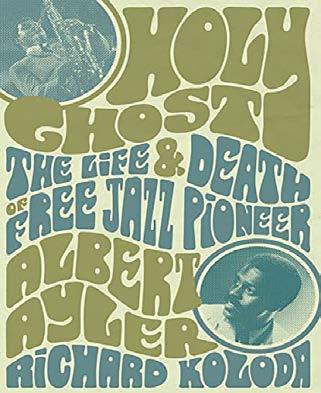
How Ayler died – suicide, accident or murder – fuels endless speculation, but as Koloda says early in his book, Alyer’s death and that speculation about the manner of his end frequently overshadows discussion of his music and influence, something he sets out to redress in this book.
After that I’m heading in the direction of a book that I’ve had by the bedside for a few months now, a seemingly exhaustive look at the role of organised crime at the history of jazz music.
Dangerous Rhythms: Jazz and The Underworld by T.J.English is a 400+ page hardback book that looks at the intersection of Louis Armstrong, Earl ‘Fatha’ Hines, Fats
 By Stuart Coupe
By Stuart Coupe
Waller, Duke Ellington, Billie Holiday, Lena Horne, Ella Fitzgerald and others with the likes of Al Capone, Meyer Lansky, Charlie ‘Lucky’ Luciano and Mickey Cohen. I am sooooo there!
Also lined up for a read is Simon Doonan’s Transforner: A Story of Glitter, Glam Rock & Loving Lou Reed, alongside the latest in the Why (pick a name) Matters series of book. This time it’s Karen Tongson looking at Why Karen Carpenter Matters


Mentions also to Minds Went Walking: Paul Kelly’s Songs Reimagined in which twenty or so Australian writers take – yes, you guessed it – Paul Kelly songs as a jumping off point for short stories. Sounds like good beach reading to me.
And finally, I’m also keen to read Paulie Stewart’s All The Rage, a memoir taking in the Painters & Dockers, his brother’s murder as one of the Balibo Five, his own liver transplant, journalistic career and lots more. So, with my now thirty-six-hour day wish granted I will leave you and return to my books. Back next issue.
111
STUART COUPE PRESENTS
 LUCAS
LUCAS
Mark Lucas & the Dead Setters have, in various incarnations, been a part of the Sydney roots music scene for the better part of two decades, equally at home as string band or bar band, in the corner of the pub (without pokies!), or on a festival stage. It’s been a while since their last outing; new Jake Lardot produced album, Onward, into the Fog, due for release in February 2023, grew out of demo recordings taken from regular weekly rehearsals which, like so many things, came to dead stop when the pandemic hit. The finished project enthusiastically reflects the diversity of influences at play in Mark’s songwriting, delivering a collection of soulful, melodic alt. country rock songs reflecting a tumultuous time but never losing heart. The album is available on cd as well as through Bandcamp.
marklucas-songsmith.bandcamp.com
 DANGLIN BROS
DANGLIN BROS
The Danglin’ Bros are finally about to release their second live album and there’s a copy waiting on Bandcamp with YOUR name on it! Des, Darcy, Declan, Derrick and Richard Danglin are sometimes referred to as Roger Ansell, Mick King, George Bibicos, Geoff Simpson and Kim Cheshire, the guys that brought rockin’ country roots music to the Australian music scene way back in the 80’s and 90’s! The Brothers played a reunion gig at The Marrickville Bowling Club on Friday November 27th 2019, and have since decided to share it with their millions of fans across the globe. Danglin’ Bros Live at the Bowlo, only $20, Find it on Bandcamp or visit the boys on Facebook!
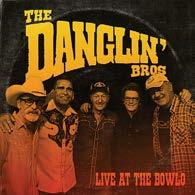
Shadowland is Dog Trumpet’s latest album. A distinctive blending of psychedelia, folk and blues, the album probes the perils and absurdities of human existence, kicking off with the title track Shadowland, a nervous musing on digital over-surveillance; followed by Nina Simone, a song reflecting on romance and memory. ‘F***ing Idiots’ points out the shameful idiocy of our addiction to war and militarism; The Ballad of Clayton Looby is an anti-establishment ode to a larrikin surfer. Shadowland our eighth album is available Dog Trumpet - featuring; Reg Mombassa and Peter O’Doherty original members of Mental As Anything, Bernie Hayes and Jim Elliott - Cruel Sea - are touring Shadowland in 2023 and they’ll be showcasing the new tracks from the album along with Dog Trumpet and Mentals favourites.

ALYCE PLATT
When Melbourne and the rest of the world went into lockdown in 2020, Alyce Platt –singer-songwriter, guitarist - found solace in the echoes of her bathroom learning and recording a song a day. An intimate and compelling relationship with the acoustics and a virtual audience in need of comfort and connection, soon became a regular post on social media. Alyce has expanded upon her original idea by connecting with fellow musicians who individually did their recordings in their home studios on the unedited tracks. Harp, strings, cello, vibes, bass, flugelhorn, pedal steel, drums and organ provide a nostalgic window to the outside world.
Bain Douche is a wonderful collection of reimagined songs from the likes of Paul Kelly, The Beach Boys, The Cure, Elton John, America, Bob Dylan, Creedence Clearwater Revival and many others, all recorded in a highly creative and imaginative fashion.

Daydreamin is new album by Surf Coast troubadour and songwriter, Don Hillman, in the great Australian songwriting tradition of Paul Kelly, Don Walker and Richard Clapton. Songs on the album resonate quintessential Australia – King Parrot Creek, Gypsy Station Wagon, Rollin Waves Forever. The country rock title track is a standout – daydreaming about being back down the coast. The 12-track album harnesses the mastery of Johnny Salerno on drums, Marcel Yammouni on bass and guitar, Bruce Haymes on keys, and Garrett Costigan on prodigious pedal steel. Olivia Nathan provides backing vocals, and Jeff Raglus, trumpet on three tracks. The album was recorded at Diamond Creek. Don continues to create his superb songs, and performs with his band, Don Hillman’s Secret Beach
The new Daydreamin album is now available on digital services, and on CD from www.donhillman.com

112
MARK
DOG TRUMPET
DON HILLMAN
STUART COUPE PUBLICITY PHONE: 0408745271 EMAIL: coupe@laughingoutlaw.com.au
JANUARY
January 5 - 29
SYDNEY FESTIVAL sydneyfestival.org.au
January 6
Gulgong Folk Festival Gulgong, NSW gulgongfolkfestival.com
January 13 – January 15
CYGNET FOLK cygnetfolkfestival.org
January 13 -22
TAMWORTH COUNTRY MUSIC FESTIVAL tcmf.com.au
January 20-22 Illawarra Folk Festival Illawarra, NSW Illiawarafolkfestival.com.au
January 20-23
NEWSTEAD MUSIC FESTIVAL Newstead, VIC Newsteadlive.com
January 27 - 29
THREDBO BLUES FESTIVAL thredbobluesw.com.au
January 27-29
TAMAR VALLEY FOLK FESTIVAL tamarvalleyfoklkfestival.com
FEBRUARY
February 1-5
CLARENCE JAZZ FESTIVAL Clarenceartsandevents.com
February 3-4
FESTIVAL OF KING ISLAND (FOKI 2023) folki.com.au
February 4
MUSIC IN THE VINES Macarthur, Victoria musicinthevines.com.au
February 10 – March 10
PERTH FESTIVAL perthfestival.com.au
February 10-12
PORT FAIRY JAZZ FESTIVAL portfairyjazz.com.au
February 17-19
RIVERBOATS MUSIC FESTIVAL Echuca/Moama VIC riverboatsmusic.com.au
February 17-19
MONA FOMA Launceston, TAS
February 24-26
MONA FOMA Hobart, TAS
February 24-26
GREAT ALPINE PICK Harrietville, VIC mountainpickers.net
MARCH
March 3-19
ADELAIDE FESTIVAL adelaidefestoval.com.au
March 3-6
GIRRAKOOL BLUES & ROOTS FESTIVAL The Entrance, Central Coast, NSW girrakoolblues.com.au
March 3 – March 6 Nannup Music Festival Nannup, WA nannupmusicfestival.org
Friday March 10 – Monday March 13 WOMADELAIDE Womadelaide.com.au
Friday March 10 – Monday March 13
PORT FAIRY FOLK FESTIVAL portfairyfolkfestival.com
March 10-19
TEN DAYS ON THE ISLAND tendays.org.au
March 17-19
BLUE MOUNTAINS MUSIC FESTIVAL Bmmf.com.au
Sunday March 5 – Monday March 13
BRUNSWICK MUSIC FESTIVAL Brunswickmusicfestival.com.au
March 11-13
GOLDEN PLAINS Meredith, VIC goldenplains.com.au
March 17-18
FORTH VALLEY BLUES FESTIVAL Forth, TAS forthvalleybluesfest.com
March 17-19
BLUE MOUNTAINS MUSIC FESTIVAL Bmff.org.au
March 24-26
MORUYA BLUES & ROOTS Moruya, NSW moruyabluesandroots.com March 24-26
YACKANDANDAH FOLK FESTIVAL Yackandandah, VIC yackfolkfestival.com
March 31 – April 2
CRESFEST Creswick, VIC cresfest.com.au
APRIL
Saturday April 8 – Sunday April 9
BLUESFEST, MELBOURNE Melbourne Convention and Exhibition Centre
Thursday April 14 – Monday April 18
BLUESFEST Tyagarah, NSW bluesfest.com.au
April 6-10
NATIONAL FOLK FESTIVAL Canberra folkfestival.org.au
April 21-23
THE GUMBALL Lower Belford, NSW dashville.com.au/gumball
April 22
Gippsland Country Music Festival Lardner Park, Gippsland
April 22 & 23
Mount Beauty Music Festival Les Pert Oval, Mount Beauty
April 28-30
Wide Open Space Alice Springs, NT
April 28 – May 1
Wintermoon Music Festival Cameron’s Pocket, Mackay, QLD
Saturday May 20
Legends On The Lawn Great Barrier Reef Arena, Mackay, QLD
113 113
The Project Broadcasting Association of Australia initiative, provides an online database of new Australian music available to “community radio stations and their program makers” and sends them a monthly mailout of new Australian CD releases. Musicians can submit one release per week to Amrap www.amrap.org.au/faq




Grace Petrie (English singer/songwriter) begins her Australian tour at Woodford Folk Festival, then has gigs at Brunswick Heads, Brisbane, Burleigh Heads, Sydney, Katoomba, Canberra, Adelaide, Cygnet Folk Festival, Franklin, Hobart, Melbourne, Geelong and Illawarra Folk Festival www.
Australian Songwriting Competition 2022. With




this is the 42nd time the competition has been run by the Australian Songwriters Association. For access to the entry platforms, go to: www.asai.org.au
Folk Alliance Australia’s Festival Calendar is a useful tool for finding a festival and keeping up-to-date with any changes (e.g. fire, floods, COVID-19). www.folkalliance. org.au/directory
Scottish duo The Jellyman’s Daughter is on tour in Australia, with gigs to include Cygnet Folk Festival and Illawarra Folk Festival www.thejellymansdaughter.com
Some other international acts touring over coming weeks include Marc Rebillet, Marlon Williams, Del Amitri, Billy Bragg and (the several times postponed) Cowboy Junkies
The Grammy Awards ceremony takes place in the first week of February. Among the nominees are ABBA, Molly Tuttle, Diana Ross, Coldplay, Artic Monkeys, Elvis Costello, Björk, Willie Nelson, Bonnie Raitt, Blind Boys of Alabama, Keb’ Mo’, Judy Collins, Janis Ian, Aoife O’Donovan. www.grammy.com
The Women Folk podcast, hosted by Melanie Long and Jade Tinkler, launched with an interview with Ruth Hazleton. www. anchor.fm/womenfolk
New albums include: Frankie Gavin, Port Éireann; Monique Clare, Sight; David Keenan, Crude; Paddy Hanna, Imagine I’m Hoping; Rachael & Vilray, I Love a Love Song!; Molly O’Mahony, The House of David; Ashley Heath, Something to Remember; Jenny Mitchell, Tug of War; The Little Unsaid, Fable; Rachel Taylor-Beales, Out of this Frame; Elspeth Anne, Mercy Me; Felix Riebl, Everyday Amen
Among the new books are: Matthew Goody, Needles & Plastic: Flying Nun Records; Ramona Holmes, Resilient Voices: Estonian Choirs & Song Festivals in WWII Displaced Person Camps; Philip Ciantar, Studies in Maltese Popular Music; Jen B Larson, Hit Girls: Women of Punk in USA; Daphne A Brooks, Liner Notes for the Revolution: Intellectual Life of Black Feminist Sound; Ian Blenkinsop, Steeleye Span: Complete Recordings Illustrated; Lesley-Ann Jones, The Stone Age: Sixty Years of the Rolling Stones
Dead Kennedys drummer D H Peligro (63), died California, USA (Oct)
Lucy Simon (82), American composer, singer and sister of Carly, died New York state, USA (Oct)
Cuban musician Pablo Milanés (79), died Spain (Nov)
Wilko Johnson (75), of Dr Feelgood and Ian Dury & The Blockheads, died England (Nov)
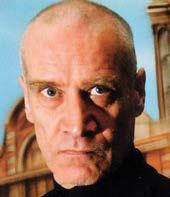
American singer/songwriter Loretta Lynn (90), who wrote ‘Coal Miner’s Daughter’, ‘Two Steps Forward’, ‘This Haunted House’, ‘Dear Uncle Sam’ and ‘World of Forgotten People’, died Tennessee, USA (Oct)

Patrick Haggerty (78), whose debut album Lavender Country was released in 1973, died Washington state, USA (Oct)
Irish musician Noel Duggan (73), of Clannad, died Ireland (Oct)
Elizabeth Stewart (83), Scottish singer, folk musician and advocate for Traveller culture, died Scotland (Oct)
American singer/songwriter Mary McCaslin (75), died California, USA (Oct)
Kevin Locke (68), storyteller, hoop dancer and Indigenous Northern Plains flute player, died South Dakota, USA (Oct)
American singer and pianist Jerry Lee Lewis (87), died Mississippi, USA (Oct)

Lee Jihan (24), Korean actor and singer, died South Korea (Oct)
American songwriter and musician Ivy Joe Hunter (82), died in October
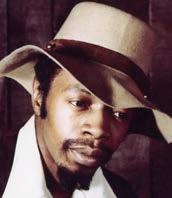
Joyce Sims (63), American singer/ songwriter, died California, USA (Oct) Grammy-winning American singer Jody Miller (80), died Oklahoma, USA (Oct)
Bettye Crutcher (83), a staff writer for Stax Records, died Tennessee, USA (Oct)
Rockabilly musician, Robert Gordon (75), died New York, USA (Oct)
Irene Cara (60), Grammy-winner for the song ‘Flashdance … What a Feeling’, died Florida, USA (Nov)
Brazilian singer Gal Costa (77), died Brazil (Nov)
Rab Noakes (75), Scottish singer/songwriter, died Scotland (Nov)
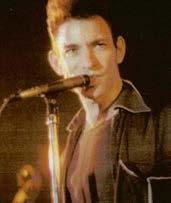
Irish musician Garry Roberts (72), of The Boomtown Rats, died England (Nov)
Nik Turner (82), of English band Hawkwind, died in November
English music journalist Colin Irwin (71), died England (Nov)
Mimi Parker (54), American drummer and singer with Low, died Minnesota, USA (Nov)

English musician Keith Levene (65), of The Clash, died England (Nov)
Mick Goodrick (77), American jazz musician, died Massachusetts, USA (Nov)
Scottish musician Dan McCafferty (76), of Nazareth, died in November
114
Ivy Joe Hunter
Jerry Lee Lewis
Jody Miller Loretta Lynn
…AND
Wilko Johnson COMPILED BY SUE BARRETT
Robert Gordon





















10 – 13 March 2023 Botanic Park / Tainmuntilla Adelaide womadelaide.com.au ADG7 South K orea AILAN SONGS PROJECT Aus ALEXANDER FLOOD Aus ANGEL OLSEN USA ASANTI DANCE THEATRE Ghana/Aus AURORA Norway AURORA VOCAL ENSEMBLE Aus BAB L’ BLUZ Morocco/France BALAKLAVA BLUES Ukraine/Canada BANDALUZIA Aus BANGARRA DANCE THEATRE Aus BECKAH AMANI Aus BÉLA FLECK & ABIGAIL WASHBURN USA BILLY BRAGG UK BON IVER USA CIMAFUNK Cuba CONSTANTINOPLE Canada DANIELLE PNG DEM MOB Aus DIDIER KUMALO Aus DIDIER THÉRON COMPANY France DILI ALLSTARS Timor Leste/ Aus FANTASTIC NEGRITO USA FLORENCE + THE MACHINE UK FOCO ALAIRE Mexico GAIA by LUKE JERRAM UK GALMAE France/South Korea THE GARIFUNA COLLECTIVE Belize GENESIS OWUSU & THE BLACK DOG BAND Aus GOSTI Aus GRACE CUMMINGS Aus GRATTE CIEL PLACE DES ANGES France GUTS ( DJ ) France/Spain IZY Aus JAGUAR UK JULIAN BELBACHIR Aus JUSTIN ADAMS
Aus KEFAYA
ELAHA SOROOR Afghanistan/UK/Italy KOKOROKO UK
USA
王萌
) UK ONDATRÓPICA Colombia PANDIT RONU MAJUMDAR & DR JAYANTHI KUMARESH India THE PROCLAIMERS Scotland QUINTETO ASTOR PIAZZOLLA Argentina RIA HALL New Zealand RICHARD J FRANKLAND Aus RIPPLE EFFECT BAND Aus RIZWAN MUAZZAM QAWWALS Pakistan SAMPA THE
Zambia SAN SALVADOR France SISTER NANCY MEETS LEGAL SHOT Jamaica SMALL ISLAND BIG SONG Taiwan/PNG/Mauritius/Aus+ SONS OF ZÖKU Aus SOUL II SOUL UK TAIAHA New Zealand/Aus TARABEAT X MZRIZK Lebanon/Aus TARAF DE CALIU Romania TIANA KHASI Samoa/India/Aus YOUSSOU N’DOUR & LE SUPER ÉTOILE DE DAKAR Senegal YUNGCHEN LHAMO Tibet Full lineup out now!
& MAURO DURANTE UK/Italy JYOTY UK KEE’AHN
AND
KRONOS QUARTET
KU ARTS Aus THE LACHY DOLEY GROUP Aus THE LANGAN BAND Scotland MADELEINE PEYROUX USA MDOU MOCTAR Niger MEUTE Germany MINDY MENG WANG
AND TIM SHIEL China/Aus NAKHANE South Africa NIGHTMARES ON WAX ( DJ
GREAT


























 Brian Wise, Editor
Brian Wise, Editor















































 Paul Stewart.
Photo by Sarah Enticknap
Paul Stewart.
Photo by Sarah Enticknap













 By Bridget Macarthur
By Bridget Macarthur












 By Steve Bell
By Steve Bell




 By Seth Jordan
By Seth Jordan








 By Jeff Jenkins
By Jeff Jenkins











 By Bernard Zuel
By Bernard Zuel



 By Bernard Zuel
By Bernard Zuel

























































 Rolling Stones poster courtesy of the Max Crawdaddy Collection.
Rolling Stones poster courtesy of the Max Crawdaddy Collection.




 by Michael Goldberg
by Michael Goldberg






 By Chris Lambie
By Chris Lambie












 ERIK VINCENT HUEY APPALACHIAN GOTHIC Propellor
ERIK VINCENT HUEY APPALACHIAN GOTHIC Propellor


 By Trevor J. Leeden
By Trevor J. Leeden






 Independent/Bandcamp
Independent/Bandcamp













 Christopher Marshall.
Christopher Marshall.



















 By Michael Smith
By Michael Smith


 DEXYS MIDNIGHT RUNNERS TOO-RYE-AY (AS IT SHOULD HAVE SOUNDED) Mercury Records
DEXYS MIDNIGHT RUNNERS TOO-RYE-AY (AS IT SHOULD HAVE SOUNDED) Mercury Records








 BY AL HENSLEY
ANGELA STREHLI ACE OF BLUES Antone’s/New West Records
BY AL HENSLEY
ANGELA STREHLI ACE OF BLUES Antone’s/New West Records
 JOHN NEMETH MAY BE THE LAST TIME Nola Blue Records
JOHN NEMETH MAY BE THE LAST TIME Nola Blue Records



 BY TONY HILLIER
BY TONY HILLIER

 WESLI TRADISYON Cumbancha
WESLI TRADISYON Cumbancha

 MATT CARMICHAEL MARRAM Edition
MATT CARMICHAEL MARRAM Edition








 HARRY MITCHELL ARCHETYPES
HARRY MITCHELL ARCHETYPES
 Independent, CD & digital release
Independent, CD & digital release










 By Stuart Coupe
By Stuart Coupe


 LUCAS
LUCAS
 DANGLIN BROS
DANGLIN BROS







































